

What a Trip to Brazil Costs in 2024 | Average Prices
Written by: Author Lara Manetta | Reviewed by: Sandy Mitchell

Lara Manetta is a writer, artist, and full-time traveler who lives on her 30-foot sailboat. With a background in journalism, she's a tenacious researcher and dedicated storyteller... Learn More

Sandy Mitchell is a travel expert and the content reviewer/fact checker at Travellers Worldwide. Using the experience she gained working in the travel industry for more than 20 years, as a travel agent, travel marketing executive, and cruise school administrator, Sandy fact-checks and reviews each of our guides to ensure they're as accurate and helpful as possible... Learn More
Posted on Last updated: November 20, 2023 - Travellers Worldwide is reader-supported. If you buy a product we link to, we may earn a commission. Learn more
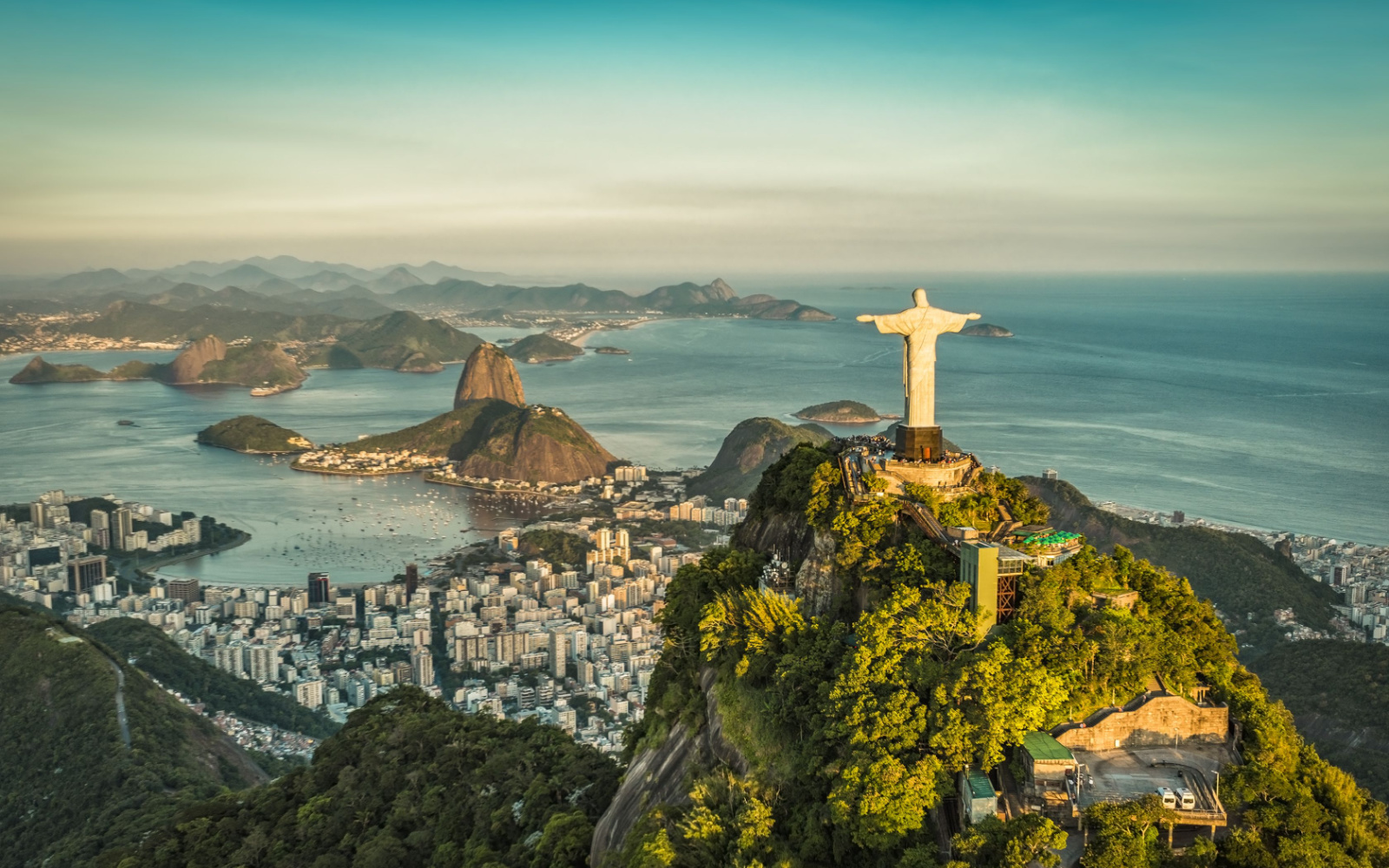
It’s hard to sum up the spirit of South America’s largest country in a few sentences. This vibrant country’s wealth includes the world’s largest Carnival celebrations, acres of untouched Amazon forest, long stretches of white sand beaches, and even World Wonders like the Christ the Redeemer statue.
Despite all of this, it remains an accessible and affordable travel destination. Depending on what sorts of lodgings you like and the time of year you choose for travel, Brazil can be a luxury splurge or a penny-pincher’s paradise.
We’ll go over what you can expect to pay in different cities for different experiences. Pick and choose your travel priorities to figure out how much it will cost you to go to Brazil on your next vacation.
Average Trip to Brazil Cost in 2024
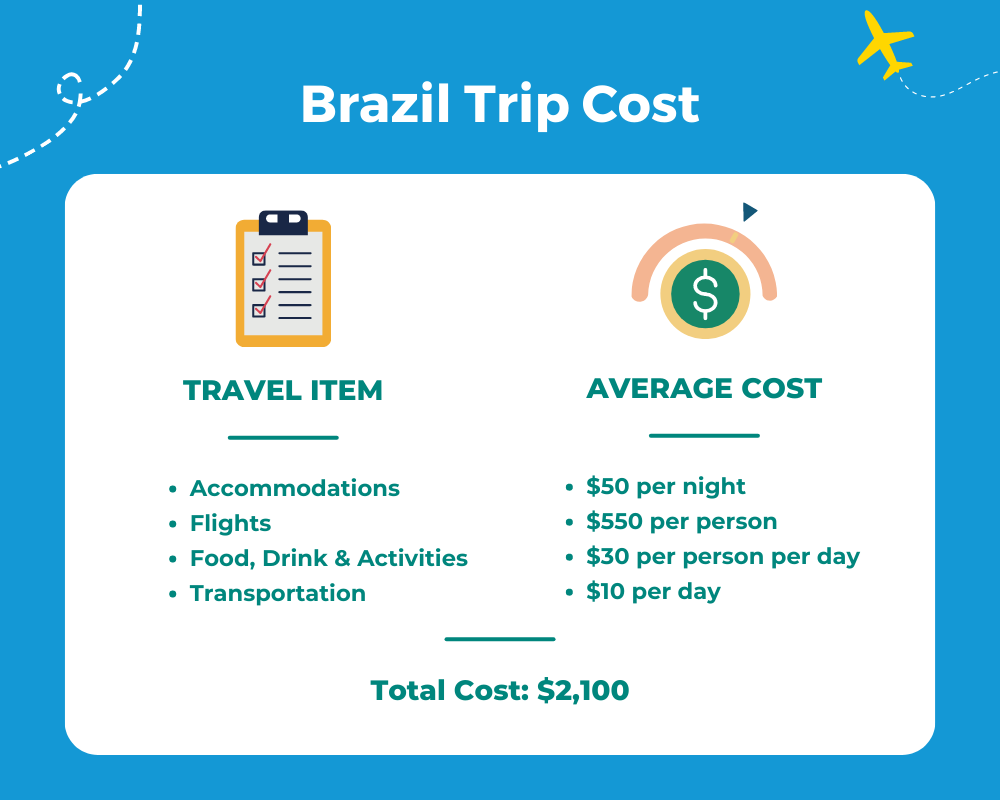
A week in Brazil costs around $2,100 for two people:
- Average Accommodation Cost: $50 per night
- Average Flight Cost: $550 per person
- Food, Drink & Activities: $30 per person, per day
- Transportation: $10 per day
- Total Cost: $2,100
Of course, how much you are going to spend depends a lot on the time of year you go and what kinds of accommodations you seek out. We’ll break it all down so you can get a better idea of what a trip to Brazil will cost you.
Ready to Book?
Unlock exclusive discounts on expedia.com, got travel insurance.
Protect yourself for unexpected interruptions.
Brazil Trip Cost: Average by Item
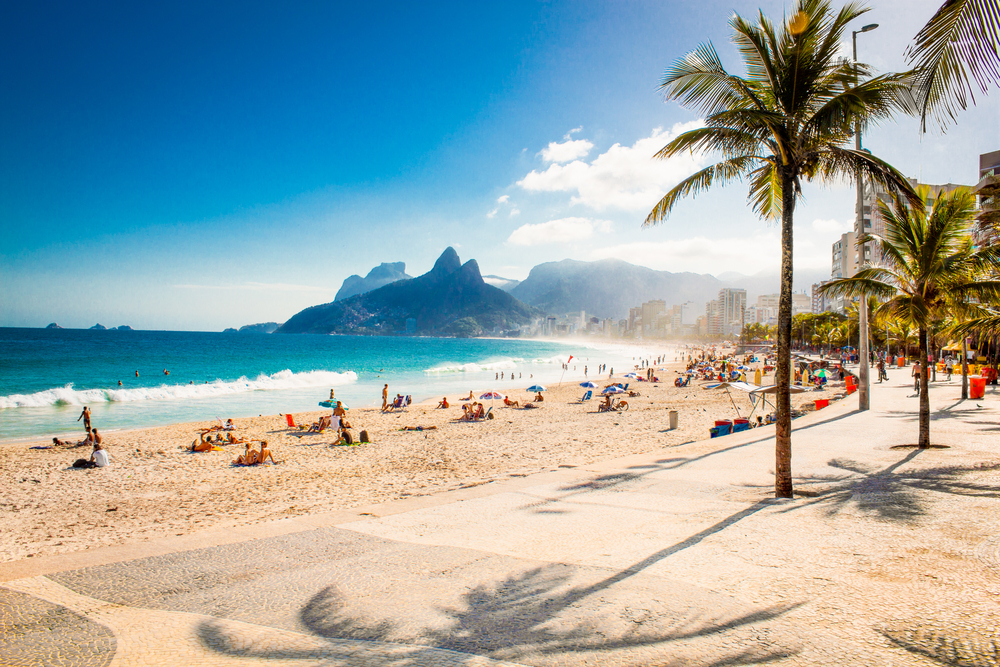
Aleksandar Todorovic/Shutterstock
When it comes to travel, there’s no one-size-fits-all answer. Your individual needs, preferences, and schedule will all play a part in how much you pay for your trip.
We’ve broken down costs by category so you can get a general idea how much other travelers spend on each. Pick and choose depending on your own priorities to get the trip you want at the right price.
Accommodation Costs
It is possible to find clean, well-located, well-appointed hotel rooms in Brazil for far less than you’d pay in other countries.
In Rio de Janeiro, for instance, your options include the well-reviewed Hotel Atlantico Tower . This three-star hotel is just a fifteen minute walk from Brazil Central Station, and only a couple of kilometers from attractions that include the AquaRio aquarium.
Some guests describe it as old, but say the central location and terrific service balances it out. Rooms run around $30 a night most times of year.
However, expect room costs to increase during big events like Carnival. A room at the Sant’ Matre during Carnival, for instance, may cost around $100. Expect to pay around $150 during that time of year at The Windsor Copa Hotel.
In other parts of the country, you may pay a bit more for your room. São Paulo, for instance, has a number of hotel options between $60 and $150 a night.
At the bargain end is the four-star Novotel São Paulo Jaragua Conventions, a modern hotel with an affordable $64 a night price tag. If you are looking for luxury, consider the Hilton São Paulo Morumbi, a five-star hotel with two restaurants and a spa on-site. Expect to pay a bit over $200 a night.
Flight Cost
Where you choose to land will have a huge impact on how much you will pay for your flight.
A flight from New York to Rio De Janero will cost around $550, depending on the time of year. A flight to São Paulo will cost anywhere from $400 to $900.
Other locations are often more expensive. The average cost of a flight to Salvador, for instance, will run around $750 per person.
Brazil is a large country, so you may wish to fly from destination to destination once you are there. A flight from Rio Di Janero in the south to Salvador near the country’s northern border will run you just under $200.
Food, Drink & Activity Costs
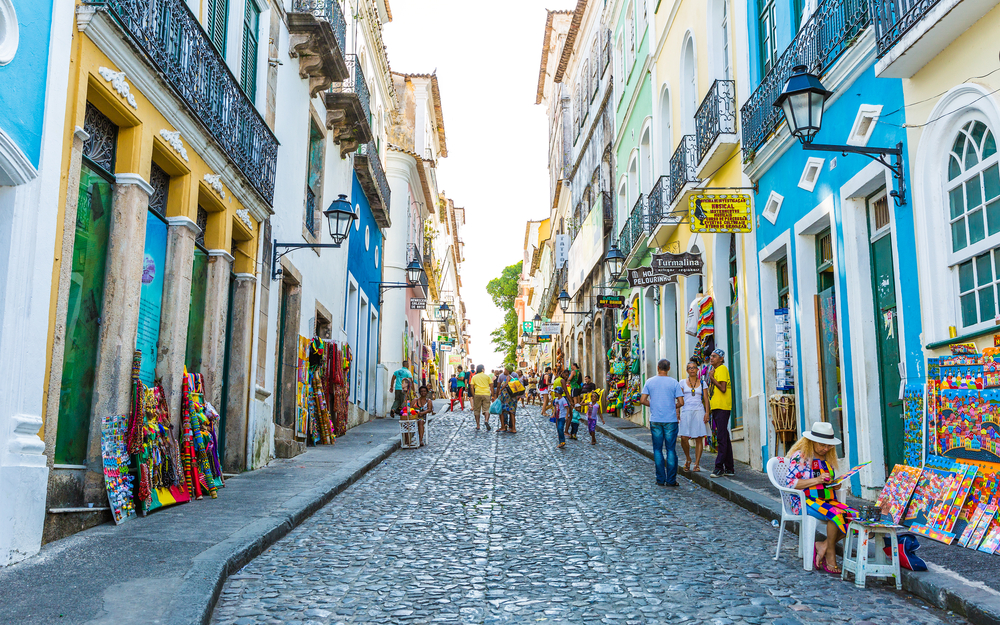
BAHIA, BRAZIL – CIRCA NOV 2014: People walk in Pelourinho area, famous Historic Centre of Salvador, Bahia in Brazil/ESB Professional/Shutterstock
Food costs will depend largely on what sorts of meals you are looking for. A meal at an inexpensive restaurant will typically cost the equivalent of $5 per person.
If you are looking for something more formal, Numbeo says you can expect to pay around $28 per person for a three-course meal for two at a mid-range restaurant.
When you see a price for a glass of beer, assume it’s for a .25 liter serving, which is about half the size of a pint. The price for this will be around $2. You also may be served a 600 cL bottle, which costs about $3 for an import beer.
Most Brazilians drink bottled water instead of tap water. A bottle of water will run you around 75 cents. Cappucino and espresso are the usual breakfast drinks, and should be around $1 to $2 a serving.
Brazil is mad for soccer, and it’s inexpensive to attend a game. Expect to pay less than $10 for a ticket. Carnival Brazil is one of the biggest attractions and occurs every year just before Lent.
The dates vary, so check your calendar. Carnival festivals are held in cities and towns throughout the country, and prices for attendance vary. Some smaller ones are free. But, if you want to see the parade in Rio de Janiero from the Samadrome, you’ll need to buy a ticket.
Ticket costs start around $30, but can go as high as $300 for VIP seats. Buy tickets early as they tend to sell out. A Sambadrome ticket includes the cost of a subway ticket to the event.
If you are going to be in the southern part of the country, be sure to take in some of the area’s German-influenced culture. One good way to do this is on the hop-on/hop-off bus tour, which highlights local breweries.
A ticket good for two days costs $65 per adult. Botanical gardens and national parks are great ways to see the country’s unique flora and fauna. Admission to the parks ranges from $15 to $20.
One exception is the Tujuca National Park in the mountains that surround Rio de Janeiro. Admission to this national park is free. However, tours that take you to the Christ the Redeemer sculpture may cost around $25.
Good researchers can find many more free activities for their time in Brazil. The Botanical Garden of Curitiba has free admission, and is a great place to observe art nouveau architecture and French-style gardens.
Lago Negro in Gramado offers free admission. Visitors can walk the trail or people watch from the many benches.
You can also rent a swan-shaped paddle boat for under $30. Public beaches can also be entered for free. Either bring your own towel and cooler, or rent one on the beach for a few dollars.
Transportation Costs
Because Brazil is such a large country, many people who are visiting more than one city choose to rent a car. Car rental is fairly inexpensive, with most sites quoting around $10 a day.
Bus service within the cities is considered excellent. Posters on Reddit were particularly impressed with bus service in Salvador. Paved bike lanes are also common in Salvador, making that another feasible option for transportation.
Trains are also available in many large cities. A Metro Card to take the subway in Rio de Janiero will cost about the equivalent of $1 per person per day.
Many cities in Brazil have low-cost bike rentals through services like Bike Rio for around $5 for 48 hours. The rentals are managed through an app on your phone and bikes can be picked up around town.
Things to Consider
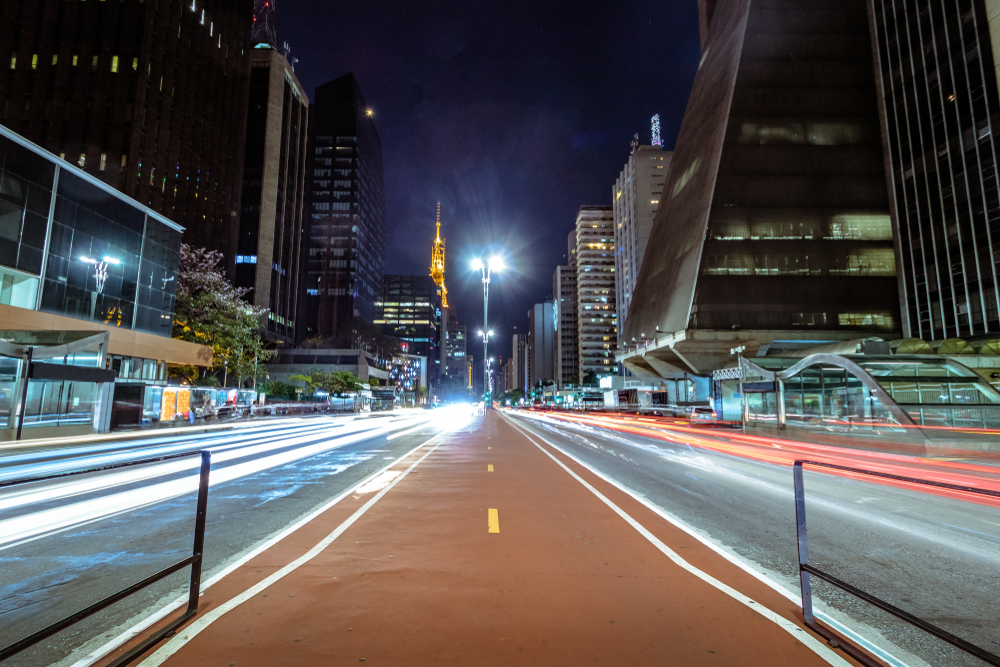
Diego Grandi/Shutterstock
- During the summer (January) it rains just about every day. The rain usually only lasts a couple of hours, though, so it is easy to plan around it.
- The country is warm and friendly, but be cautious after dark. Many travelers recommend getting a cab or Uber home if you’re out late.
- Download a Portuguese dictionary to your translator app of choice. (We like Google Translate.) Many Brazilians learn English in school, but it is not universally spoken, especially outside major cities.
- Tap water is safe to drink, but is often not palatable. Most locals drink bottled water instead.
Frequently Asked Questions
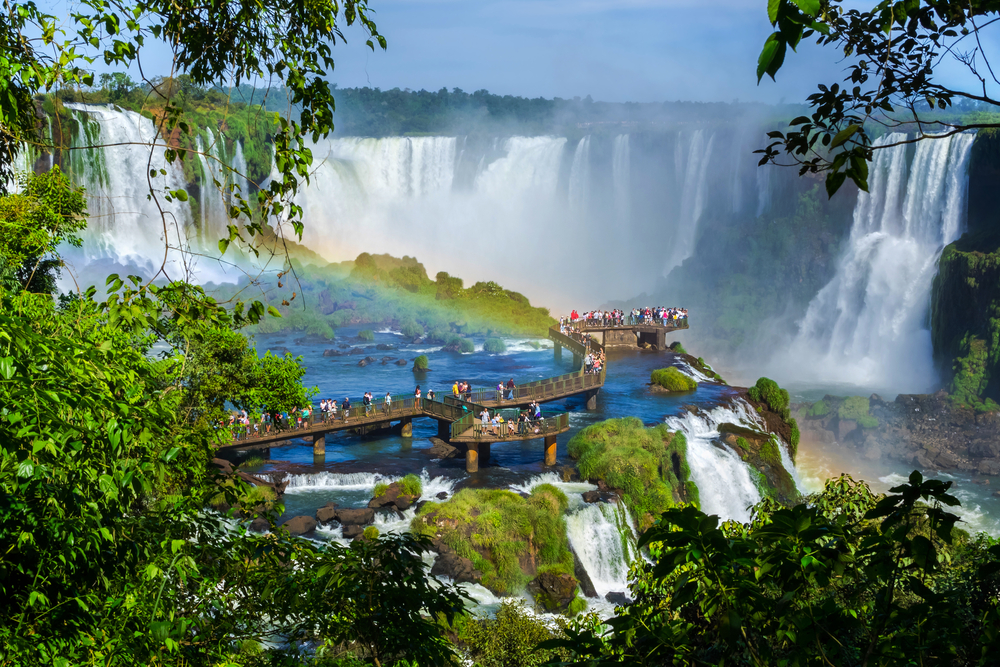
R.M. Nunes/Shutterstock
Is a week enough in Brazil?
Brazil is the largest country in South America. A week is the bare minimum to spend in this rich and diverse country. Many travel guides suggest two to three weeks instead. If you only have a week, consider concentrating on a specific city or region.
Is a visit to Brazil worth it?
Travelers who’ve gone to Brazil consider it the trip of a lifetime. If you have the opportunity to visit this country, take it.
What’s the cheapest time to travel to Brazil?
May through September is Brazil’s low season and when you’ll likely find the cheapest prices on flights and hotels. The only exception is July, which is a school holiday month.
What are the best months to go to Brazil?
This all depends on what you want to see. June through December has less rainfall, which makes it the best time to visit the jungle. If your trip will take you to Rio, June to September is the sweet spot for dry, mild weather. However, temperatures are pleasant year round, making any month a good month to go to Brazil.
So, What Is the Average Trip Cost for Brazil?
All in all, expect to spend about $2,100 for a one-week trip for two to Brazil. How much it will cost will depend heavily on when you are going and what you want to do while you are there.
The more open you are to experiencing the country like a local, the more affordable your trip will be.
So, get out of your comfort zone and open yourself up to the largest and one of the most diverse countries in South America for the trip of a lifetime. Happy travels!
When to Go: Is Brazil Safe to Visit in 2024? | Safety Concerns The Best & Worst Times to Visit Brazil (Updated for 2024) What to Do: The 15 Best Places to Visit in Brazil in 2024 (Our Recommendations)
- Travel Planning Guide
How much does a trip to Brazil Cost?

How much money should you budget for your trip to Brazil?
- How much does a one-week trip to Brazil cost?
- How much does a two-week trip to Brazil cost?
- How much does a one-month trip to Brazil cost?
- Hostel Prices
- Hotel Prices
The Cost of a Trip to Brazil
Visitors to Brazil usually spend between $29 and $218 per day on average for one person and $59 to $437 for two people. While this is a wide range, the average daily cost averages $78 (R$396) per person. This average includes sightseeing, hotel, food, and local transportation expenses from other travelers. Your individual travel expenses may vary based on travel style and the locations visited, but if you plan wisely while visiting the most popular destinations, such as Sao Paulo, Rio de Janeiro, and Fortaleza, then you'll likely spend somewhere in this price range while on your trip. Further down we have a breakdown of expenses by category, as well as a comparison of independent travel versus guided tour prices.
If you're considering an independent trip to Brazil, it's helpful to have an idea of the amount of money you'll need. For budget travelers, planning to spend around $29 (R$149) per day should cover your essential expenses, including affordable accommodations like hostels and budget hotels, cost-effective meal options, local transportation, and affordable activities. For those with a mid-range budget, allocating around $78 (R$396) per day would allow for more comfortable hotels, dining at typical restaurants, and exploring a range of popular attractions. Luxury travelers, on the other hand, should anticipate a daily budget of $218 (R$1,108), which would encompass higher-end accommodations, dining at nicer restaurants, and indulging in private tour options. It's worth noting that these price ranges are based on extensive travel cost data for Brazil from fellow travelers, as well as insights from travel companies regarding hotel and tour prices. For further details on travel costs, you can refer to our comprehensive travel cost data for Brazil .
How much does a one week trip to Brazil cost?
Most visitors spend between $206 and $1,529 for a one week trip to Brazil, with the average being $547. This includes sightseeing, local transportation, food, and hotels. One week is enough time to visit one, two, or maybe three locations in Brazil, depending on how in-depth you want to make your visit. Some of the most popular places to visit are Sao Paulo , Rio de Janeiro , and Fortaleza .
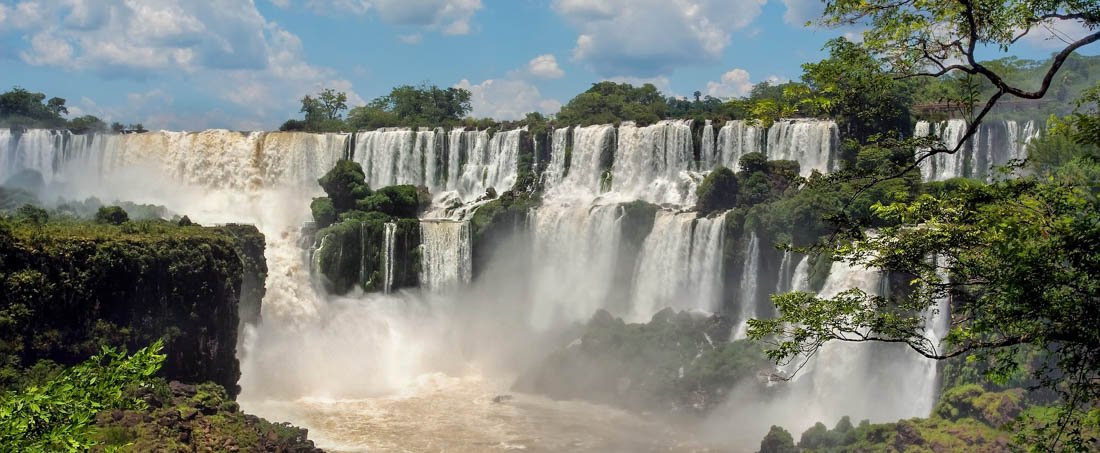
How much does a two week trip to Brazil cost?
With two weeks, you should budget between $412 and $3,058 for your trip to Brazil. The average price for a two week trip is $1,094. Two weeks will allow you enough time to visit between three and five places. If you're on a budget, you might want to consider some of the more affordable places such as Salvador, Sao Paulo, and Manaus.
How much does a one month trip to Brazil cost?
With a month-long trip to Brazil, expenses can be anywhere from $884 to $6,552 with the average being $2,345. The cost of travel is dependent on your overall style of travel. If you have a full month, you'll likely want to stay at a vacation rental with a kitchen during at least part of your trip so that you can prepare your own meals. Backpackers often prefer hostels for the same reason. Hostels also offer a more social atmosphere at a very affordable price range.
Hostel Prices in Brazil
With more than 400 hostels in Brazil, the average price is $14 per night for a dorm bed. Hostels are a terrific option for younger independent travelers looking to save money while staying social during their trip. With many types of hostels, it can be overwhelming to sort out the best places, though. Our analysis of the hostels in Brazil not only found the average price, but also uncovered some surprises about the overall quality, amenities, and atmosphere of hostels in the region. You can see more details from our analysis about typical hostel prices in Brazil here .
Here are a few sample prices from popular hostels in Brazil.
- $15 for a dorm bed at Books Hostel in Rio de Janeiro more details
- $18 for a dorm bed at O de Casa Hostel Bar in Sao Paulo more details
- $15 for a dorm bed at Tucano House Summer Hostel in Florianopolis more details
Hotel Prices in Brazil
You'll find a wide range of hotel options across Brazil. Below are prices for some of the destinations, and for more details see our analysis of hotel costs in Brazil .
Mama Ruisa Boutique Hotel
Hotel cadoro sao paulo.
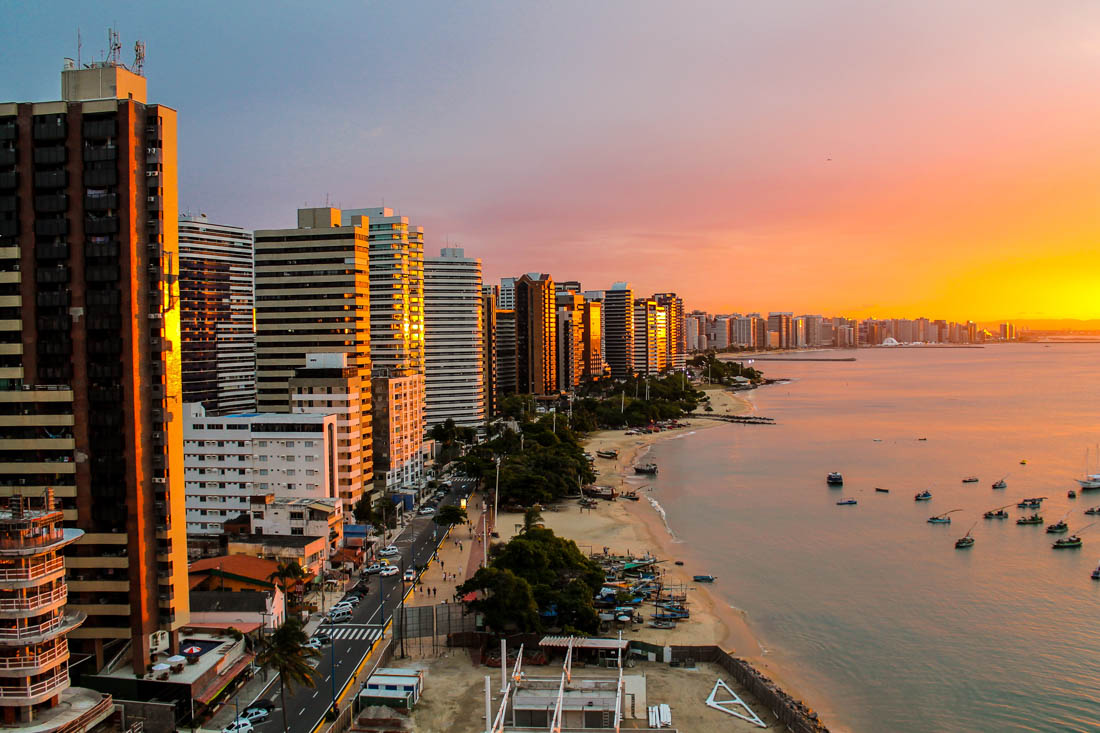
Should you do an organized tour or travel independently in Brazil?
Organized tours are an easy and convenient way to visit Brazil. All of the details are handled by travel experts, and during the trip you'll benefit from the knowledge of an expert guide.
Traveling independently offers freedom and flexibility that is hard to find on an organized tour.
Many travelers appreciate the convenience and ease that an organized tour offers. Many tours provide transportation and expert guides that help you enjoy your trip.
Alternatively, you'll enjoy freedom and flexibility with independent travel that is difficult to find with an organized tour.
Comparing Trip Costs in Brazil
When we compare the prices of organized tours to the average costs of independent travelers, we can see that sometimes the prices are fairly even.
Tours vs. independent Travel: Pros & Cons
Organized tours.
- An expert guide familiar with the culture
- Convenient transportation
- Fellow travelers to socialize with
- Well researched activities
- Efficient and thought out itinerary
- The security of have a trip leader if something goes wrong
- Limited options
- Usually not customizable
- The fast pace often means you can’t visit one place in depth
- Usually more expensive than independent travel
- There may be limited time to interact with the local culture and community
Independent Travel
- Completely customizable
- Opportunity to visit off-the-beaten-path destinations
- Can fully immerse yourself in the local culture
- Freedom to move at your own pace
- Flexibility to change your itinerary at any time
- More affordable
- Challenging to plan an efficient itinerary
- Transportation may be challenging or inefficient
- Booking and trip planning can be a hassle
- Popular sights may sell out well in advance
- If something goes wrong, you're on your own
Are organized tours more expensive than independent travel in Brazil?
Organized tours average $247 per day in Brazil, and are generally all-inclusive with one large payment. Independent trips usually average $78 (R$396) per day, and include individual payments to hotels, local transportation, food, and sightseeing. When compared, organized tours and independent trips each come with their own set of challenges and benefits. It's important to understand all aspects of both types of trips to make a fair comparison. You can see our thorough analysis of tour prices in Brazil here .
Here are a few sample tours in Brazil:
- Pantanal, Bonito & Iguazu Adventure 9D/8N (from Foz do Iguacu) ($1,434) 9 days, 4 destinations more details
- Iguazu Discovery Air-Expedition 12D/11N ($2,477) 12 days, 4 destinations more details
- 4 Days North Pantanal - Unearthing exotic treasures in the Pantanal wetlands - New*** ($1,412) 4 days, 2 destinations more details
- Spirit of South America ($5,169) 15 days, 8 destinations more details
- Spirit of South America with Amazon ($6,419) 19 days, 8 destinations more details
More for Brazil
If you're planning a trip to Brazil, check out these other informative travel guides.
We've been gathering travel costs from tens of thousands of actual travelers since 2010, and we use the data to calculate average daily travel costs for destinations around the world. We also systematically analyze the prices of hotels, hostels, and tours from travel providers such as Kayak, HostelWorld, TourRadar, Viator, and others. This combination of expenses from actual travelers, combined with pricing data from major travel companies, gives us a uniqe insight into the overall cost of travel for thousands of cities in countries around the world. You can see more here: How it Works .
Subscribe to our Newsletter
Coupons and discounts! Travel tips!
1 Categories averaged on a per-item basis. 2 Categories averaged on a per-day basis. For example, the Food 2 daily average is for all meals for an entire day, while Entertainment 1 is for each individual purchase. Thus, the overall daily average cost is not a summation of the individual categories.
- You are welcome to reference or display our travel costs on your website as long as you provide a link back to this page .
- For a basic link, you can copy and paste the HTML link code, or this page's address. Address Link HTML Brazil Travel Costs " disabled />

Some of the links on this website are sponsored or affiliate links which help to financially support this site. By clicking the link and making a purchase, we may receive a small commission, but this does not affect the price of your purchase.
- Privacy / Terms of Use
- Activities, Day Trips, Things To Do, and Excursions
Cost of a Trip to Brazil & the Cheapest Time to Visit Brazil
The average price of a 7-day trip to Brazil is $1,488 for a solo traveler, $2,637 for a couple, and $1,076 for a family of 4 . Brazil hotels range from $36 to $182 per night with an average of $56, while most vacation rentals will cost $60 to $430 per night for the entire home. Average worldwide flight costs to Brazil (from all airports) are between $1,021 and $1,602 per person for economy flights and $3,206 to $5,030 for first class. Depending on activities, we recommend budgeting $29 to $59 per person per day for transportation and enjoying local restaurants.
See below for average , budget , and luxury trip costs. You can also look up flight costs from your airport for more tailored flight pricing.
The Cheapest Times to Visit Brazil
On average, these will be the cheapest dates to fly to Brazil and stay in a Brazil hotel:
- January 29th to February 11th
- March 5th to April 1st
- May 14th to June 3rd
- August 6th to December 2nd
The absolute cheapest time to take a vacation in Brazil is usually early September .
Average Brazil Trip Costs
Average solo traveler.
The average cost for one person to visit Brazil for a week is $1,018-$2,243 ($145-$320 per day)
Food, Travel, and Sightseeing : $29 to $59 per day for one person’s daily expenses
Flights : $545 to $1,416 for economy
Lodging : $45 to $61 per night for one 2 or 3-star hotel room
or $57 to $69 per night for a 1-bed vacation rental
Average Couple’s Trip
The average cost for a couple to visit Brazil for a week is $1,760-$4,078 ($251-$583 per day)
Food, Travel, and Sightseeing : $57 to $119 per day for two people’s daily expenses
Flights : $1,091 to $2,831 for economy
Average Family Vacation
The average cost for 4 people to visit Brazil for a week is $3,496-$8,061 ($499-$1,152 per day)
Food, Travel, and Sightseeing : $115 to $238 per day for four people’s daily expenses
Flights : $2,181 to $5,663 for economy
Lodging : $89 to $122 per night for two 2 or 3-star hotel rooms
or $85 to $104 per night for a 2-bed vacation rental
Traveling Cheap to Brazil
How cheap can you make a vacation to Brazil? The cheapest trip to Brazil is about $118 per person per day for travelers willing to take standby flights, deal with inconvenience, and otherwise limit travel expenses. About 21% of rentals are available in the $0 to $100 range for an entire place, and vacation rentals can be booked for as low as $16 per night. These inexpensive rentals must be booked as early as possible and may not be in the most desirable areas. 1-star hotels are more likely to be available, with rooms starting at around $31.
Even cheaper trips are possible depending on where you live and whether you can drive. Check the cheapest times to fly for more saving ideas.
Budget Solo Traveler
The lowest cost for one person to visit Brazil for a week is $829-$1,997 ($118-$285 per day)
Food, Travel, and Sightseeing : $14 to $29 per day for one person’s daily expenses
Lodging : $31 to $36 per night for one 1-star hotel room
or $33 to $63 per night for a 1-bed vacation rental
Budget Couple’s Trip
The lowest cost for a couple to visit Brazil for a week is $1,480-$3,615 ($211-$516 per day)
Food, Travel, and Sightseeing : $29 to $58 per day for two people’s daily expenses
Budget Family Vacation
The lowest cost for 4 people to visit Brazil for a week is $2,887-$7,032 ($412-$1,005 per day)
Food, Travel, and Sightseeing : $58 to $115 per day for four people’s daily expenses
Lodging : $61 to $72 per night for two 1-star hotel rooms
or $50 to $94 per night for a 2-bed vacation rental
Overall it is easy to travel to Brazil cheaply.
The Cost of a Luxury Brazil Trip
There is no true ceiling on the cost of a luxury trip, so our estimates are based on what most people do in Brazil.
Luxury Solo Traveler
The high-end price for one person to visit Brazil for a week is $2,308-$9,420 ($330-$1,346 per day)
Food, Travel, and Sightseeing : $57 to $119 per day for one person’s daily expenses
Flights : $1,357 to $3,517 for first class
Lodging : $92 to $182 per night for one 4 or 5-star hotel room
or $424 to $845 per night for a preferred vacation rental
Luxury Couple’s Trip
The high-end price for a couple to visit Brazil for a week is $4,071-$13,770 ($582-$1,967 per day)
Food, Travel, and Sightseeing : $115 to $238 per day for two people’s daily expenses
Flights : $2,714 to $7,034 for first class
Luxury Family Vacation
The high-end price for 4 people to visit Brazil for a week is $8,135-$25,015 ($1,162-$3,574 per day)
Food, Travel, and Sightseeing : $229 to $477 per day for four people’s daily expenses
Flights : $5,428 to $14,068 for first class
Lodging : $184 to $364 per night for two 4 or 5-star hotel rooms
or $635 to $1,268 per night for a preferred vacation rental
Brazil Hotel Prices
The cost of staying in Brazil is lower than the average city. On average vacation rentals are less expensive than hotels. Luxury hotels are more expensive in Brazil due to hotel employees. The graphs below show how much cost can vary depending on the type of experience you’re looking for.
Brazil Lodging Cost by Star Status
The average price for the class of hotel is on the (y) axis. The hotel class (out of 5 stars) is on the (x) axis.
Prices are based on Brazil hotel averages and may not reflect current prices. In some cases, we extrapolate prices to estimate costs, and hotels with your desired star rating may not be available.
Vacation Rental Prices
The percent of vacation rentals in the price range is on the left (y) axis. Price range is on the bottom (x) axis.
There are a healthy amount of vacation rentals serving all budgets in Brazil.
Flight Costs to Brazil
Averaging flights around the world, prices go from a high of $1,602 average in late December to a low of $1,021 in early September. Median flight price is $1,149. These prices are based on millions of flights. For Brazil our data includes thousands of originating airports, and hundreds of airlines. The area has more variance in price compared with other locations.
Average Flight Cost by Season
Average flight cost by day of week.
The cheapest day to fly in is typically Tuesday, and the cheapest day to fly back is usually Tuesday. Click here to see data for the cost of flights from your airport. In Brazil, the difference between the cheapest and the most expensive week is about $581, so you can easily save about 57% simply by using our free flight guides and booking in advance.
Daily Expenses Budget
Daily vacation expenses vary more based on what you’re interested in doing. A fine dining restaurant with drinks around Brazil can easily cost $216 per person or more, while a standard nice meal might be about $14 per person. Private tours can cost $432 per day, but self-guided tours to see the outdoor sights can be free. Costs vary wildly, so recommendations are made based on the cost of living and averages we see for this type of vacation.
Other Brazil Guides
Travel costs nearby.
- Sete Lagoas, Brazil
- Esmeraldas, Brazil
- Confins, Brazil
- Santana do Riacho, Brazil
- Ribeirão das Neves, Brazil
- Lagoa Santa, Brazil
- Vespasiano, Brazil
- Betim, Brazil
- Divinopolis, Brazil
- Contagem, Brazil
Travel Costs in Popular Places
- San Antonio, TX, US
- New Delhi, India
- Colombo, Sri Lanka
- Car Rentals
- Airport Transfers
- Attractions & Tours
- Flight + Hotel
- Destinations
- Trip.com Rewards
The Ultimate Guide to the Cost of Traveling to Brazil in 2024

by Trip.com
August 25, 2023
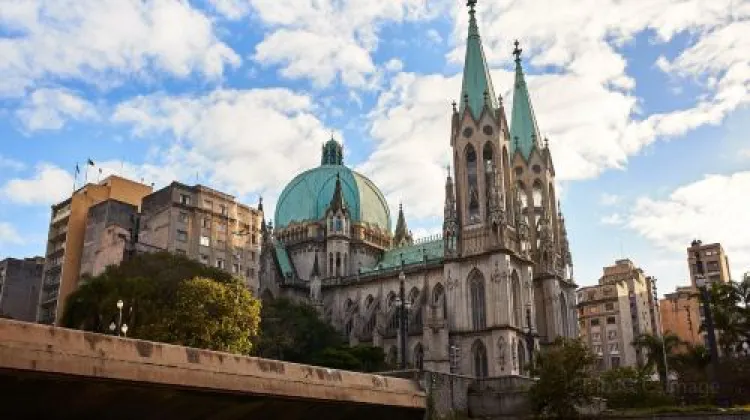
Brazil, a vibrant and diverse country in South America, is a dream destination for many travelers. Planning a trip to Brazil can be an exciting adventure, but it's essential to consider the cost. In this article, we aim to provide you with the best tips for saving money without compromising on quality. From finding affordable accommodations and delicious local cuisine to navigating the transportation system and discovering budget-friendly activities, we've got you covered. So, if you're wondering about the trip to Brazil cost, keep reading to make the most of your travel budget!
When it comes to the cost of a trip to Brazil, it's crucial to consider various factors. The range of flight costs for a round-trip ticket from major cities in the United States to Brazil can vary between $500 to $1500, depending on the season and airline. Accommodation costs also vary significantly, with budget hotels or hostels starting at around $20 per night, while luxury hotels can range from $150 to $500 per night. As for transportation, Brazil has an extensive and efficient public transportation system, with the cost of a one-way subway or train ticket ranging from $0.50 to $1.50.
When it comes to dining, Brazil offers a wide range of options to suit every budget. You can enjoy delicious meals at budget restaurants for as low as $5 per person, while mid-range restaurants may cost around $15 to $30 per person. Now, let's talk about daily expenses. A budget traveler can expect to spend approximately $40 to $60 per day, including accommodation, food, transportation, and activities. On the other hand, a mid-range traveler can expect to spend around $80 to $120 per day. It's important to plan ahead and research activities and costs to create a budget that works for you.
- How much does it cost for 2 nights and 3 days when traveling to Brazil?
Hey there, fellow travel enthusiasts! Planning a trip to Brazil and wondering how much it'll cost you for a quick getaway? Well, you've come to the right place! The cost of a 2-night, 3-day trip to Brazil can vary depending on various factors such as your travel style, choice of accommodation, transportation, and activities. But worry not, I've got you covered with a rough estimate of the cost for a budget traveler.
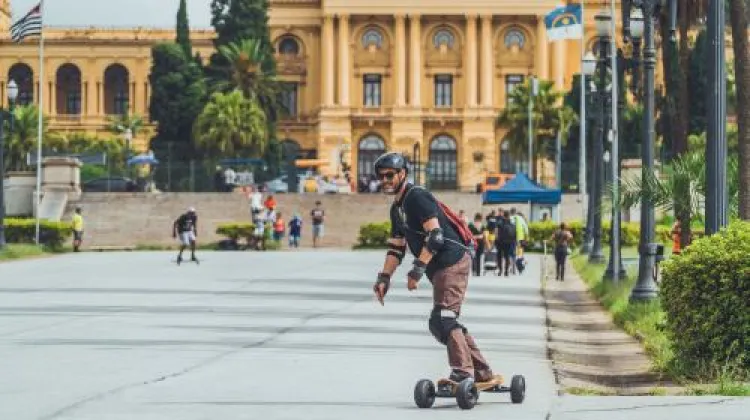
Let's break it down, shall we?
First things first, let's talk about flights. The cost of a round-trip ticket to Brazil from major cities around the world can range anywhere from $500 to $1500 in US dollars. Keep in mind that prices may vary depending on the time of year and availability, so it's always a good idea to book in advance and keep an eye out for deals.
Accommodation
Now, let's find you a cozy place to rest your head. Budget hotels in Brazil can range from $30 to $100 per night in US dollars. So for 2 nights, you can expect to spend anywhere from $60 to $200 on accommodation.
Transportation
Getting around Brazil is a breeze, thanks to its efficient transportation system. A one-way subway or train ticket can cost you around $1 to $3 in US dollars. So for 3 days, you can estimate your transportation expenses to be around $6 to $18.
Food and Drinks
Now let's talk about the best part of any trip - the food! When it comes to dining in Brazil, budget travelers have plenty of options. A meal at a budget restaurant can cost you anywhere from $5 to $15 per person in US dollars. But here's a little secret - street food and convenience store meals can cost even less, so keep that in mind if you're looking to save some extra cash. As for drinks, prices can vary depending on the type of drink and location, but you can expect to spend around $1 to $5 per drink. So for 3 days, you can budget around $60 to $180 for food and drinks.
Sightseeing and Activities
Now let's explore the vibrant attractions Brazil has to offer. There are plenty of popular attractions that won't cost you a dime or may have a small entrance fee ranging from $1 to $10 in US dollars. Some of these include the iconic Christ the Redeemer statue, the breathtaking Iguazu Falls, and the vibrant streets of Rio de Janeiro. However, if you're looking for a more immersive experience, there are other attractions that may cost a bit more. For example, a visit to the Amazon rainforest or a thrilling samba dance class can range from $50 to $200 per person. So for 3 days, you can expect to spend around $30 to $300 on sightseeing and activities.
The Bottom Line
So, how much does a 2-night and 3-day trip to Brazil cost for a budget traveler? Roughly speaking, you can expect to spend anywhere from $657 to $2198 in US dollars. However, please keep in mind that these are just rough estimates and actual costs may vary depending on your travel style, activities, and other expenses. It's always a good idea to plan ahead, do your research, and set a budget that suits your needs. Happy travels!
- How much does it cost for flights when traveling to Brazil?
Planning a trip to Brazil? One of the first things you'll need to consider is the cost of flights. But don't worry, we've got you covered! The cost of flights to Brazil can vary depending on a few factors, including your departure location, the time of year you plan to travel, the airline you choose, and the availability of tickets.
Let's dive into the details and give you a general range of the cost in US dollars for both one-way and round-trip tickets from major cities around the world to Brazil.
Starting with departure locations, flights from popular cities like New York, London, and Sydney tend to have more options and therefore more competitive prices. On average, a one-way ticket from these cities to Brazil can range from $500 to $1500, depending on the class you choose.
Speaking of classes, let's talk about the different options available. If you're looking for a budget-friendly option, economy class is your best bet. One-way economy tickets can start as low as $500, but keep in mind that prices can go up during peak travel seasons.
If you prefer a little more comfort and legroom, premium economy might be the right choice for you. Prices for one-way premium economy tickets can range from $800 to $2000, depending on the airline and availability.
For those seeking the ultimate luxury experience, business class is the way to go. One-way business class tickets can start around $1500 and go up to $5000 or more, depending on the airline and the level of luxury you desire.
Now, let's talk about round-trip tickets. Booking a round-trip ticket can often save you some money compared to buying two separate one-way tickets. The cost of round-trip tickets from major cities to Brazil can range from $1000 to $3000 for economy class, $1500 to $4000 for premium economy, and $3000 to $8000 or more for business class.
Remember, these prices are just a general range and can vary depending on the factors mentioned earlier. It's always a good idea to compare prices from different airlines and use online travel agencies to find the best deals.
So, whether you're planning a beach getaway in Rio de Janeiro or exploring the Amazon rainforest, keep in mind that the cost of flights to Brazil can vary. Take your time to research and find the best option that suits your budget and travel preferences. Bon voyage!
- How much does it cost for hotels when traveling to Brazil?
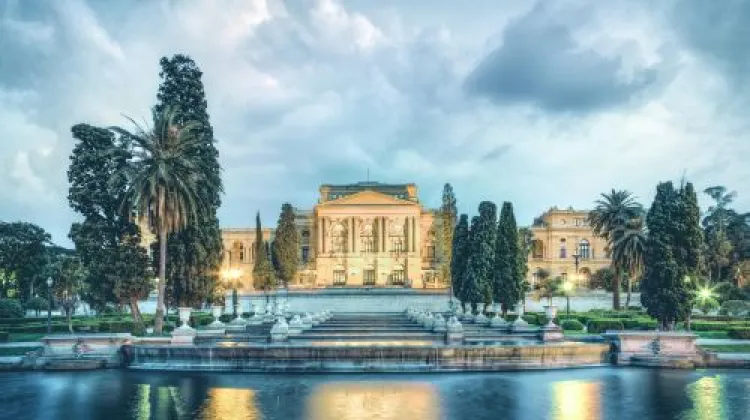
Planning a trip to Brazil? One of the key considerations is the cost of accommodation. The price of hotels in this vibrant country can vary depending on several factors, including the location, season, and the type of accommodation you're looking for.
When it comes to major cities like Rio de Janeiro and Sao Paulo, it's important to keep in mind that hotels tend to be more expensive compared to smaller cities or rural areas. These bustling metropolises offer a wide range of accommodation options, from budget-friendly to luxurious.
In major cities, the average cost range for a mid-range hotel room per night is around $80 to $150. For those seeking a more luxurious experience, the price range for a luxury hotel room can go up to $300 or more per night. These prices may fluctuate depending on the season and availability, so it's always a good idea to book in advance.
On the other hand, if you're planning to explore other cities and smaller towns in Brazil, you'll find that the cost of hotels is generally more affordable. In these areas, the average cost range for a mid-range hotel room per night is around $50 to $100. For a touch of luxury, you can expect to pay around $150 to $250 per night for a luxury hotel room.
It's worth noting that these price ranges are estimates and can vary depending on factors such as location, amenities, and popularity. To get the best deals, it's recommended to compare prices and book in advance. So, whether you're looking for a bustling city experience or a tranquil getaway, Brazil offers a range of accommodation options to suit every budget.
- How much does it cost for food when traveling to Brazil?
Planning a trip to Brazil? One of the things you might be wondering about is the cost of food. Well, let me tell you, the cost of food and dining in Brazil can vary widely depending on several factors. From the type of food you choose to the location of the restaurant, and even the level of formality or luxury, these factors can all influence the price you pay for a meal.
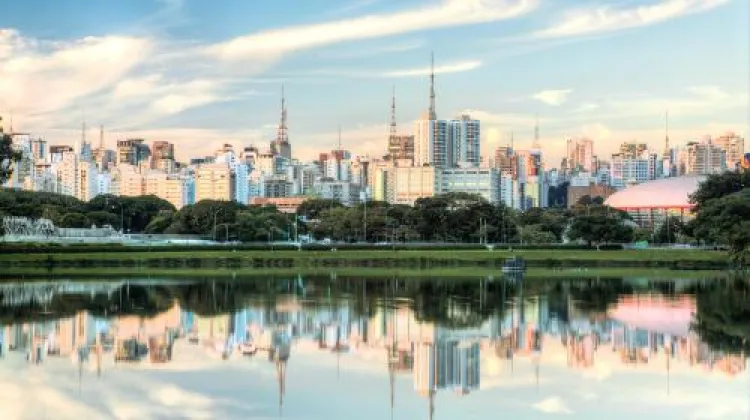
So, let's dive right into it and give you some general price ranges in US dollars per meal. Keep in mind that these are just rough estimates and can vary depending on the specific establishment.
For street food or fast food options, you can expect to pay around $5 to $10 per meal. These quick and tasty bites are perfect for those on the go or looking for a budget-friendly option.
If you prefer a more casual dining experience at a local restaurant, you can expect to spend around $10 to $20 per meal. This is a great way to try out traditional Brazilian dishes and immerse yourself in the local culture.
For those looking for a mid-range dining experience, you can expect to pay around $20 to $40 per meal. These restaurants often offer a wider variety of dishes and a more refined atmosphere.
Now, if you're in the mood to splurge and indulge in a high-end or luxury dining experience, be prepared to spend around $40 and above per meal. These establishments offer top-notch service, exquisite cuisine, and a truly memorable dining experience.
But wait, there's more! If you're looking for more affordable options, Brazil also has convenience stores and supermarkets where you can find a variety of snacks, ready-to-eat meals, and groceries. This can be a great way to save some money while still enjoying delicious food.
Now, let's talk about tipping. In Brazil, tipping is not mandatory, but it is customary to leave a tip if you receive good service. A tip of around 10% of the total bill is generally appreciated. However, always check if a service charge has already been included in the bill before deciding on the tip amount.
So, there you have it! The cost of food in Brazil can vary depending on your preferences and the type of dining experience you're looking for. Whether you're on a budget or ready to splurge, Brazil has a wide range of options to satisfy your taste buds. Enjoy your trip and happy eating!
How much does it cost for souvenirs when traveling to Brazil? Well, let me tell you, amigo, the cost of souvenirs in Brazil can vary like the waves on Copacabana beach. It all depends on what you're after, where you're shopping, and the quality you're seeking. From vibrant carnival masks to sassy Havaianas flip-flops, Brazil offers a plethora of unique keepsakes to bring back home. So, let's dive into the price range of some popular souvenirs, shall we?
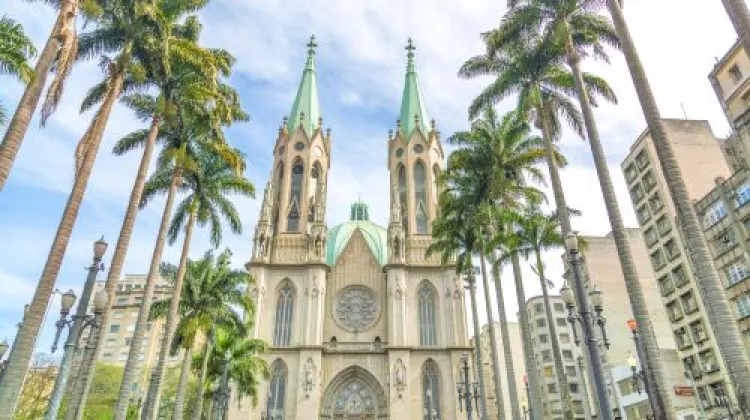
First up, we have those eye-catching carnival masks that can transport you straight to the heart of Rio's samba parade. These beauties can range from $10 to $50, depending on the intricacy of the design and the materials used. If you're more into fashion, you can't miss out on the iconic Havaianas flip-flops. These trendy sandals can cost you anywhere from $15 to $30, depending on the style and limited edition prints.
For the art enthusiasts out there, Brazil is a treasure trove of handcrafted wooden sculptures. From adorable animal figurines to breathtaking religious icons, these masterpieces can range from $20 to $200, depending on the size and level of detail. And let's not forget about the irresistible Brazilian gemstones. Whether it's a dazzling amethyst or a mesmerizing topaz, these precious stones can cost you anywhere from $50 to $500, depending on the size and quality.
Now, when it comes to shopping for souvenirs in Brazil, keep in mind that many tourist areas have fixed prices. However, if you're feeling adventurous and want to test your bargaining skills, head to the local flea markets or antique shops. There, you might just score a fantastic deal on that one-of-a-kind item you've been eyeing. So, my friend, pack your haggling spirit and get ready to bring a piece of Brazil back home!
How much does it cost for transportation when traveling to Brazil?
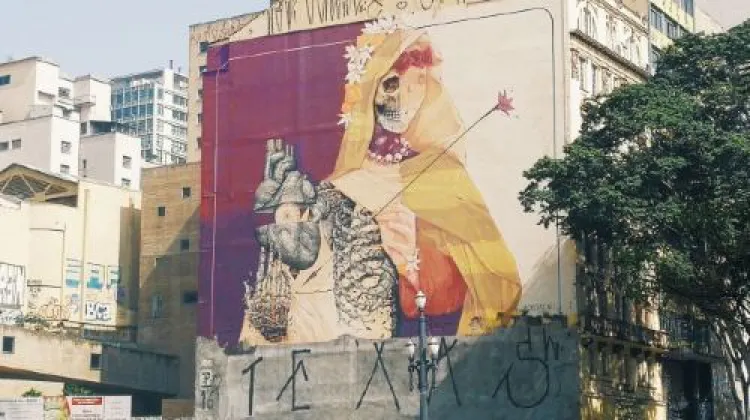
The cost of transportation in Brazil can vary greatly depending on the mode of transportation and the distance traveled. Whether you're exploring the vibrant streets of Rio de Janeiro or venturing into the lush Amazon rainforest, it's essential to plan your transportation expenses accordingly.
Let's dive into some cost ranges in US dollars for different types of transportation options available in Brazil:
Train: Train travel in Brazil is limited, and the cost can vary depending on the route. On average, a train journey can range from $10 to $50, depending on the distance and class of service.
Subway: Major cities in Brazil, such as São Paulo and Rio de Janeiro, have efficient subway systems. The cost of a subway ride typically ranges from $0.50 to $1.50, depending on the distance traveled.
Bus: Buses are a popular mode of transportation in Brazil, offering both comfort and affordability. The cost of a bus ticket can vary depending on the distance and the quality of the bus. On average, a bus ride can range from $5 to $30.
Taxi: Taxis are readily available in urban areas, and the cost can vary depending on the city and the distance traveled. A short taxi ride can cost around $5 to $10, while longer journeys can range from $20 to $50.
Rental Car: Renting a car in Brazil gives you the freedom to explore at your own pace. The cost of renting a car can vary depending on the duration of your trip, the type of car, and the rental company. On average, daily rental rates can range from $30 to $100.
Now, let's talk about transportation passes and discount tickets available in Brazil. For visitors planning to do a lot of traveling in a short period, transportation passes can be a great value. These passes often provide unlimited access to various modes of transportation, including buses, subways, and trains.
One example is the "Bilhete Único" in São Paulo, which offers discounted fares for multiple trips within a certain time frame. Another example is the "RioCard" in Rio de Janeiro, which provides discounted fares for buses, subways, and ferries.
It's important to research and inquire about these transportation passes and discount tickets before your trip to Brazil. They can help you save money and make your travel experience more convenient.
In conclusion, the cost of transportation in Brazil varies depending on the mode of transportation and the distance traveled. By considering the options mentioned above and exploring transportation passes and discount tickets, you can plan your trip to Brazil cost-effectively and enjoy the diverse beauty this country has to offer.
- How much does it cost for sightseeing when traveling to Brazil?
Planning a trip to Brazil? One of the first things you might be wondering is how much it will cost to explore the beautiful sights this vibrant country has to offer. Well, the cost of sightseeing in Brazil can vary widely depending on the location, attraction, and activity you choose. Let's take a closer look at some popular tourist spots and their cost ranges in US dollars.

1. Christ the Redeemer - This iconic statue in Rio de Janeiro is a must-visit for any traveler. The cost of a ticket to the top of Corcovado Mountain, where the statue is located, ranges from $15 to $25.
2. Iguazu Falls - Prepare to be amazed by the breathtaking beauty of these cascading waterfalls. The entrance fee to the national park starts at around $20, and additional activities like boat tours can range from $30 to $100.
3. Amazon Rainforest - Immerse yourself in the wonders of nature with a trip to the Amazon. Guided tours can range from $100 to $300, depending on the duration and activities included.
4. Salvador da Bahia - Explore the rich history and vibrant culture of this coastal city. Admission to popular attractions like Pelourinho, a UNESCO World Heritage Site, is often free, allowing you to soak up the atmosphere without breaking the bank.
5. Pantanal Wetlands - Embark on an unforgettable wildlife adventure in this vast wetland area. Guided tours start at around $150 and can go up to $500, depending on the duration and level of luxury.
6. Fernando de Noronha - This stunning archipelago is a paradise for beach lovers and divers. The cost of visiting the national marine park ranges from $100 to $200, and additional activities like snorkeling or diving can incur extra charges.
7. Ouro Preto - Step back in time and admire the colonial architecture of this historic town. Many of the churches and museums offer affordable admission fees, making it a budget-friendly sightseeing option.
8. Bonito - Known for its crystal-clear rivers and vibrant underwater life, Bonito offers a range of activities such as snorkeling and cave exploration. Prices for tours start at around $50 and can go up to $150.
While these popular attractions may come with a price tag, it's important to note that there are also plenty of free or low-cost sightseeing options in Brazil. For example, you can take a stroll along the famous Copacabana Beach in Rio de Janeiro or explore the colorful streets of Pelourinho in Salvador da Bahia, all without spending a dime.
So, whether you're on a tight budget or willing to splurge, Brazil offers a wide range of sightseeing options to suit every traveler's preferences. Start planning your trip to this captivating country and get ready to create unforgettable memories!
- How much does it cost for Wi-Fi & communication when traveling to Brazil?
When planning a trip to Brazil, it's important to consider the cost of Wi-Fi and communication to stay connected while exploring this vibrant country. Let's dive into the options and cost range in US dollars for accessing Wi-Fi in Brazil, ensuring you can stay connected without breaking the bank. One option is to rent a Wi-Fi router, which offers convenience and flexibility. Depending on the rental company and plan you choose, prices can range from $5 to $15 per day. This allows you to have your own personal Wi-Fi hotspot, ensuring a reliable connection wherever you go. Another option is to purchase a SIM card for your smartphone. Prices for SIM cards vary depending on the data plan and provider you select. On average, you can expect to pay around $10 to $30 for a SIM card with a decent data plan. This option is great if you prefer to use your own device and have access to data on the go. If you're looking for a budget-friendly option, free Wi-Fi is available in certain locations throughout Brazil. Many hotels and accommodations offer complimentary Wi-Fi for their guests, so it's worth checking before booking. Additionally, some smartphone apps like "WiFi Map" and "Instabridge" provide access to free Wi-Fi hotspots throughout the country, making it easier for you to stay connected without spending a dime. It's important to note that the cost of Wi-Fi in Brazil can vary depending on the method of access and the data plan you choose. However, with the numerous options available, you can find a solution that suits your needs and budget. So, stay connected and make the most of your trip to Brazil without worrying about expensive communication costs.
- How Much Does it Cost for a Visa When Traveling to Brazil?
Planning a trip to Brazil? Before you pack your bags and board that flight, it's important to know the cost of obtaining a visa. The price range for visa applications varies depending on your country of citizenship and the type of passport application. Let's take a closer look at some specific figures to give you an idea. For example, citizens of the United States can expect to pay around $160 for a tourist visa, while citizens of Canada may have to shell out approximately $100. However, it's worth noting that some countries enjoy visa-free access to Brazil, so be sure to check if you fall into that lucky category.
When it comes to visa applications, fees can differ based on your country of citizenship and the type of application you're submitting. It's also important to keep in mind that certain countries may require additional fees for visa applications or other travel documents. To ensure you have the most accurate and up-to-date information on passport and visa requirements and fees, it's always a good idea to reach out to your local embassy or consulate. They'll be able to provide you with the necessary guidance and ensure a smooth journey to Brazil.
- How much does it cost for insurance when traveling to Brazil?
The cost range of travel insurance for a trip to Brazil can vary depending on several factors. These factors include your age, the length of your trip, the type of coverage you need, and the insurance provider you choose. To give you a general idea, here are some guidelines for travel insurance costs:
For a single trip, the cost of travel insurance can range from around $50 to $200. This range is influenced by factors such as the duration of your trip and the level of coverage you require. It's important to compare different policies from various providers to find the one that best suits your needs and budget.
If you are a frequent traveler to Brazil or plan to take multiple trips within a year, an annual travel insurance policy might be a better option for you. The cost of an annual policy typically ranges from $300 to $600. This type of policy provides coverage for multiple trips throughout the year, offering convenience and potential cost savings.
If you want comprehensive coverage for your trip to Brazil, including medical expenses, trip cancellation or interruption, and baggage loss or delay, a comprehensive travel insurance policy is recommended. The cost of a comprehensive policy can range from $100 to $500, depending on the duration of your trip and the level of coverage you choose.
When comparing travel insurance policies, it's crucial to carefully read the policy details and understand what is covered and what is not. Pay attention to any deductibles or exclusions that may apply. Additionally, consider checking if your credit card or travel booking site offers travel insurance as a benefit or add-on, as this could be a convenient and potentially cost-effective option.
In conclusion, the cost of travel insurance for a trip to Brazil varies based on factors such as your age, trip duration, coverage needs, and insurance provider. To ensure you find the best coverage for your needs and budget, compare policies from different providers and thoroughly review the policy details.
How much does it cost for family, couples or single when traveling to Brazil?

The cost of traveling to the country can vary widely depending on a number of factors, such as the length of the trip, the type of accommodation, the level of luxury, the activities planned, and the number of travelers. Here are some estimated costs for a trip to the country:
Airfare: The cost of airfare to the can vary depending on the departure city and the time of year. You can expect to pay anywhere from a few hundred to several thousand dollars for a round-trip ticket from the United States to Brazil per person.
Accommodation: When it comes to accommodation, the cost can vary greatly depending on your preferences. For budget travelers, a night at a budget hotel or hostel can range from $20 to $50. If you're looking for a bit more comfort, a mid-range hotel can cost you anywhere from $50 to $150 per night. For those seeking luxury, you can expect to pay upwards of $200 per night for luxury hotels and ryokans.
Food and drink: The cost of food and drink in Brazil can also vary depending on your tastes. A budget meal at a local restaurant can cost you around $5 to $10 per person, while a mid-range meal can range from $10 to $30 per person.
Transportation: Getting around in Brazil can be affordable if you choose the right mode of travel. A single metro or train ticket can cost you around $1 to $2, while a long-distance bullet train ticket can range from $50 to $100. Keep in mind that taxis and car rentals can add to your transportation costs.
Overall, the cost of traveling to Brazil can range from a few hundred to several thousand dollars per person, depending on your travel style and preferences. Whether you're traveling with your family, as a couple, or alone, you can expect to spend anywhere from $500 to $5000 for a trip to Brazil. Remember, these are just estimates, and the actual cost may vary based on your choices and the time of year you plan to visit. So start saving up and get ready for an unforgettable adventure in Brazil!
- Methods to Save Money When Traveling to Brazil
Planning a trip to Brazil can be an exciting adventure, but it's no secret that travel expenses can quickly add up. However, with a little bit of knowledge and some smart strategies, you can make your dream trip to Brazil more affordable without compromising on the experience. Here are some tried and tested methods to save money when traveling to Brazil.

First and foremost, consider traveling during the off-peak season. Brazil's peak tourist season usually falls between December and March when prices for flights and accommodations tend to skyrocket. By opting for a visit during the shoulder or low season, you can take advantage of significantly lower prices and enjoy a more relaxed and authentic experience.
Another great way to cut down on your trip to Brazil cost is to be flexible with your travel dates. Keep an eye out for deals and discounts offered by airlines and hotels. Sometimes, a slight adjustment in your departure or return dates can lead to substantial savings. Additionally, booking your flights and accommodations well in advance can often result in discounted rates, so plan ahead and secure the best deals.
When it comes to accommodations, consider staying in budget-friendly options such as hostels or guesthouses. Not only are these options more affordable, but they also provide an opportunity to meet fellow travelers and share experiences. Alternatively, you can explore the growing trend of vacation rentals, which can offer more space and amenities at a lower cost compared to traditional hotels.
Transportation costs can also eat into your budget, but there are ways to minimize them. Instead of relying solely on taxis or private transfers, make use of Brazil's extensive public transportation network. Buses and trains are not only cheaper but also allow you to immerse yourself in the local culture and interact with the friendly locals. Additionally, consider walking or cycling for shorter distances to save money and explore the city at your own pace.
Lastly, don't forget to indulge in the local cuisine. While it may be tempting to dine at expensive tourist-oriented restaurants, venturing into local eateries and street food stalls can offer a more authentic experience at a fraction of the cost. Brazil is famous for its diverse and delicious street food, so be sure to try traditional dishes like feijoada or acarajé.
By implementing these money-saving methods, you can make your trip to Brazil more affordable without compromising on the incredible experiences and memories that this vibrant country has to offer. So start planning, pack your bags, and get ready for an unforgettable adventure in Brazil!
- Tips for Traveling to Brazil
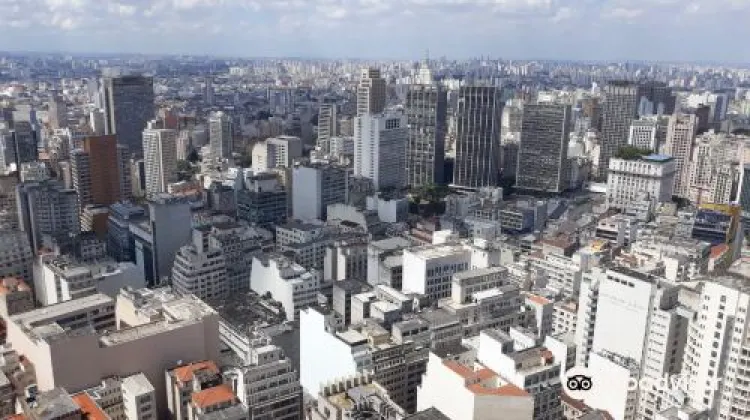
Planning a trip to Brazil? Well, buckle up and get ready for an adventure of a lifetime! Brazil, with its vibrant culture, stunning landscapes, and warm-hearted people, offers an experience like no other. Whether you're heading to the iconic Rio de Janeiro or exploring the mighty Amazon rainforest, here are eight essential tips to ensure your journey is smooth and memorable.
1. Learn the Lingo: While many Brazilians speak English, knowing a few basic Portuguese phrases will go a long way. From ordering food to asking for directions, a little effort to communicate in the local language will be greatly appreciated.
2. Embrace the Local Cuisine: Brazilian food is a delightful fusion of flavors, influenced by African, European, and Indigenous cultures. Don't miss out on trying feijoada, a traditional black bean stew, or the famous churrasco, a mouthwatering barbecue experience.
3. Stay Safe and Smart: Brazil is generally a safe country, but like any other destination, it's important to take precautions. Avoid displaying valuable items, be cautious in crowded areas, and use reputable transportation services to ensure a worry-free trip.
4. Pack for All Occasions: Brazil's vast size means diverse climates. From the tropical beaches of Bahia to the chilly mountains of Serra Gaucha, pack accordingly. Don't forget your swimsuit, comfortable walking shoes, and a light jacket for unexpected weather changes.
5. Explore Beyond the Tourist Hotspots: While Rio de Janeiro and São Paulo are must-visit cities, Brazil has so much more to offer. Venture off the beaten path and discover hidden gems like the colorful streets of Salvador or the enchanting landscapes of Bonito.
6. Respect the Local Customs: Brazilians are known for their warm hospitality and friendly nature. Embrace their customs and traditions, such as greeting with a kiss on the cheek or participating in a lively samba dance. Immerse yourself in the local culture for an authentic experience.
7. Stay Hydrated and Protect Yourself: Brazil's tropical climate can be intense, so staying hydrated is crucial. Carry a reusable water bottle and use sunscreen to protect yourself from the sun's rays. Don't forget insect repellent, especially if you're heading to the Amazon rainforest.
8. Connect with Nature: Brazil is a nature lover's paradise. From the breathtaking Iguazu Falls to the mesmerizing Pantanal wetlands, make sure to include some outdoor adventures in your itinerary. Hike through the lush rainforests, go wildlife spotting, or simply relax on the stunning beaches.
So, get ready to immerse yourself in the vibrant culture, indulge in delicious cuisine, and explore the natural wonders of Brazil. With these tips in mind, your journey will be filled with unforgettable moments and incredible experiences. Bon voyage!
* All user reviews in this article have been translated by machine.
* The information above is subject to change at any time. For the latest information, please check the websites of hotels and attractions.
Table of Content
- Customer Support
- Service Guarantee
- More Service Info
- Website Feedback
- About Trip.com
- Terms & Conditions
- Privacy Statement
- About Trip.com Group
Other Services
- Investor Relations
- Affiliate Program
- List Your Property
- Become a Supplier

How to plan a trip to Brazil on a budget
Are you planning on traveling to Brazil on a budget?
This country is known as one the most expensive countries in South America, so naturally many travelers are wondering if it’s actually possible.
What's in this guide?
Having been there ourselves and done Brazil on the cheap, we’ve made our fair share of mistakes and have learnt some helpful tips that we will share in this guide .
However the most important thing to keep in mind is first knowing yourself well, and where you tend to splurge when traveling.
For example if you’re a heavy drinker and want to try and keep costs low in Brazil , then your plan will be to buy local brands from supermarkets rather than spending more on beers in hostels (which tend to get marked up in price).
Whilst it sounds like common sense, you’d be surprised at the amount of travelers we met who stayed ignorant and ran through their travel budget much quicker.
Language and Currency
Let’s now look at some important elements of budgeting in backpacking Brazil that most travelers will need to consider at some point during their trip.
Unlike the rest of South America, Brazil is the only country where the dominant language is Portuguese .
This often catches out travelers who have been around the rest of the continent for a while who are used to hearing and speaking Spanish.
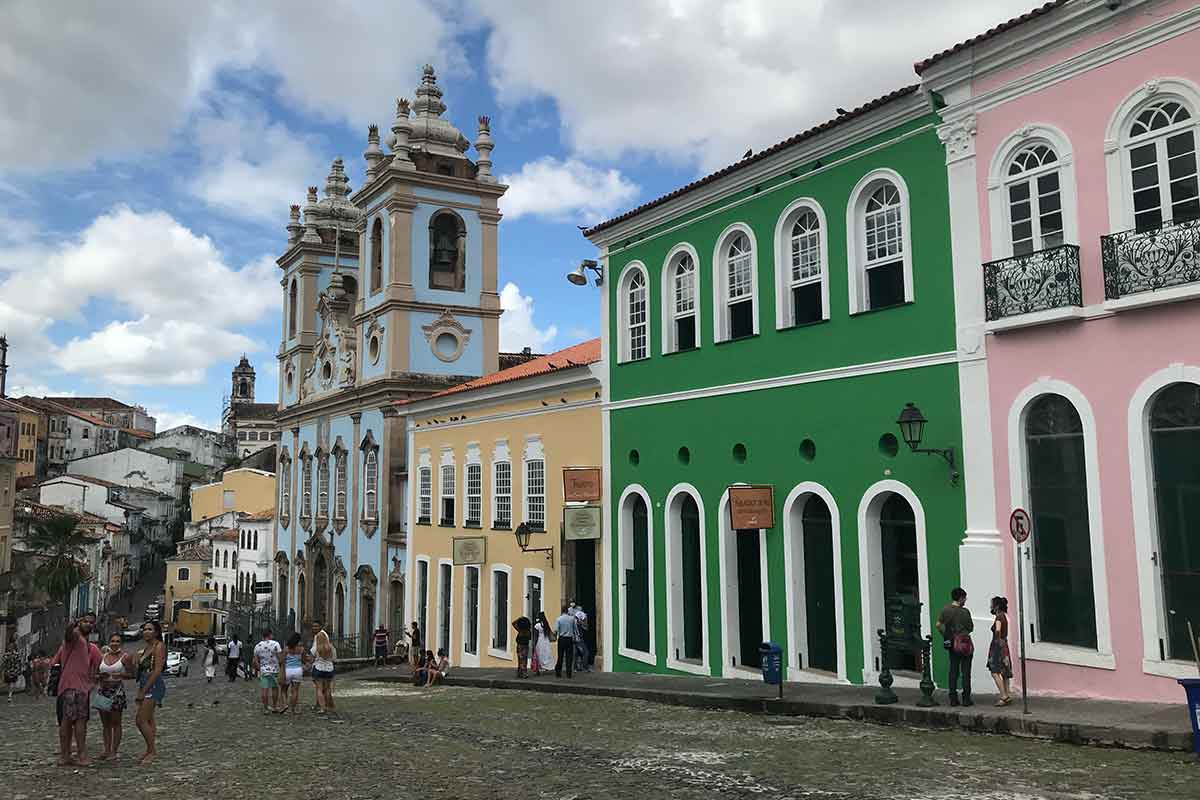
Now whilst it’s quite different, you can actually get away with speaking Spanish in some parts of Brazil, especially in the south like São Paulo and Rio de Janeiro (this mix of languages is locally known as Portuñol ).
Again like when heading anywhere new where you don’t know the local language, even learning just a tiny bit can really enhance your experience.
Locals are already friendly here, but will be even more so when they hear a simple “Bon Dia” or “Cómo está voce?”. You can brush up your Portuguese skills like we did but using Duolingo. Or, if you’re serious about learning carry this Portuguese phrase book with you.
There’s also over 200 indigenous languages spoken throughout the country, although most are found within the deep depths of the Amazon Rainforest .
In Brazil they use the Real , which is amongst the stronger currencies in South America (hence why things are more expensive here compared with countries like Peru and Bolivia).
When budgeting it’s really important to work out exactly how much you’re spending in Real, otherwise you’ll burn through your finances much quicker.
At this current time of writing, $1 US Dollar equals roughly 5 Real , so this should give you a better idea of what you’re spending (of course please look up current rates on Google before and during your trip). You can also check currency sites such as XE who provide up-to-date and accurate exchange rates.
Getting Around Brazil
The easiest (and most common) way for travelers to access Brazil is to fly into São Paulo . This airport is a real giant, and is the best connected in all of Latin America.
Rio de Janeiro is another good one to also look into, given prices can sometimes be cheaper when heading directly here.
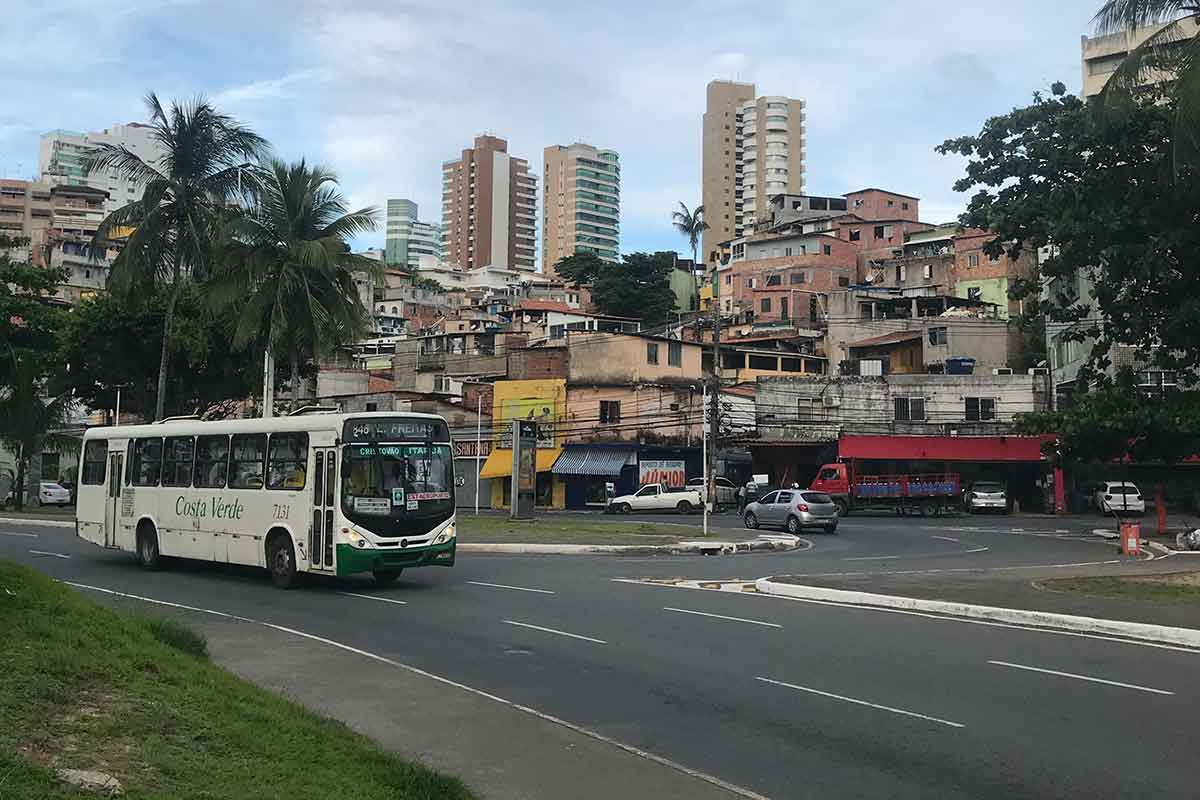
Many travelers can also cross land borders into the country with a bus. The major routes are from Argentina, Paraguay and Uruguay to the south, as well as Bolivia, Peru and Colombia to the north. There’s also crossings from Venezuela and Guyana too.
Buses in Brazil
Getting around the country is best by bus, however travel times can rapidly add-up (anywhere from up to 18-30 hours on the longer legs). It’s wise to make stops along the way, or it’s easy to get burnt out by the distances.
Domestic flights are also a good option given pretty much every major destination has its own airport. You’ll need to fly into Manaus for example, unless you decide to head to or from a memorable boat ride from Belém .
Costs and Budgeting
One of the most important factors to plan before heading off is your budget.
Costs in Brazil can quickly add up given travel distances and the overall fact that it’s more expensive than most other Latin countries.
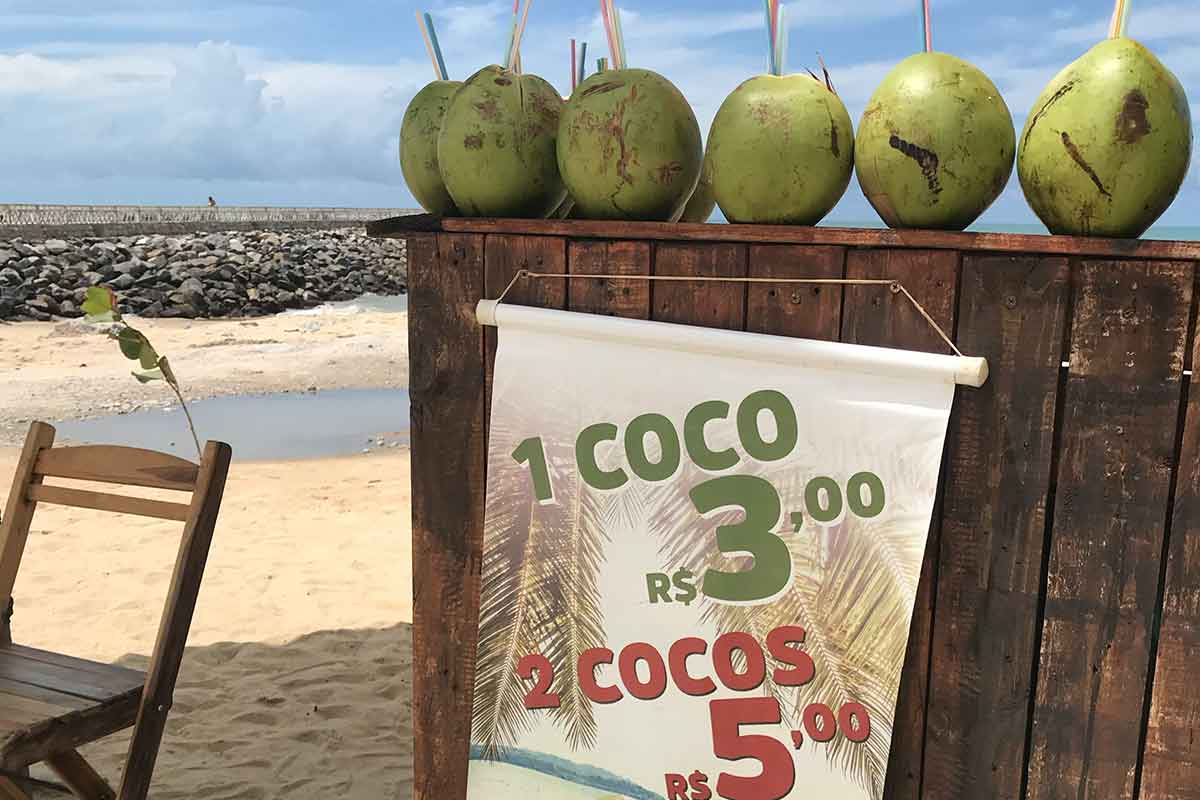
Let’s take a look at how much things tend to be, as well as how to plan a both reasonable and realistic budget. The costs we listed here are correct as of July 2023.
Brazil Travel Costs
Let’s take a look at the typical costs that you’ll be spending on a day to day basis in Brazil.
Remember these can and will vary depending on where you are! For example areas along the north of Brazil tend to be much cheaper than popular districts in the south such as Copacabana and Vila Madalena.
- Average Dorm Bed = £7-13
- Private Single Room in a Hostel = £18-25
- A Street Food Dish = £2-3
- A Meal at an Inexpensive Restaurant = £6-15
- Beer at a Local Bar or Dive = £1-£2.00
- Beer at a Touristy Bar = £2.00-3.50
Brazil Travel Budget
As previously mentioned, it’s important to properly budget before hitting Brazil. This way you’ll be more prepared for the costs, and also know how you can save in certain places.
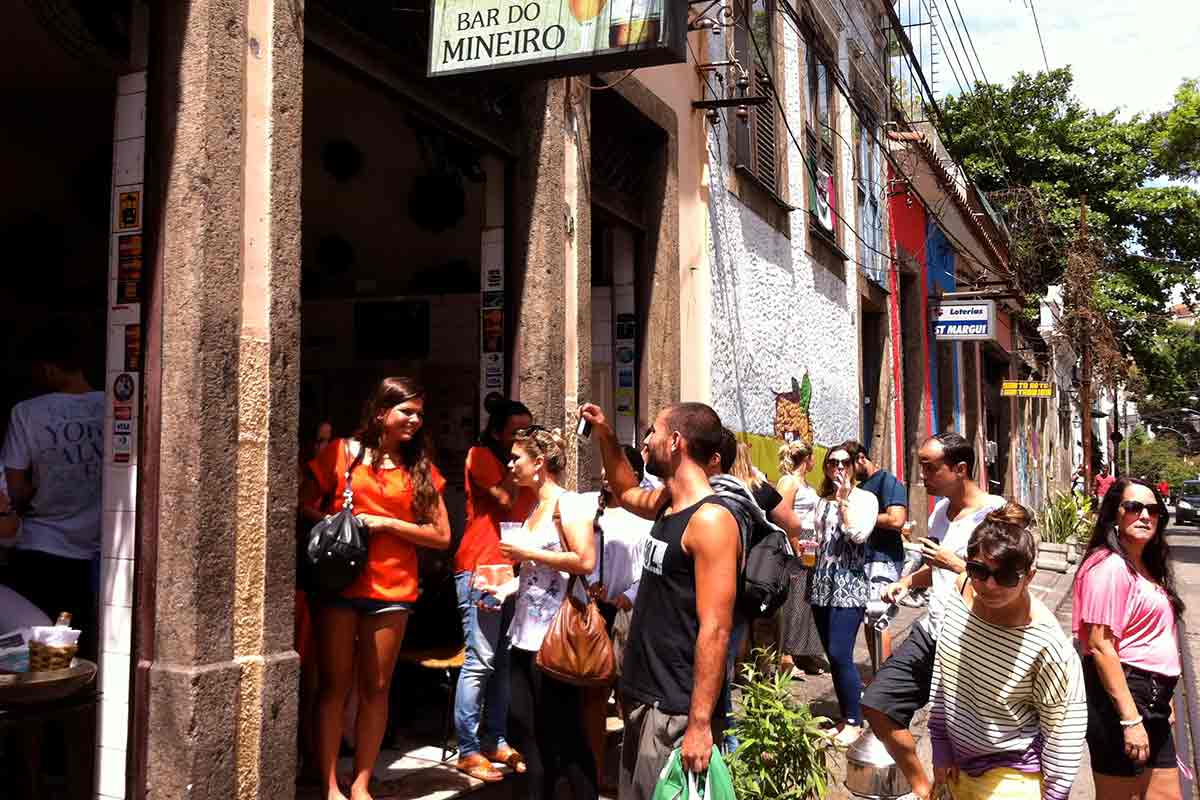
The average backpacker will be spending roughly £25-35 a day . This includes staying in a nice hostel, eating local meals as well as getting around the cities. This is also what we recommend when following our customized 2 week in Brazil itinerary .
Of course some travelers will end up spending more for comfort, whilst others can even go less (George averaged around £20 a day). Always take your own likes and needs into account before deciding on a budget, not just because we say so!
Brazil Trip Planning
Whilst backpacking is definitely about being spontaneous and open to the new, solid planning beforehand really does go a long way.
Below we’ll go through some key things you should get sorted before heading out to Brazil.
What to Pack for Brazil?
Although Brazil is a massive country, temperatures are still pretty hot regardless of where you are . You’ll want to mostly pack light clothes when heading here, and perhaps a jumper when heading to the extreme south (for example in Porto Alegre or near Uruguay).
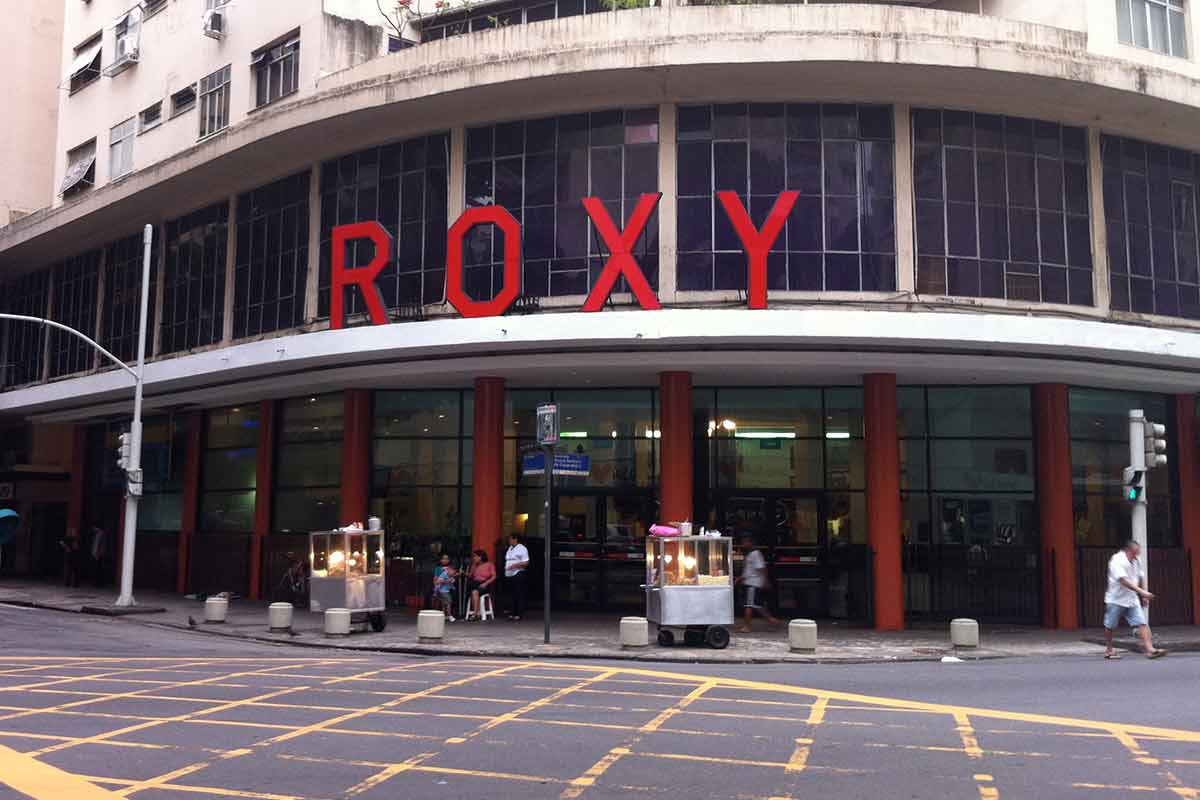
Rainfall can also be heavy in some parts like the Amazon Jungle (or if heading in the wet season), so be sure to carry a solid poncho if either of the two are in your travel plans.
Other things to remember include a solid folder to carry your documents, as well as specific equipment for different activities. Toiletries are also important, although try to pack liquids of less than 100ml , as this way you may be able to fly with just hand luggage saving you some dollar.
If you’re visiting Brazil as part of a longer trip through the continent, then please see this South America packing list.
Below is a basic list of the most common injections that travelers heading to Brazil can get.
As always, please see your doctor as we are not medically trained or qualified to give advice. They’ll tell you exactly what you need for each specific country.
- Hepatitis A
- Yellow Fever
Got travel insurance for Brazil?
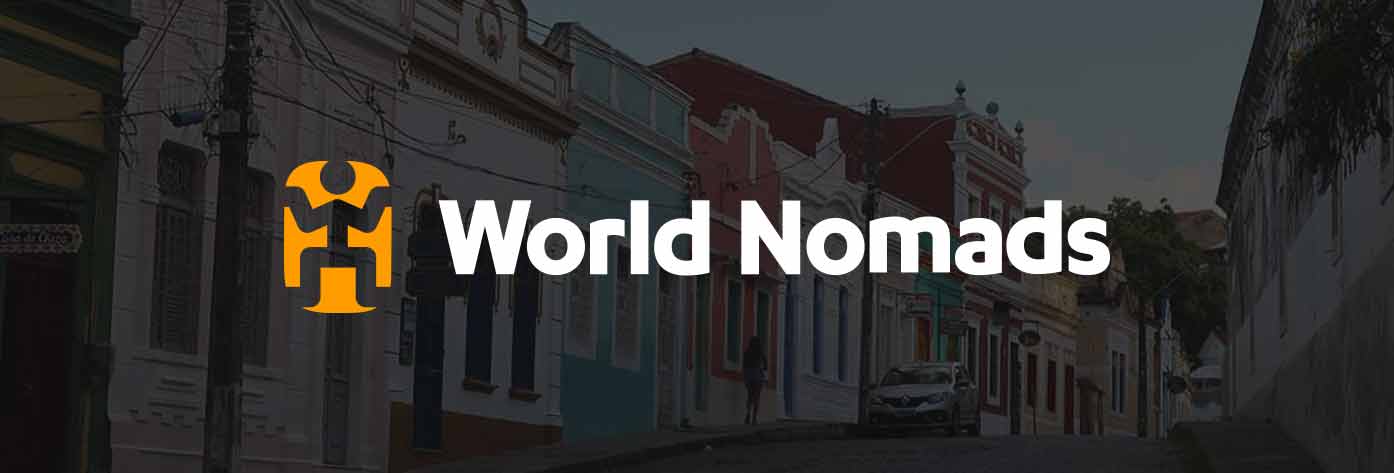
And that’s all for our guide on how to travel Brazil on a budget.
Known as one of the most expensive of the lot, traveling to Brazil doesn’t need to break the bank . With careful planning and following our advice it’s definitely possible to travel Brazil on less than £25 a day, and trust us when we say you’ll want more time here rather than less!
Be sure to read our Brazil Itinerary for more ideas on what to do when in this giant Latin American nation.
👉🏽 P.S. If you’ve found this guide helpful, buy us a coffee here to say thanks! Or, support us by downloading our South America Travel Bible to get our best content.
“ Dear traveler! Some links in this post contain affiliate links. Meaning, if you click through and make a purchase, book a hostel or sign up for a tour, we may earn a small commission at no additional cost to you . Your support means a lot and helps us to carry on traveling and maintaining the quality of this site for you.”
Similar Posts
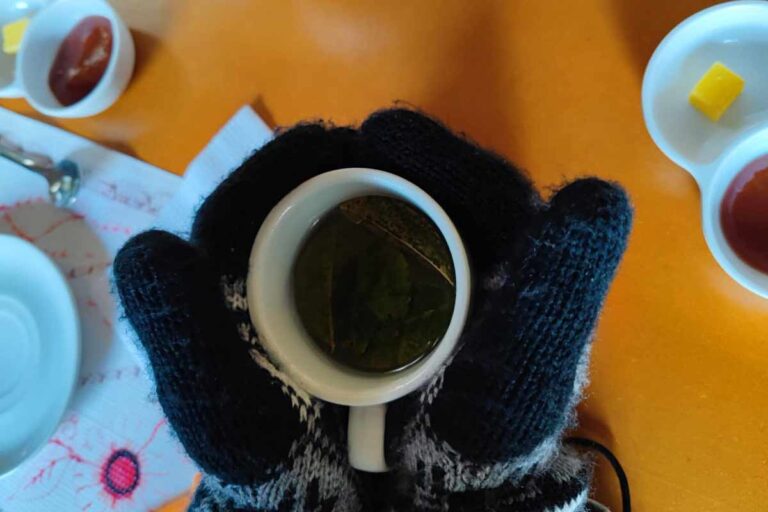
Drinking Water in Peru: is it safe?
Have you ever considered what the drinking water in Peru is like? When it comes to planning a trip around Peru, we mostly think about things like staying safe and how to get between destinations. However it’s important to consider the smaller day-to-day things too such as drinking from safe water sources, given Peru is…
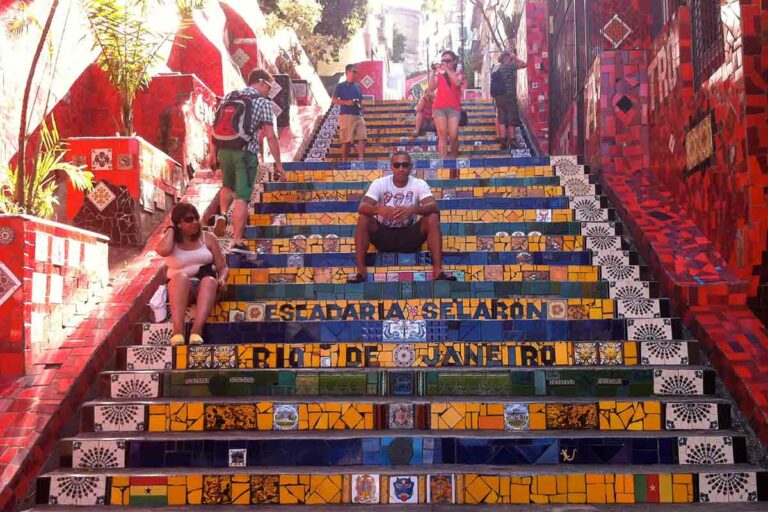
South America Itinerary (2 Weeks)
This incredible and diverse continent offers travelers pretty much everything. Here we can explore ancient ruins, hike giant Andean mountains, relax on Caribbean beaches and explore lost cultures. Planning your own itinerary around South America is fun, but can also be a challenge due to the large distances as well as time restrictions if you…
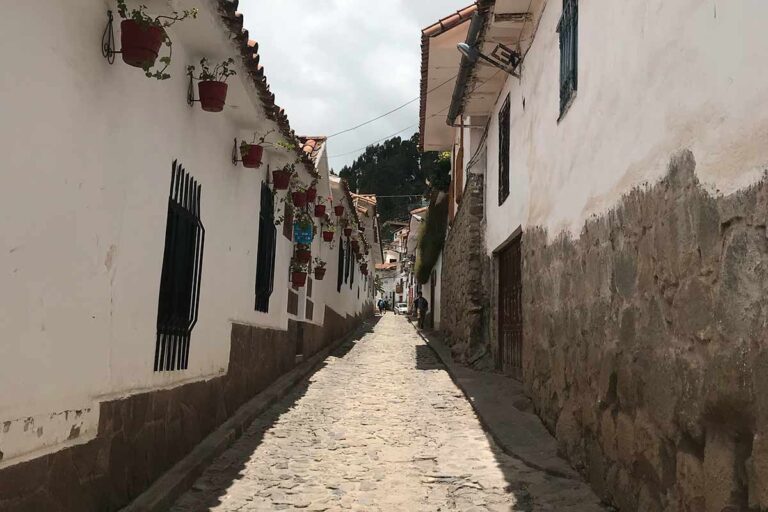
How To Avoid Altitude Sickness in Cusco
When traveling around South America, we often tend to think that our safety is only at risk from people, such as getting our things stolen or from other human-related issues. However in Peru, we also need to think about altitude sickness which can be an issue in popular Andean destinations such as Cusco. Without proper…
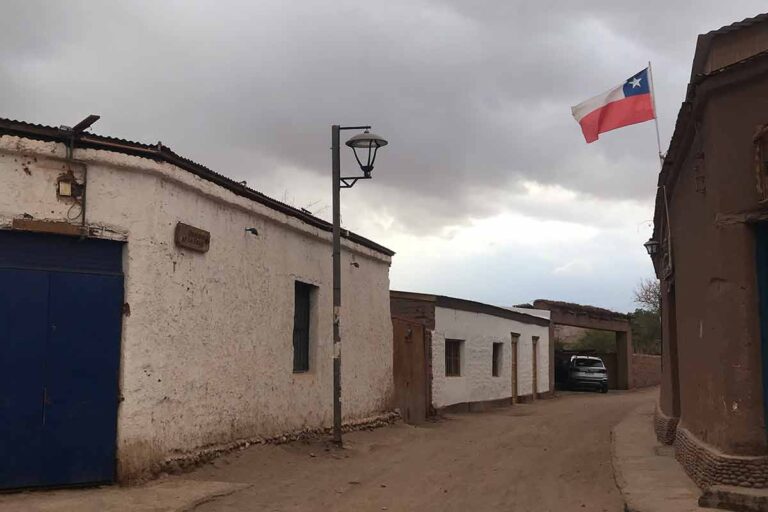
San Pedro de Atacama Guide
Welcome to our guide to San Pedro de Atacama. Located within the driest desert on earth, the town of San Pedro (short for San Pedro de Atacama) is one of the highlights of a trip to Chile. With its small town feel, you’ll feel part of the community within hours, with locals and travelers from…
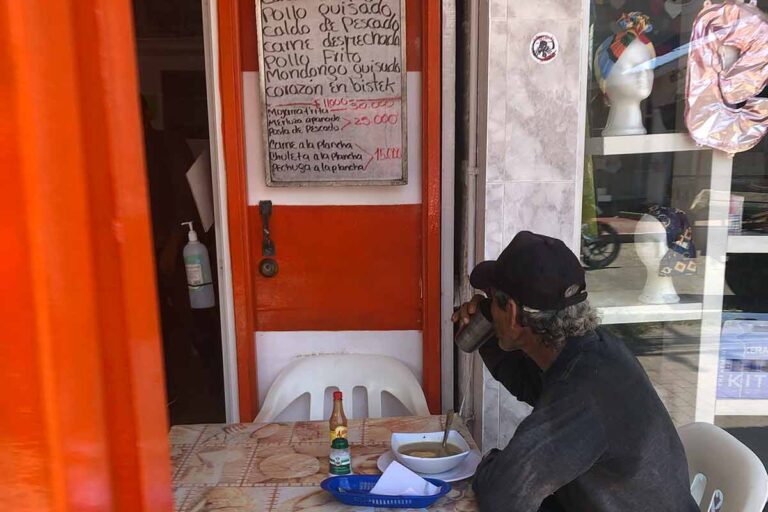
Drinking Water in Colombia: is it safe?
Have you ever thought about what the drinking water in Colombia is like? Most travelers heading to Colombia often worry about crime when thinking about how they can stay safe, however they don’t really think about how they can drink water safely which is just as big of a risk. Given much of Latin America…
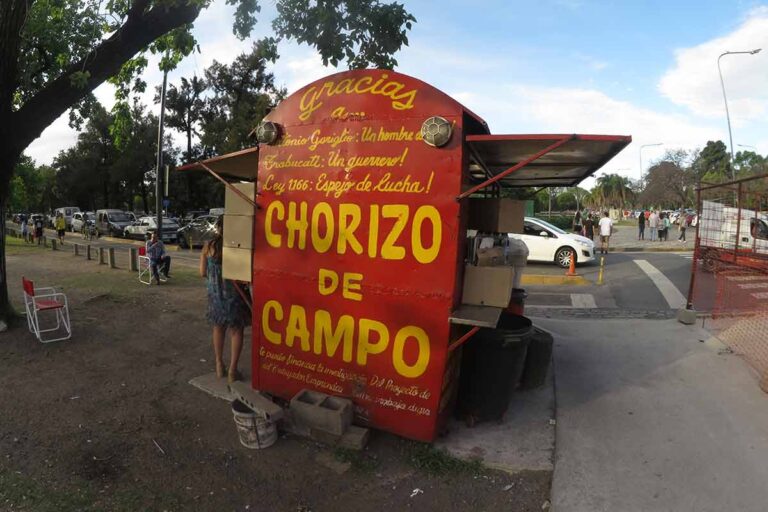
Is Argentina Expensive?
Is Argentina expensive and how much do you need when traveling here? An ever-popular country for travelers to visit, Argentina has lots going for it. Here we can explore the remote wilderness of Patagonia, the desert landscapes near Salta as well as enjoy the electric atmosphere of Buenos Aires. Whilst usually one of the more…

Travelling Without a Passport

How to Spend Two Weeks in Brazil at Every Budget

Home to some of South America’s biggest parties, best beaches, and some incredible natural beauty, Brazil might just be the perfect place for your next adventure. But if you’re a traveller on a budget, will it be too expensive for you to visit? Or what if you’re looking to splash out: what’s available to visitors who want a 5-star experience? Fear not: while Brazil has historically ranked as home to some of the most expensive cities in the world, the country is now much more accessible to travellers with all budgets.
Whether you’re pinching pennies or you’ve saved up for a luxury vacation, here’s our guide to spending two weeks in Brazil, at every budget.
Travel to: Brazil

Brazil on a shoestring budget
Brazil can be an extremely rewarding country to explore on a budget. With an average cost of around $20 USD per day, spending two weeks here totals about $280; a downright frugal adventure. Things like cafe food and public transit are cheap, and you’ll never lack things to do. After all, one of the best parts of Brazil is being able to see all of this amazing country’s natural beauty!
- Bed in a shared room in a hostel: $9-15 USD per night
- Quick meal, such as a sandwich and drink in a cafe: $3-5 USD
- Getting around: taking public transit like buses and subways are a cheap option, though, as with any major city, make sure you stay aware of your surroundings and don’t ride if you feel unsafe.
If you’re looking to travel within Brazil, there is a system of long-distance buses which run at a rate of about $4 USD per hour. Another option would be to join a group tour, as oftentimes many meals are included, and you’ll be able to keep a closer eye on your cash!
See Also: How to Avoid Common Airport Scams
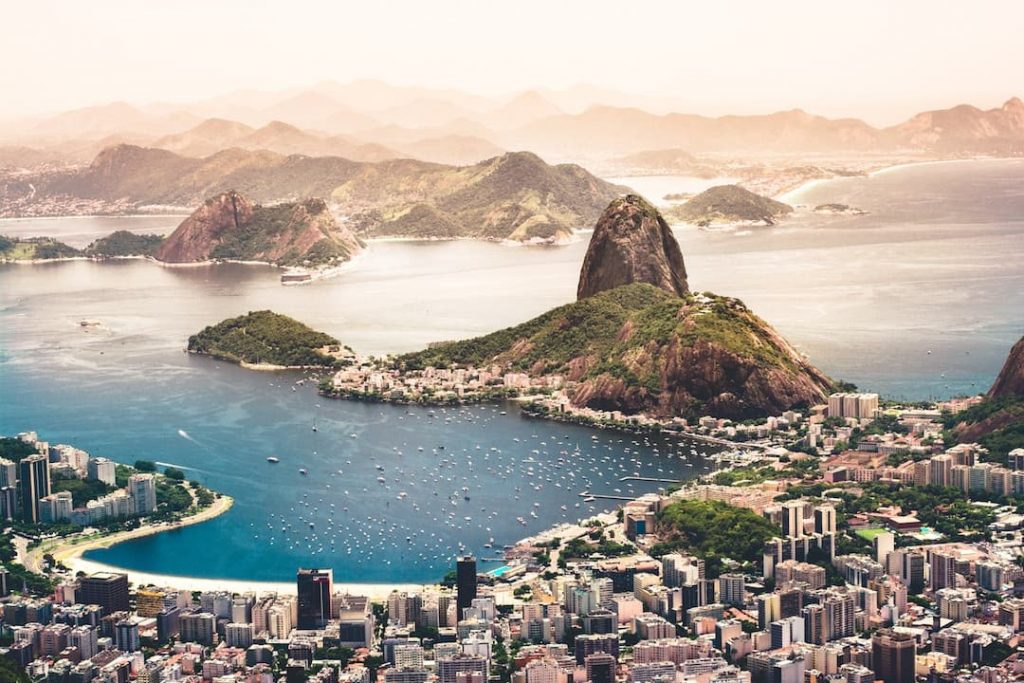
Brazil on a mid-range budget
If you have a little extra cash saved up, or if you’re looking to splurge here and there without totally breaking the bank, Brazil has many options for you. Travellers with a moderate budget are able to enjoy all the same nature and adventure that Brazil offers visitors, but with a bit more wiggle room for hotels and exploring the country’s amazing culinary scene. With an average cost of about $55 USD per day, two weeks in Brazil at a moderate budget totals around $770 USD.
- A standard double room in hotel: $40-$70 USD per night.
- Dinner for two at a mid-range restaurant: $20-40 USD
- Getting around: If you’re pressed for time, or just want to escape the crowds on public transit, ridesharing services like Lyft and Uber are available in major cities such as Sao Paulo and Rio. Just note that these ridesharing services may not be permitted to accept passengers at airports, and your best bet may be to take an airport-affiliated radio taxi to your hotel or destination.
See Also: One Week in Costa Rica on a Budget

Brazil on a high-end budget
Whether you’ve been saving up for the ultimate Brazilian getaway, or you just have some extra cash to burn, Brazil can be heaven for luxury travellers. Between trendy city hotels, in-depth river tours, and a booming food scene, you’ll never run out of luxury experiences here. With an average cost of about $165 USD per day, two weeks in Brazil at a luxury budget will cost you around $2315USD.
- Boutique hotels cost about $120-200 USD per night, but, if you’re interested in a luxury jungle lodge for a more unique experience, it will cost about $120-250 USD.
- Dinner for two at an upscale restaurant: $50-100 USD
- Getting around: again, taking advantage of ride-sharing services such as Uber and Lyft will allow you to get to your destinations relatively quickly, and safely.
If you’re interested in travelling around Brazil and prefer to take to the skies, one-way internal flights will generally cost around $110-125 USD.
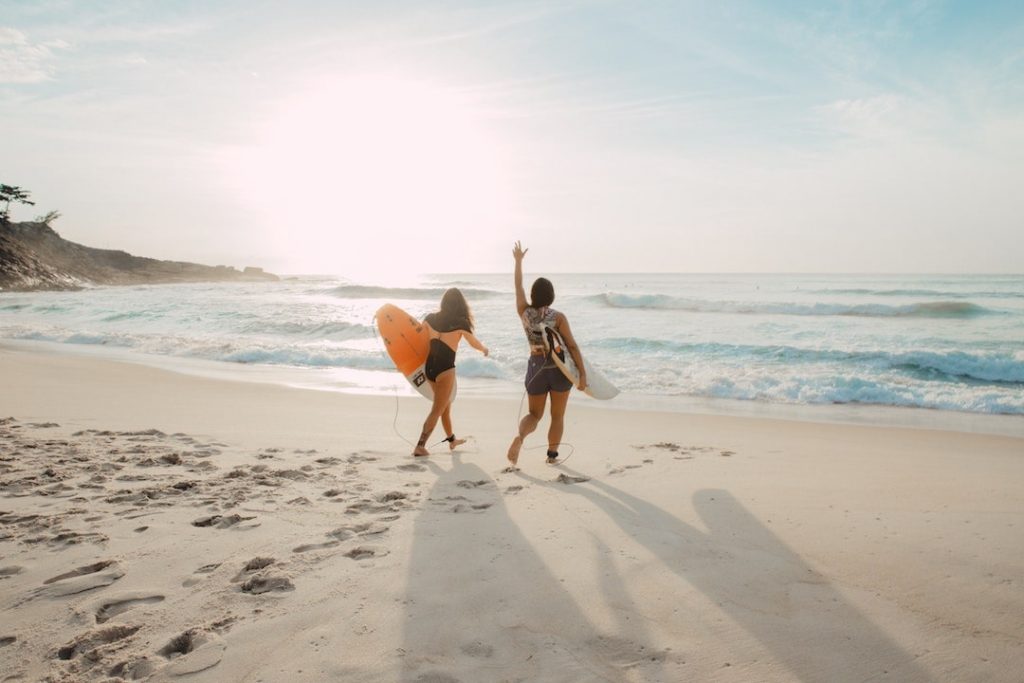
Tipping in Brazil
Most restaurants will automatically add a 10% tip to your bill, so there’s no need to worry about doing quick math with an unfamiliar currency. If you take a river tour, for example, it’s customary to tip your guide, and appreciated to tip assistants and boat operators. Tipping is also common for housekeepers, baristas, beach vendors, and other similar services. If you’re driving yourself in Brazil, parking attendants are often dependant on tips, but it’s not expected to tip taxi drivers (however, rounding up to the nearest real is common).
No matter what your budget, Brazil is an incredible country that deserves to be visited and explored. If you’ve been worrying that a country this amazing is out of your price range, we hope this guide is the encouragement you need to start planning your Brazilian adventure.
What are your favourite money-saving tips while travelling? Let us know!

Maggie Soares
Maggie is a life-long traveller with a special affinity for the United Kingdom. When she's not reading, writing, or dreaming about her next trip, you can find her talking at length about her dog to anyone who'll listen.
Related Articles
- Tips & Tricks
Best Destinations for People with Disabilities
The world and its wonders should be available to one and...
- Destination Guide
Where to See the Northern Lights in February
If you hope to see the Northern Lights in February, you’re...
- North America
- South America
Carnival Around the World
The world goes a little crazy every February when carnival season...

What to do in Greece in December
Get unlimited access to the world's best travel stories. subscribe now., privacy overview.

©Nat Photos/Getty Images
One of the world's most captivating places, Brazil is a country of powdery white-sand beaches, verdant rainforests and wild, rhythm-filled metropolises.
Best Time to Visit
Best places to visit, attractions, must-see attractions.
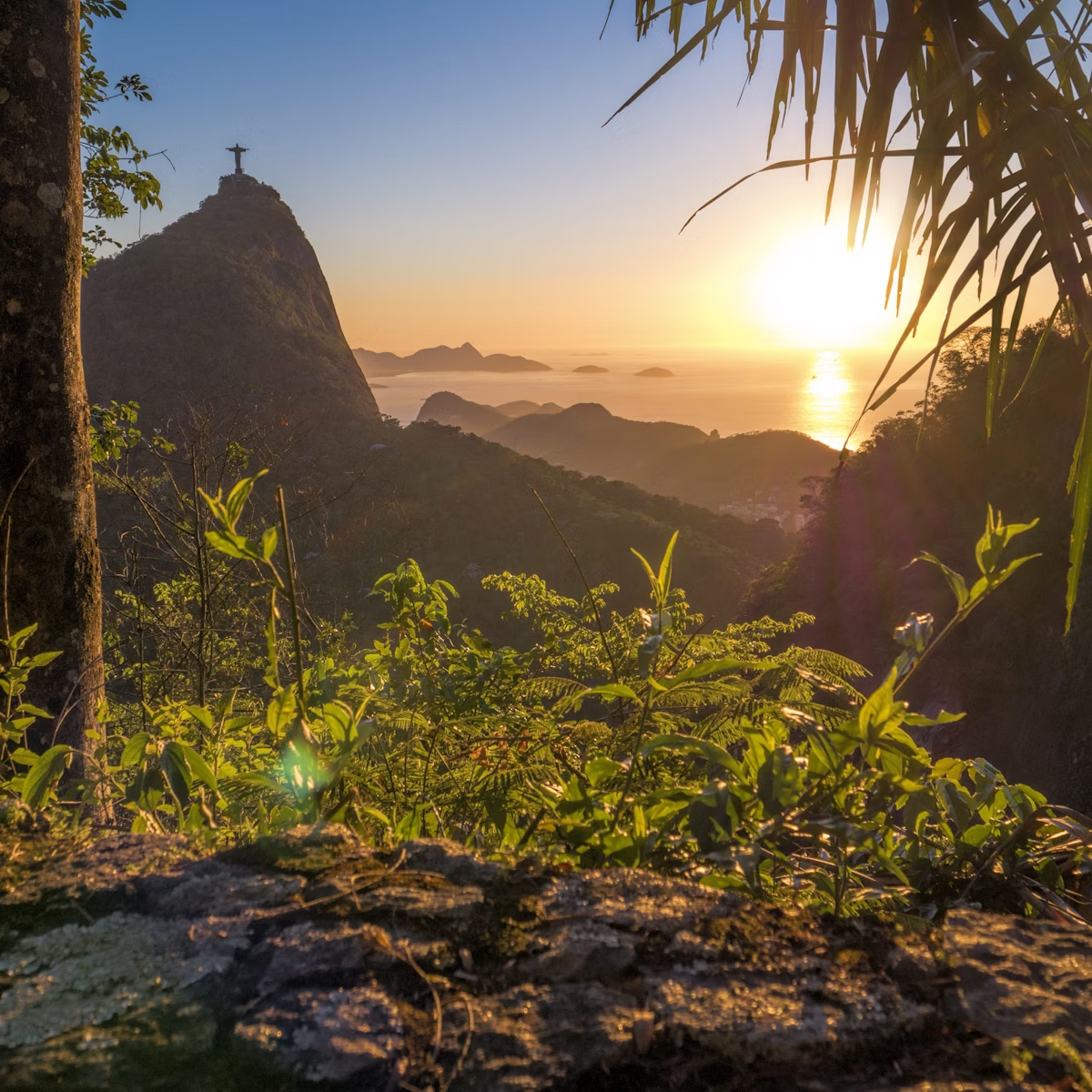
Parque Nacional da Tijuca
Rio de Janeiro
The Tijuca is all that's left of the Atlantic rainforest that once surrounded Rio de Janeiro. This 39-sq-km tropical-jungle preserve is an exuberant green…
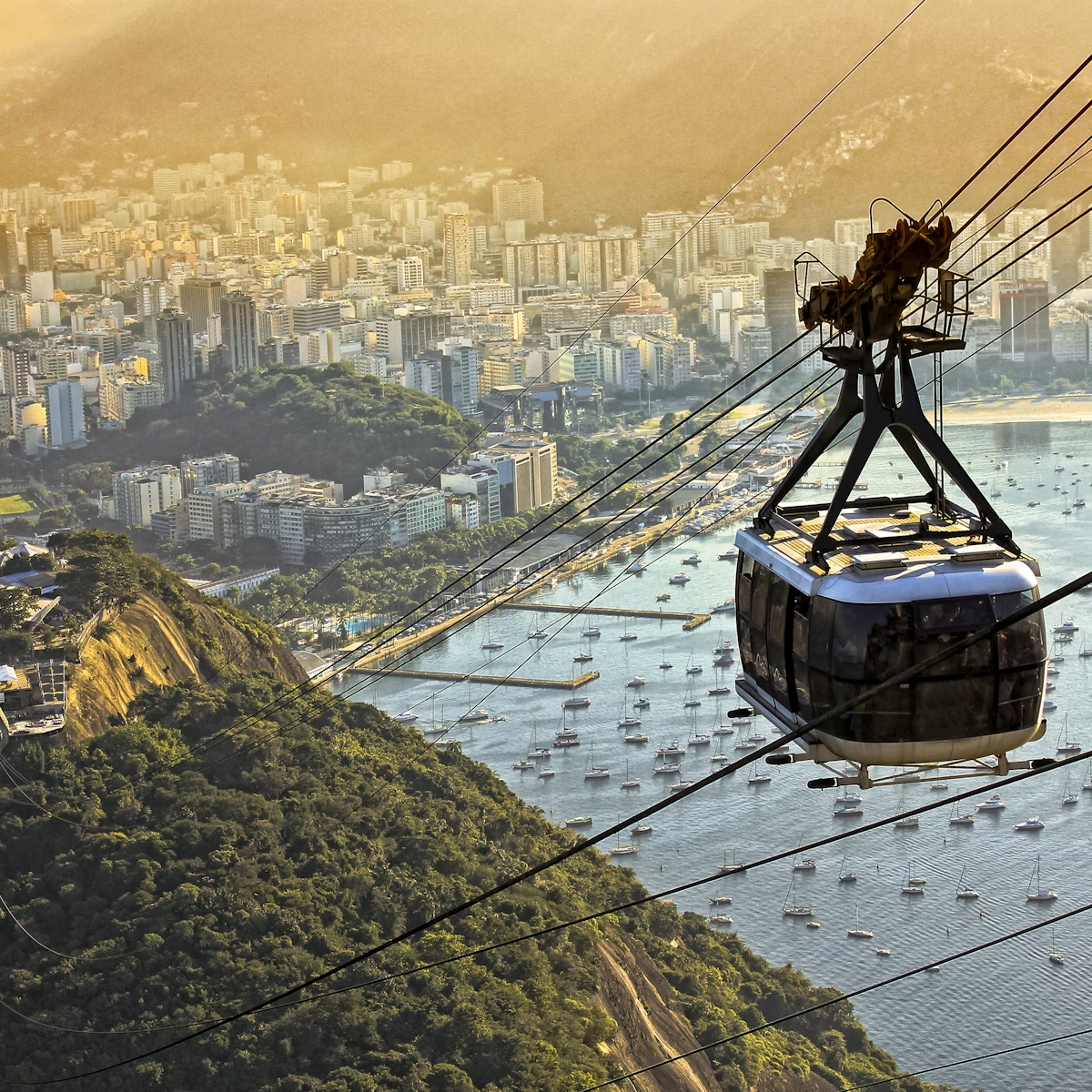
Pão de Açúcar
Seen from the peak of Pão de Açúcar, Rio is undoubtedly a Cidade Maravilhosa (Marvelous City). There are many good times to make the ascent, but sunset on…
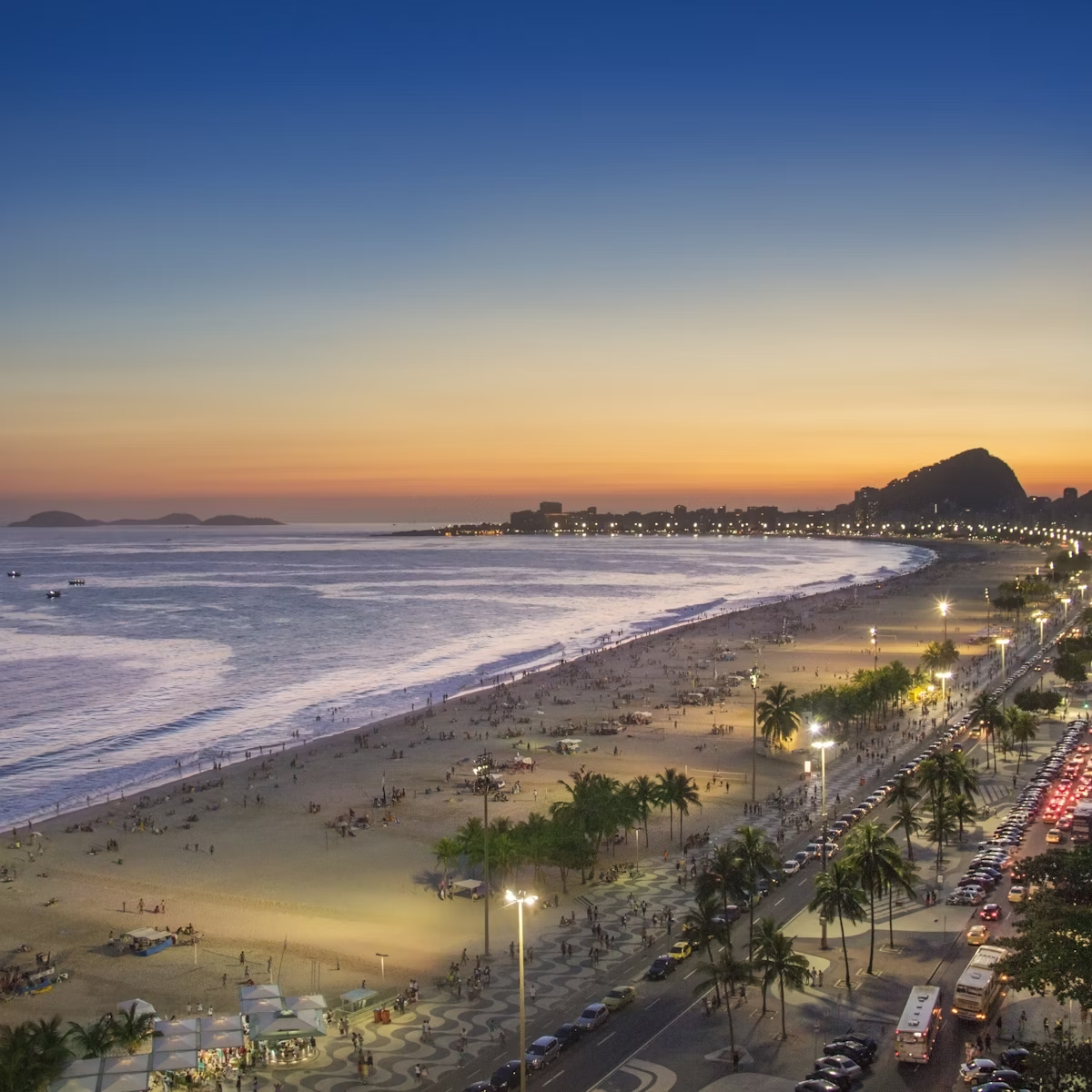
Copacabana Beach
A magnificent confluence of land and sea, the long, scalloped beach of Copacabana extends for some 4km, with a flurry of activity along its length: over…
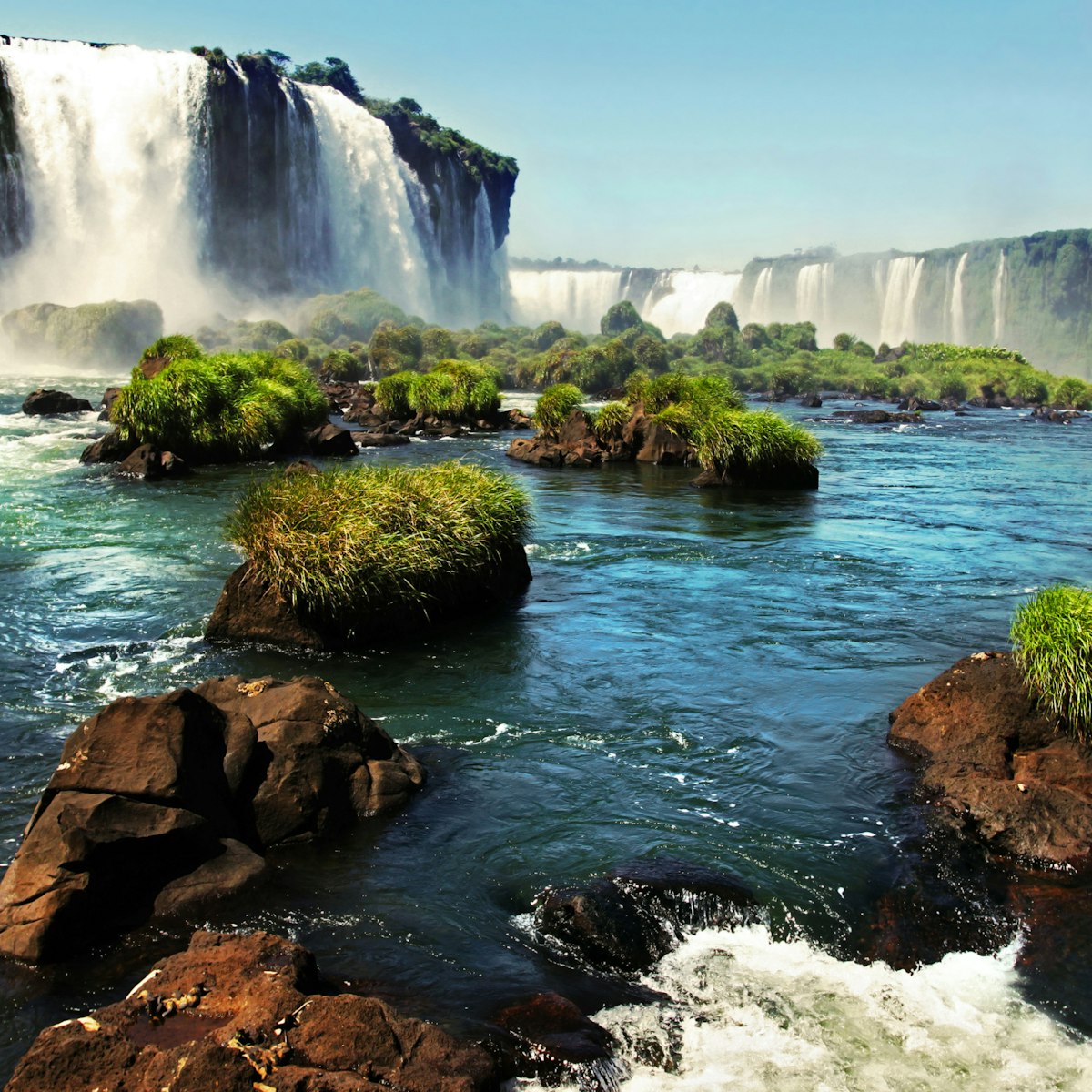
Parque Nacional do Iguaçu
Brazil's second-oldest national park, created in 1939, protects one of South America's most magical and majestic sights, Iguaçu Falls, part of the largest…
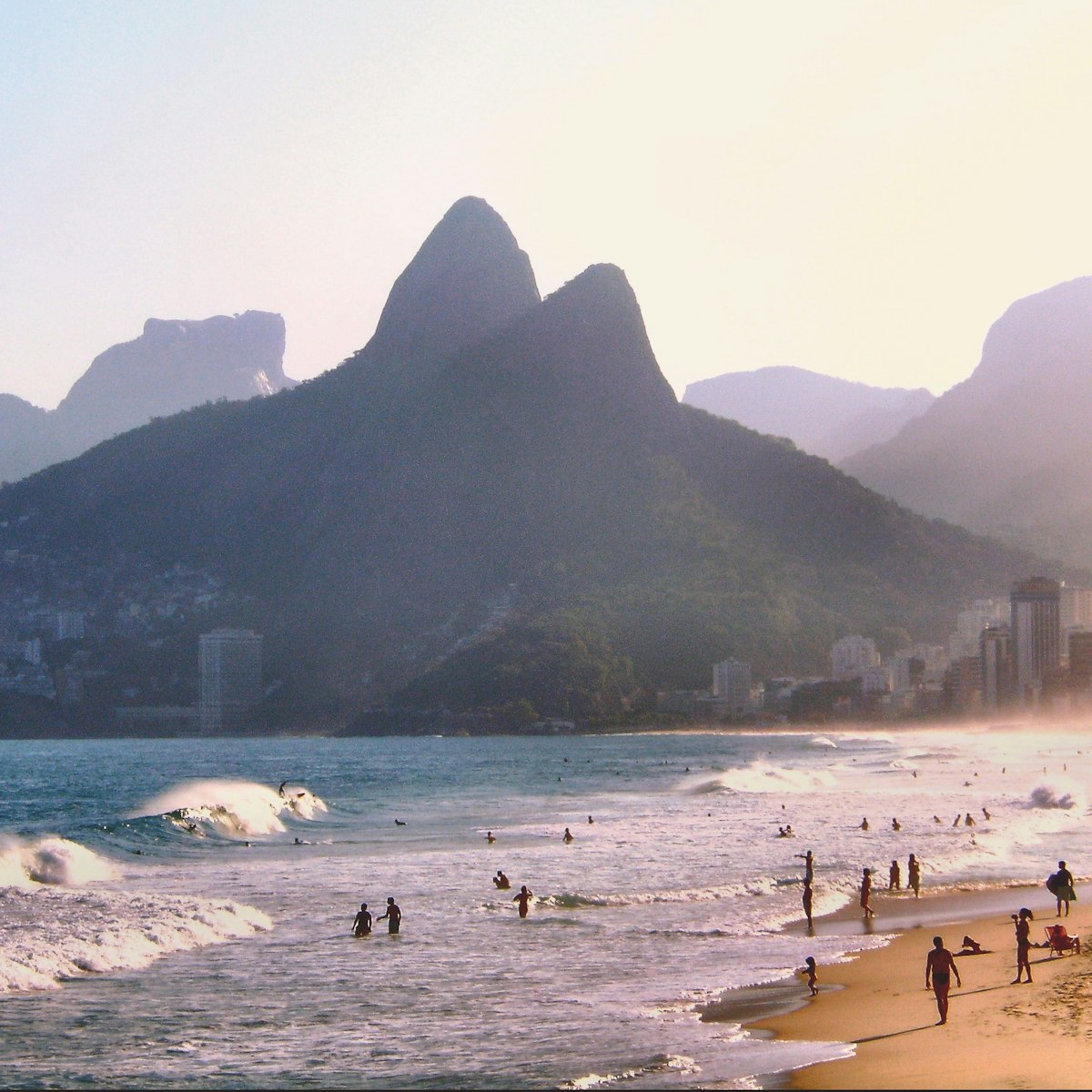
Ipanema Beach
Ipanema & Leblon
One long stretch of sun-drenched sand, Ipanema Beach is demarcated by postos (posts), which mark off subcultures as diverse as the city itself. Posto 9,…
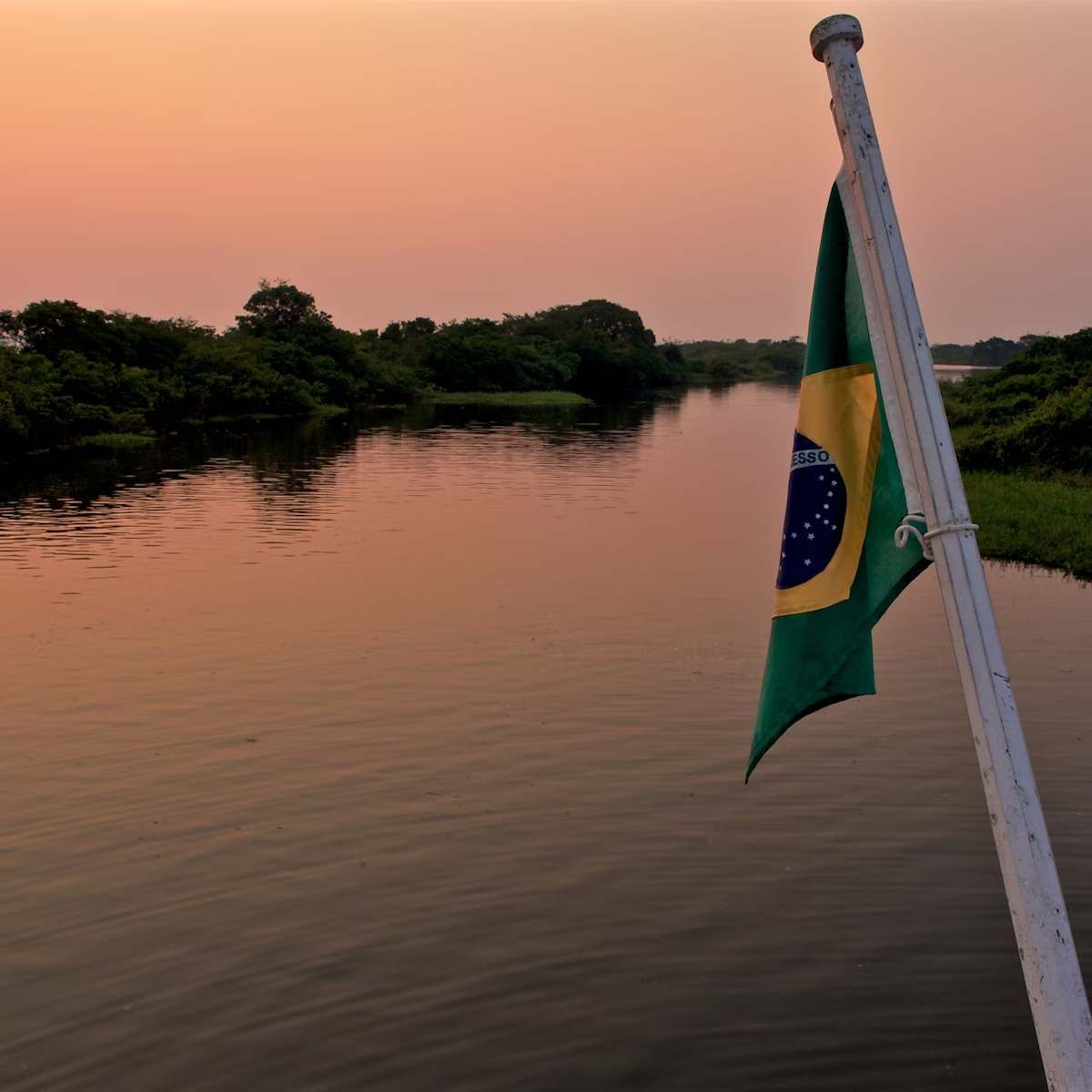
Reserva Extrativista Baixo Rio Branco-Jauaperi
This newly minted extractive reserve is an outstanding place to immerse yourself in the best the Amazon has to offer, with excellent wildlife-watching –…
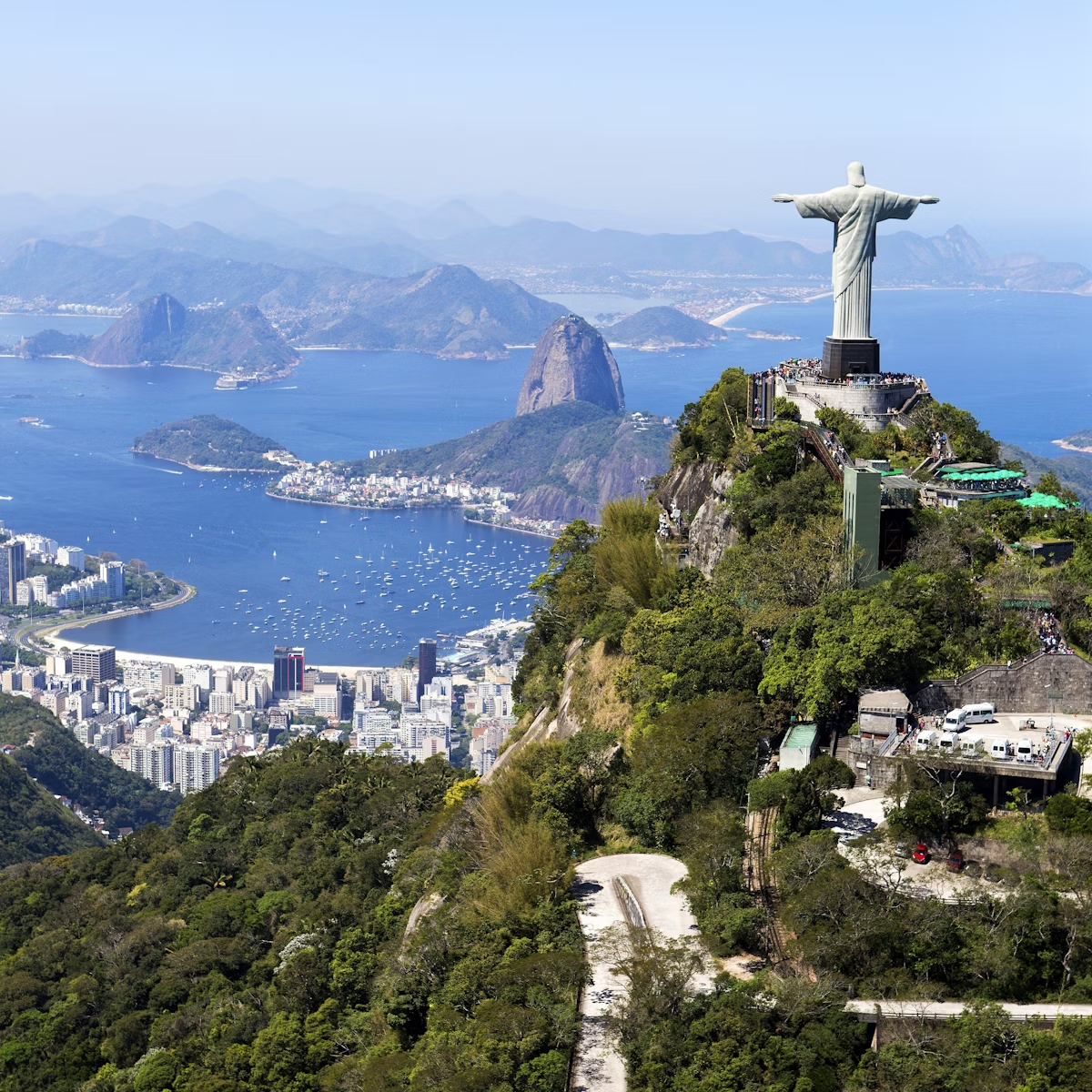
Cristo Redentor
Flamengo & Around
Standing atop Corcovado (which means ‘hunchback’), Cristo Redentor gazes out over Rio, a placid expression on his well-crafted face. The mountain rises…

Parque Nacional da Chapada Diamantina
Spanning over 1520 sq km and containing within it innumerable species of plants and animals, deafening waterfalls and vast, rugged plains, Parque Nacional…
Top picks from our travel experts
15 things to do in brazil that will amaze you.

Parque das Aves
Foz do Iguaçu
This 5-hectare bird park, located 300m from the entrance to Parque Nacional do Iguaçu, is home to 800-plus species of birds, including red ibis, bare…

Museu de Arte de São Paulo
Sampa’s pride, this museum possesses Latin America’s most comprehensive collection of Western art. Hovering above a concrete plaza that turns into an…

Farol das Conchas
Built in 1872 on orders from Dom Pedro II, this lighthouse stands picturesquely atop a hill at the island’s most easterly point. From here you have…

Museu do Futebol
Tucked under the bleachers of colorfully art deco Pacaembu Stadium, this fantastic museum is devoted to Brazil’s greatest passion – football (soccer). Its…

Maracanã Football Stadium
Rio’s Maracanã stadium is hallowed ground among football lovers. The massive arena has been the site of legendary victories and crushing defeats. Maracanã…

The epicenter of Rio’s Carnaval, the Sambódromo was designed by Oscar Niemeyer and completed in 1984. During big parades, come here for fantastic views…

Beco do Batman
One of São Paulo's premiere street-art locations, 'Batman's Alley' has slowly risen from secret location for band promotional shots and Brazilian films to…

Cumbuco, 35km from Fortaleza, has a long wide beach with soft sand, an expanse of dunes and a few lagoons that make it very popular for buggy rides and…

Parque Nacional da Serra da Capivara
One of Brazil's most important national parks, this 1300-sq-km reserve contains more than 40,000 rock paintings among spectacular panoramas of immense…
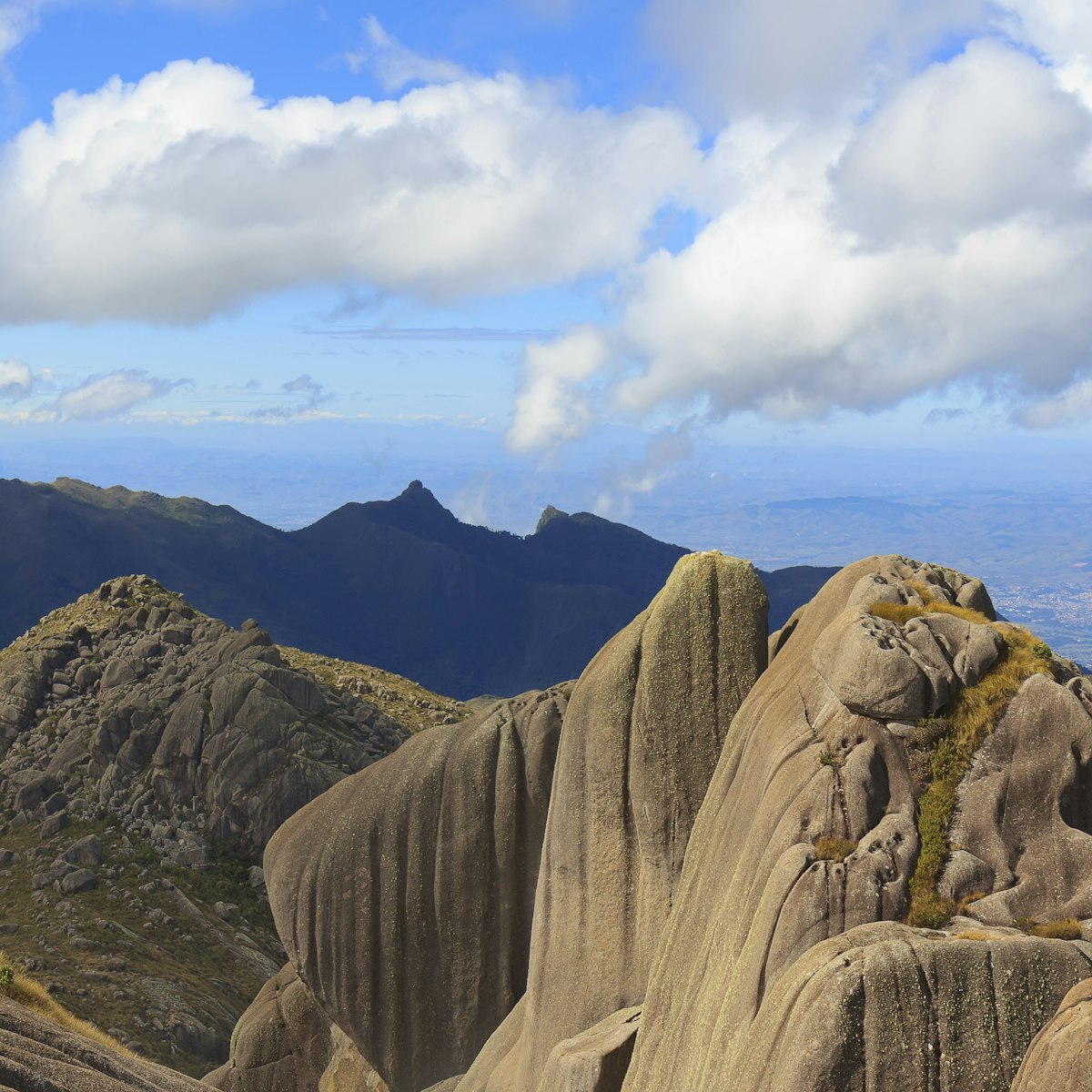
Parque Nacional do Itatiaia
Rio de Janeiro State
Brazil’s oldest national park, Itatiaia shelters a stunning variety of landscapes, from dense rainforests to spare and rugged upland peaks. Most visitors…

Itaipu Binacional
With a capacity of 14 million kilowatts, this binational dam is the world's second-largest hydroelectric power station, and the one that produces the most…
Planning Tools
Expert guidance to help you plan your trip.
Best Things to Do
Whether you prefer magnificent nature or exciting cities, Brazil has an experience lined up for you. Here’s our guide to the top things to do in Brazil.
Things to Know
Visiting a community to better understand the lives of the people who live there – that's the sort of positive impact tourism is supposed to have.
Transportation
Find your way around in Brazil with this guide to the country's transportation.
Visa Requirements
Brazil offers different visas depending on the purpose of travel and country of origin. Here’s everything you need to know about getting a visa for Brazil.
Money and Costs
Everything you need to know to make your money go further in Brazil.
Traveling with Kids
With top tips on safety and places to go, find the perfect activities for all age groups on your family trip to Brazil.
Best Road Trips
From coastal drives to winding mountain roads, getting behind the wheel in Brazil opens up a world of natural wonders. Here are Brazil's best road trips.
Plan with a local
Experience the real Brazil
Let a local expert craft your dream trip.

Latest stories from Brazil
Filter by interest:
- All Interests
- Adventure Travel
- Art & Culture
- Beaches, Coasts & Islands
- Food & Drink

Tips & Advice
Mar 1, 2024 • 9 min read
Don't get overwhelmed by the scale of Brazil – get organized! Here are our top 10 favorite places to visit in this South American sensation.

Dec 2, 2023 • 7 min read

Nov 9, 2023 • 4 min read

Nov 8, 2023 • 5 min read
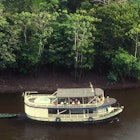
Oct 7, 2023 • 8 min read

Oct 6, 2023 • 4 min read

Sep 28, 2023 • 12 min read
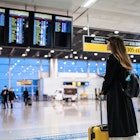
Sep 28, 2023 • 3 min read

Sep 20, 2023 • 9 min read
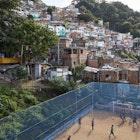
Mar 15, 2023 • 6 min read
in partnership with getyourguide
Book popular activities in Brazil
Purchase our award-winning guidebooks.
Get to the heart of Brazil with one of our in-depth, award-winning guidebooks, covering maps, itineraries, and expert guidance.
Brazil and beyond
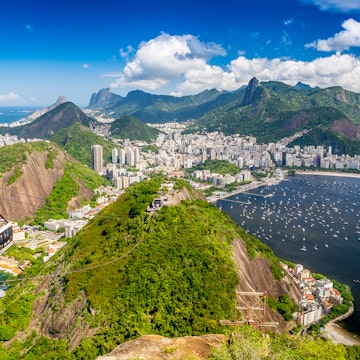

3 Weeks In Brazil Itinerary
DISCLAIMER: This post might have links to travel services and products that we enjoy. We might make a commission from it at no extra cost to you.
I wasn’t originally going to Brazil. I was coming from Europe and wanted to see Peru or Colombia. But the most affordable flight that I could find with fewer connections was direct to Brazil from Europe. I mean, I know what Brazil is known for, but for some reason, it wasn’t on my top list.
That changed, though, after I realised that I would land in Fortaleza (northern region) and I could go to the local’s favourite destination called Jericoacoara. Instead of just doing a layover, I decided to stay for a few days.
That was in 2018. I loved it so much that a few years passed, and I finally decided to come back and dedicate a 3-week trip to Brazil. This itinerary will help you plan where to go around Brazil, the cost, how to get around, what to see, and even what to eat.
Brazil is the largest country both in the south and Latin America. It is also the fifth-largest country by area and the sixth-most populous country in the world. Since it is a large country, it has four time zones.
It is the largest country to have Portuguese as an official language. In this itinerary of 3 weeks in Brazil, I will take you to stunning beaches, delicious local dishes, and of course – the Amazon River.
Brazilians are well known for their love of football. If you are familiar with the World Cup, FIFA 2014 was held in Brazil. They also currently have the most wins in FIFA. Aside from their love of the sport, Brazil is also known to have the largest carnival in the world.
These reasons alone are enough to start planning a trip to Brazil but don’t worry because there are still a billion other things to see and experience in this country.
Brazil is also the world’s largest exporter of coffee a perfect destination for all the coffee lovers out there. These don’t even cover half of the sights, sceneries, and activities that you could do here.
There’s no denying that Brazil is a popular destination. If you have 3 weeks in South America and want to maximise your time, make sure to include Brazil.
THINGS TO KNOW BEFORE VISITING BRAZIL
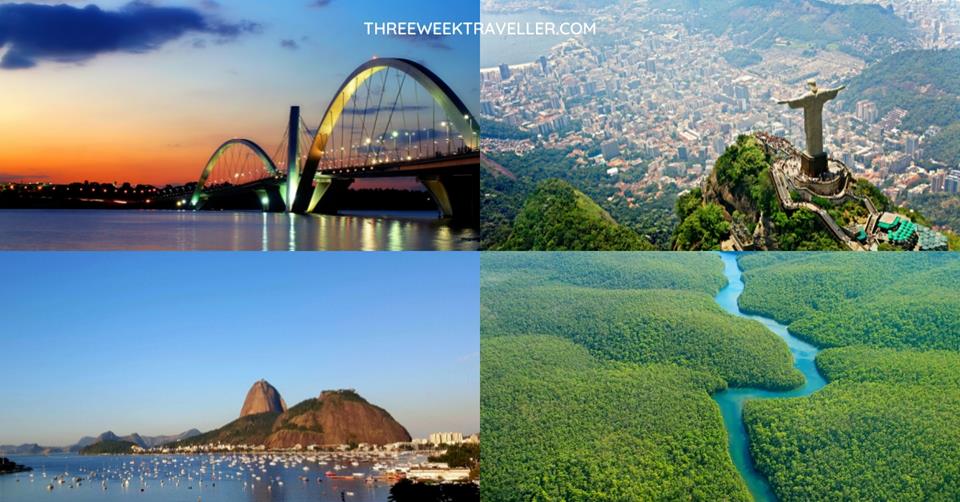
Here is some basic yet important information that you must know before planning a trip or booking anything. It covers when to go, transportation, visa, and more:
Best time to go to Brazil
Brazil has four seasons: winter, spring, summer, and fall. Because it is in the southern hemisphere, the seasons are the other way around here.
Summer lasts from December to March and is the busiest time to visit Brazil as there are tons of activities you could do. This includes island hopping, surfing, spending time on the beach, and even visiting the Amazon River. You can also visit botanical gardens, go paddleboarding, watch the sunset or go to the Iguazu Falls.
The shoulder seasons in Brazil are typically April to June and August to October. These periods are considered the best times to visit due to milder weather and fewer tourists compared to the peak season.
During these months, the temperatures are more comfortable, especially in northern regions like Rio de Janeiro and São Paulo, where summer can be particularly hot. Additionally, prices for accommodation and travel are often lower.
The rainy season in Brazil varies by region but generally occurs from December to March, particularly in the southern and southeastern parts of the country. It’s advisable to avoid this season for holidays due to frequent heavy rainfall, which can lead to flooding, transportation delays, and hinder outdoor activities.
In the Amazon, the wet season extends from December to May, causing river levels to rise significantly, which can restrict access to certain areas and activities.
Getting around
Metro and subway are the most common mode of transportation around the city, you may also use Uber to get around. There are airports in almost every major city around Brazil for domestic flying.
Due to the size of the country, the cost varies but is still affordable. For example, the Rio to Brasilia flight ticket costs $30 to $100 for one way.
- Fastest: Domestic flights are the quickest way to travel between major cities and long distances due to Brazil’s vast size.
- Most Affordable: Buses are the most economical option for intercity travel. They are extensive and can reach most destinations across the country.
- Around the City: Metro systems in major cities like São Paulo and Rio de Janeiro are efficient for urban travel. Buses are also widely available and cover extensive routes.
- Ride-Hailing Apps: Uber, 99 (formerly 99Taxis), and Cabify operate in many cities, offering convenient options for getting around. They are often preferred for their ease of use and safety features compared to traditional taxis.
RELATED POST: 3 weeks in Central America
Are 3 weeks enough for Brazil
20 days in not much for a country of this size. However, if you know where you want to go and what you want to see, it can help you maximise your time. Every region offers various experiences, so drill down on what you want to experience first.
There are so many places to see, and transportation can take longer if you travel by land. Best if you choose around 4-5 cities to cover and pick the ones not too far from one another or have a direct bus or air travel route.
Another thing to consider is your mode of transportation. Taking the bus might be more affordable, but it’s slow and will take up a lot of your time.
Average cost of 20 days in Brazil
Budget travellers can expect to spend around $1,200 – $1,800 for three weeks . This involves staying in hostels or budget accommodations, eating at local eateries, using public transportation, and focusing on free or low-cost attractions.
For a comfortable experience, a mid-range budget is between $2,000 – $3,000 . This allows for stays in 3-star hotels, dining in a mix of budget and mid-range restaurants, participating in some guided tours, and occasionally using taxis or renting a car for convenience.
For a luxurious experience, plan to spend upwards of $5,000 – $7,000 or even more. This includes staying in 5-star hotels or resorts, dining at high-end restaurants, taking private tours, and using comfortable and convenient transportation options.
Visas for tourists in Brazil are pretty easy; they used to require a visa, but have updated that since. Now, nationalities from all of America, Europe, Oceania, and some places in Southeast Asia are free of visas for 90 days.
Travellers from most of Africa, South Asia, and some East and Central Asia must apply for a visa before arrival in Brazil.
Other basic travel tips
These are the sites and travel tools I use whenever I’m travelling anywhere in the world. These services are quite flexible, offering free or reduced prices if you need to cancel for whatever reason.
I recommend you book your accommodation and flight in advance though because the prices rise up as the dates come closer.
PINNED MAP OF THE MUST-SEE PLACES IN BRAZIL
Click the icon on the top right to enlarge the map. Credit: Map data: Google
3 WEEKS IN BRAZIL ITINERARY
Brazil is among the world’s most biodiverse countries with around 4 million plant and animal species. The country’s highest mountain wasn’t discovered until 1950 because it is almost always shrouded by clouds.
This is a great destination for those who want to explore South America’s nature and wildlife. However, planning is important because getting from one place to another can be tricky.
This itinerary is perfect for first-time visitors to Brazil. You don’t have to follow this plan religiously. You can choose bits and pieces and fill out the gaps depending on what you want to see and do.
Day-to-day overview
- Day 1 : Arrive in Rio de Janeiro, travel from the airport to your hotel bus or a private transfer , catch up with sleep and maybe get a local sim card with data
- Day 2-3: Explore Rio’s top attractions and check out the Ipanema beach
- Day 4: Day trip to Paraty/Ilha Grande or Angra dos Resis
- Day 5 : Go paragliding or hang gliding
- Day 6 : Get to Sao Paulo from Rio by bus , 6-7 hour trip
- Day 7 : Explore Sao Paulo
- Day 8 : Travel from Sao Paulo to Brasilia, book a 1 hour and 45-minute flight , the drive is over 12 hours
- Day 9-10 : Discover Brasilia
- Day 11: Travel from Brasilia to Manaus to reach the Amazon River/Forest, there’s a direct 3-hour flight
- Day 12-15 : Cruise along the Amazon River and stay in a lodge
- Day 16-18 : Chase waterfalls and explore the caves, go piranha fishing and spot alligators
- Day 19 : Explore Manaus town proper or travel from Manaus to your city of departure
- Day 20 : Board your flight home or to your next destination
Rio de Janeiro and Sao Paulo for 8 days
To simplify, Sao Paulo is like a business hub of Brazil so it’s perfect for those who prefer tourist spots with a modern vibe while Rio de Janeiro has a more laid-back vibe
Rio is a great place to start since many flights will land here. From Rio, you can pretty much get anywhere in Brazil, whether by plane or land.
Rio de Janeiro is one of those cities that don’t need any introduction. It is popular for its chill and relaxing vibe filled with people who are enjoying a suntan, surfing, football on the beach, and other water activities.
For the ultimate experience, you could actually stay in both places. In terms of food, Sao Paulo is what you can call a gastronomical spot as this business district has attracted immigrants all throughout the years while Rio de Janeiro is more well-known for its beautiful scenery.

What to do in Rio de Janeiro
- Christ the Redeemer – get your ticket and cog train ticket
- Copacabana Beach
- Rocinha Favela – you can join a walking tour
- Tijuca National Park
- Angra dos Resi boat trip
- Sugarloaf Mountain – buy a ticket
- Stroll around Ipanema
- Don’t miss the annual Carnival – get a ticket
- Jardim Botanico
- Fly with hang gliding experience over the city
- Santa Tereza and Escadaria Selaron
- Enjoy an exhilarating helicopter tour over the city
- Combo tour – Christ the Redeemer, Sugarloaf, and Selaron Stairs with BBQ lunch or without BBQ but with sunset
- Day trip to Ilha Grande and Angra dos Reis – check the tour price
Where to stay in Rio
- Affordable: Rio Way Beach or Maracana Hostel Vila Isabel or Hostel Estacao Maracana
- Mid-range: Venit Barra Hotel or REF House or Vila Gale
- Luxury: Radisson Hotel and Resort or Venit Mio Hotel or Ritz Copacabana Hotel

Sao Paulo is the capital of the largest state of Brazil. It has numerous cultural institutions and a rich architectural heritage. And since Brazilians are well known for their love of football, they have their own football club called Corinthians. They also hosted the 1950 and 2014 FIFA World Cup.
You can travel from Rio de Janeiro to Sao Paulo via bus, plane, rideshare, or by driving a car. If you want the fastest route, then flying is recommended. It will take 1 hour and 30 minutes to reach your destination.
Meanwhile, if you prefer the cheapest option, then riding a bus is your best bet, but it would take a longer time to reach Sao Paulo, around 6 hours and 15 minutes.
What to do in Sao Paulo
- Museu de Arte
- Museo de Futbol
- Se Cathedral / Sao Paulo Cathedral
- Sao Paulo city tour
- Avenida Paulista – high street
- Parque do Ibirapuera
- Join historical bike tour
- Beco do Batman – graffiti street
- Explore Santos, Sao Vicenta, and Guaruja
- Mosterio de Sao Bento
- Exciting 20-minute helicopter over the city tour
Where to stay in Sao Paulo
- Affordable: Lamparina Hostel or O de Casa Hostel or Hostel Ipe
- Mid-range: Nikkey Palace Hotel or Paulista Suites or Hotel Itamarati
- Luxury: INNSide by Melia or Hotel Transamerica Berrini or Cozzy Suites Paraiso Hotel or Radisson Pinheiros
Brasilia for 3 days

After the 9-day stay in Rio de Janeiro and São Paulo, next in our 3 weeks in Brazil. We are now heading to the capital city of the country. The flight from Rio or Sao Paulo to Brasilia is less than 2 hours. There are many flights throughout the day.
Brasilia was chosen as a UNESCO World Heritage Site for its modern architecture. There are also interesting cultural institutions like museums, galleries, and theatres. But what I liked the most about stopping in Brasilia is because it’s not as touristy as Rio or Sao Paulo.
I was able to take a bit of a break from a busy itinerary . I walked around downtown and visited cafes where I could process my first week in Brazil. But at the same time, since I’m heading north, this is a great stop while chopping a long flight into two.
It has a tropical savanna climate with two distinct seasons. The rainy season lasts from October to April, and the dry season is from May to September.
What to do in Brasilia
- Praça dos Tràs Poderes
- Palacio dos Arcos
- Catedral Metropoletana Nossa Senhora Aparecida
- Memorial JK
- Santuario dom Bosco
- Juscelino Kubitschek Bridge
- Congresso Nacional
- Parque Nacional de Brasilia
- Pontão do Lago Sul
Where to stay in Brasilia
- Affordable: KzaZendf Cama e Cafe Asa Sul or Hotel Diplomat or Joy Hostel & Suites
- Mid-range: Grand Mercure or Manhattan Plaza or St Paul Plaza Hotel
- Luxury: Melia Brasil 21 or Windsor Brasilia Hotel or B Hotel Brasilia or Brasilia 21 Convention
Amazon River/Forest for 7 days

One of the most amazing places in Brazil is the Amazon Rainforest. It is the world’s largest river and one of the fascinating things about it is the amount of biodiversity found in the area. There are around 16,000 tree species and 2.5 million insect species in the Amazon River.
Another i nteresting fact is that this rainforest is so large that if it were to become a country, it would be the 14th largest in the world. It’s even bigger than Mexico! With that being said, as there’s a lot to explore in the Amazon, you can stay here for 7 days during your 3 weeks in Brazil.
Amazon River Cruise
If you have 3 weeks in Brazil and going to the Amazon Forest, you must do a cruise. There are various types of river cruises that you could avail yourself of. The prices depend on the duration of your trip and the places on Amazon that you would explore.
They have the 4 days Amazon jungle adventure tour, Manaus to Santarem by riverboat, which lasts for 3 days, the Rio negro half-day expedition tour, and the Amazon adventure night tour, which lasts for 5 hours. Here are popular Amazon tours and accommodations:
- Anaconda Lodge Tour and Accommodation (2, 3, 4 days)
- Juma Floating Lodge Tour and Accommodation (2, 3, 4, 5 days)
- Juma River Guest House Tour and Accommodation – (3 or 4 days)
- Waterfalls and Caves Day Tour
- Manaus City Tour
- Piranha fishing and Alligator Watch Evening Tour
MUST-TRY BRAZILIAN FOOD AND DRINKS
During your visit to Brazil, make sure to stop and try some traditional drinks and food. You should be able to find these dishes in almost any restaurant across the country.
- Feijoada – Brazil’s national dish, a hearty stew of black beans with pork or beef, traditionally served with rice, collard greens, and orange slices.
- Moqueca – A flavorful fish stew made with coconut milk, tomatoes, onions, and coriander, cooked slowly in a clay pot.
- Churrasco – Brazilian barbecue, featuring a variety of grilled meats often served with farofa (toasted cassava flour mixture) and vinaigrette salsa.
- Acarajé – Fried balls made from black-eyed peas and onions, stuffed with vatapá (spicy shrimp paste) and caruru (okra).
- Pão de Queijo – Cheese bread made from cassava flour and cheese, warm and gooey from the oven.
- Coxinha – A popular snack of chicken wrapped in dough shaped like a teardrop, then breaded and fried.
- Pastel – Thin-crust pies filled with a variety of fillings such as cheese, meat, or seafood, fried until crispy.
- Bobó de Camarão – A shrimp dish made with cassava, coconut milk, and dendê oil, resembling a thick, flavorful stew.
- Pamonha – made from boiled sweet corn and coconut milk, is sometimes compared to tamales but it’s quite different.
- Brigadeiro – A small, chocolate ball coated in chocolate sprinkles, made from condensed milk, cocoa powder, butter, and chocolate.
- Quindim – A glossy, yellow dessert made primarily from sugar, egg yolks, and ground coconut.
- Beijinho – Similar to brigadeiro, but made with coconut instead of chocolate, often topped with a clove.
- Caipirinha – Brazil’s national cocktail, made with cachaça (sugar cane hard liquor), sugar, and lime.
- Guaraná – A soft drink made from the guaraná fruit, very popular among Brazilians and known for its refreshing taste.
- Cachaça – A distilled spirit from sugarcane juice, often drunk straight or used in cocktails like the caipirinha.
SUMMARY OF 3 WEEKS IN BRAZIL
Aside from the famous landmarks and attractions, there are still a lot of hidden gems for you to discover during your three weeks in Brazil, as it has diverse landscapes spread out over a large landmass, both man-made and natural.
From the rainforests of the Amazon to the beaches of Rio and the urban architecture of Brasilia, you’ll definitely never run out of places to explore. Besides that, they even have a very eventful festival called Carnival, which lasts 5 days.
Most of the tourists love the Brazilians’ vibrance. The streets of Rio are filled with Brazilian samba and jazz music, making it seem like it’s a holiday all year round.
Another thing that you need to know about this country is that most people don’t speak English. That’s why it’s handy to be familiar with a couple of Portuguese phrases, especially the ones we usually use when communicating while travelling. Such as “how much is this”, “restaurant”, “airport”, and “thank you”.
They also have a lot of exotic fruits, that’s why their fruit juices taste amazing, so if you’re the type of traveller who doesn’t shy away from trying out new foods or drinks then these fruits and drinks are highly recommended.
I hope that you found this travel guide for 3 weeks in Brazil helpful in writing or creating your own holiday itinerary . If you have any questions, leave us a comment below.
SAVE THIS ITINERARY ON YOUR PINTEREST:

Security Alert May 17, 2024
Worldwide caution, update may 10, 2024, information for u.s. citizens in the middle east.
- Travel Advisories |
- Contact Us |
- MyTravelGov |
Find U.S. Embassies & Consulates
Travel.state.gov, congressional liaison, special issuance agency, u.s. passports, international travel, intercountry adoption, international parental child abduction, records and authentications, popular links, travel advisories, mytravelgov, stay connected, legal resources, legal information, info for u.s. law enforcement, replace or certify documents.
Before You Go
Learn About Your Destination
While Abroad
Emergencies
Share this page:
Travel Advisory October 19, 2023
Brazil - level 2: exercise increased caution.
Reissued with updates to Country Summary.
Exercise increased caution in Brazil due to crime . Some areas have increased risk. Read the entire Travel Advisory.
Do not travel to:
- Any areas within 150 km/100 miles of Brazil’s land borders with Venezuela, Colombia, Peru, Bolivia, Guyana, Suriname, French Guiana, and Paraguay due to crime . (Note: This does not apply to the Foz do Iguacu National Park or Pantanal National Park.)
- Informal housing developments (commonly referred to in Brazil as favelas, vilas, comunidades, and/or conglomerados) at any time of day due to crime (see additional information below).
- Brasilia’s administrative regions (commonly known as “satellite cities”) of Ceilandia, Santa Maria, Sao Sebastiao, and Paranoa during non-daylight hours due to crime (see additional information below).
Country Summary: Violent crime, such as murder, armed robbery, and carjacking, is common in urban areas, day and night. Gang activity and organized crime is widespread. Assaults, including with sedatives and drugs placed in drinks, are common. U.S. government personnel are discouraged from using municipal buses in all parts of Brazil due to an elevated risk of robbery and assault at any time of day, and especially at night.
If you decide to travel to Brazil:
- Be aware of your surroundings.
- Do not physically resist any robbery attempt.
- Do not accept food or drinks from strangers.
- Use caution when walking or driving at night.
- Avoid going to bars or nightclubs alone.
- Avoid walking on beaches after dark.
- Do not display signs of wealth, such as wearing expensive watches or jewelry.
- Be extra vigilant when visiting banks or ATMs.
- Use caution at, or going to, major transportation centers or on public transportation, especially at night. Passengers face an elevated risk of robbery or assault using public, municipal bus transportation throughout Brazil.
- Use increased caution when hiking in isolated areas.
- Enroll in the Smart Traveler Enrollment Program (STEP) to receive Alerts and make it easier to locate you in an emergency.
- Follow the Department of State on Facebook and Twitter .
- Review the Country Security Report for Brazil.
- Prepare a contingency plan for emergency situations. Review the Traveler’s Checklist .
- Visit the CDC page for the latest Travel Health Information related to your travel.
International Borders – Level 4: Do Not Travel
U.S. government personnel are not permitted to travel to areas within 150 km/100 miles of the international land borders with Venezuela, Colombia, Peru, Bolivia, Guyana, Suriname, French Guiana, and Paraguay without advance approval from security officials due to crime. Travel to the Foz do Iguacu National Park and Pantanal National Park is permitted.
Visit our website for Travel to High-Risk Areas .
Informal Housing Developments (commonly known as “Favelas”) – Level 4: Do Not Travel
Do not travel to informal housing developments (commonly referred to in Brazil as favelas, vilas, comunidades, and/or conglomerados), even on a guided tour. Neither the tour companies nor the police can guarantee your safety when entering these communities. Even in these communities that the police or local governments deem safe, the situation can change quickly and without notice. While some informal housing developments have clear boundaries or gates, or even names such as “favela”, “vila”, “comunidade”, or “conglomerado”, other such developments may be less obvious, and may be identified by crowded quarters, poorer conditions, and/or irregular construction. In addition, exercise caution in areas surrounding these communities, as occasionally, inter-gang fighting and confrontations with police move beyond the confines of these communities. Except under limited circumstances and with advance approval, U.S. government personnel are not permitted to enter any informal housing developments in Brazil. Read the Safety and Security Section on the country information page and consult the maps on the Embassy’s website for further information regarding favelas.
Visit our website for Travel High-Risk Areas .
Brasilia’s Administrative Regions (commonly known as “Satellite Cities”) – Level 4: Do Not Travel
Without advance approval from security officials, U.S. government personnel are not permitted to travel to Brasilia’s Administrative Regions of Ceilandia, Santa Maria, Sao Sebastiao, and Paranoa between the hours of 6:00 p.m. and 6:00 a.m. (non-daylight hours) due to crime.
Embassy Messages
View Alerts and Messages Archive
Quick Facts
Must be valid on the date of entry
One page required for entry stamp
Yes, beginning April 10, 2025
None required, but see Health section
More than 10,000 BR must be declared to Customs
Embassies and Consulates
U.S. Embassy Brasilia SES 801- Avenida das Nacoes, Lote 03 70403-900 - Brasilia, DF Brazil Telephone: 011-55-61-3312-7000 Emergency After-Hours Telephone: 011-55-61-3312-7400 Fax: (61) 3312-7651 Email: [email protected]
Embassy Branch Office in Belo Horizonte Avenida do Contorno, 4520 / 2nd floor – Funcionários 30110-028 Belo Horizonte, MG – Brazil Telephone: +55 (31) 3338-4000 E-mail: [email protected] Emergency After-Hours Telephone: Please contact the U.S. Embassy in Brasilia
Consular Agency in Brasilia’s Consular District Manaus Consular Agency Edificio Atrium, Suite 306 Rua Franco de Sá, 310 69.079-210 Manaus, AM Brazil Telephone: 011-55-92-3611-3333 Emergency After-Hours Telephone: Please contact the U.S. Embassy in Brasilia
U.S. Consulate General Porto Alegre Avenida Assis Brasil, 1889 Passo d' Areia 91010-004 - Porto Alegre, RS Brazil Telephone: 011-55-51-3345-6000 Email: [email protected]
U.S. Consulate General Recife Rua Goncalves Maia, 163, Boa Vista 50070-125 - Recife, PE Brazil Telephone: 011-55-81-3416-3050 or 011-55-81-3416-3080 Emergency After-Hours Telephone: 011-55-81-3416-3060 or 011-55-81-9916-9470 Email: [email protected]
Consular Agency in Recife’s Consular District U.S. Consular Agency Fortaleza Avenida Santos Dumont 2828, Aldeota, Suite 708 60150-162- Fortaleza, CE Brazil Telephone: 011-55-85-3223-4902 Emergency After-Hours Telephone: Please contact the U.S. Consulate General in Recife
U.S. Consulate General Rio de Janeiro Avenida Presidente Wilson, 147, Castelo 20030-020, Rio de Janeiro, RJ Brazil Telephone: 011-55-213823-2000 Emergency After-Hours Telephone: 011-55-21-3823-2029 Email: [email protected]
Consular Agency in Rio de Janeiro’s Consular District U.S. Consular Agency Salvador da Bahia Avenida Tancredo Neves, 1632, Caminho das Arvores Salvador Trade Center-Torre Sul, Room 1401 41820-020 - Salvador, Bahia Brazil Telephone: 011-55-71-3113-2090/2091/2092 Emergency After-Hours Telephone: Please contact the U.S. Consulate General in Rio de Janeiro: (21) 3823-2029
U.S. Consulate General Sao Paulo Rua Henri Dunant, 500 Chacara Santo Antonio 04709-110 - Sao Paulo, SP Brazil Telephone: 011-55-11-3250-5000 Emergency After-Hours Telephone: 011-55-11-3250-5373 Email: [email protected]
Destination Description
See the Department of State’s Fact Sheet on Brazil for information on U.S.-Brazil relations.
Entry, Exit and Visa Requirements
There are no COVID-related entry requirements for U.S. citizens.
Effective midnight on April 10, 2025 , a visa will be required for U.S. citizens to travel to Brazil, regardless of the purpose of travel. For more information about visa requirements, visit the Brazilian government-authorized website, https://brazil.vfsevisa.com
You will need:
- A valid U.S. passport.
- A valid Brazilian visa or e-visa, beginning April 10, 2025 for tourists and currently for all other types of travel.
- Visit the Brazilian government-authorized website to obtain your e-visa: https://brazil.vfsevisa.com
Find a Brazilian consulate abroad .
Brazilian law requires any minor who is a Brazilian citizen (even dual nationals who are both U.S. and Brazilian citizens) to have permission from each parent to travel within Brazil or exit the country. When a minor travels with both parents, no written authorization is needed. When the minor travels with only one parent or without either parent, s/he must have two original written authorization letters from each absent parent and carry a copy* of the child’s birth certificate or have an annotation in his/her Brazilian passport authorizing travel alone or with only one parent. Brazilian citizen minors without authorization letters and a birth certificate* or an annotated Brazilian passport likely will not be allowed by authorities to pass through immigration or to board a flight departing Brazil.
The U.S. Embassy and its consulates cannot intervene in Brazilian immigration matters or request that this requirement be waived for U.S. citizen travelers.
Written Authorization Letter: If the absent parent is in Brazil, written authorization letters must be in Portuguese and notarized by a Brazilian notary. If the absent parent is in the United States or elsewhere outside of Brazil, the authorization must be done at the nearest Brazilian Embassy or Consulate using the form provided by that office. Again, please note that Brazilian law requires two original authorizations for each absent parent. This is important, because Federal Police may request and retain one authorization upon the minor’s entry into Brazil. Authorities may then request the second original document upon the minor’s departure. Authorizations written in English or executed before a U.S. (or any non-Brazilian) notary public are not accepted by the Brazilian Federal Police. Similarly, birth certificates issued outside of Brazil that are not apostilled * and translated by a certified translator may not be accepted.
Brazilian Passport Annotation: In lieu of carrying authorization letters, parents of dual U.S.-Brazilian citizen minors may instead request an annotation be placed in the minor’s Brazilian passport authorizing the minor to travel with only one parent, or to travel alone or with a third party. This annotation replaces the requirement for written authorization letters until the passport expires. Parents residing in Brazil should contact the Brazilian Federal Police for details on obtaining an annotated passport. Parents residing abroad should contact the nearest Brazilian Embassy or Consulate. The annotated Brazilian passport must not be expired and must be carried along with the minor’s U.S. passport at all times for Brazilian Federal Police to accept it in lieu of an authorization letter. There is no comparable annotation available in U.S. passports.
Children who are not dual citizens of Brazil: Please note that, while Brazilian law related to travel authorization does not explicitly apply to non-citizens of Brazil, Federal Police have, at times, delayed the travel of non-Brazilian minors who lack appropriate authorization from both parents. For this reason, we recommend that families of non-Brazilian minors who may travel through Brazil without one or both parents execute written authorizations (following the instructions in the preceding paragraph) in advance of travel and ensure that the minor, or the minor’s traveling companion, carries the original or notarized copy** of the minor’s birth certificate.
An exemplar of the form used by Brazilian authorities to document parental permission for minors to travel without one or both parents may be found here.
*There is a useful pamphlet published by the Hague Conference called “ The ABCs of Apostilles .” The Brazilian competent authority that issues apostilles is the Conselho Nacional de Justiça .
**If the birth certificate was issued in Brazil, copies must be notarized by a Brazilian notary. If issued outside of Brazil, copies must be apostilled and translated by a certified translator into Portuguese.
HIV/AIDS Restrictions: The U.S. Department of State is unaware of any HIV/AIDS entry restrictions for visitors to or foreign residents of Brazil.
Find information on dual nationality , prevention of international child abduction , and customs regulations on our websites.
Safety and Security
Crime: The violent crime rate is high in most Brazilian urban centers. Public transportation, hotel sectors, and tourist areas report high crime rates, but these incidents can happen anywhere and at any time. Be aware of your surroundings.
- Informal housing developments in Brazil (commonly referred to in Brazil as favelas, vilas, comunidades, and/or satellite cities), even on a guided tour, at any time of day due to crime. Neither the tour companies nor the police can guarantee your safety when entering these areas. Even in favelas that the police or local governments deem safe, the situation can change quickly and without notice. In addition, exercise caution in areas surrounding favelas, as occasionally, inter-gang fighting and confrontations with police move beyond the confines of these communities.
- Brasilia’s administrative regions (commonly known as “satellite cities”) of Ceilandia, Santa Maria, Sao Sebastiao, and Paranoa during non-daylight hours due to crime.
- Any areas within 150 km of Brazil’s land borders with Venezuela, Colombia, Peru, Bolivia, Guyana, Suriname, French Guiana, and Paraguay due to crime. (Note: This does not apply to the Foz do Iguacu National Park or Pantanal National Park.)
- Consider avoiding the use of public, municipal buses in Brazil at any time of day, and especially at night. Crime trends indicate an elevated risk of robbery or assault on public bus systems throughout Brazil. The U.S. government recommends against personnel using public, municipal buses in all parts of Brazil.
- Avoid going to bars or nightclubs alone and avoid leaving with strangers.
- Before going on a date with someone you met on a dating app, tell a loved one who you are meeting, where you are going, and the details of the dating application account.
- Be wary about inviting individuals to your residence. If inviting a new acquaintance to your residence, speak to your door attendant in advance about your invited guest.
- Trust your instincts – if something does not feel right or if you suddenly feel ill, walk away from the situation.
- If you believe you may have been drugged, seek immediate medical attention. Some people can have life-threatening reactions to these drugs. After that, report the crime to local police and contact us at the numbers listed below.
- Traveling Outside Metropolitan Areas After Dark: Travelers are encouraged to organize their trips so that they can travel during daylight hours. Road conditions throughout Brazil can vary widely, and travelers must exercise caution due to debris in the road, horse-drawn carriages, unmarked speed bumps, and other infrastructure deficiencies.
- Armed hold-ups of pedestrians and motorists can happen, including at or near public beaches. Personal belongings, left unattended even for a moment, are often taken. If you are robbed, hand over your personal belongings without resisting. Resisting will increase your risk of injury.
- Carjackings and hold-ups can occur at any time of the day or night, especially at intersections and in tunnels. Some robberies involve individuals robbed at gunpoint and taken to make purchases or to withdraw as much money as possible from one or more ATMs.
- Crime on public transportation occurs. Registered taxis have red license plates and openly display company information and phone numbers.
- Credit card fraud and ATM scams are common in Brazil. Work closely with your financial institutions to monitor accounts and keep your credit card in view while it is scanned at a point of sale.
- Avoid using ATMs in unfamiliar, secluded, or lightly protected areas. Be aware that criminals often target ATMs and businesses in the early hours of the morning when there are fewer witnesses and law enforcement response times may be delayed. If you opt to use an ATM, select those that are located inside of secure facilities, such as an airport, hospital, bank, or government building.
- Avoid openly displaying your cell phone. When using a ride share service or taxi, wait for its arrival in a secure area.
- Avoid large groups or events where crowds have gathered. Public events of any nature, including concerts and sporting events, can unexpectedly turn violent.
- Travel to any areas within 150 km of the international borders with Venezuela, Colombia, Peru, Bolivia, Guyana, Suriname, French Guiana, and Paraguay, except in limited circumstances with the appropriate U.S. Department of State approvals. Individuals with ties to illegal criminal networks operate along Brazilian borders. Travel to the Foz do Iguaçu National Park and Pantanal National Park is permitted.
- Enter any informal housing developments in Brazil (commonly referred to in Brazil as favelas, vilas, comunidades, and/or satellite cities), except in limited circumstances with the appropriate approvals.
- Enter Brasilia’s administrative regions (commonly known as “satellite cities”) of Ceilandia, Santa Maria, Sao Sebastiao, and Paranoa during non-daylight hours.
To reduce the chance of becoming the victim of a crime, in addition to the above recommendations, please review the below precautions:
- Limit the personal belongings you carry with you. Carry your money in your front pockets and limit the number of credit cards you carry. Make copies of all of your personal documents – including your credit cards, license, passport, etc. – and keep them in a safe place. This will be helpful if you lose your documents.
- Do not carry or wear valuable items that will attract the attention of thieves. If you need to wear expensive jewelry or carry a camera, conceal it until you arrive at your destination.
- Be aware of the street environment and avoid contact with those who may be looking for robbery targets. Seek a safer location. Go into a store, bank, or simply cross the street.
- Do not walk on beaches after dark. Assaults are common.
- Use increased caution when hiking in isolated areas, particularly near popular tourist locations in the city of Rio de Janeiro.
Demonstrations and strikes are common in urban areas, may occur unexpectedly, disrupt transportation, and may escalate into violence.
- Even demonstrations intended to be peaceful can turn confrontational and possibly become violent.
- Avoid areas around protests and demonstrations.
- Check local media for updates and traffic advisories.
- Check the website of the Embassy or Consulate nearest you for current information on demonstrations.
International Financial Scams: See the Department of State and the FBI pages for information.
Victims of Crime:
U.S. citizen victims of crime should contact the local authorities to file a Brazilian police report before departing Brazil. In most instances, you can report crimes to the tourist or civil police. U.S. citizens should also inform the nearest U.S. Embassy or Consulate, but local authorities are responsible for investigating and prosecuting the crime.
- Police number - 190
- the U.S. Embassy at 011-55-61-3312-7000
- the U.S. Consulate General in Porto Alegre at 011-55-51-3345-6000
- the U.S. Consulate General in Recife at 011-55-81-3416-3050 or 011-55-81-3416-3080
- the U.S. Consulate General in Rio de Janeiro at 011-55-21-3823-2000
- the U.S. Consulate General in Sao Paulo at 011-55-11-3250-5000
See our webpage on help for U.S. victims of crime overseas .
- Replace a lost or stolen passport
- Contact relatives or friends with your written consent
- Help you find appropriate medical care
- Assist you in reporting a crime to the police
- Provide an emergency loan for repatriation to the United States and/or limited medical support in cases of destitution
- Help you find accommodation and arrange flights home
- Provide information on victims' compensation programs in the U.S .
- Provide a list of local lawyers who speak English
The local equivalent to the “911” emergency line in Brazil is divided among four services:
- 190 - Policia (Police)
- 191 - Policia Rodoviaria (on interstate roads)
- 192 - Ambulancia (Ambulance)
- 193 - Bombeiros (Fire Department)
Victims of Domestic Violence or Sexual Assault: Contact the nearest Embassy or Consulate for assistance after contacting local authorities.
Tourism: The tourism industry is unevenly regulated, and safety inspections for equipment and facilities are inconsistent. Inquire with property management about the presence and functionality of safety equipment, such as fire alarms and carbon monoxide detectors. Hazardous areas/activities are normally identified with appropriate signage in major urban centers but may not be in other locations. Tourism industry staff may not be trained or certified either by the host government or by recognized authorities in the field. In the event of an injury, appropriate and timely medical treatment is consistently available only in or near major cities. First responders can face delays accessing areas outside of major cities to quickly provide urgent medical treatment. U.S. citizens are encouraged to purchase medical evacuation insurance. See our webpage for more information on insurance providers for overseas coverage
Local Laws & Special Circumstances
Criminal Penalties: You are subject to local laws. If you violate local laws, even unknowingly, you may be expelled, arrested, or imprisoned. Individuals establishing a business or practicing a profession that requires additional permits or licensing should seek information from the competent local authorities, prior to practicing or operating a business.
Furthermore, some laws are also prosecutable in the United States, regardless of local law. For examples, see our website on crimes against minors abroad and the Department of Justice website.
Arrest Notification: If you are arrested or detained, ask police or prison officials to notify the U.S. Embassy or Consulate immediately. See our webpage for further information.
Firearms: Brazil forbids importing, exporting, and possessing firearms without prior authorization of the Brazilian Government. U.S. citizens are subject to arrest and prosecution in Brazil for possession of unauthorized firearms or firearm components anywhere in the country, including airports. This prohibition extends to spent shell casings or ammunition, even if inside luggage during transit, regardless of whether those items were legally purchased in the United States or elsewhere.
Counterfeit and Pirated Goods: Although counterfeit and pirated goods are prevalent in many countries, they may still be illegal according to local laws. You may also pay fines or have to give them up if you bring them back to the United States. See the U.S. Department of Justice website for more information.
Water Hazards: Many of Brazil’s beaches have very dangerous riptides, even if the water looks safe. Ocean currents and waves are unpredictable, even in popular beaches frequented by tourists. Shark attacks are reported in the waters of some beaches in northeastern Brazil, particularly near Recife. Always observe posted warnings and never swim while under the influence of alcohol. Follow local authorities’ guidance and refrain from swimming alone in areas marked with red warning signs or at beaches where there are no municipal lifeguards or first responder services.
Electricity Blackouts: Power failures in large urban centers are common and sometimes followed by increased crime. Most tourist hotels are equipped with generators, minimizing the impact of a blackout, but you should remain cautious.
Natural Disasters: Flooding and mudslides occur throughout the country and can be fatal. Monitor news and weather reports and adhere to municipal advisories before traveling to areas prone to flooding or landslides. Many of Brazil’s larger cities have frequent heavy rainstorms that cause flash flooding and can disrupt traffic.
Customs Restrictions : Contact the Brazilian Embassy in Washington, D.C. or one of Brazil's consulates in the United States for specific information regarding import and export regulations. Please also refer to our information on customs regulations .
- Brazilian customs authorities may enforce strict regulations concerning temporarily importing or exporting items such as firearms, antiquities, mineral samples, tropical plants, wildlife, medications, and business and communication equipment.
- In the Amazon region, there is special scrutiny of exporting biological material. People raising, growing, or exporting biological materials without permits can be charged with “biopiracy.”
Faith-Based Travelers: See our following webpages for details:
- Faith-Based Travel Information
- International Religious Freedom Report – see country reports
- Human Rights Report – see country reports
- Hajj Fact Sheet for Travelers
- Best Practices for Volunteering Abroad
LGBTI Travelers: Brazil does not have legal restrictions on same-sex marriage, relations, or events coordinated by LGBTI organizations. However, according to the 2019 Human Rights Report, violence against lesbian, gay, bisexual, transgender, and intersex (LGBTI) individuals was a serious concern, with local NGOs reporting 297 LGBTI persons were victims of hate killings. See our LGBTI Travel Information page and section 6 of our Human Rights report for further details.
Travelers Who Require Accessibility Assistance: Brazilian law prohibits discrimination against persons with physical and mental disabilities in employment, education, and access to health care. However, accessibility to public transportation and the ability to accommodate the needs of physically disabled persons are limited in most areas.
Students: See our Students Abroad page and FBI travel tips .
Women Travelers: See our travel tips for Women Travelers .
COVID-19 Testing: Brazil is a very large, diverse country with varying medical resources, both private and public, throughout the country. Many private labs perform COVID-19 testing at various prices, typically between $20 and $100. PCR, serology-based antibody tests, and antigen tests are available. Turn-around time varies widely depending upon location. Please verify turn-around time with your chosen lab before taking the test. Express results within 2-4 hours are available in many locations at an increased fee, including in the Guarulhos International Airport in São Paulo and Galeão International Airport in Rio de Janeiro. Testing is available in the private sector without a doctor’s prescription, but a prescription may be required for insurance payment.
In the public healthcare system, each Brazilian state has its own COVID-19 testing plan. We recommend that you contact local/state authorities for more information. Typically, a COVID-19 test is ordered by an emergency room physician and then sent to a public lab. Turnaround time is much slower and can take up to seven days, but tests are generally free. Information on testing sites and procedures is available through the official app of the Ministry of Health.
COVID-19 Vaccines: The COVID-19 vaccine is available for U.S. citizens to receive in Brazil once they register with the public Unified Health System (SUS) . According to the Ministry of Health, available vaccines include AstraZeneca/Oxford (Fiocruz), CoronaVac (Butantan), Janssen (Johnson & Johnson), and Pfizer (BioNTech). For more information on local availability of COVID-19 vaccines, please see the Brazilian Ministry of Health’s website and also contact local health authorities .
For emergency services in Brazil, dial 192.
Ambulance services are not present throughout the country or are unreliable in most areas except in state capitals and other large cities.
We do not pay medical bills. Be aware that U.S. Medicare/Medicaid does not apply overseas. Most hospitals and doctors overseas do not accept U.S. health insurance.
Medical Insurance: Make sure your health insurance plan provides coverage overseas. Most care providers overseas only accept cash payments. See our webpage for more information on overseas insurance coverage. Visit the U.S. Centers for Disease Control and Prevention for more information on type of insurance you should consider before you travel overseas.
We strongly recommend supplemental insurance to cover medical evacuation.
If traveling with prescription medication, check with the Government of Brazil to ensure the medication is legal in Brazil. Always carry your prescription medication in original packaging, along with your doctor’s prescription.
Vaccinations: Be up-to-date on all vaccinations recommended by the U.S. Centers for Disease Control and Prevention.
Though the yellow fever vaccine is not required to enter Brazil, travelers wishing to be vaccinated should consider receiving it prior to travel, as local supplies are limited. Please note that the yellow fever vaccine should be administered ten days prior to travel for it to be effective.
Also note that, while yellow fever vaccine is not required to enter Brazil, some neighboring countries (French Guiana, Suriname, Guyana, Bolivia, and Paraguay) do require travelers with recent entries in Brazil to show proof of yellow fever vaccination.
All travelers to the country are advised to carry documentation, such as a vaccination card, that they have been appropriately vaccinated for yellow fever.
The following diseases are prevalent in Brazil:
- Chikungunya
- Leishmaniasis
- Travelers' diarrhea
- Tuberculosis
- Schistosomiasis
In recent years, outbreaks of these diseases have also been detected in certain areas of Brazil:
- Yellow fever
Elective Surgery : Although Brazil has many elective/cosmetic surgery facilities that are on par with those found in the United States, the quality of care varies widely. If you plan to undergo surgery in Brazil, make sure that emergency medical facilities are available and professionals are accredited and qualified. Some “boutique” plastic surgery operations offer luxurious facilities but are not hospitals and are unable to handle emergencies.
Visit the U.S. Centers for Disease Control and Prevention website for information on Medical Tourism, the risks of medical tourism, and what you can do to prepare before traveling to Brazil.
Non-traditional Medicine: Several U.S. citizens have died while seeking medical care from non-traditional “healers” and practitioners in Brazil. Ensure you have access to licensed emergency medical facilities if seeking such services.
Further health information:
- World Health Organization
- U.S. Centers for Disease Control and Prevention (CDC)
Travel and Transportation
Public Transportation: Consider avoiding the use of public, municipal buses in Brazil at any time of day, and especially at night. Crime trends indicate an elevated risk of robbery or assault on public bus systems throughout Brazil. The U.S. government recommends against personnel using public, municipal buses in all parts of Brazil.
Public buses are one of the main modes of inter-city road travel. Buses can range (depending on route and price) from luxurious and well-maintained to basic and mechanically unsound. Bus hijacking can occur at random.
Road Conditions and Safety: Driving on Brazil's roads poses significant risks. Poor driving skills, bad roads, and high-density traffic make road travel more hazardous than in the United States. Road maintenance is inadequate in many areas and some long-distance roads through the Amazon forest are impassable much of the year due to flooding.
Apart from toll roads, which generally have their own services, roadside assistance is available only sporadically and informally through local mechanics. The fastest way to summon assistance in an emergency anywhere in the country is to dial 193, a universal number staffed by local fire departments. This service is in Portuguese only.
Traffic Laws: Travelers planning on staying for more than 180 days should obtain an Inter-American Driving Permit to carry with their valid U.S. license if they plan to drive in Brazil. Such permits can be obtained through AAA or other sources. Please note:
- Everyone in the vehicle must wear a seatbelt. Brazilian federal law requires child seats for all children under the age of 7 ½. From age 7 ½ years to 10, children must only ride in the back seat.
- Drivers must yield the right of way to cars on their right. Compliance with stop signs is rarely enforced, so many motorists treat them as yield signs. It is common for drivers to turn or cross one or more lanes of traffic without warning.
- Drivers often flash their lights or wave their hand out the window to signal other drivers to slow down.
- Pedestrian crossings are only observed in some places, such as Brasilia.
- Drivers must have their daytime running lights on during the day and headlights on at night on Federal Highways.
- Under Brazil’s Lei Seca (“Dry Law”), you cannot operate a vehicle with any measurable blood-alcohol level. Checkpoints are often set up in urban areas, and randomly chosen drivers are required to perform a breathalyzer test. Those in violation are subject to legal penalties and having their vehicle impounded.
See our Road Safety page for more information. Visit the website of Brazil’s national tourist office and national authority responsible for road safety .
Aviation Safety Oversight: The U.S. Federal Aviation Administration (FAA) has assessed the government of Brazil’s Civil Aviation Authority as being in compliance with International Civil Aviation Organization (ICAO) aviation safety standards for oversight of Brazil’s air carrier operations. Further information may be found on the FAA’s safety assessment page .
Maritime Travel: Mariners planning travel to Brazil should also check for U.S. maritime advisories and alerts . Information may also be posted to the U.S. Coast Guard homeport website , and the NGA broadcast warnings .
For additional travel information
- Enroll in the Smart Traveler Enrollment Program (STEP) to receive security messages and make it easier to locate you in an emergency.
- Call us in Washington, D.C. at 1-888-407-4747 (toll-free in the United States and Canada) or 1-202-501-4444 (from all other countries) from 8:00 a.m. to 8:00 p.m., Eastern Standard Time, Monday through Friday (except U.S. federal holidays).
- See the State Department’s travel website for the Worldwide Caution and Travel Advisories .
- Follow us on Twitter and Facebook .
- See traveling safely abroad for useful travel tips.
Brazil was cited in the State Department’s 2022 Annual Report to Congress on International Child Abduction for demonstrating a pattern of non-compliance with respect to international parental child abduction. Review information about International Parental Child Abduction in Brazil . For additional IPCA-related information, please see the International Child Abduction Prevention and Return Act ( ICAPRA ) report.
Travel Advisory Levels
Assistance for u.s. citizens, learn about your destination, enroll in step.

Subscribe to get up-to-date safety and security information and help us reach you in an emergency abroad.
Recommended Web Browsers: Microsoft Edge or Google Chrome.
Make two copies of all of your travel documents in case of emergency, and leave one with a trusted friend or relative.
Afghanistan
Antigua and Barbuda
Bonaire, Sint Eustatius, and Saba
Bosnia and Herzegovina
British Virgin Islands
Burkina Faso
Burma (Myanmar)
Cayman Islands
Central African Republic
Cote d Ivoire
Curaçao
Czech Republic
Democratic Republic of the Congo
Dominican Republic
El Salvador
Equatorial Guinea
Eswatini (Swaziland)
Falkland Islands
France (includes Monaco)
French Guiana
French Polynesia
French West Indies
Guadeloupe, Martinique, Saint Martin, and Saint Barthélemy (French West Indies)
Guinea-Bissau
Isle of Man
Israel, The West Bank and Gaza
Liechtenstein
Marshall Islands
Netherlands
New Caledonia
New Zealand
North Korea (Democratic People's Republic of Korea)
Papua New Guinea
Philippines
Republic of North Macedonia
Republic of the Congo
Saint Kitts and Nevis
Saint Lucia
Saint Vincent and the Grenadines
Sao Tome and Principe
Saudi Arabia
Sierra Leone
Sint Maarten
Solomon Islands
South Africa
South Korea
South Sudan
Switzerland
The Bahamas
Timor-Leste
Trinidad and Tobago
Turkmenistan
Turks and Caicos Islands
United Arab Emirates
United Kingdom
Vatican City (Holy See)
External Link
You are about to leave travel.state.gov for an external website that is not maintained by the U.S. Department of State.
Links to external websites are provided as a convenience and should not be construed as an endorsement by the U.S. Department of State of the views or products contained therein. If you wish to remain on travel.state.gov, click the "cancel" message.
You are about to visit:

Home » Travel guides » Planning a Trip to Brazil: A Step by Step Guide
Planning a Trip to Brazil: A Step by Step Guide
Planning a trip to Brazil? Need some help with that? You’ve come to the right place.
While planning a trip to Brazil, many readers ask me what they should do and what are the essential things they are missing in this process.
Well, it isn’t an exhausting task, but planning this trip does have some peculiarities just like any other country.
And since there’s not a travel checklist for Brazil online, at least none that I found to be complete, I decided to write down these step-by-steps to planning a trip to Brazil.
Preparing to travel to Brazil
One of the reasons why I wrote this post is because many people in Brazil don’t speak English.
Therefore, knowing the basics and how things work will certainly help you a bit more.
So basically, you’re getting step-by-step instructions from a local on how to prepare your trip to Brazil.
All you have to do is read this post carefully and follow these steps. Done. You’re good to go and enjoy your vacation.
Oh, and don’t be shy. If you have any questions about planning a trip to Brazil, drop them in the comments below, and I’ll do my best to answer you.
Not enough time to read this post in one sitting? Then save it to your Pinterest travel board!
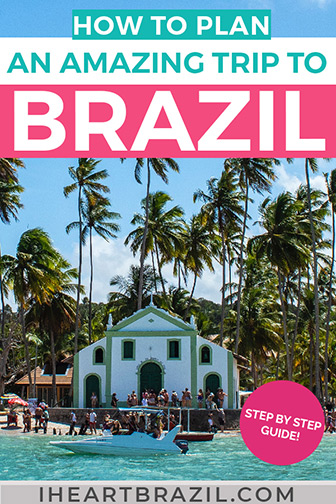
Planning a trip to Brazil
Step 1: check if you need a visa.
First things first. Before planning your trip to Brazil, check if you need a visa.
Visa applications might take some time because you need to gather the paperwork and everything, so plan ahead.
I’ll list below countries whose citizens don’t need a visa to visit Brazil. These citizens only need a passport valid (for at least six months), an onward return ticket, and proof that you can pay for your stay to get into Brazil.
I promise that I will do my best to keep this list updated, but double-check this info before traveling to Brazil.
Andorra, Argentina, Australia, Austria, Bahamas, Barbados, Belgium, Bermuda, Bolivia, Canada, Chile, Colombia, Costa Rica, Denmark, Ecuador, Finland, France, Germany, Greece, Japan, Island, Ireland, Italy, Liechtenstein, Luxembourg, Monaco, Morocco, Namibia, The Netherlands, Norway, Paraguay, Peru, Philippines, Portugal, San Marino, South Africa, Spain, Surinam, Sweden, Switzerland, Trinidad and Tobago, United States, United Kingdom, Uruguay, and Venezuela.
Step 2: Book your ticket
After checking whether or not you need a visa for Brazil, it’s time to book your tickets.
Unless you’re traveling by bus in South America, you’ll most likely fly to Brazil.
Finding cheap flights to Brazil might be a little overwhelming, but it’s certainly not impossible.
Whenever I book my flights, I always follow a few steps to ensure I’m cutting the best deals.
So, after cleaning my laptop cookies, I look for flights in Google Flights . Instead of looking for only return tickets, I also check some one-way tickets. Sometimes it’s well worth it.
And when I find a good deal, I purchase it at the airline website.
Oh, and be sure to check out my guide on Brazilian public holidays to understand when it might be more expensive to travel to Brazil.

Step 3: Plan your itinerary
Planning your Brazil itinerary in advance will give you a better idea of how long to stay in each city and what is there to do in each one of them.
But don’t plan your trip to the minute. Let some time free to sightseeing and doing things as you go.
If you, like most tourists, only spend about 2 weeks in the country, which is not enough to visit every region, you might want to narrow down the places you’ll visit in Brazil .
Will you visit the south or the north? Rio de Janeiro , Iguazu Falls, and Salvador , maybe?
These places are not close to each other, but with proper planning, you can visit them all.
For some ideas, check out these amazing things to do in Brazil .
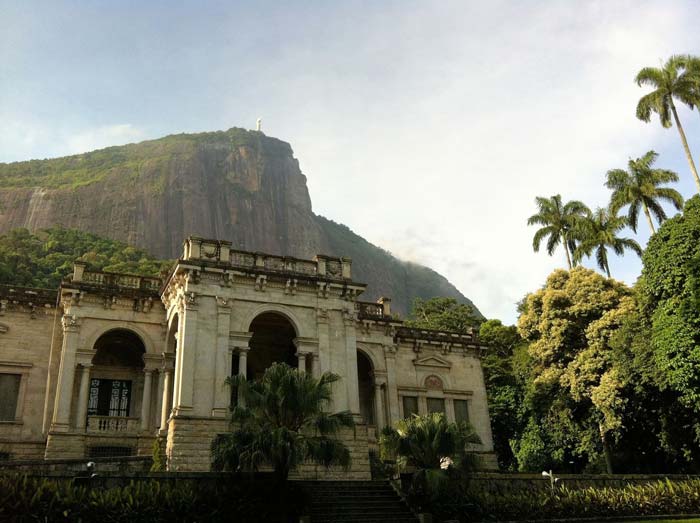
Step 4: Plan tours and activities
Whenever I travel somewhere, I book all possible tours and activities ahead of time.
I don’t like relying on luck. If a tour is sold out, it might ruin my plans, and I’ll probably miss something that I’ll regret later.
Also, booking your tours ahead avoids you having any misunderstandings because of the language barrier, and it’s safer to make transactions.
I like booking my activities on GetYourGuide and Viator because these are reliable companies that I trust and have a flexible cancelation policy.
Alternatively, you can check out these tours in Brazil I selected for you.
Step 5: Budget your trip
Once you’ve planned where to go and for how long, it’s time to budget your trip.
Brazil is an expensive country when compared to other South American countries, but the four-to-one exchange rate still makes it affordable for Americans and Europeans.
Naturally, popular cities such as Rio de Janeiro and São Paulo are more expensive, but even in those places, you can find pretty affordable eating venues and accommodation.
I wrote a guide explaining how much a trip to Brazil costs for different budgets, but I’ll quickly describe it below so that you can have a general idea.
If you want to backpack Brazil, indulge in lots of street food, cook for yourself, and stay in shared dorms, you can travel around the country on a $55-80/ day budget. Expect to spend more while in RJ.
For mid-range travelers, you’ll have considerably more comfort in the country, spending a little more.
If you want to eat out in a variety of restaurants, drink in bars, visit museums, stay in a pleasant private room, and go on a few tours, you’ll spend somewhere between $100-120/ day.
But if you have a little more budget to eat in high-end restaurants, stay in nicer hotels, indulge in the best Brazilian food , take only Uber, and go on some guided tours, know that you can do that without breaking the bank.
For that, you could spend anything between $200 & up/ day, but the sky is the limit. A few high-end hotels in RJ and SP will cost you that alone, though.
Step 6: Book your accommodations
Once you’ve sorted out what you want to spend per night on accommodation, it’s time to get booking!
No matter where I go, I always look for hotels (or hostels) on Booking.com because their website is reliable, easy to use, and I like their easy cancellation policy, which many times is free.
And while there are many accommodation options in Brazil, these are my favorite hotels and hostels in some of the main cities:
Rio de Janeiro
Budget: Rio Earth Hostel . Mid-range: Residencial Santa Teresa . Luxury: Windsor California Hotel .
São Paulo
Budget: Tapera Hostel . Mid-range: Ibis Paulista . Luxury: Unique Hotel .
Budget: Casa de Mainha Hostel . Mid-range: Boulevard Residencial . Luxury: Hotel Casa do Amarelindo .
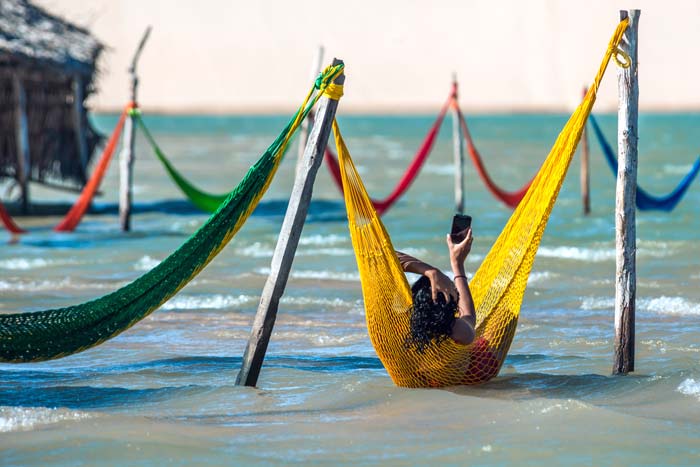
Step 7: Take any vaccinations you may need
Your trip to Brazil is basically planned. Now you need to prepare yourself.
I believe the most significant problem Brazil faces now is dengue, but since there is no vaccination for that, all you can do is avoid mosquito bites by using a good repellent .
The rest of the vaccines or medication you might need to take will depend upon your itinerary.
The CDC recommends tourists traveling to Brazil take vaccines for hepatitis A (if you haven’t already), typhoid, and yellow fever. But check with your doctor which extra ones you might need, if any.
Also, you may want to schedule your appointments well in advance because of the limited availability of injections.
The CDC also recommends being vaccinated for hepatitis B, malaria, and rabies.
Unless you’re planning on making a tattoo/piercing, I’d skip the first. If you’re only traveling to São Paulo, Rio de Janeiro, Brasília, and Iguazu Falls, the second is also not needed.
I’d also skip rabies because if you do get bitten by a dog, which is very unlikely, you’ll need to take the post-exposure shots anyway.
Again, the chances of that happening are very unlikely, especially if you don’t try to interact with street dogs.
Step 8: Learn a bit more about Brazilian culture
You have taken care of the planning, now it’s time to learn a bit more about the country and traditions.
Oh well, you don’t need to graduate in Brazilian culture, but knowing some basics might be beneficial during your vacation.
For example, knowing that feijoada and caipirinha are the national dish and drink, respectively, will certainly be helpful to have a more authentic experience while in Brazil.
Also, we have many unique music styles other than samba that we are very proud of, such as popular Brazilian music, sertanejo, forró, and axé.
And finally, getting familiar with the local celebrations and public holidays might help you while preparing to travel to Brazil.

Step 9: Learn a few basic words and phrases in Portuguese
This might come as a surprise to you, but most people in Brazil don’t speak English, especially in smaller towns.
Yes, the language barrier is a real struggle here, so do your homework and learn a few basic phrases and words in Portuguese while planning a trip to Brazil.
Basic phrases in Portuguese:
- Hello – Olá
- Please – Por favor
- Thank you – Obrigada (fem.), obrigado (masc.)
- Excuse me – Com licença
- How are you? – Tudo bem?
- I’m fine, thanks – Estou bem, obrigada/o (-a, fem., -o, masc.)
- Ok, good – Tá bom
- Good morning – Bom dia
- Good afternoon – Boa tarde
- Good evening/night – Boa noite
- I’m Bruna – Eu me chamo Bruna
- See you soon – Até logo
- Do you speak English? – Você fala inglês?
- I don’t speak Portuguese – Eu não falo português
- Can you write that down, please? – Você poderia escrever isso?
- Yes/no – Sim/não
- Where is the metro? – Onde é o metro?
- How much is this? – Quanto custa?
- The check, please – A conta, por favor
Step 10: Purchase travel insurance
No matter where you go, Rio de Janeiro, Lençóis Maranhenses, or Tokyo, travel insurance is the most essential item on your pre-travel to-do list.
You can’t travel to an unknown country with a strange language without insurance. It’s a much too high risk to take.
Most activities in Brazil are either in tourist areas or outdoors, meaning you might fall victim to theft or have an accident.
With travel insurance, you can recover any expenses resulting from these situations and finish your vacation hassle-free.
I use and am very satisfied with Safety Wing . This has been my insurance for over four years now, and I’ve never had any problems when making claims.
I’m happy to recommend them to anyone I meet.
Click here to get a quote.
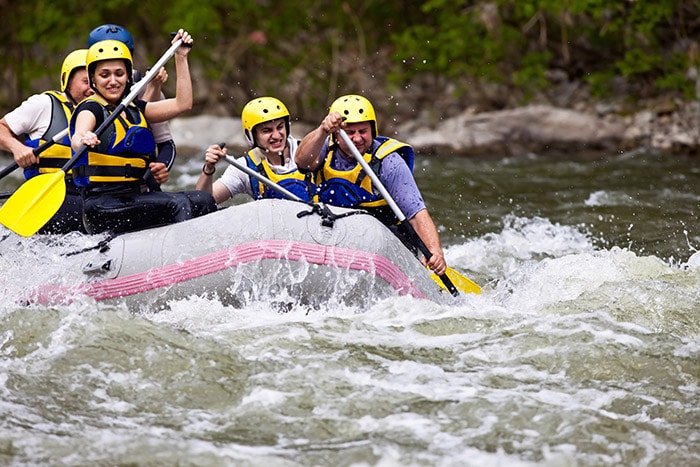
Step 11: Pack some essentials for Brazil
Make a list of the basic things you need for your trip in advance. This way, if you need to buy something, you’ll have enough time to do so.
I made a list of essentials you must bring to Brazil , but here’s a short version of it.
Useful things you may need in Brazil:
- Repellent – essential to avoid mosquito bites. Prefer one with picaridin instead of DEET. It’s much less aggressive for you and the environment.
- Pocket WiFi – unfortunately, WiFi in Brazil is very slow, when available. If you need/want to stay connected, better rely on a reliable pocket WiFi such as Solis.
- Water bottle with filter – while the tap water in most big cities is drinkable, it does have an unpleasant taste. So you may want to use a water bottle to help with that.
- Sunscreen – sunny days aren’t rare in Brazil, so be sure you protect your skin
- Travel bra – ladies, if you don’t have a travel bra, you have no idea of what you’re missing out. This brilliant invention works as a bra and a money belt. So you can safely keep money and passport where no pickpockets can get. I’m a big fan of it, as you can see.
Some more tips while preparing to travel to Brazil:
- Buy local cash (Real – BRL/R$) in advance or plan to withdraw once you arrive at the airport. (Avoid exchanging money at airports as the exchange rate isn’t usually reasonable.)
- Let your bank know you’re traveling abroad so you can withdraw cash at ATMs.
- Have the travel insurance number and policy on your phone and written on a safe paper.
- Police: 190
- Tourist police: São Paulo 11-3257-4475 / Rio de Janeiro 21-2332-2924 / Salvador 71-3116-6817
- Leave flashy watches and expensive jewelry at home. Wearing these things only attracts pickpockets’ attention to you.
- Take photocopies of your documents, passport included.
- Leave a copy of your itinerary with a family/friend at home.
Step 12: Prepare your arrival
You’re almost done with planning your trip to Brazil, but you certainly shouldn’t skip this essential step – planning what to do once you arrive there.
You’ll be exhausted from the long-haul flight, so better get everything arranged in advance, or at least know what to do so you can head over to your accommodation ASAP.
I’m writing a guide on the major airports in the country as well as a taxi guide so you can avoid scammers, but as a rule of thumb, uber is very affordable in the country.
Also, most airports have regulated taxi companies with set prices to some areas of the cities.
I recommend downloading a map of the cities you’ll visit on Google Maps so you can have an idea of your location, even if you’re offline.
Moreover, you can easily take the metro during the day leaving from the major international airports. Just remember to have smaller bills and coins with you for the ticket.
Finally, have a little list of addresses and phone numbers of your accommodations in Brazil just to make sure you know where to go.
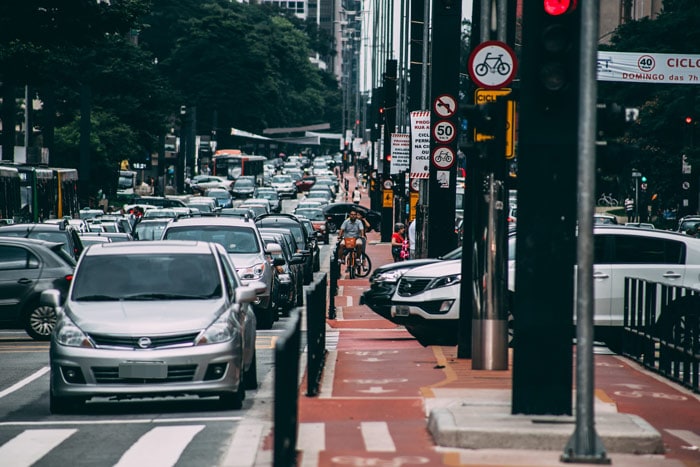
Step 13: Enjoy
Yay! You’re done with planning your trip to Brazil, now it’s time to enjoy your vacation.
Honestly, I just wrote this step because I can’t stand even lists if they’re are not round. Bear with my OCD, folks.
But anyway, now you know exactly how to plan a trip to Brazil hassle-free, and I hope you’ll enjoy it so much, you’ll come back in the future.
Well, if you need any motivation, here are the top reasons to visit Brazil .
Did you like this post on preparing a trip to Brazil? Then pin it to your Pinterest board!
Tuesday 16th of April 2024
Muchas gracias por la información es bastante completa y útil.
Wednesday 23rd of February 2022
Are there any popular hip hop clubs one could go to? Also, any tips for traveling by yourself and going out to club at night?
The only ones I know of are Up Club and Sambarylove, but there might be more. Uh, I guess my tips are to be sensible and not drink too much. Watch your drinks. Take an Uber back to the hotel. Smile and enjoy!
Monday 3rd of January 2022
Ola Bruna, I'm from Australia and have been wanting to visit Brasil forever! Now things are slowly opening up for us it is now time to start planning again, thanks for your post I love Brasil and the people!
Hi Zeyn, thanks for your comment! You're welcome! I hope you have an amazing trip and enjoy your time in Brazil!
Laura Berry
Sunday 11th of July 2021
Hi! Myself and my thirteen year-old daughter want to visit Salvador (we are British, but live in São Paulo). We would like to be near the beach, but also be able to sight-see easily, particularly Pelourinho and any other arty/cultural spots . . can you recommend where might be the best areas to stay (or avoid!) thanks! Laura :)
Tuesday 13th of July 2021
Hi Laura! There are a few areas where you could stay. For example, Barra neighborhood is close to the beach and is a region with lots of restaurants, shops, everything. From here, you can easily get a cab or bus to Pelourinho. This area is always my top recommendation for families and first-time visitors because of all the amenities at your doorstep. Pelourinho is more for backpackers and people traveling on a shoestring. Because it is so touristy, there might be more pickpockets or children asking for money, especially at night. I hope this is helpful! Enjoy!
magdalena docot
Thursday 20th of August 2020
thank you for your guidelines and tips travilling to brazil
Thank you for your comment, Magdalena! I'm glad it is helpful!
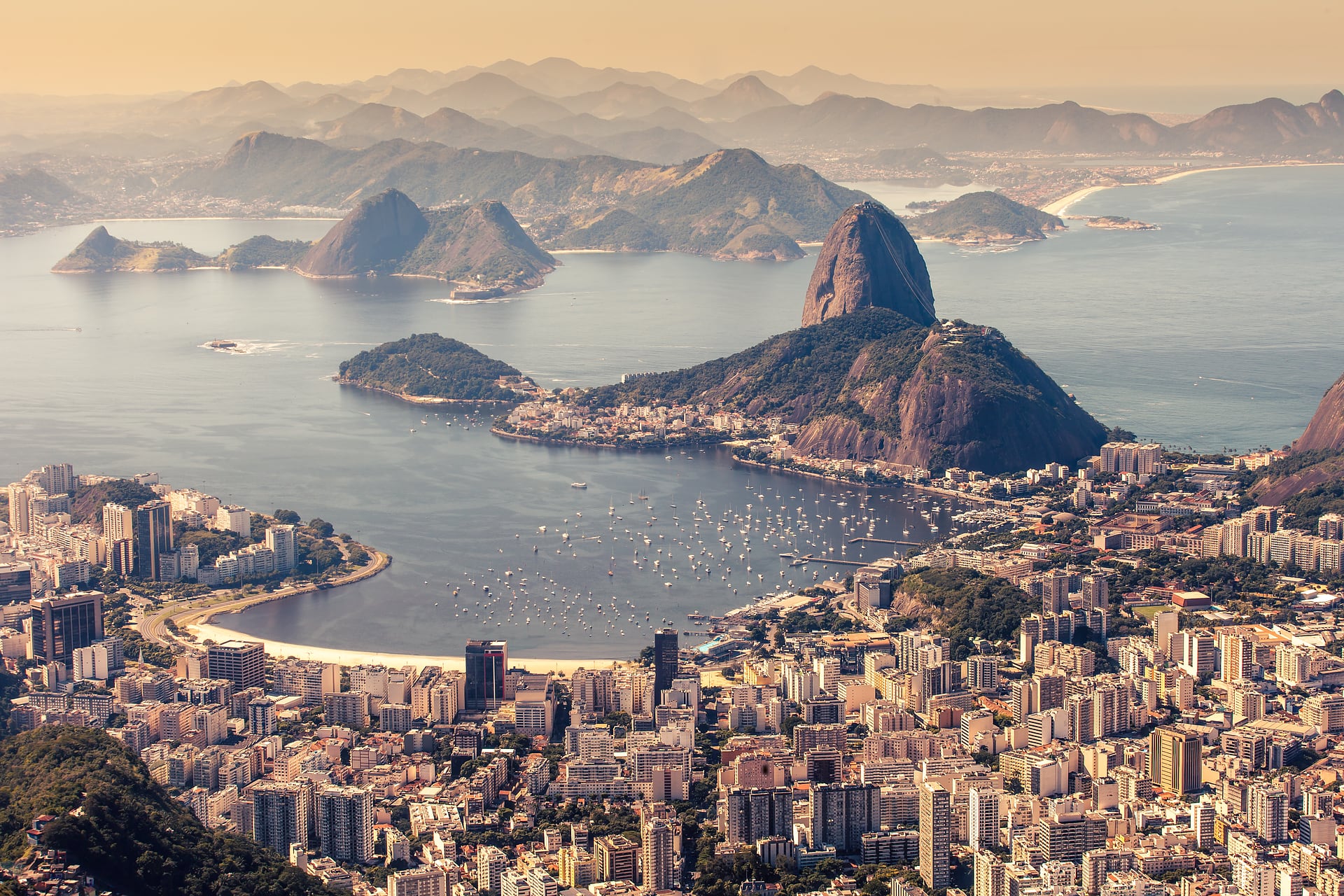
Prices and Cost of Living in Brazil
- South and Central America
Travel Budget Calculator
Calculate how much money you will spend on your vacation in Brazil. Sample budget for each type of traveler - food, transportation, sightseeing and accommodation expenses.
Transportation
Sightseeing
Accommodation
Backpacker's budget
Traveling with a backpack
from 34.78 USD to 41.75 USD
Daily budget for one person, assuming that two people travel in a standard close to 1 star (hostels, public transport). When traveling alone, the cost may be slightly higher (hotel room) or the same (dormitory accommodation).
Average daily expenses were calculated on the basis of the prices of accommodation, food (restaurants and shops), transport (public transport and taxis) and some tourist attractions. Values may vary depending on the city, tourist season, or during major religious and public events. Update 31 May 2024.
How much do you spend per day on travel and sightseeing?
Traveling and sightseeing in a cheap way (hostels, cheap food), you can fit into a budget from 181 BRL (34.78 USD) to 217 BRL (41.75 USD). On the other hand, a slightly higher standard (3-star hotel, meals in restaurants) you should expect to spend from 377 BRL (72.45 USD) to 515 BRL (99.06 USD). You should additionally take into account that if you are traveling alone, the cost may be slightly higher.
Food Prices - Calculate the Cost of Living
The calculator allows you to quickly and easily calculate how much you will spend on average to buy food at grocery stores in Brazil. Plan your daily, weekly and monthly food expenses.
Select the appropriate number of days to see how much you will spend on food during that period. Values given for one person.
Cheapest products
Here's how much you will spend in 1 day .
from 3.64 USD to 5.64 USD
Mid-range products
from 5.09 USD to 7.82 USD
Average values for capital or largest city. Purchase of food products in local stores and supermarkets corresponding to daily meals of 2,200 to 2,400 kcal was taken into account. Update 31 May 2024.
How much do you have to spend on groceries per day in Brazil?
When shopping for groceries in local stores and markets, the average daily cost of food expenses will range from 18.94 BRL (3.64 USD) to 29.35 BRL (5.64 USD) when buying the cheapest products. However, if you choose slightly more expensive products, you can expect to pay from 26.49 BRL (5.09 USD) to 40.69 BRL (7.82 USD) per day. These figures are based on daily meals consisting of approximately 2200-2400 kcal and may vary slightly depending on the city.
Budget and shopping basket update: 31 May 2024
Estimated budget and daily food costs are always given per person and are only a suggestion to help you plan your total travel costs.
Budget was calculated on the basis of average prices of accommodation in each category (hotels and hostels), food costs (restaurants and grocery shopping), transport prices and some tourist attractions.
BACKPACKER'S BUDGET • accommodation in a hostel or cheap hotel, • travel by public transport, • dining in cheap local restaurants or buying food in local stores, • small number of paid tourist attractions, • two people travel (when traveling alone, prices may be higher, but only if we use a hotel room instead of a dormitory).
TOURIST'S BUDGET • accommodation in a 3 star hotel (with a small number of available facilities, average prices of 3* and 4* hotels), • traveling by taxis, • catering in middle-class restaurants and buying food in grocery stores, • average number of paid tourist attractions, • two people travel (they share costs of accommodation and transport).
FOOD EXPENSES • daily meals containing 2200 to 2400 kcal (applies to both price variants), • shopping for food in local stores or supermarkets (no meals in restaurants), • value per person & for the capital or largest city.
Prices in Brazil
Below you will find a list of prices for products and services in Brazil, which will help you determine what expenses you should prepare for when going on vacation in this country. City: Rio de Janeiro.
Grocery Store Prices
Food and beverage prices in brazil.
Popular food products found on store shelves in Brazil include bananas, rice, bread, onions, eggs, tomatoes, cheese, beef and potatoes, among others. Prices for a kilo of these products range from 5.07 BRL (0.97 USD) for a kilo of onions to 43.53 BRL (8.37 USD) for a kilo of beef. The price of white rice is 5.9 BRL (1.13 USD) per kilo, while a loaf of fresh white bread costs 7.94 BRL (1.53 USD) per half kilo. Bananas cost 6.6 BRL (1.27 USD) per kilo, while apples cost 10.23 BRL (1.97 USD) per kilo.
Water, available in 1.5-liter bottles, costs 2.87 BRL (0.55 USD). Dairy prices in Brazil, on the other hand, are as follows: 1 liter of milk costs about 5.69 BRL (1.09 USD), and 1 kilogram of locally produced cheese is an expense of 43.09 BRL (8.28 USD). Chicken filet, which is a common ingredient in meat dishes, costs in the range of 18.9 BRL (3.63 USD) per kilo. Eggs (12 pieces per package) are an expense of about 9.78 BRL (1.88 USD), and the average price of tomatoes is 8.69 BRL (1.67 USD) per kilo.
Restaurant Prices
What is the typical cost for an affordable meal.
Prices in restaurants in Brazil vary and depend on several factors, such as the type of restaurant, location and time of day. For instance, a Cappuccino typically costs around 8.52 BRL (1.64 USD), while a 0.33-liter bottle of Coca-Cola or Pepsi is priced at approximately 6.05 BRL (1.16 USD). At a fast-food restaurant such as McDonald's, you can expect to pay 35 BRL (6.73 USD) for a meal, whereas a meal for two at a mid-range restaurant could cost around 150 BRL (28.83 USD). Budget-friendly dining options are also available, with some restaurants offering meals for as little as 35 BRL (6.73 USD).
Public Transportation Prices
How much does transportation cost in brazil.
The average expense of a one-way trip using local transportation stands at approximately 4.65 BRL (0.89 USD), while a monthly ticket for public transportation has an average cost of roughly 252 BRL (48.43 USD). Choosing to travel by taxi would entail an initial fee of 6 BRL (1.15 USD), along with a per-kilometer charge of 5.5 BRL (1.06 USD).
Fuel Prices
Fuel prices in brazil.
Average fuel prices in Brazil are 6.04 BRL (1.16 USD) per liter of gasoline and 6.21 BRL (1.19 USD) per liter of diesel.
Entertainment Prices
Apartment rental prices, how much does it cost to rent an apartment in brazil.
The cost of renting or buying an apartment in Brazil varies according to its location. On average, renting an apartment with one bedroom and a living room outside the city center costs approximately 1310 BRL (252 USD) per month, while the same type of apartment in the city center can cost around 2033 BRL (391 USD) per month. In comparison, the purchase price of an apartment in the city center is 11253 BRL (2163 USD) per square meter.
Apartment Buying Prices
Average salary, hotel prices in brazil.
A comprehensive list of the current prices of accommodations in various cities, ranging from budget-friendly hotels to high-end luxurious stays.

What is the average cost of a hotel room?
Accommodation prices in Brazil vary depending on the city, neighborhood or tourist season. For example, the average price of accommodation in São Paulo (June 2024) ranges from 120 BRL (23 USD) per night in a hostel to about 660 BRL (127 USD) in a 3-star hotel. The price of a night in a luxury hotel is an expense from 1821 BRL (350 USD) upwards.
- Rio de Janeiro
- Porto Seguro
- Florianopolis
- Foz do Iguaçu
- Belo Horizonte
- Campos do Jordão
- João Pessoa
- Balneário Camboriú
- Caldas Novas
- Porto Alegre
Accommodation prices based on data from 189 hotels in São Paulo .
• Prices for products and services in Rio de Janeiro . Prices may vary from town to town. • Updates: oldest data 09/2022, latest data 02/2024. • Prices were calculated based on several sources including Expedia.com, Booking.com, local supermarket websites, own sources, submissions from users. We do not guarantee their accuracy, however, we try, to keep them high. • If you have noticed an error, please report it .
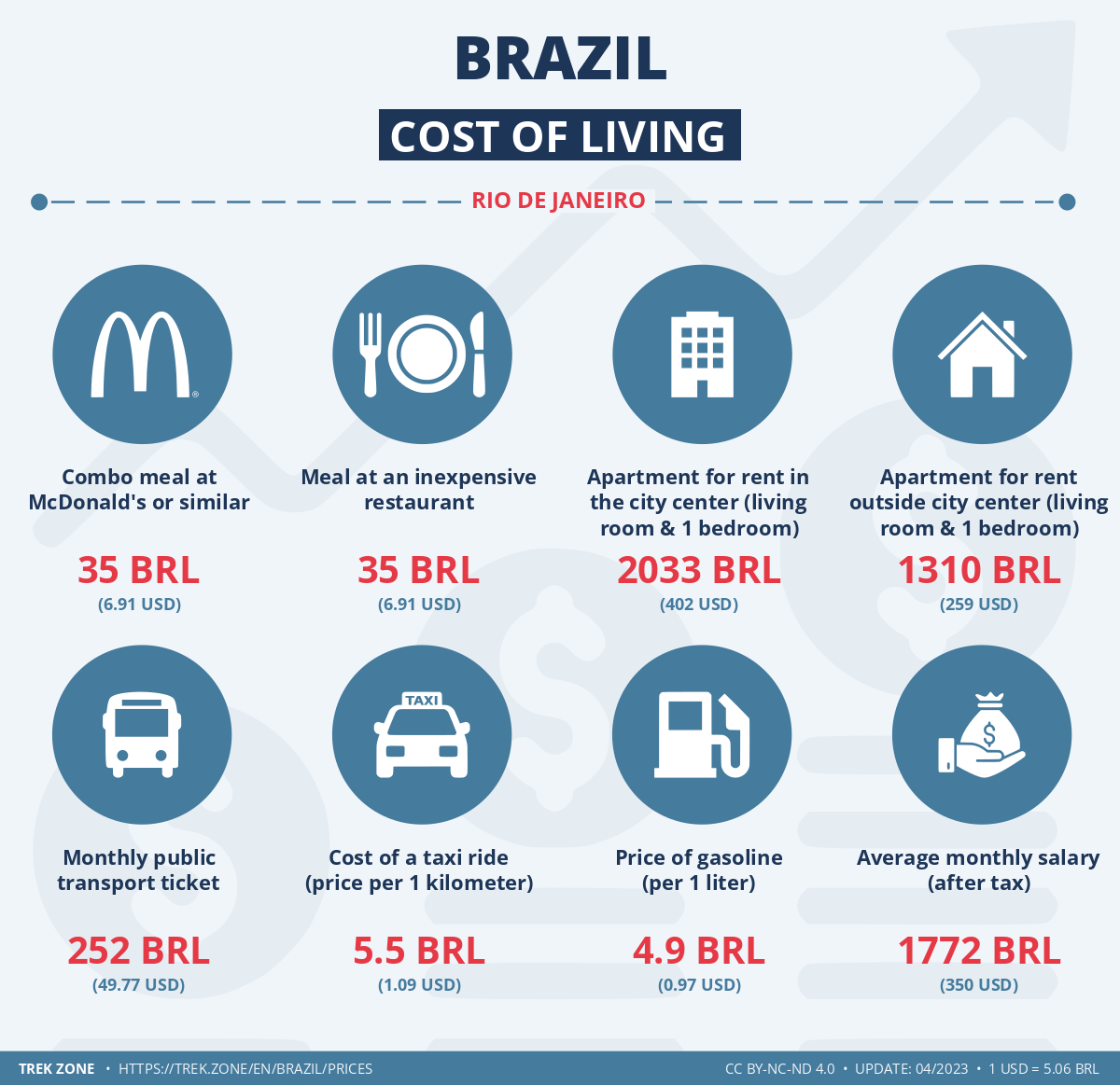

Rio de Janeiro Travel Guide
Last Updated: August 30, 2023
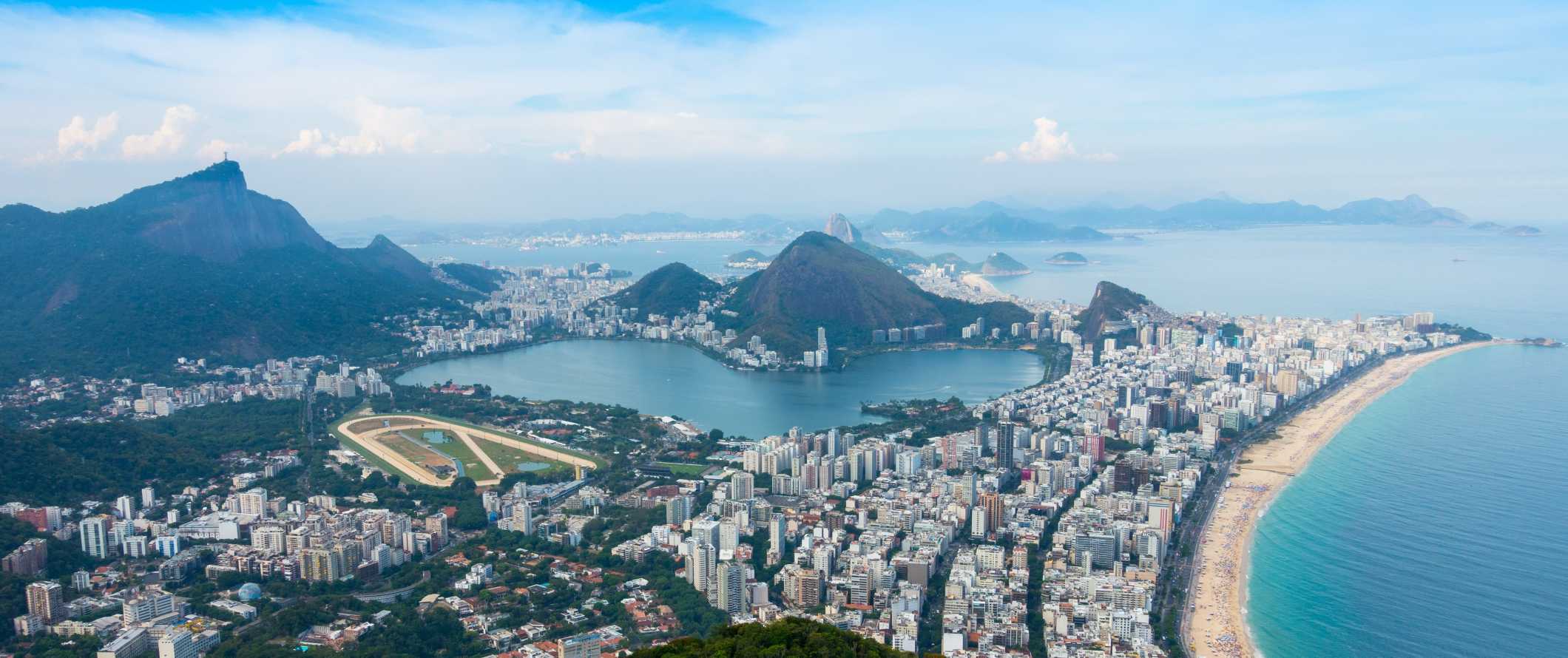
From the world-famous beaches of Copacabana and Ipanema to the magnificent summit of Corcovado, topped with the legendary Wonder of the World Christ the Redeemer, Rio combines big natural attractions with a sprawling metropolis. Home to over 12 million people, it should come as no surprise that it’s one of the most popular destinations in the world.
Founded by the Portuguese in the 16th century, Rio de Janeiro caters to every type of tourist and budget, popular with backpackers, Carnival revelers, and luxury vacationers alike. It’s an exciting city that has a lot to offer — so don’t rush your visit. There’s too much to see, especially when you factor in all those lazy days at the beach!
While petty theft and crime are a big concern here (you’ll want to avoid walking around alone at night), with a little vigilance you’ll be able to enjoy your time in this vibrant city without too much worry.
This travel guide to Rio de Janeiro can help you save money, stay safe, and ensure you have a wonderful visit.
Table of Contents
- Things to See and Do
- Typical Costs
- Suggested Budget
- Money-Saving Tips
- Where to Stay
- How to Get Around
- How to Stay Safe
- Best Places to Book Your Trip
- Related Blogs on Rio de Janeiro
Top 5 Things to See and Do in Rio de Janeiro
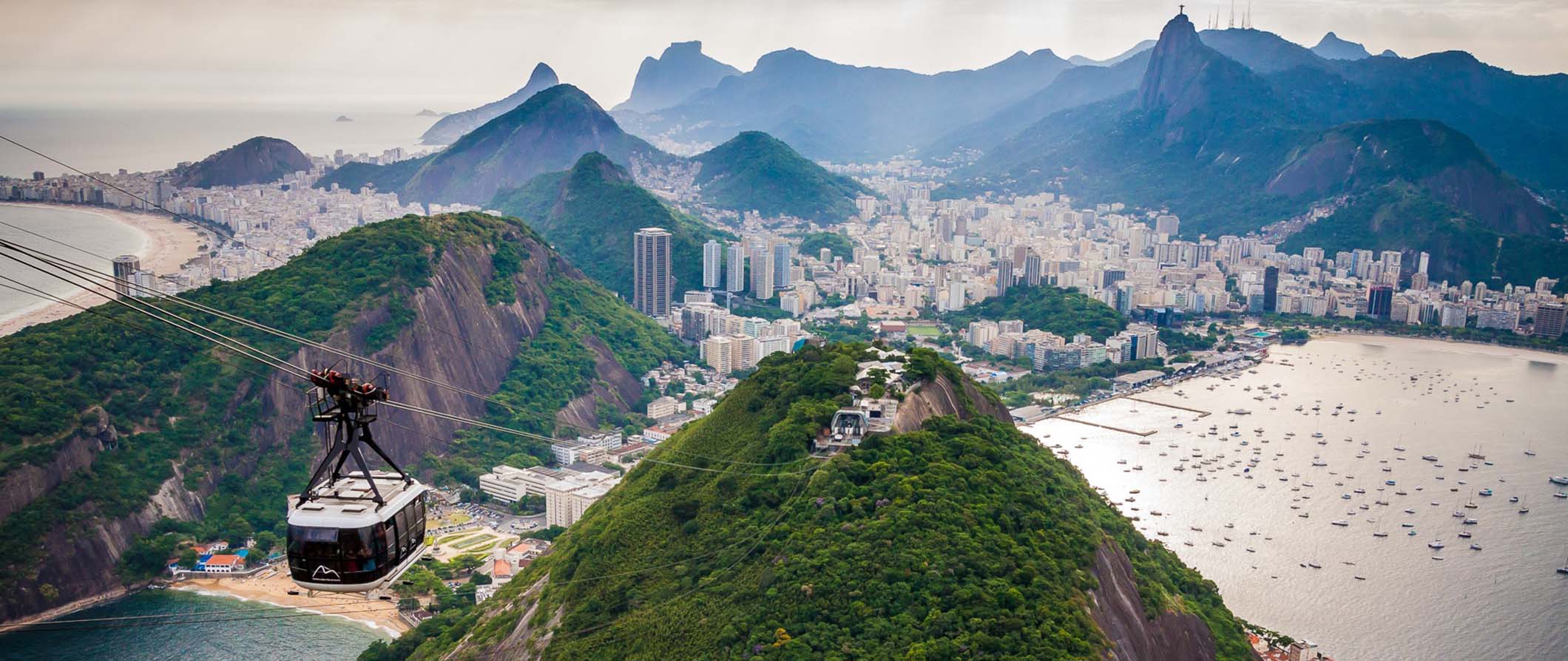
1. Celebrate Carnival
The Rio Carnival is one of the most famous festivals in the world, with people coming together from all corners of the globe to see the parade, listen to samba music, dance in the streets, and party for days. The city comes alive as thousands of people celebrate in bright, exotic regalia. You can reserve your 2024 Carnival tickets in advance here (highly recommended – they sell out quickly)!
2. Climb Sugarloaf Mountain
The famous Sugarloaf Mountain is one of the city’s most popular tourist destinations. Its name dates to the 16th century (the height of Brazil’s sugarcane trade), named for its resemblance to a conical block of sugar. The mountain is 396 meters (1,300 feet) tall, and at its peak, the entire city unfolds below you with spectacular views of Ipanema and Guanabara Bay, especially at sunset or sunrise. The cable car to get there costs 150 BRL ( reserve online in advance to skip the often super long lines).
3. See Christ the Redeemer
The 30-meter (100-foot) high statue of Christ the Redeemer sits atop the Corcovado Mountain and can be seen from any point in Rio. From its vantage point, you can take in the mountains, the bay, and the entire cityscape from the favelas to the skyscrapers. It’s an incredible Wonder of the World! You can get there a few different ways: via cog train (that goes through the rainforest), shared vans that leave from designated points around the city, or by hiking the (quite steep) trail to the top (though for safety reasons, it’s not recommended to do the trail alone). You can reserve advance tickets for the train and statue here (155 BRL).
4. Hit the beaches
Ipanema and Copacabana are the two largest beaches, and they’re always jam-packed with people. Ipanema has more upscale restaurants and nightlife, while Copacabana has more things to do (like fishing, surfing, and beachside markets selling handicrafts and swimwear). For quieter spots, check out Barra de Tijuca Beach, Prainha Beach, or Leme Beach (at the further end of Copacabana Beach).
5. Watch a fútbol game
Other things to see and do in rio de janeiro, 1. visit the botanical gardens.
For a moment of calm, head to the city’s botanical gardens. Walk along the meandering paths and trails or take a free guided tour of the gardens. This place is home to over 8,000 plant species, designed in 1808 by order of the Prince Regent Dom João. Highlights include a lake filled with enormous Vitória Régia water lilies, an enclosed area with over 600 species of orchids, and a carnivorous greenhouse filled with Venus flytraps and pitcher plants. The gardens get super busy with families on the weekends, so come during the week. Admission is 67 BRL.
2. Wander the Rio de Janeiro Zoo
If your travels don’t include a trip to the Amazon, you can still experience Brazil’s indigenous animals at the Rio City Zoo. Over 1,300 animals from 350 species live here, including many rare and endangered native species such as harpy eagles, maned wolves, golden-headed lion tamarins, anteaters, and more. There’s also a particularly impressive reptile house and open aviary with macaws, toucans, and tropical birds flying freely around. Admission costs 47 BRL.
3. Learn the samba
You’ll hear samba music playing endlessly around Rio, especially during Carnival. Rio de Janeiro is one of the best places in Brazil to learn how to dance. Rio Samba Dancer is my favorite for its all-levels group classes, especially for the classes combined with social outings to samba clubs. Classes start from about 105 BRL.
4. Go to Paquetá Island
Paquetá Island in Guanabara Bay is a favorite with locals for escaping the hustle and bustle of the city center on weekends. The island is an hour-long ferry ride from Rio, and it’s made up of mainly beaches and quaint colonial towns. Transportation around the island is only by foot, bicycle, or horse-drawn carts. There’s not a lot to do here, but that’s kind of the point. The ferry costs 6.50 BRL one-way.
5. Ride the Santa Teresa tram
This tram has been running through the Santa Teresa neighborhood since 1877, making it the oldest electric railway in Latin America. It has always followed the same route from the city center, across the Lapa Arches, and passing by Ruinas Park overlooking Rio. The tram is open-sided, meaning you can lean out over the arches (a narrow former aqueduct) as you cross them – it’s a dizzying view! A return ticket on the 6-kilometer (3.7-mile) route is 20 BRL.
6. Visit the Selaron Stairway
Located in the Santa Teresa neighborhood, this stairway has hundreds of steps all painted with more than 2,000 pieces of colorful tiles, mosaics, and mirrors. Starting in the early 1990s, artist Jorge Selarón began gathering contributions from artists in 60 different countries. He also visited antique shops and trash heaps to find pieces to add over time, working on the staircase’s construction for over 20 years until his death in 2013. It’s one of the most photogenic and popular sights in the city (you’ve probably seen it on Instagram) so don’t miss it!
7. Explore the Arcos da Lapa district
For those of you who love the nightlife, this is an awesome district to head out to on a Friday night. Bars, clubs, and food stalls dominate the area, and street parties run from the famous arches up Avenida Mem de Sá. For live music, go to Circo Voador, an open-air concert venue primarily featuring Brazilian bands and artists. If you want to experience the club scene, check out the three-story Rio Scenarium. If you’re not into partying at all, admire the photogenic Arcos de Lapa (Lapa Arches). These arches date back to the mid-18th century and were once used as aqueducts.
8. Visit Sitio Roberto Burle Marx
This home and World Heritage Site belongs to one of Brazil’s most celebrated landscape designers, Roberto Burle Marx. Begun in 1949 and developed over the course of over 40 years, this 100-acre property features over 3,500 tropical and subtropical plant species. Inside the Burle Marx House Museum is a huge collection of his personal artwork as well as a 17th-century Benedictine chapel. Tours cost 10 BRL and are available by appointment only.
9. Visit the São Bento Monastery
Built between 1617-1641, this colonial Baroque church is located on Morro de São Bentois (St. Benedict Hill) in downtown Rio de Janeiro. Although the exterior is simple, the inside is covered in gold decoration, wood carvings from Frei Domingos da Conceição and Alexandre Machado, and paintings from José de Oliveira Rosa. The monastery is still in operation today, and if you attend Sunday mass, you’ll get to hear some traditional Gregorian chanting. Just be sure to dress respectfully as it is a place of worship.
10. Hike in Tijuca National Park
Tijuca National Park is the largest urban rainforest in the world, stretching across 8,300 acres. Over 350 different species of mammals, birds, and reptiles make their home here, including howler monkeys, which only came back to the park recently after a 100-year hiatus. The Corcovado (Christo) hike through Parque Lage and to the top of Corcovado is a steep climb, but it’s shaded and only takes about three hours. Another scenic hike is to Tijuca Peak, starting in Rio’s North Zone and past waterfalls and dense rainforest. You’ll get views over Niteroi and Guanabara Bay, and it only takes about two hours to complete. Entrance to the park is free. This is a place where it’s really worth it to go with a tour though. You’ll not only have a more in-depth experience, learning history of the rainforest as well as how to recognize native flora and fauna, but get round-trip transportation to/from your accommodation as well. There are tons of tours available, from the popular jeep tours to full-day adventure hikes that go to lesser visited sections of the rainforest.
11. Go to the Ilha Fiscal
A little outside Rio’s city center is Ilha Fiscal, a Neo-Gothic castle on a secluded island in Guanabara Bay. It used to be a location for the Brazilian Custom Service but is now a work of architectural art, with mosaic floors, stained glass, and a traditional Ceremonial Room used by the Navy. You can only access the island by schooner and bus from the Naval Museum. Admission to the Naval Museum is free, while a return ticket to Ilha Fiscal is 42 BRL.
12. Visit the Museum of Tomorrow
The Museum of Tomorrow (Museu do Amanhã) is a science museum that focuses on ecology, sustainability, and the future of our planet. Ultra-sleek and modern, the Museum of Tomorrow has high-tech visuals and simulators that let you consider the world’s past, present, and future. Although it might sound depressing, it’s incredibly well-curated, and the whole experience is captivating. Admission is 30 BRL.
13.Take a walking tour
Walking tours are my favorite way to get my bearings in a new place. Free Walker Tours and Rio by Foot both offer free walking tours through a variety of different Rio neighborhoods, as well as paid tours such as food tours, pub crawls, and rainforest tours. If you’re taking a free tour, just be sure to tip your guide at the end!
14. Explore Rio by Bike
Because of Rio’s geography, stretching along the coast between the ocean and the mountainous rainforest, the city can take some time to get around. You can cover a lot of ground by biking along the beach and through different neighborhoods on the many kilometers of dedicated bike lanes in the city. You can either explore on your own or with a local guide on a tour with Rio by Bike .
For more information on other cities in Brazil, check out these guides:
- Fernando de Noronha Travel Guide
- Florianopolis Travel Guide
- Sao Paulo Travel Guide
Rio de Janeiro Travel Costs
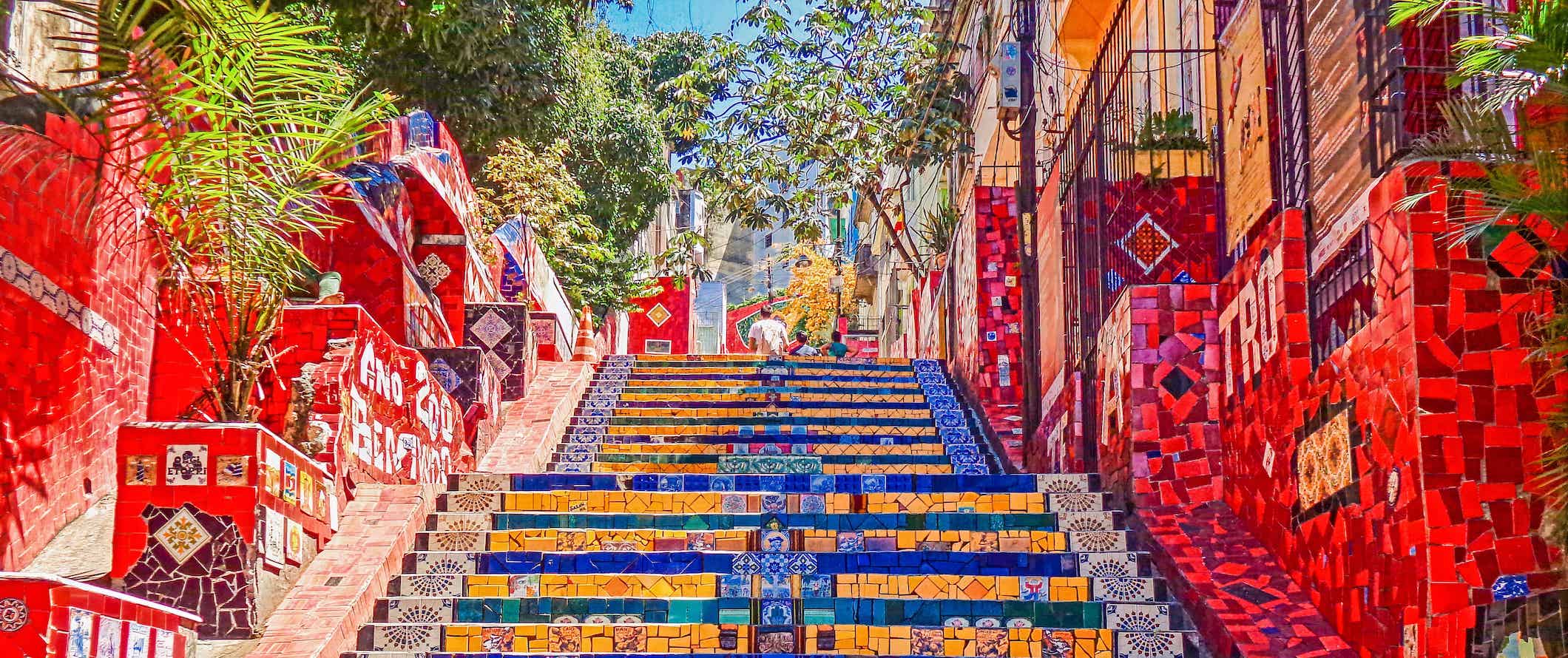
Hostel prices – Large dorm rooms with 8-10 beds start around 65-75 BRL per night. Dorm rooms with 4-6 beds are around 90-110 BRL per night. Standard twin or double private rooms cost 225-300 BRL per night for two people.
Free Wi-Fi is standard, and most hostels have a bar and outdoor patio with a BBQ. Free breakfast is usually included at hostels in Rio de Janeiro, and kitchen facilities are common too. Some hostels have a pool, coworking spaces, and bikes for rent.
If you book your bed well ahead of time for Carnival (at least six months), you’ll have more options. However, prices skyrocket — some of those dorms mentioned above increase to 200-300 BRL per night — during Carnival!
Budget hotel prices – A double room in a basic two-star hotel is around 150 BRL per night in the city center, including a private bathroom and balcony as well as free Wi-Fi. That price can nearly double in other places like Copacabana (the most popular place for tourists to stay).
A budget hotel with more amenities (free breakfast, a swimming pool, bar/restaurant) starts around 190 BRL per night for a double room.
Airbnb is another affordable option here. For a private room, expect to pay about 100-125 BRL per night, while you can find a comfortable home or apartment for about 275-350 BRL per night.
During Carnival time, private and hotel rooms can double in price and sell out fast.
Average cost of food – Brazilian cuisine – like the country itself – is a mix of many cultures, with European, Amerindian, African, and (more recently) Japanese influences. As such a large country, food varies per region, with seafood plentiful on the coastlines and Brazilian barbecue dominating plates in the south. Rice and beans are a staple throughout the country.
Common vegetables include tubers like cassava and yams, tomatoes, red peppers, okra, and more. Being a subtropical country, there’s a huge variety of fruits, with the most famous being the superfood açaí. Cupuaçu, mango, papaya, guava, orange, passion fruit, pineapple, are all commonly found in smoothies and fresh juices across the country.
Look for feijoada on the menu. It’s Brazil’s national dish, a meaty bean stew, traditionally eaten for Wednesday or Saturday lunch. Other popular dishes include moqueca (fish stew), polenta, vatapá (a stew of bread, shrimp, coconut milk, and peanuts), and farofa (toasted cassava flour, served as a side to feijoada ), among countless others.
Some popular street food snacks include pão de queijo (cheese bread rolls), acarajé (black-eyed pea and shrimp fritters), coxinha (chicken croquettes), and pastéis (savory fried pies with assorted fillings). In Rio, bolinhos de bacalhau (fried cod fritters) are especially popular due to the city’s coastal location.
Rio de Janeiro has lots of affordable food options, with street food like pastels, coxinha, and tapiocas costing 8-10 BRL each. A meal at an inexpensive restaurant serving typical Brazilian dishes costs about 20-40 BRL. An açaí (served pureed and frozen, with toppings you can choose from) from a street stand or takeaway spot is 15-20 BRL.
For fast food, a combo meal at McDonald’s or a takeaway meal from a Chinese restaurant both cost about 35 BRL.
A meal with two courses at a casual restaurant starts from 60 BRL, though prices at restaurants along the beach can go much higher, starting around 70-80 BRL for a dish. A three-course meal with a drink at a nicer restaurant is around 200 BRL.
A beer to go with your meal is around 7-10 BRL, while a cocktail starts at 20 BRL (though they can get upwards of 40 BRL in fancier places). In terms of non-alcoholic drinks, a cappuccino or fresh juice is 8-12 BRL.
One of the best ways to eat in Rio is to find a restaurant por kilo , which lets you pay for your meal by weight (so skip the super-thick steak). It generally costs around 70-90 BRL per kilo, with prices varying depending on the time of day and day of the week (nights and weekends are more expensive). Restaurante Temperarte near Copacabana is a great option for trying this.
Grocery shopping is very cheap, costing about 100-145 BRL per week for bread, meat, veggies, and other basics. You’ll just need to make sure you book accommodation with a kitchen.
Backpacking Rio de Janeiro Suggested Budgets
If you are backpacking Rio de Janeiro, expect to spend about 215 BRL per day. This covers staying in a hostel dorm, eating street food, cooking some of your meals, limiting your drinking, using public transportation to get around, and doing mostly free activities like enjoying the beach.
On a mid-range budget of about 470 BRL per day, you can stay in a private hostel or Airbnb room, eat out for all your meals at cheap local restaurants, take the occasional taxi to get around, enjoy a few drinks, and do more paid activities like visiting the zoo and attending a soccer game.
On a “luxury” budget of about 825 BRL per day or more, you can stay in a hotel, eat out for all your meals, enjoy more drinks, take taxis everywhere, and enjoy all the tours and activities you want. This is just the ground floor for luxury though. The sky is the limit!
If you’re coming during Carnival time, expect prices for accommodations and activities to increase significantly (sometimes quadruple) — especially if you’re booking last minute.
You can use the chart below to get an idea of how much you need to budget daily, depending on your travel style. Keep in mind these are daily averages – some days you’ll spend more, some days you’ll spend less (you might spend less every day). We just want to give you a general idea of how to make your budget. Prices are in BRL.
Rio de Janeiro Travel Guide: Money-Saving Tips
Rio has lots of free activities and attractions to enjoy, like beaches and hiking trails. While food and accommodation aren’t cheap, there are ways to keep your costs down. Here are some ways to save money in Rio de Janeiro:
- Eat por kilo – As with elsewhere in Brazil, restaurants that have you pay by the kilo for your food is a good deal. Look out for these cheap options.
- Visit the market – If you’re staying at a hostel with kitchen facilities, it’s a good idea to stock up on food at the market and eat like the locals.
- Stay with a local – Couchsurfing connects you with locals who can give you a free place to stay and share their insider tips and advice. It’s the best way to meet locals and save money.
- Go to free museum days – Almost all the museums in Rio have a free day to visit each week. Check their website for details!
- Take a free walking tour – There are many excellent free walking tours in Rio, including Free Walker Tours and Rio By Foot. They’re the best way to see the main sights on a budget. Just be sure to tip your guide at the end!
- Avoid Carnival time – As exciting as Carnival is, visiting Rio any other time of the year is just as magical and saves you lots of money.
- Pack a water bottle – The tap water here isn’t safe to drink so bring a water bottle with a filter to save money and reduce your single-use plastic usage. My preferred bottle is LifeStraw as it has a built-in filter to ensure your water is always clean and safe.
Where to Stay in Rio de Janeiro
Rio de Janeiro is a sprawling city. When you’re researching your hostel, make sure you find a neighborhood that fits your needs, whether you want to stay in the city center or somewhere near the beach. Otherwise, you’ll be spending a lot of money on taxis and sitting in the city’s terrible traffic. Here are my suggested places to stay:
- Selina Lapa Rio de Janeiro
- Mango Tree Hostel Ipanema
- CabanaCopa Hostel
For more suggestions, check out this post on the best hostels in Rio .
How to Get Around Rio de Janeiro

Public Transportation – Rio’s BRT (Bus Rapid Transit) has quick and reliable routes in Copacabana, Barra, Ipanema, and Leblon. Fares cost from 3.80 BRL per trip. You’ll have to flag down a bus by waving at the driver. Otherwise, the Metrô Na Superfície shuttle passengers between metro stations, but they’re often very crowded. The bus is also not always the safest method of travel, so exercise caution here, and don’t use them at night.
Rio de Janeiro has three very efficient subway lines. Line 1 runs between Ipanema to the North Zone, while Line 2 runs between Botafogo and Pavuna (with Maracanã football stadium on the way). Line 3 runs between Ipanema and the Barra de Tijuca. You can get a prepaid card (called RioCard+Mais) at any kiosk for 4 BRL. A single metro ride costs 5 BRL.
For solo female travelers, note that there are women-only metro cars (marked in pink) during peak rush hours (6am-9am, 5-8pm, on weekdays).
The only remaining tram line in Rio is the famous Santa Teresa line, which runs from the tram station in Centro and travels across the Lapa Arches, Ruinas Park, and then turns around at Largo do Guimarães. A return ticket is 20 BRL.
Bicycle – Rio has tons of bike paths along its main beach areas. Unfortunately, only Brazilian citizens and residents with a CPF number can use the bike sharing system, though you can also rent bikes from a local shop for about 150 BRL per day to navigate the paths between Copacabana and Ipanema.
Ferry – You can take a ferry to visit several of Rio’s highlights, like Ilha Fiscal, Ilha de Paquetá, and Niterói. Ticket prices are generally 12-15 BRL round-trip.
Taxis – Taxis start at 6 BRL and cost an additional 2.65 BRL per kilometer. This rate increases to 3 BRL per kilometer at night and on Sundays. A ride around town generally costs 10-50 BRL. Use the 99 app (formerly 99Taxis) to get a safe, metered taxi.
Ridesharing – Uber is available in Rio de Janeiro and usually costs around the same a taxi.
When to Go to Rio de Janeiro
December to March is when Rio is at its warmest and sunniest. There isn’t much rain during these months, and temperatures tend to be around 32°C (90°F) and higher each day.
Autumn (April-May) and spring (October-November) offer slightly cooler temperatures, usually in the mid-20s°C (low 80s°F). Although Rio is busy year-round, you’ll avoid a lot of peak tourism madness by visiting during these months.
During February’s Carnival, prices skyrocket, and accommodation sells out very quickly. You should consider booking your travel at least six months (and up to a year) before Carnival time to snag the best deals and places to stay.
How to Stay Safe in Rio de Janeiro
Rio de Janeiro has a lot of crime and is not the safest city in the world. Violent attacks can occur, however, your biggest concern here is petty crime — especially after nightfall around popular tourist destinations.
Don’t walk alone at night. Instead, take taxis. Have your accommodation call one for you so you can be sure you get a reputable driver.
When withdrawing money, make sure you go inside a bank so that you can put your cash away without the risk of getting robbed.
Don’t flash your valuables and always make sure your possessions are secure and out of reach (especially your phone and wallet).
Never accept drinks from strangers and don’t leave anything unattended at the beach.
Unless you’re on a guided tour, avoid the favelas. The favelas are where the highest rate of crime occurs in the city, and you shouldn’t be exploring there on your own.
Carjacking and break-ins are common so avoid renting a car here.
Solo female travelers will want to exercise caution here. Travel with groups where you can and avoid getting too far off the beaten path if you’re alone.
If you’re worried about getting scammed, you can read about common travel scams to avoid right here.
If you experience an emergency, dial 190 for assistance.
Always trust your gut instinct. Avoid isolated areas at night and be aware of your surroundings at all times. Make copies of your personal documents, including your passport and ID. Forward your itinerary along to loved ones so they’ll know where you are.
The most important piece of advice I can offer is to purchase good travel insurance. Travel insurance will protect you against illness, injury, theft, and cancellations. It’s comprehensive protection in case anything goes wrong. I never go on a trip without it as I’ve had to use it many times in the past.
Rio de Janeiro Travel Guide: The Best Booking Resources
These are my favorite companies to use when I travel. They consistently have the best deals, offer world-class customer service and great value, and overall, are better than their competitors. They are the companies I use the most and are always the starting point in my search for travel deals.
- Skyscanner – Skyscanner is my favorite flight search engine. They search small websites and budget airlines that larger search sites tend to miss. They are hands down the number one place to start.
- Hostelworld – This is the best hostel accommodation site out there with the largest inventory, best search interface, and widest availability.
- Booking.com – The best all around booking site that constantly provides the cheapest and lowest rates. They have the widest selection of budget accommodation. In all my tests, they’ve always had the cheapest rates out of all the booking websites.
- Get Your Guide – Get Your Guide is a huge online marketplace for tours and excursions. They have tons of tour options available in cities all around the world, including everything from cooking classes, walking tours, street art lessons, and more!
- SafetyWing – Safety Wing offers convenient and affordable plans tailored to digital nomads and long-term travelers. They have cheap monthly plans, great customer service, and an easy-to-use claims process that makes it perfect for those on the road.
- LifeStraw – My go-to company for reusable water bottles with built-in filters so you can ensure your drinking water is always clean and safe.
- Unbound Merino – They make lightweight, durable, easy-to-clean travel clothing.
- Top Travel Credit Cards – Points are the best way to cut down travel expenses. Here’s my favorite point earning credit cards so you can get free travel!
Rio de Janeiro Travel Guide: Related Articles
Want more info? Check out all the articles I’ve written on backpacking/traveling Brazil and continue planning your trip:
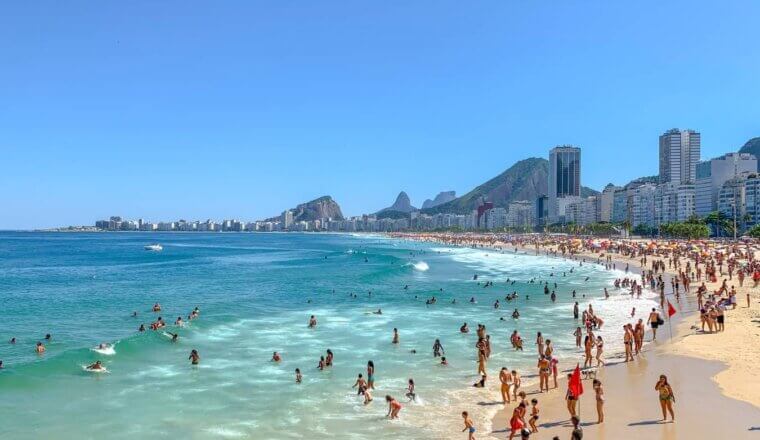
The 6 Best Hostels in Rio de Janeiro
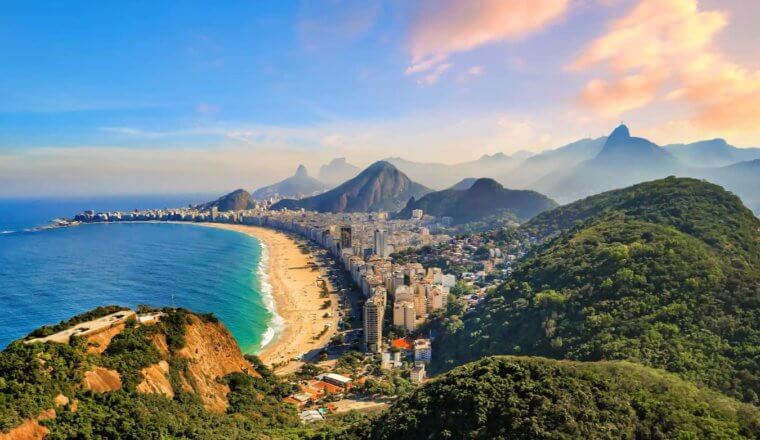
Is Brazil Safe to Visit?
Get your free travel starter kit.
Enter your email and get planning cheatsheets including a step by step checklist, packing list, tips cheat sheet, and more so you can plan like a pro!

- Where To Stay
- Transportation
- Booking Resources
- Related Blogs
- Meet the Team
- Work with Us
- Czech Republic
- Netherlands
- Switzerland
- Scandinavia
- Philippines
- South Korea
- New Zealand
- South Africa
- Budget Travel
- Work & Travel
- The Broke Backpacker Manifesto
- Travel Resources
- How to Travel on $10/day
Home » South America » Brazil » Backpacking Guide
The Ultimate Backpacking Brazil Travel Guide | 2024
Brazil is a country of extremes. The beaches are notorious, the cities are enormous, the nature is glorious – and that’s only scratching the surface.
While travelling in Brazil, I fell in love so quickly and deeply that I ended up staying for 3 years. I worked any job that I could get, hitched rides around the country, and couchsurfed like no tomorrow. And you’ll bet I pay a visit every time I’m back in my native South America.
The thing about this intense country is it’s a whole continent in itself. No seriously, this massive and incredibly diverse land does some magic and makes your experience so special. The biggest parties are always the most intimate, after all.
It has every potential to be full of surprises – the good and… not so good. So it pays dividends to get an idea of what you’re getting yourself in for, so you can flow with all the magical marvels .
In this backpacking Brazil travel guide, you’ll find all the information to prepare yourself for this impeccable country : the best places to visit, unique experiences, Brazilian culture, and how to do it all safely.
So pack your bags! Backpacking through Brazil is already shaping up to be a wild ride.
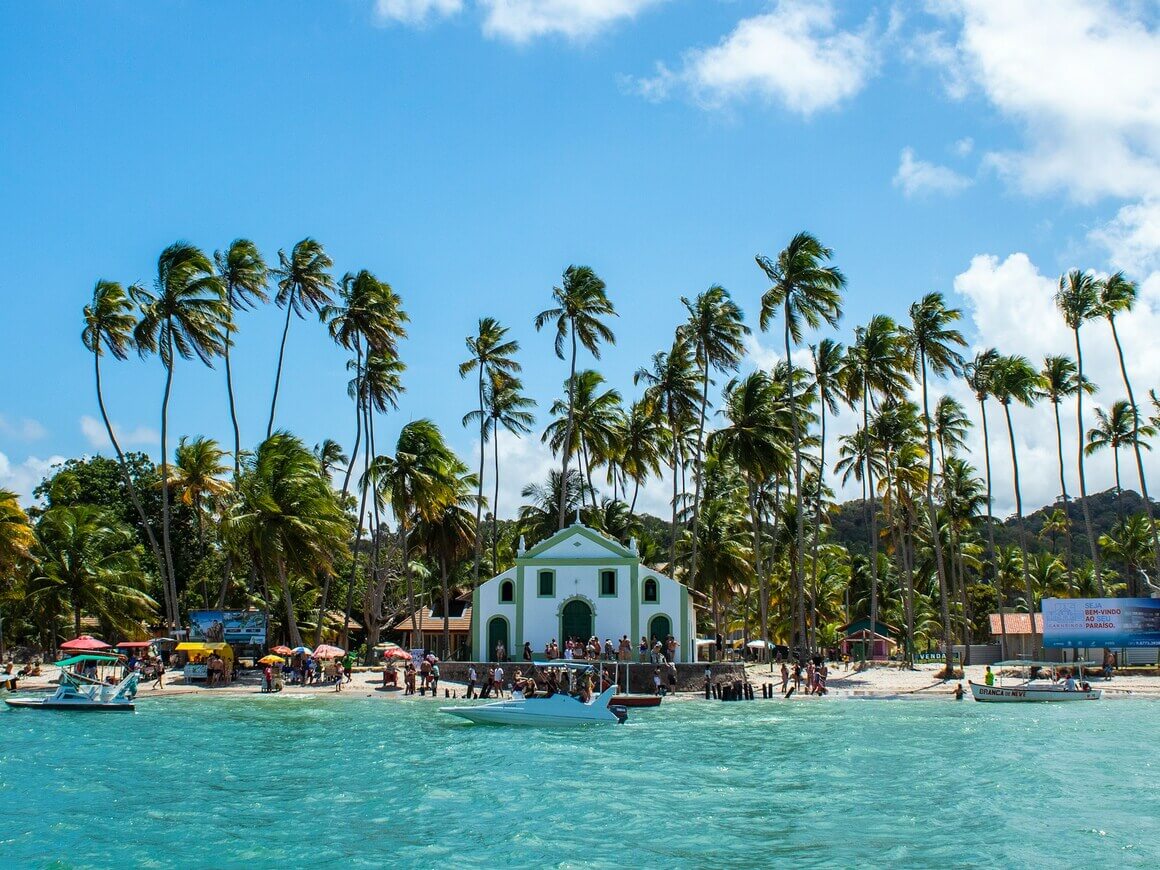
The Broke Backpacker is supported by you . Clicking through our links may earn us a small affiliate commission, and that's what allows us to keep producing free content 🙂 Learn more .
Travelling to Brazil soon?
Best travel itineraries for backpacking brazil, best places to visit in brazil, 10 top things to do in brazil, backpacker accommodation in brazil, brazil backpacking costs, best time to travel to brazil, staying safe in brazil, how to get into brazil, how to get around brazil, working in brazil, brazilian culture, some unique experiences in brazil, final advice before visiting brazil.
Save up to 42% on hostels for great-value adventures 😉
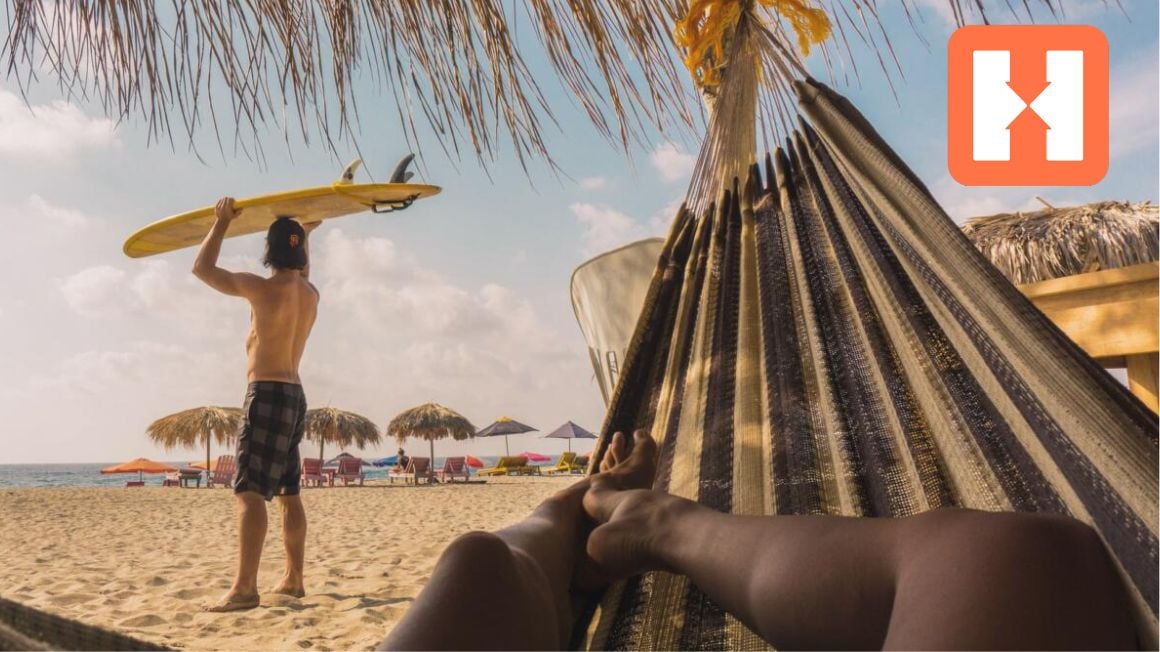
Book before June 5th to get the deals.
Why Go Backpacking in Brazil?
It’s no secret, Brazil is a huge country – the 5th largest in the world, in fact. The landmass covers almost half of South America. So backpacking South America isn’t really ticked off until you step foot onto the Brazilian side.
It’s hard to describe Brazil without sounding like I’m exaggerating. There is a huge diversity of life that only exists in this country. The landscapes are vast and distinct–there’s something simply magical about the terrain. Backpacking Brazil is one for the books. For starters, of course, you have the Amazon – no doubt you’ve heard of it.
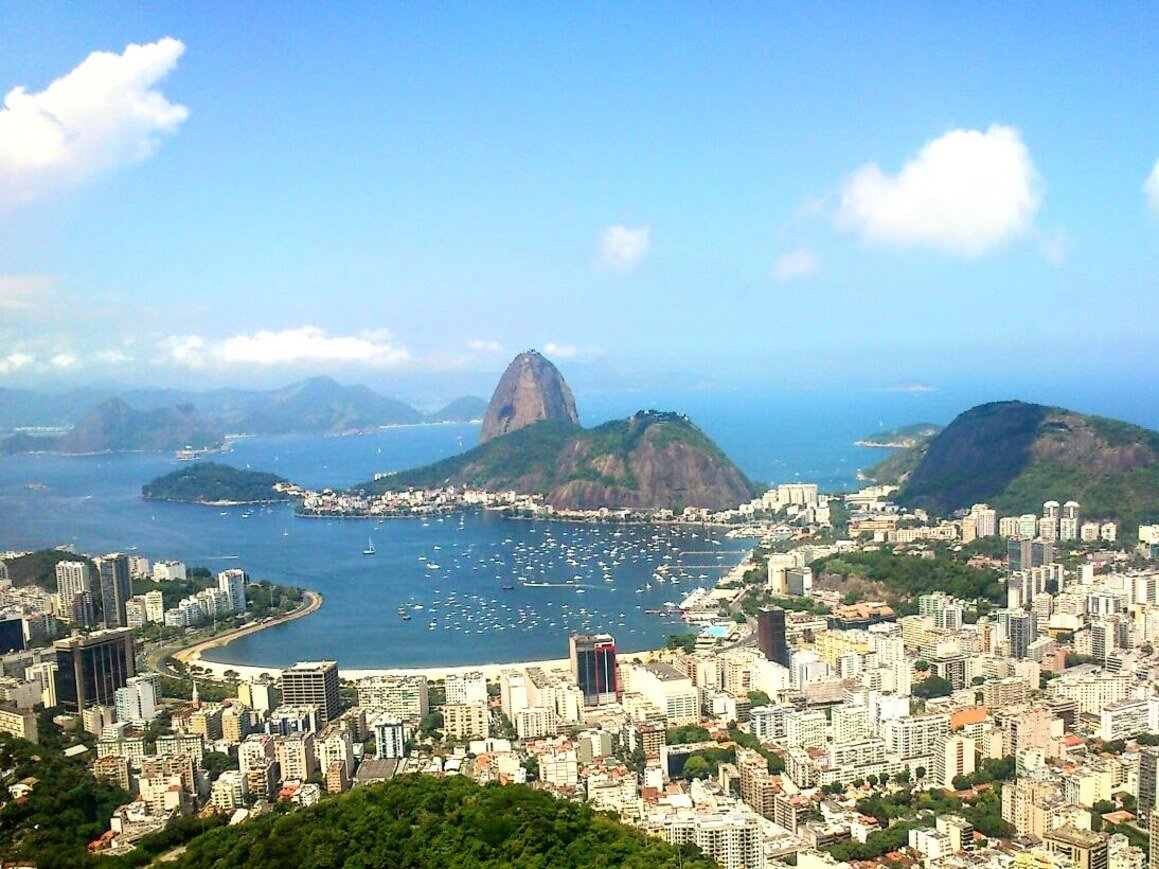
Mountains pierce through the land. Nature greets you every day with extreme life and climate. World-famous metropolises like Rio de Janeiro and São Paulo are only a speck within the cornucopia of possibilities that await you while travelling Brazil.
Nature is king here. Life literally grows on top of life.
The Brazilians have a particular kind of rhythm to their existence. They have an incredible blend of cultures that creates an intense, beautiful, and soulfully electric nation.
Even with a lifetime in this country, you couldn’t get around the whole thing. But with so much on offer, your trip to Brazil will be yours. From mad adrenaline heads to lazy beach bums, you can mold your travel route for Brazil into something unique.
These backpacking Brazil itineraries are here only as a guide . They’re going to outline some of Brazil’s main bases and top attractions. I’ve also included some not-so-well-known places.
But this is a massive country where I will actively encourage you to get off the beaten path. That’s where you’re going to find the secluded paradise beaches and the local hideouts – those magical spots that grab your heart and say “please don’t leave me, baby”.
Feel free to take these itineraries, do them frontwards, backwards, inside out, chew them up, and shove them up your arse. They’re just a guide.
Backpacking Brazil 2 Week Itinerary #1: The North
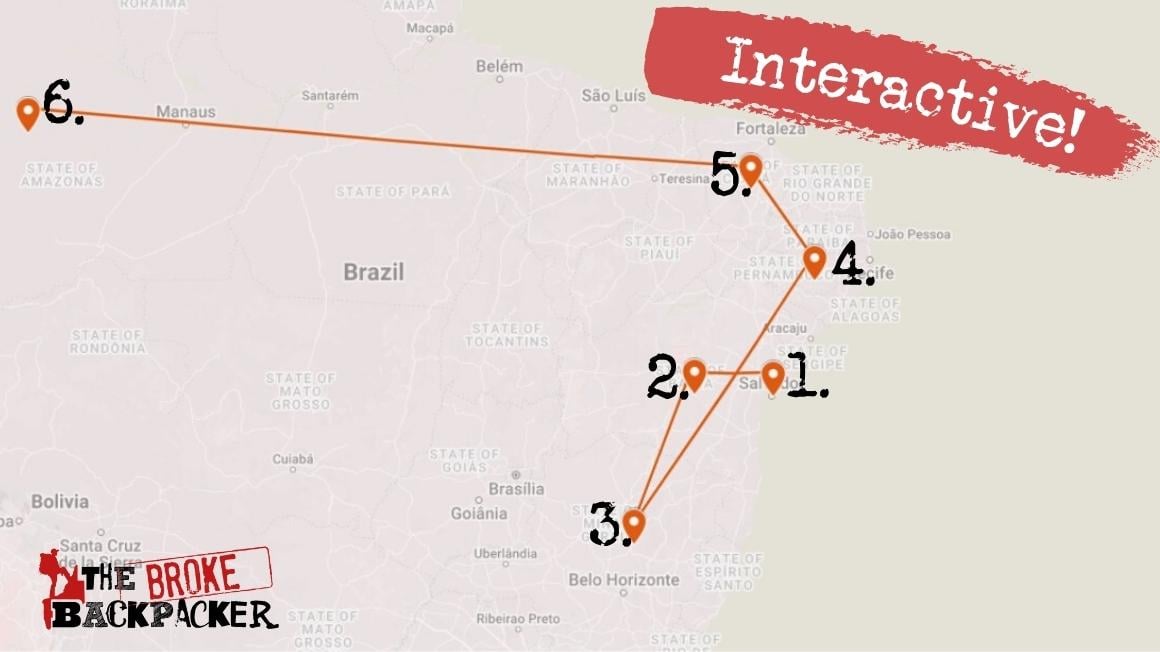
Ah, Northeast Brazil. Nature, humidity, and a whole lot of sand. If you’re a beach person, then you have to check out this area.
Start off this Brazilian backpacking route in Salvador de Bahia , and dive into the colonial history of the city. A quick trip out to Morro de São Paulo will get you started.
After Bahia, if you’re a hiker, head towards Chapada Diamantina and chase some waterfalls. Then circle back to Bahia and head north!
In the state of Pernambuco , check out Recife . Then get out of the city and swing by Pipa or Porto Galinha . Making your way north towards Fortaleza , where you’ll have a chance to stop in Genipabu and Canoa Quebrada along the way as well.
Be careful when you stop in Jericoacoara and Lençóis Maranhenses : you might never want to leave. These are some of the Northeast’s greatest destinations.
Your final stop will be the Amazon Rainforest . Charter a boat in either Manaus or Belém and cruise up the Amazon River in style.
Not enough beaches? Try combining this itinerary with Brazil travel itinerary #2 for the best beaches that Brazil has to offer.
Backpacking Brazil 1 Month Itinerary #2: The Southeast
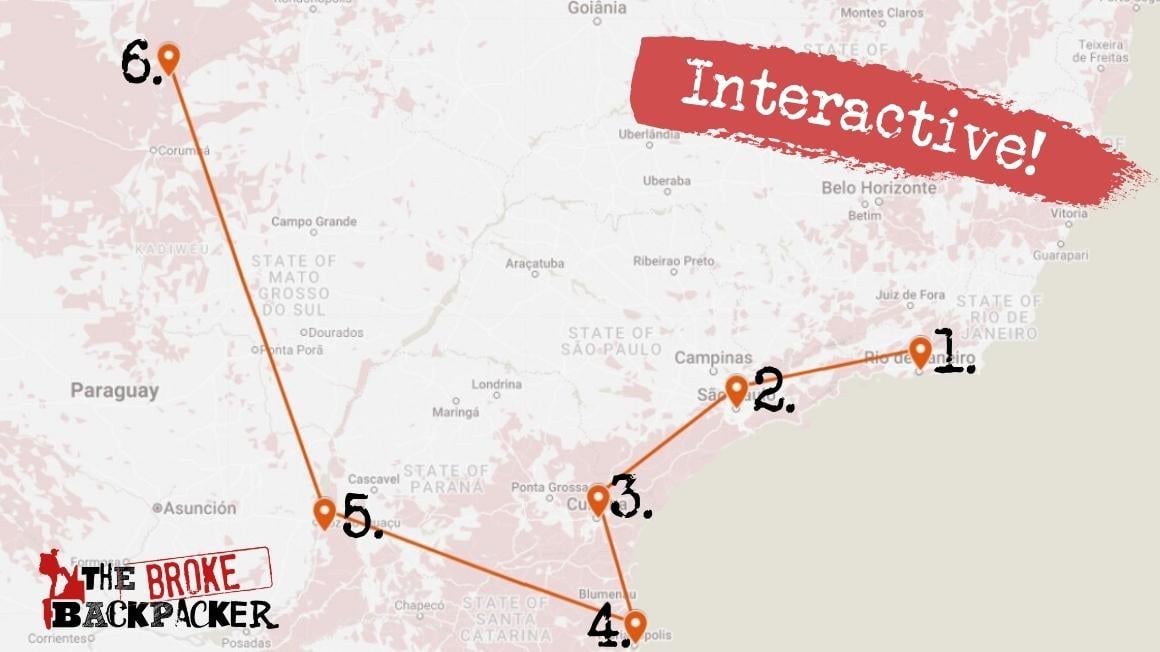
The southeast is home to some of Brazil’s most famous attractions! This 3-4 week itinerary will give you a taste of the big ones to backpack in Brazil. There’s a lot to see, so some backpackers may want to extend their trip.
This backpacking route through Brazil begins in glorious Rio de Janeiro . Chill in the city beach vibes, and don’t miss a night out in Lapa. If you have time (and a car) check out Bruzio, just up the coast. Home to beautiful beaches and epic Bruzio hostels .
Leaving Rio de Janeiro, you’ll travel along the coast and experience the Mata Atlântica . Experience the magical hidden getaways like Paraty and Ilha Grande .
The next stop is sprawling São Paulo . You have to experience the concrete jungle even just for a little while. The Pinheiros district makes a great party.
Exhausted after São Paulo and Rio de Janeiro? Of course, you are.
Head to Florianopolis in Santa Catarina to find paradise. Stop by Curitiba on the way there to decompress.
If you can drag yourself away from Florianopolis, head back to Curitiba and head to Iguaçu Falls . It’s a long bus ride, but it’s worth it to see this mighty waterfall. You’ll sleep in Foz de Iguacu , and visit the park from there.
Final destination is Mato Grosso do Sul and the Pantanal. Stay in Bonito and take day trips out to the wetlands to get your David Attenborough on.
Backpacking Brazil 6 Week Itinerary #3: History and Culture
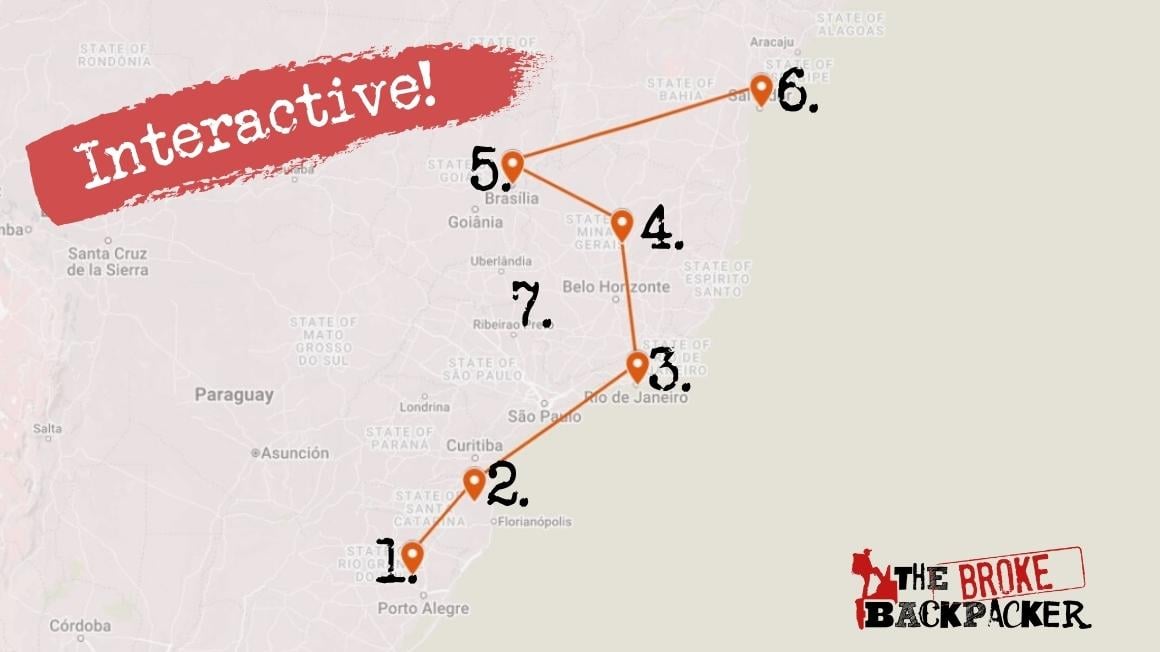
So we’ve seen beaches. We’ve seen cities. Now, on this 6-week Brazil travel itinerary, let’s deep dive into some culture and history.
Starting in Rio Grande do Sul , journey from Porto Alegre to the ruins of São Miguel das Missões . This UNESCO Heritage Site was a Jesuit mission founded for the salvation of the Amerindian locals.
From Rio Grande do Sul to Santa Catarina : the south of Brazil hosts one of the largest concentrations of European immigrants in Brazil. See the German settlement of Blumenau and the Italian Joinville .
After Santa Catarina, continue north to the once capital of imperial, Rio de Janeiro .
Over the passing years, Rio has kept up with whatever was contemporary. For this reason, Rio de Janeiro is a blend of different architectural styles. The city as a whole has been deemed a UNESCO Heritage Site for its harmonious relationship with nature, too.
Next stop is Minas Gerais . Check out the capital, Belo Horizonte , for some of the best food in Brazil. The mining towns of Ouro Preto and Diamantina are super interesting too!
Moving on from Minas Gerais and the past, we enter Brasília and the future. Brasília is Brazil’s new capital and is full of utopian ideals. Take a walk up the “fuselage” and imagine what the founders were thinking when they envisioned Brasília.
Finally, we head northeast and back to the origins of Brazil. Salvador and Olinda are both ground zero for Brazil as we know it today. You can’t miss the colonial architecture and plenty of history.
Backpacking Brazil 3 month Itinerary #4: The Brazil National Parks
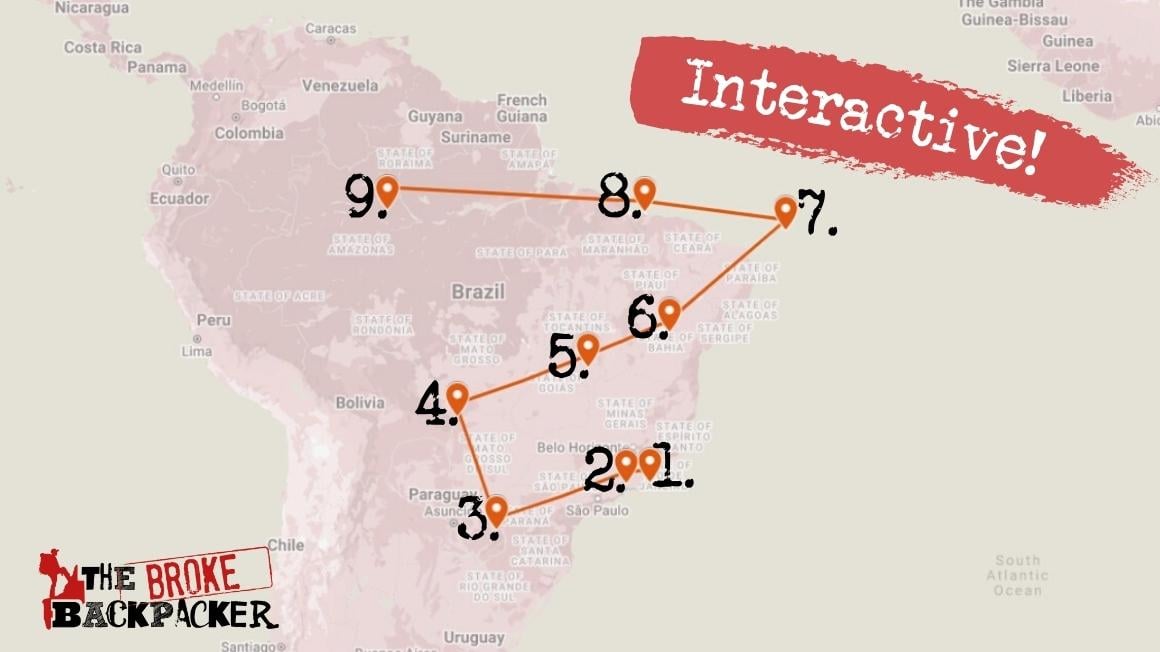
I couldn’t justify a backpacking Brazil itinerary without suggesting the national parks. This is definitely a side that few get to experience. But prepare yourself: this backpacking route is a long one!
Visit Rio de Janeiro and visit the parks of Serra dos Órgãos and Itatiaia . Órgãos offers lots of climbing. Itatiaia is meant for more conventional hiking, through the Mata Atlântica and Rio de Janeiro’s highlands.
Next, catch the long bus to Iguaçu Falls . It’s one of the most majestic sights in the world!
After Iguaçu, head north to the Pantanal for some wildlife and a chance to swim in the crystalline waters of the wetlands. Depart from Mato Grosso do Sul to Campo Grande and the northern Pantanal.
In Campo Grande, you will be able to visit the rugged highlands of Chapada dos Guimarães. Check out the awesome falls, and hike up to the top of São Jerônimo Hill for breathtaking views.
From Mato Grosso, head east towards the state of Goiás and Chapada dos Veadeiros . Swim in the rock pools and marvel at surreal geology.
Keep heading east from Goiás and arrive at Chapada Diamantina in Bahia. Trek around the canyons and discover secret grottos.
Leave Chapada Diamantina, and catch a flight in Salvador to the remote Fernando de Noronha . This is heaven! Trek around the islands and find beautiful beaches all to yourself.
Back to the mainland, bus it to the surreal Lençóis Maranhenses . Wander among the bleached dunes and take a dip in the cerulean pools during the rainy season.
Finally, the Amazon Rainforest , of course! Along the way, you’ll visit the Parque Nacional do Jaú , which offers classic amazonian experiences.
Your Brazil backpacking route is going to be an unforgettable ride – no matter which direction you head in! If I listed all the places I think you should see, we’re going to be here for a very… very long time.
So here’s the down-low on some of the top places to visit in Brazil. It wouldn’t be a legit backpacking Brazil travel guide without them.
Backpacking Rio de Janeiro
A cidade maravilhosa (the wonderful city) is a blessed place. Its actual name literally means “River of January”: Rio de Janeiro.
Upon first sight, you’ll feel as if that giant Christ statue on the hill was put there by God himself. There are so many things to do in Rio!
Rio is the capital of the state of the same name and is the most likely part of your travels. There are many interesting places to stay in Rio , and each neighbourhood has a different vibe.
The CBD ( Centro ) itself is fairly uninteresting, except for a few museums. The nearby districts of Santa Teresa and Lapa are more noteworthy. Santa Teresa is a lovely artist’s neighbourhood, and Lapa is where the party is.
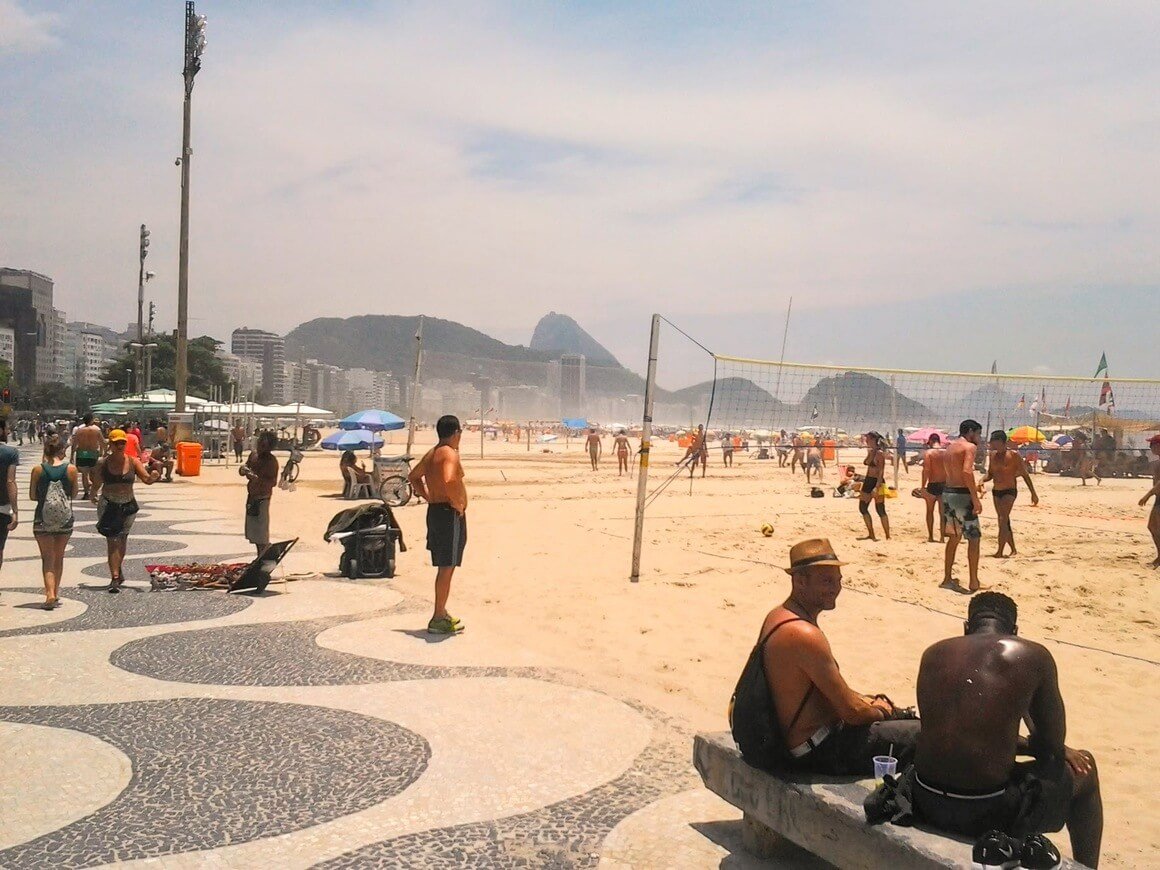
The real action is in the south of Rio, where the beaches are located. The best hostels in Rio de Janeiro are here too. Flamengo, Botafogo, Leme, Copacabana beach, Ipanema, and Leblon run back to back to one another and form a substantial strip of sand.
My personal favourite is Ipanema, which is the best beach by far. Be sure to hang around Posto Nove when you’re there.
Rio is infamous for its favelas or “shanty towns”. Some are pacified, and some are actively dangerous.
You can visit a favela, like Rocinha or Vidigal, but don’t go wandering into neighbourhoods you don’t know. Power among gangs is constantly shifting. A favela may be safe one month and a warzone the next.
Ilha Grande, Paraty, and the national parks are iconic. Paraty is an old colonial town that specializes in the distilling of cachaça (Brazilian rum). Ilha Grande is just beautiful beaches galore.
Backpacking São Paulo
If there’s one word to describe São Paulo it’s really f*ucking massive . Wait… that’s 3 words.
Nearly 20 million people live in this metropolitan giant. You’re in an ocean of skyscrapers, business centres, electric nightlife, and people just trying to make a life for themselves.
The best places to stay in São Paulo are the central and western districts. This is where you’re going to find the most exciting action as a visitor.
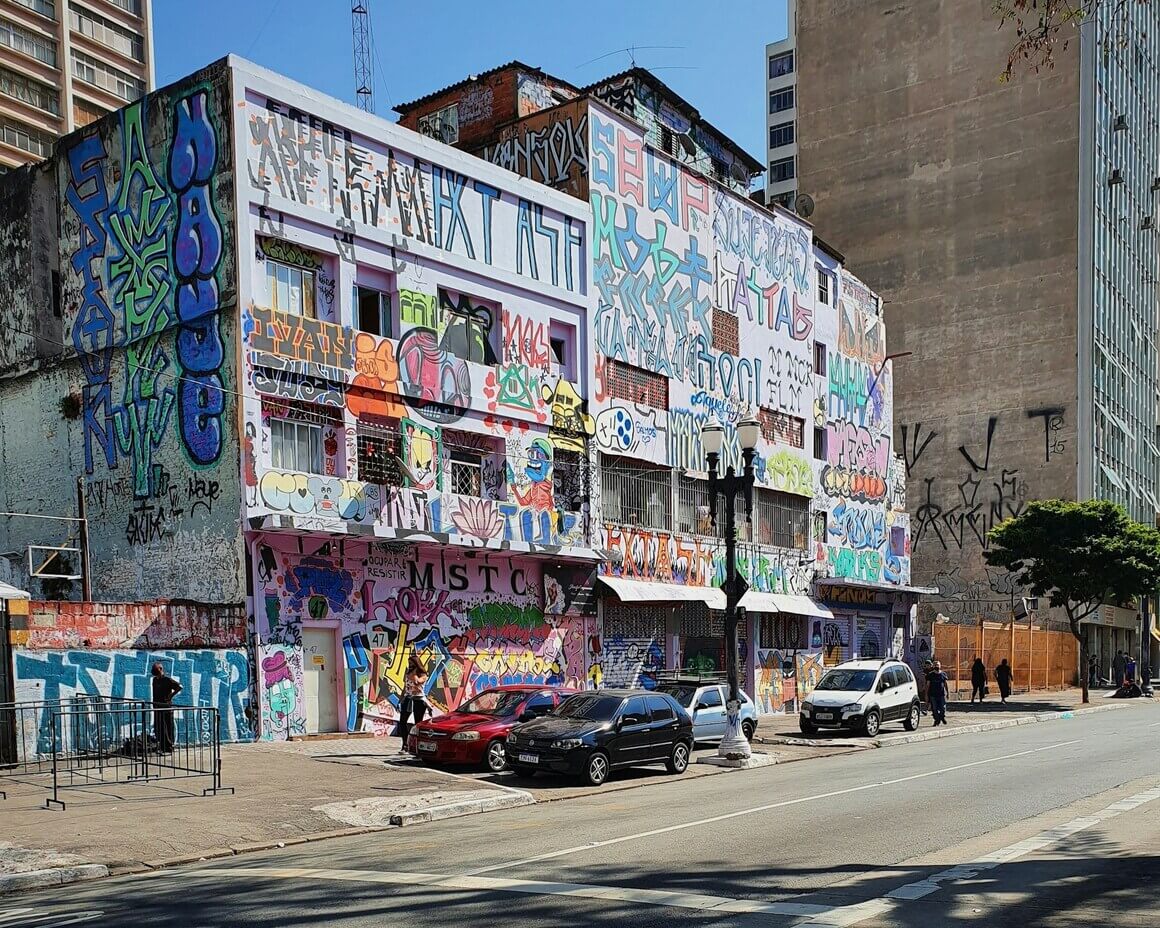
There is a big class divide between the very rich and the very poor, which can lead to Sao Paulo feeling unsafe . It can be a very intimidating place to visit, especially if you’re not a city person. But if you find your niche, there is a raucous social scene that awaits you.
People are very keen to express themselves in São Paulo. That means incredible art, soulful music, and lively nightlife.
Downtown Sampa is where you’ll find the baroque and neoclassical architecture. Check out Catedral da Sé, Theatro Municipal, and the Praça da República for examples of Sampa’s stylistic diversity.
Western District is a much newer, and more dynamic area of the city. You’ll find lots of São Paulo’s best hostels here.
Jardim Paulista is the fancy pants neighbourhood. Walk up Avenida Paulista, one of São Paulo’s most important throughways. Pay a visit to Sampa’s own Manhattan as well, which is conversely named Brooklin Novo .
A night in Vila Madalena and/or Vila Olímpia is an adventure, for sure: these neighbourhoods are magnets for the young, the successful, and the passionate. Hell, anyone with a beating heart goes out for a good time. Expect more pubs in the former, and clubs in the latter.
If it’s a choice between São Paulo or Rio de Janeiro , we would pick Sao Paulo, hands down!
Backpacking Paraná
So if Rio de Janeiro and São Paulo sound a bit bloody intense – I don’t blame you. Enter: Curitiba, the capital of Paraná.
This laid-back, modern major Brazilian city is a fine example of places we could be seeing more of in the future. It’s recognised as one of the most innovative cities in the world and has one of the highest standards of living in Brazil.
The city of Curitiba is a stark contrast to the rest of Brazil: composed, generally safe, and it can even get chilly – hey, maybe even snowy!
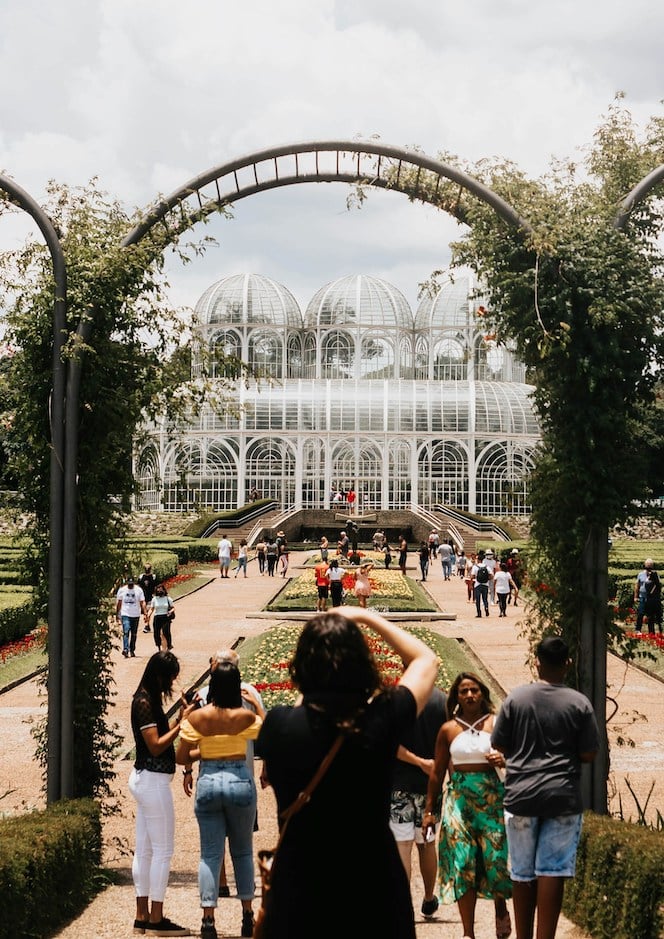
Curitiba is abundant with lush public spaces. The blossoming Jardim Botânico is Curitiba’s pride and joy and resembles most gardens of French royalty. Barigüi Park , Barreirinha Park , and the German Wood are the places to wind down and watch the world go by.
Although lovely, you only need a few days in Curitiba. The rest of Paraná has a similar vibe and won’t let you down if you decide to explore the beaches or more inland here.
Once you travel this far south, you will notice that things begin to look increasingly European. Southern Brazil is where the vast majority of Europeans settled – German and Italian being dominant heritages. As well as the aesthetics of the big cities, notice how the culture and features of the people change.
Backpacking Santa Catarina
Santa Catarina is one of those places that’s definitive of Brazil. You could stop anywhere on the coast of Santa Catarina and find incredible beach hideouts. The state is the definition of ‘natural beauty’.
People talk about Florianópolis like it’s some made-up universe. When, in reality, it’s even better. As soon as you drive over the bridge onto the island you’re already changing your plans to figure out how you can stay as long as possible.
Life in Floripa is very easy: pristine beaches, a relaxed pace of life, and that holiday feel 24/7. The best places to stay in Floripa are… everywhere. Though, there are certain areas that cater to different interests.
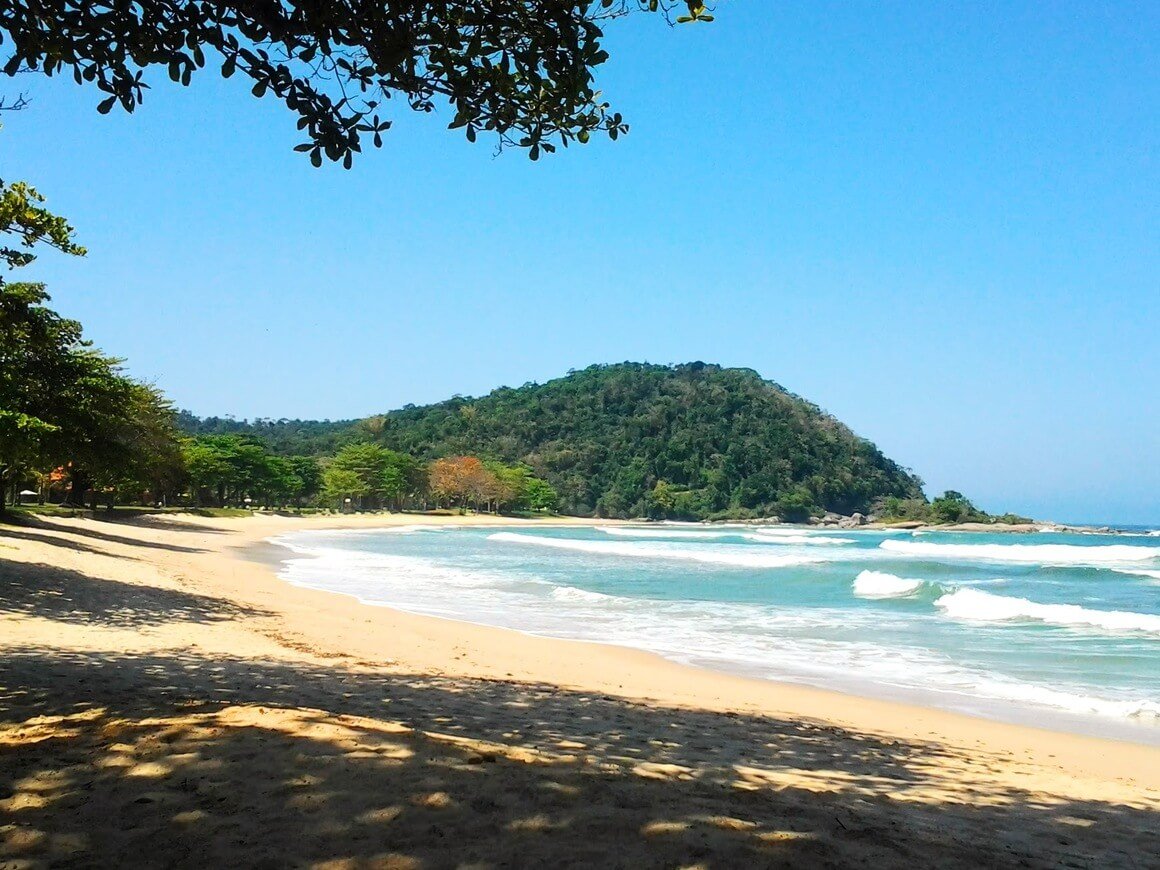
Central Florianopolis is nothing more than a little central hub. Take a bus here and get yourself out.
Northern Floripa is more resort-y and houses the island’s most popular nightclubs. South, towards Barra da Lagoa , things become less upscale.
Barra is more laid back and where you’ll find the most backpacker hostels in Floripa . Nearby Praia Mole is a popular surfer’s beach.
The far south of Floripa is totally undeveloped. If you enjoy a hike, you can find beaches that are literally abandoned because they require a trek to get to. Lagoinha do Leste is a stunning example of this phenomenon of untouched, hidden shores.
Outside of Florianópolis, check out the party city of Balneário Camboriú . World-famous Warung Beach Club and Green Valley are located just outside.
Joinville is the largest city in the region, and is predominantly Italian. Blumenau is a city of German heritage that hosts the world’s second-largest Oktoberfest.
Backpacking Bahia
Ask Brazilians where the “real” Brazil is, and they’ll most likely say “Salvador de Bahia.” Salvador is the capital of the state of Bahia and the former capital of the original Portuguese colony. The city is a treasure, filled with remnants from the days of colonialism and stories of Brazilian independence.
First: the touristy stuff. The historical district, called the Pelourinho is a bit of a tourist trap but still worth visiting. Be sure to see the important religious sites as well – the Cathedral Basilica of Salvador, Nossa Senhora do Rosário dos Pretos, and Nosso Senhor do Bonfim.
Don’t miss the sunset at the Baía de Todos Santos . Take to the promenade or ride the Elevador Lacerda for the best view.
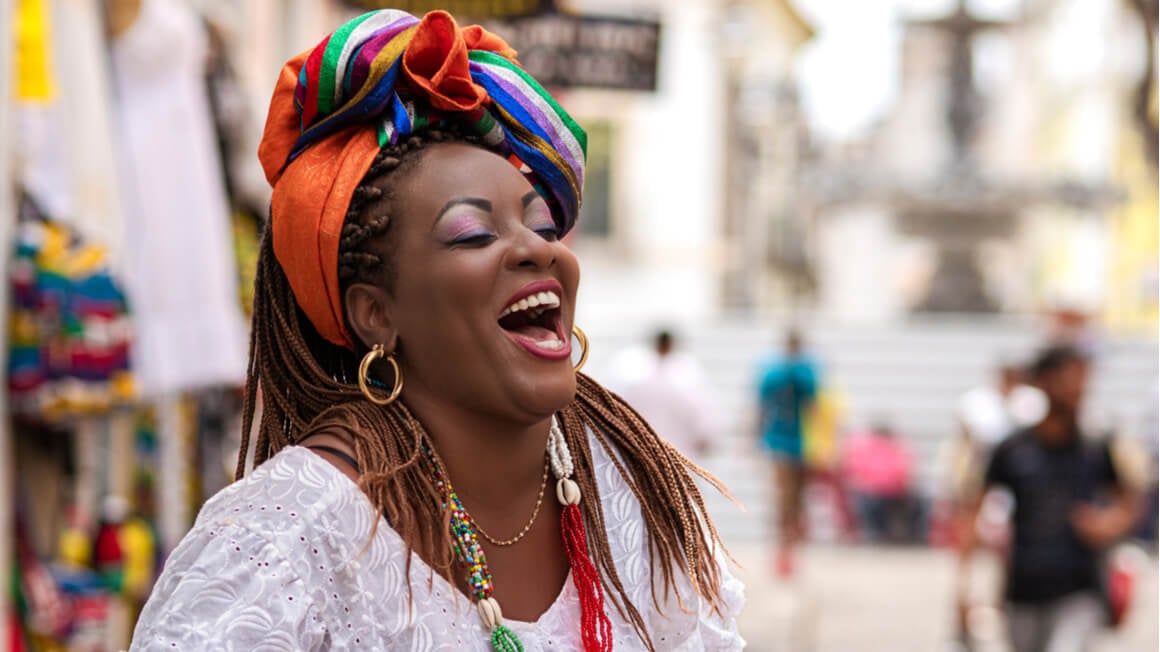
Salvador hosts the world’s largest Carnaval celebration! Every Carnaval is different, but Salvador’s Carnaval tops even Rio’s and Recife’s. (Am I biased? Maybe.)
If you’re planning on going to this event (and you definitely should) the best hostels in Salvador book up fast. So plan ahead!
Bahian Carnaval is arranged in a giant parade. Floats and trucks troll the streets all night long surrounded a sea of dancing.
Each truck forms a bloco , which is separated from the others by a rope that encircles the crowd. The effect is a giant, moving dance floor, forming the world’s largest street party!
Outside of Salvador, you’ll find plenty of natural beauty. Morro de São Paulo and Itacaré are both wonderful beaches. Locals and tourists alike flock to these to relax and escape madness.
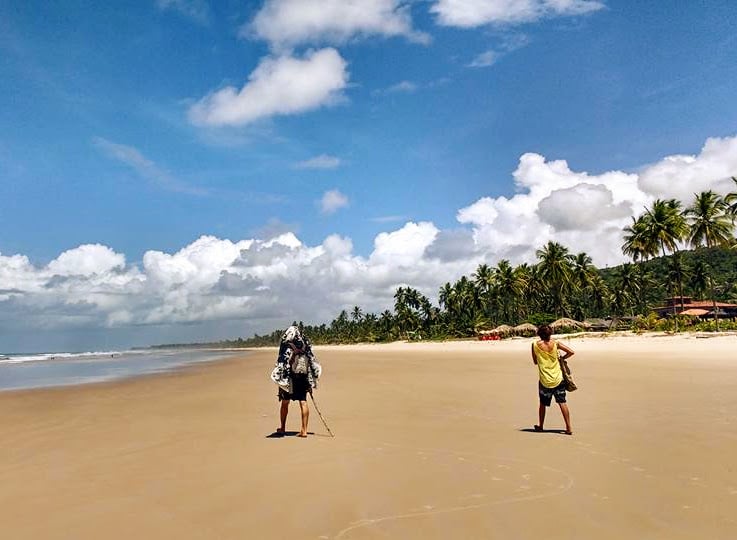
Also worth seeing is Chapada Diamantina to the east of Salvador. This national park is one of Brazil’s outdoor jewels and is worth visiting for a couple of days. Check out the trekking section for more on that!
Backpacking North East Brazil
You’re in Northeastern Brazil now. Here, the climate and culture are distinctly different from the south of Brazil. Like Bahia, the ethnicity is predominantly African, the sun is almost always shining, and the beaches are abundant.
I’d love to speak about each of the northeastern states individually, but for the sake of time, they’re combined into one section. Most of these states will offer similar experiences. I’ll point out certain exceptions along the way.
Pernambuco and its capital Recife are the first stops. It’s one of the most historically significant cities in Brazil. Plus there are some incredible hostels in Recife !
The Old City and nearby Olinda are wonderful examples of Dutch and Portuguese Colonialism. Streetwalkers will notice the many canals that weave throughout the city as well.
The locals have dubbed their city Veneza Brasileira (Brazilian Venice) because of these waterways. The city beaches of Recife are also fantastic.
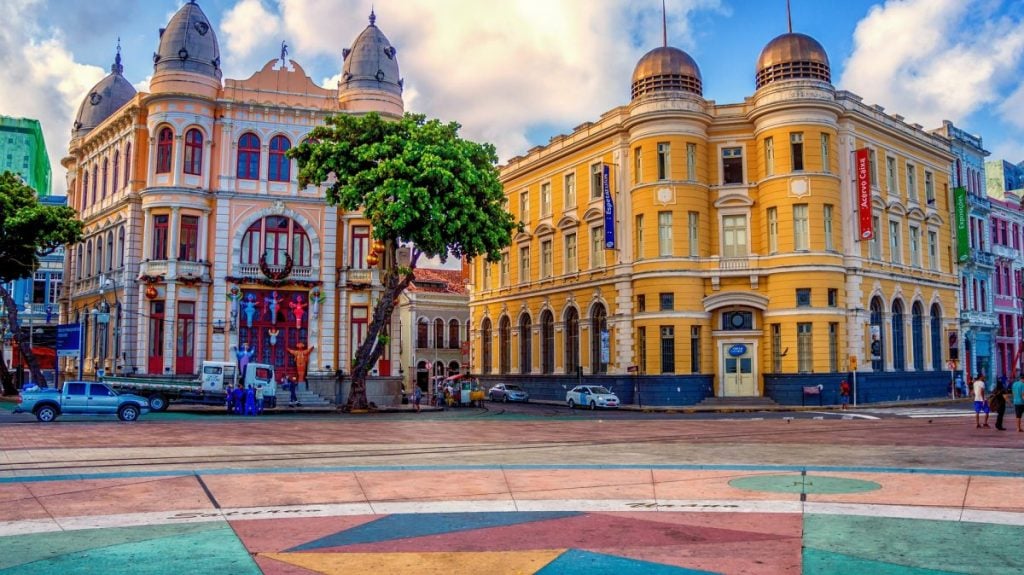
Outside of Recife, there are lots of beach towns to check out. Porto Galinhas, Itamaracá, and Cabo de Santo Agostinho are wonderful examples.
Next up is Natal and the state of Rio Grande do Norte . Natal is a more laid-back city than Recife.
The economy of Natal developed more slowly than the rest of the north east. What it lacks in vibrancy and historical significance, it makes up for with a higher quality of life and public safety.
The beaches surrounding Natal are some of the best in the north east. Pipa and Genipabu are loved dearly by Brazilians, for (what else?) the perfect sand and water.
When you’re ready, create your own adventure in the other states: Sergipe, Alagoas, and Paraíba.
Backpacking Jericoacoara
The beach. The myth. The legend. Jericoacoara.
For many unknown reasons, Jericoacoara is the promised land for backpackers and hippies. I’ve known many people backpacking Brazil who have travelled north based only on a rumour. Upon arriving and discovering that this El Dorado does indeed exist, they quickly disappear into the depths of its pleasures.
The fame of Jericoacoara isn’t undeserved though. Time is non-existent. The streets are too – just white sand and stones.
People lounge in hammocks that rise picturesquely out of the shallows. Ah, Paradise.
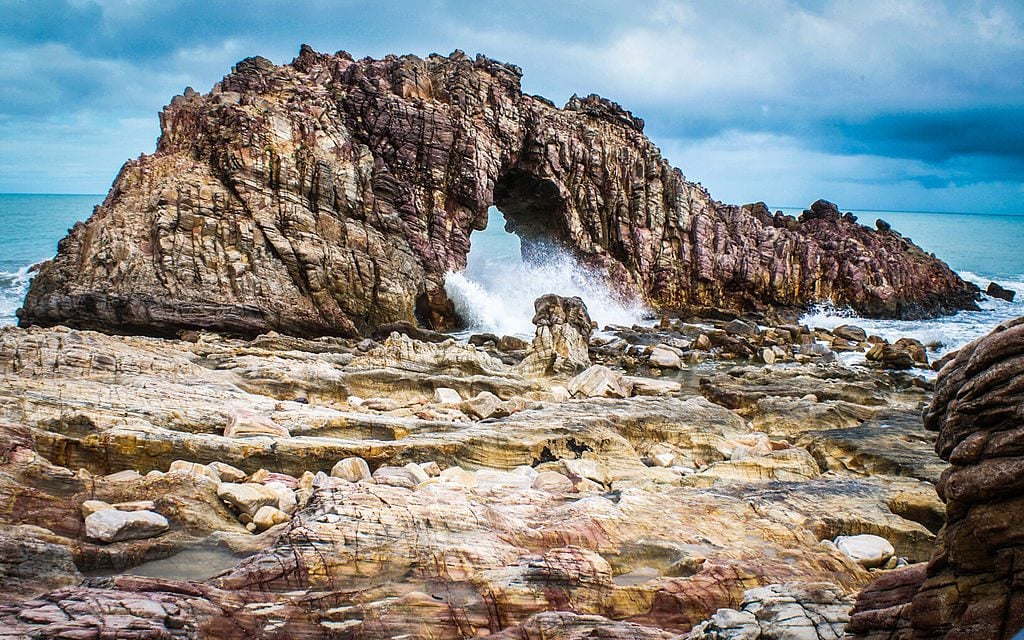
Kitesurfing is famous in Jericoacoara. If you’re not fancying that, there’s a whole lot of bumming around to do. You can walk the nearby National Park and the Pedra Furada – a half-day is sufficient for both.
Those wanting to visit Jericoacoara will most likely pass through Fortaleza, the capital of Ceará , the last big city in Northeastern Brazil. Fortaleza is not quite as clean as Natal, and not quite as rich as Recife. It’s a bit behind in many ways, but it still has its charm.
The performing arts – specifically comedy, and a local dance style called forro – are strong in Fortaleza. Nightlife is also booming, but do it safely.
Backpacking Iguaçu Falls
Iguaçu Falls is not to be missed! It is truly one of the most awe-inspiring sights in the world.
Iguaçu Falls is composed of nearly 275 falls that range between 200 and 270 ft in height. It is the world’s widest waterfall, and probably the most engrossing.
There are walkways that put you literally in the middle of the canyons where you’ll be surrounded on three sides by waterfalls. You will get wet, and you will love it.
Iguaçu is actually split between Brazil and Argentina: it’s one of the best places to cross the border to go and backpack Argentina too. So go ahead and see if from both sides!
The Brazilian side skims the edge of the falls and gives a better panoramic view. The Argentinian side traverses the top of the falls and gives a more up-close and personal experience. From the Argentine side, you get to stare down into A Garganta do Diabo (The Devil’s Throat), which is pretty fucking cool.
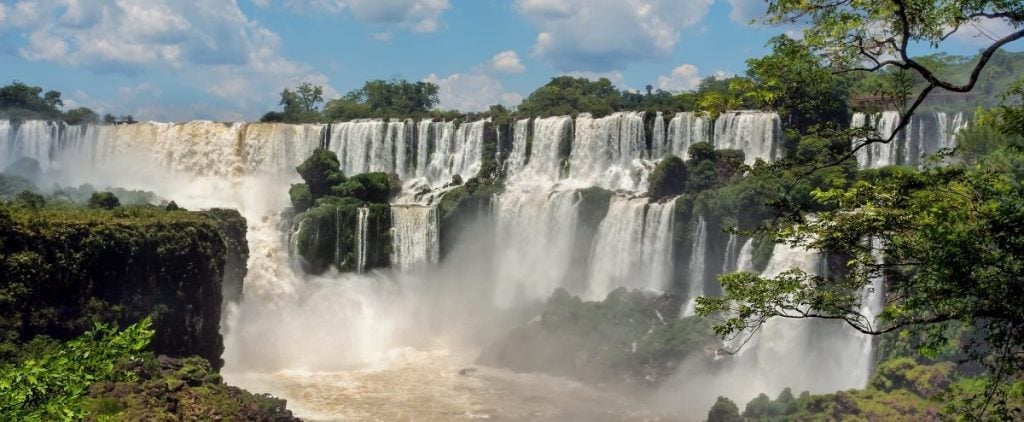
There’s a hot debate about which side is better. But we’re backpacking Brazil here… So it’s definitely Brazil, obviously.
Accommodation wise, you’ll be staying in the sleepy town of Foz do Iguacu . The town pretty much serves only as a gateway for the falls. Find the right hostel though, and your stay could be a lot of fun.
Backpacking Pantanal
The Amazon isn’t the only place where you can spot wildlife in Brazil: in the south of Brazil, there is the Pantanal wetlands. The Pantanal is actually considered the biggest freshwater ecosystem in the world.
The chances of seeing animals are huge here; reportedly even better than in the Amazon actually. Local wildlife include capybaras, giant anteaters, rheas, jaguars, and lots more!
Given its size, there are several ways to access the Pantanal. The two most popular entryways are via Cuiabá of Mato Grosso , and Campo Grande/Bonito in the southern state Mato Grosso do Sul . Those coming from Iguaçu Falls will probably find Campo Grande more convenient.
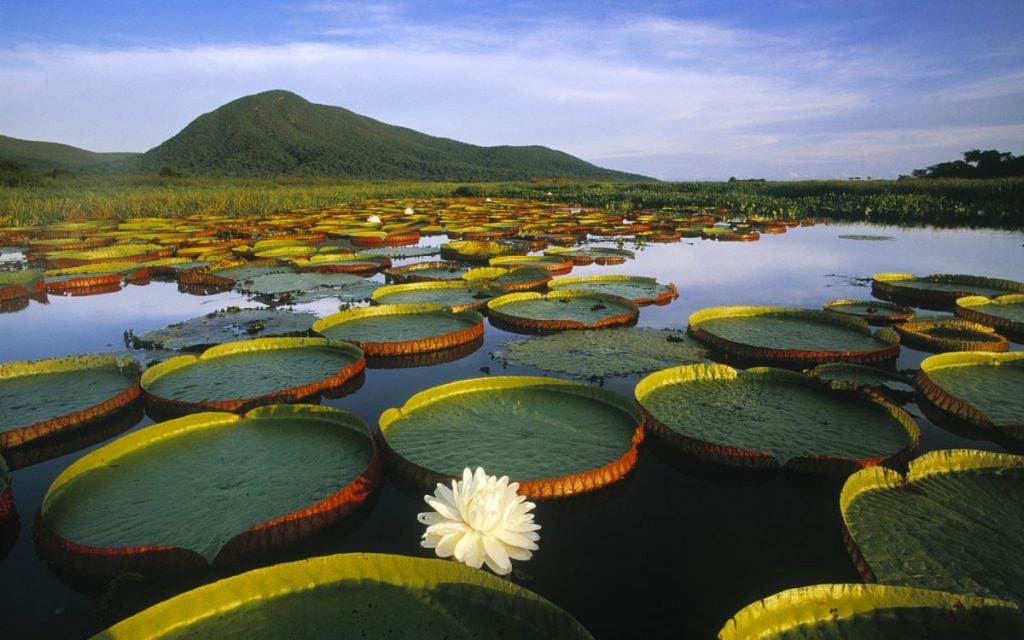
Campo Grande is a large, modern city that is well-known for its cattle industry. Visit a local churrascaria for some intensely delicious barbecued meats.
Though Campo Grande gives access to the Pantanal, the real jewel is Bonito . Bonito is an eco-tourist destination that offers way more activities. Snorkel in the crystal clear Rio da Prata or visit one of the local caves to have your mind blown by the blue views.
Cuiabá is a small but vibrant city and very close to northern Pantanal. There’s actually a road, the Transpantaneira Highway, that runs directly into the Pantanal from the city. Motorists will have lots of opportunities to see breeding and feeding grounds on the side of the road.
Cuiabá is also a very convenient base to explore the nearby national park, Chapada dos Veadeiros . Veadeiros is a stunning area known for its ecological diversity, unique geology and stunning landscape. Rent a car in Cuiabá and visit both the park and the Transpantaneira in a few days.
Backpacking The Amazon
The Amazon Rainforest is tied with beaches as the most recognizable feature of Brazil. The Amazon is the largest rainforest in the world.
There are reportedly over 400 billion individual trees there. That is more than fifty times the world’s human population.
Navigating such a large area can be daunting but your main gateway is going to be Manaus. Belém is sometimes considered a jumping-off point but it’s far east and closer to the coast. A boat trip from Belém to Manaus may be worthwhile to some, as trips are quite lazy and chill.
From Manaus, you can charter a boat to take you up the Amazon River. While cruising the river, keep an eye out for all of those critters you grew up reading about – the pink river dolphin, three-toed sloth, and piranhas! The nearest national park is called Jaú , and it’s located very close to Manaus.

You might want to try Ayahuasca while visiting the Amazon. This traditional and powerful hallucinogenic medicine has long been used to treat post-traumatic stress disorders, depression, and addictions. I strongly recommend you find a reputable Shaman or join a healing lodge to appreciate this sacred ceremony.
Adventurous folk can ride the rivers all the way to the borders of Colombia or Peru. Heading towards the former on the Rio Negro , backpackers will have the chance to stop and see Pico da Neblina . Neblina is the highest mountain in Brazil and has a very distinct profile.
Backpacking Minas Gerais
Some people swear by Minas Gerais and its capital, Belo Horizonte , as the best city in Brazil though. It has a stunning example of nightlife in Brazil.
Belo Horizonte is the “bar capital of Brazil”. Thousands – twelve thousand, if you believe the local reports – of bars line the city streets, and every night they fill up. Locals come to shoot the shit and touch glasses.
The scene is a striking contrast to the hedonistic revelry found in Rio and Sampa. Drinking aside, Belo Horizonte is also where you’ll find the most farms and, therefore, the best food in Brazil.
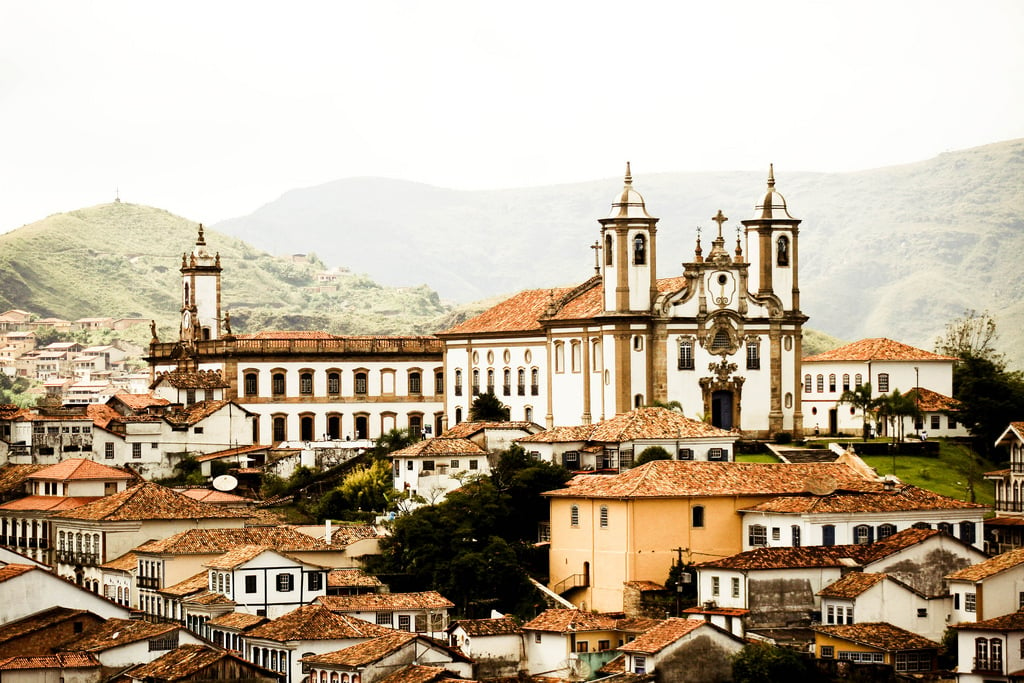
Minas Gerais is also famous for its colonial towns. Most are remnants from the days when the state was a center for the mining industry. Painstakingly preserved, these villages are a lovely journey back in time.
Ouro Preto is probably the most famous of these villages. Tiradentes and Diamantina are also worthy destinations.
Off the Beaten Path Travel in Brazil
In a country that’s bigger than Europe, you can imagine there are a plethora of places off the tourist trail . This is one of my favourite things about Brazil: you have every opportunity to make a route that no one else has made before. With a little patience, you can get pretty much everywhere.
And you should! Because off the beaten path, nature comes incredibly intimidating, culture is shocking, and food tastes delicious.
The federal capital of Brazil is Brasília . It’s a bit out of the way but if you’re interested in architecture and/or Brazilian politics then it’s a must-see. If you’re not into those things though, you can happily skip over Brasília.
Most backpackers don’t even consider the most Southern Brazil, Rio Grande do Sul . It’s a shame: Porto Alegre is one of my favourite cities in Brazil.
It’s a quiet place with a high standard of living but there aren’t many attractions. So why visit Rio Grande do Sul? Because the people are downright beautiful – that’s why.
Aparados da Serra is a cool canyonland to the north of Porto Alegre with lots of hiking. To the west, São Miguel das Missões is one of Brazil’s most important heritage sites.
The state of Maranhão gets little attention compared to it’s southeastern neighbors. But this state has one BIG thing going for it: Lençóis Maranhenses National Park. This surreal park mostly consists of bleach-white sand dunes.
During the short rainy season (May-September) the dunes fill with rainwater and small, landlocked lagoons form. It’s a surreal experience; elegant sheets of sand ( lencois means “bed sheets” in Portuguese) are painted with the cerulean colors of the lagoons. The scene definitely resembles a painter’s easel.

We’ve tested countless backpacks over the years, but there’s one that has always been the best and remains the best buy for adventurers: the broke backpacker-approved Osprey Aether and Ariel series.
Want more deetz on why these packs are so damn perfect? Then read our comprehensive review for the inside scoop!
1. Party at Carnaval, of course!
Be a part of the biggest party on Earth and one of the most famous festivals in the world ! Nearly the entire country shuts down for a week while everyone gets their last kicks in before Lent at Brazil’s biggest festival .
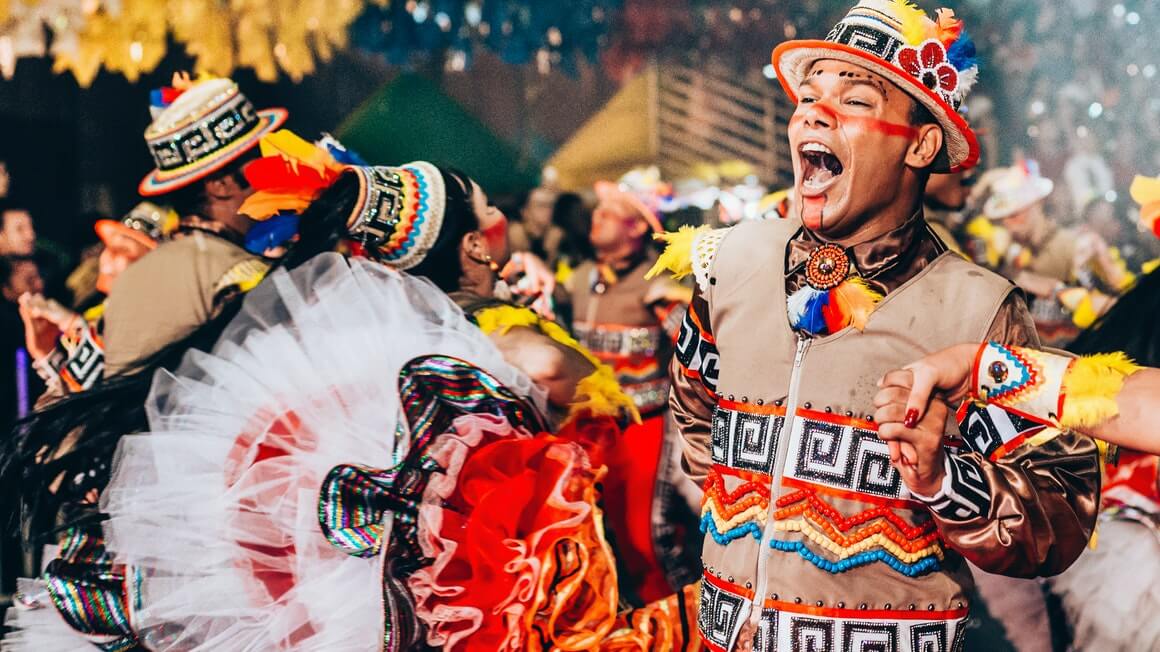
2. Learn Portuguese
Portuguese is a gorgeous language. Stick around the country for a while and learn a bit of it. You’ll be one of the locals in no time.
3. Check out the National Parks
Brazil’s beaches get all of the attention, but its landscape is just as spectacular! Visit one of the national parks and see a more rugged side of the country.
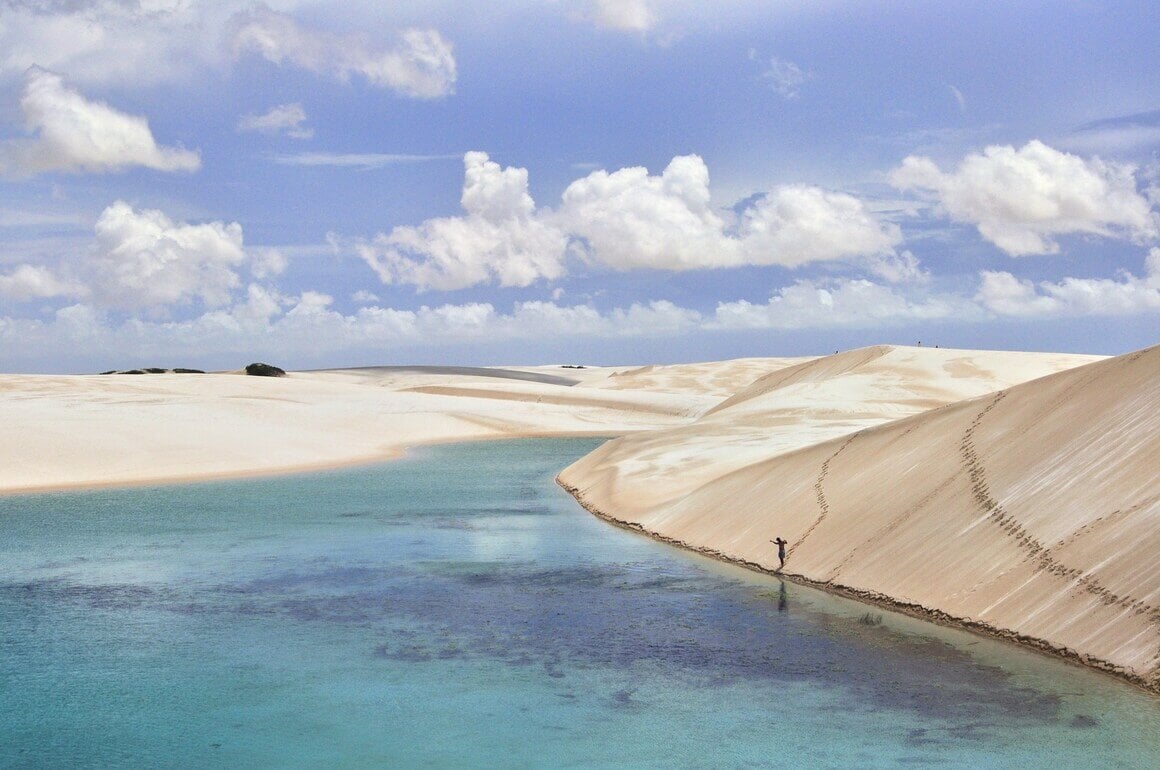
4. Fall in Love
Brazilian people are some of the most beautiful in the world! So if you’re ready for your story of love and sex on the road to unravel, this is definitely a place you won’t ever forget. You’d have to be an amoeba to not feel a little flushed around these intoxicating people.
5. Play on the Beach
Brazil has more than 4,600 miles of coastline! Go surfing, swimming, play volleyball, and smoke a nice joint while soaking in that vitamin D.
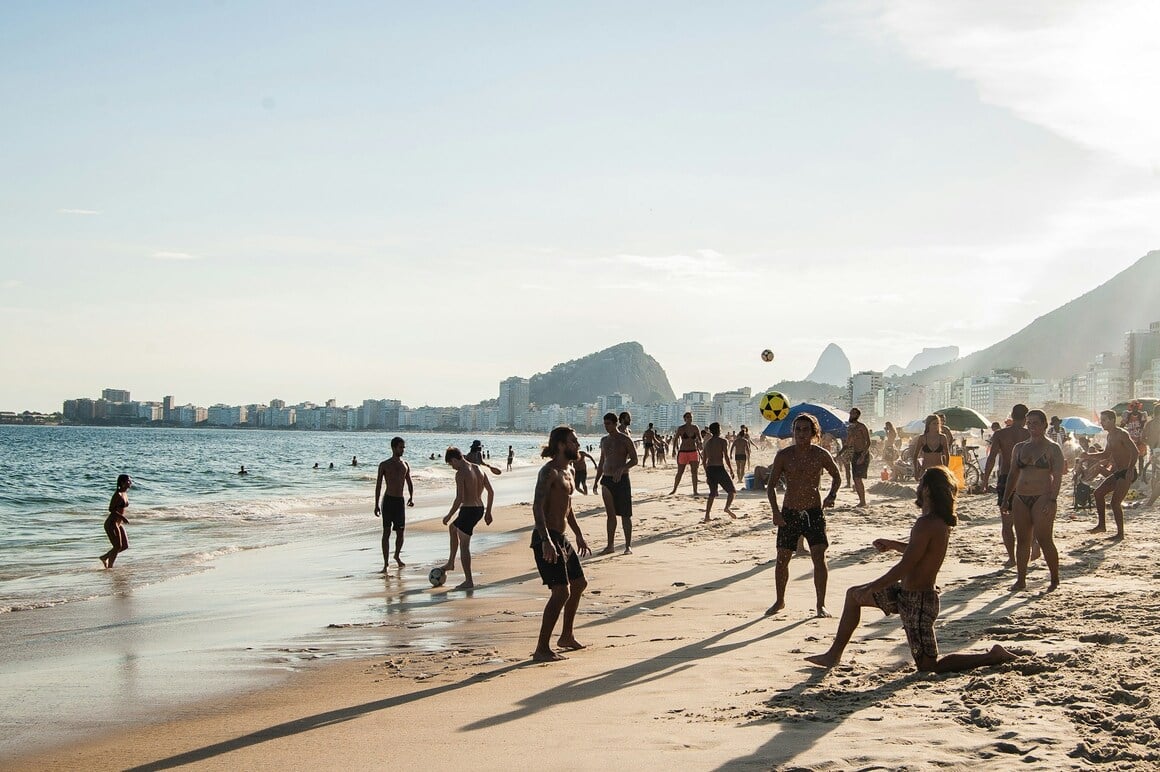
6. Get stuck somewhere
You know when you travel somewhere and all of a sudden you get that intense sense of belonging? Like you just never want to leave? Yeah… that’s pretty much Brazil in a nutshell.
So plan accordingly. Leave some time for those places that just steal your heart.
7. Watch a football match
In case you weren’t already aware, Brazil is football crazy! Sometimes a little too crazy, but that is what we want, isn’t it?
You don’t even have to necessarily go to a football game either. You’re probably going to see amateurs around and about; they’ll play basically anywhere. They’re very used to passersby stopping to catch some of the game too. So when you’re not in a hurry (who’s in a hurry?) stop to see how Brazilians become the word champions time and again.
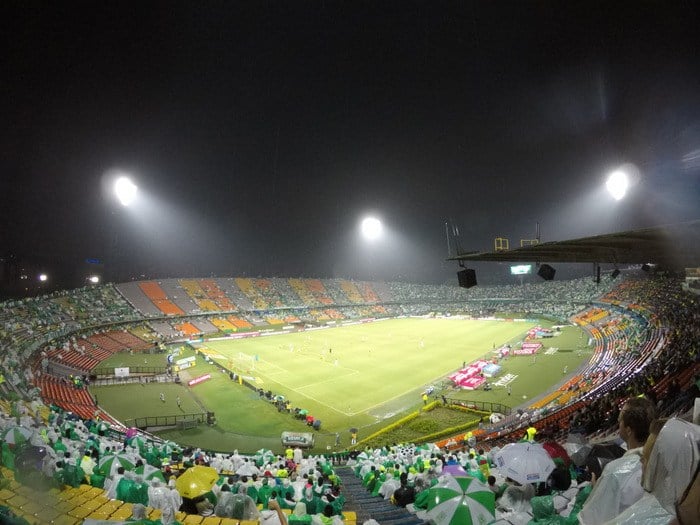
8. Visit the Amazon or Pantanal
No doubt, you know that Brazil is home to the world’s largest rainforest. You’ve been hearing stories about this mystical place since you were a kid. Finally , you can experience it for yourself.
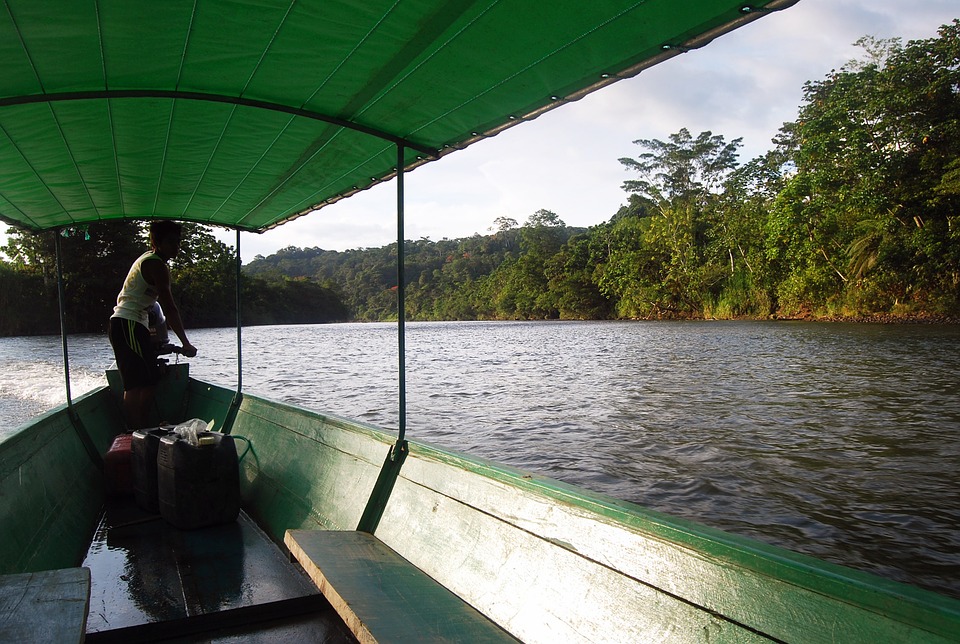
As well as the Amazon, Brazil also houses the largest wetland in the world, Pantanal! Between these, you can imagine all the incredible and unique wildlife that thrives.
9. Be humbled by Iguacu Falls
There are few sites in the world that are as mighty as Iguaçu Falls! Feel the power as tons of water spill over the edge and into the void.
10. Get out of the city!
Look, I know Brazil is famous for these insane big cities. But if you think that the culture is famous in major Brazilian cities, like Rio de Janeiro, imagine the extent of the culture outside of it. That’s where you’re going to find all the real food, music, parties, and general life.

Wanna know how to pack like a pro? Well for a start you need the right gear….
These are packing cubes for the globetrotters and compression sacks for the real adventurers – these babies are a traveller’s best kept secret. They organise yo’ packing and minimise volume too so you can pack MORE.
Or, y’know… you can stick to just chucking it all in your backpack…
Brazil hostels are lively places and very common. Only in the most remote places will you need to resort to some other form of accommodation.
A good hostel should run you about $10-$15 in all of the major cities. You could find a bed for less than $10, but I would never pay more than $15 unless forced.
Many of the lesser-visited destinations – the beach towns, and especially the northeastern cities – are usually cheaper. It’s also where you’ll find some of the world’s most stunning hostels .
Pousadas are common. Essentially, a pousada is a local guesthouse; local vibes, cool people, and lots of options for all budgets.
Note that accommodation is subject to seasonal rates . This trend is very noticeable when backpacking Brazil. Rates could double or triple based on the time of year.
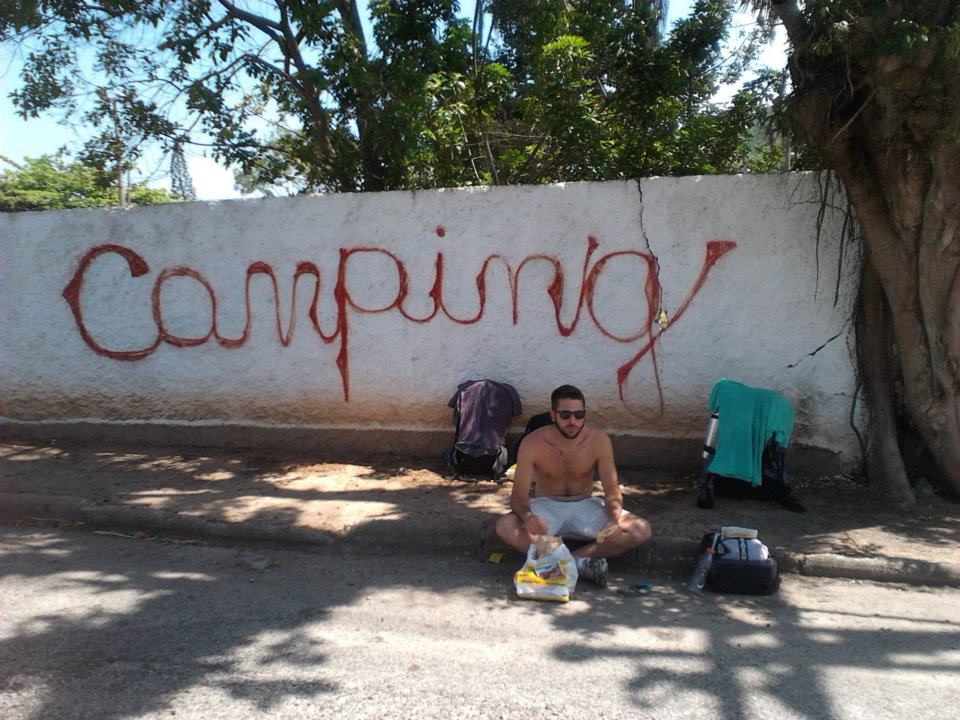
When you’re in the wild, you’ll have to find some other way to rest your head. Fazendas are local ranches that essentially serve as a guesthouse and a farm at the same time. These can be a lot of fun!
Camping and lodges are very common in the jungle as well. Expect lots of these in places like the Amazon, Pantanal, and national parks.
Finally: be aware of the “motels” or moteis while backpacking Brazil. These are almost always exclusively used for sex, and most people only stay an hour or two, for obvious reasons.
The Best Places to Stay in Brazil
There’s nothing like the feeling when you find yourself in that killer accommodation. So here’s a quick rundown of the best of the best!
By South American standards, the cost of living in Brazil is quite expensive. Without caution, travel expenses can add up quickly.
Those who want to go backpacking through Brazil with relative comfort should budget $40-$50 per day. That will get you a nice dorm bed, food and snacks, a meal in a restaurant, and some fun on the side. But hey, it’s easy to save money on these things too.
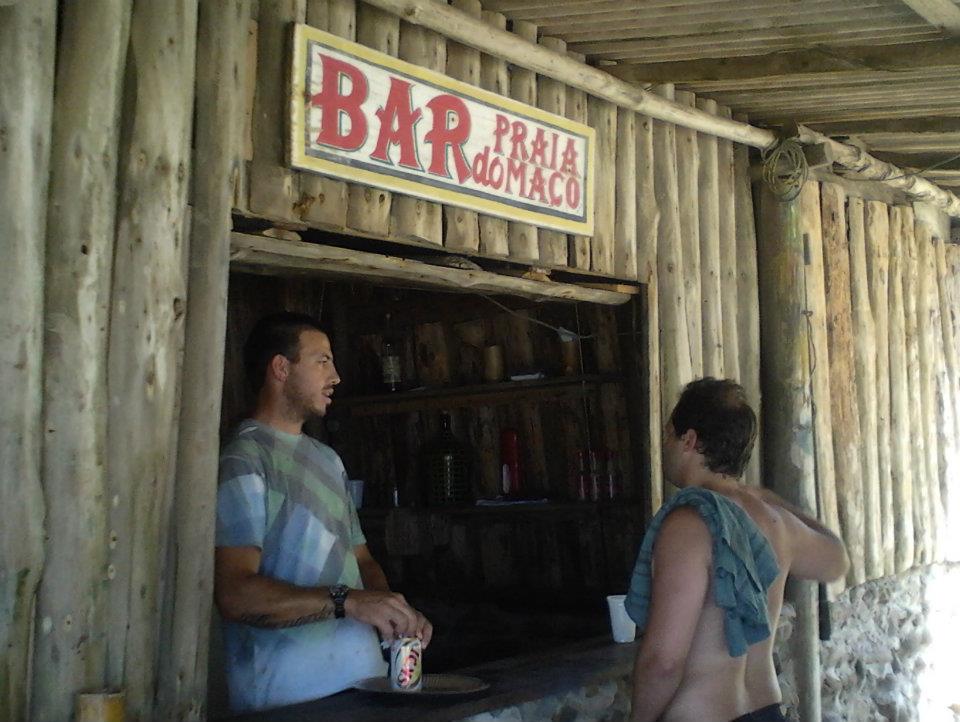
If you’re flying around Brazil, backpacking and heading on a load of excursions, be prepared to pay for it. Though if you’re prepared to slow it down, travelling on a budget is easily doable.
Prices in Brazil fluctuate heavily depending on the time of year too: the peak season is between December and April when locals are gearing up for Carnaval. This is where your Brazil trip costs would be at the highest point.
The price of a bed during the big holidays like New Year and Carnaval could triple or even quadruple. This effect is nationwide.
Prices will fall dramatically around the end of April. July rises slightly again for the Brazilian school holiday but this is brief.
Now you know all that, maybe using Couchsurfing is an answer. Brazilians are very hospitable and you’re usually getting a way better experience than just a bed. One of my hosts in São Paulo actually gave us the full apartment while we had to COVID quarantine for 10 days.
Partying in Brazil can suck your cash the most if you’re not careful. A beer here, a cocktail there, a bit of coke?
A Daily Budget for Brazil
So now we’ve covered the nitty-gritty, here’s a quick summary of what you can expect with the cost per day while backpacking Brazil.
Money in Brazil
The real is the national currency of Brazil, and this little guy likes to fluctuate…
As of October 2023, the current exchange rate is $1 USD = 5 Reales
ATMs are widely available throughout the country and chip and pin is pretty big here. So if you have an international card here you should be good. Most ATMs charge a transaction fee for foreign cards.
Just a heads up: there are reports of people having their credit card information stolen at ATMs. This is uncommon but can be avoided by exclusively using machines at official banks.

There are some remote parts of Brazil that have fewer cash withdrawal services or don’t accept cards. These locations are very remote though. Carry some cash, but not an excessive amount, unless you feel like losing it.
Robberies aren’t uncommon in Brazil. They are more common if you’re a doofus though.
If you’ve enough money to travel to Brazil, you’re going to see a lot of people poorer than you. Some of those people need money desperately.
Just be smart and hide your valuables well to avoid trouble. I’ve known people to actually carry a “dummy” wallet on them just in case a robbery should occur.
Travel Banking for Brazil
For all matters of finance and accounting on the road, The Broke Backpacker strongly recommends Wise – The artist is formerly known as transferwise! Our favourite online platform for holding funds, transferring money, and even paying for goods,
Wise is a 100% FREE platform with considerably lower fees than Paypal or traditional banks. Really, it even beats out Western Union .
Travel Tips – Brazil on a Budget
Hey, I was backpacking Brazil on a very similar budget to some of the cheapest places in the world. To keep your spending to an absolute minimum whilst backpacking Brazil I recommend sticking to the basic rules of budget adventuring….
- Hitchhike; In Brazil, it is relatively easy to thumb a ride. Hitchhiking is an ace way to keep your transport costs down.
- Camp; With plenty of gorgeous natural places to camp, Brazil is a dream. If you have a good quality tent , it’s usually much cheaper to pitch than staying in guesthouses. Sometimes you can even pitch for free.
- Couchsurfing; Hey, Brazilians are great hosts. When you find a host, you’re definitely made to feel at home while saving some dolla’.
- Eat local food; Street food is usually cheap. Look for the “prato feito” (prepared plate) or Marmitex too. They’re cheap and big enough to feed you all day. If you’re on a real tight budget – it’s worth taking a good portable stove .
- Pack a travel water bottle and save money every day!
Why You Should Travel to Brazil with a Water Bottle
Brazil is a place where nature is thriving more than most places on the whole planet. It makes it that much more heartbreaking when you see it littered with plastic. So please try to make a positive impact on the problem.
You can’t save the world overnight but you can make a difference! So I hope you become more inspired to continue being a responsible traveller .
Plus, now you won’t be buying overpriced bottles of water from the supermarkets either! Travel with a filtered water bottle instead, keep nature happy, and never waste a cent again.

Drink water from ANYWHERE. The Grayl Geopress is the worlds leading filtered water bottle protecting you from all manner of waterborne nasties.
Single-use plastic bottles are a MASSIVE threat to marine life. Be a part of the solution and travel with a filter water bottle. Save money and the environment!
We’ve tested the Geopress rigorously from the icy heights of Pakistan to the tropical jungles of Bali, and can confirm: it’s the best water bottle you’ll ever buy!
Due to its huge size and drastic diversity, the climate in Brazil changes dramatically. But we can break Brazil down into 3 general areas: South/Central , Northeas t, and North .
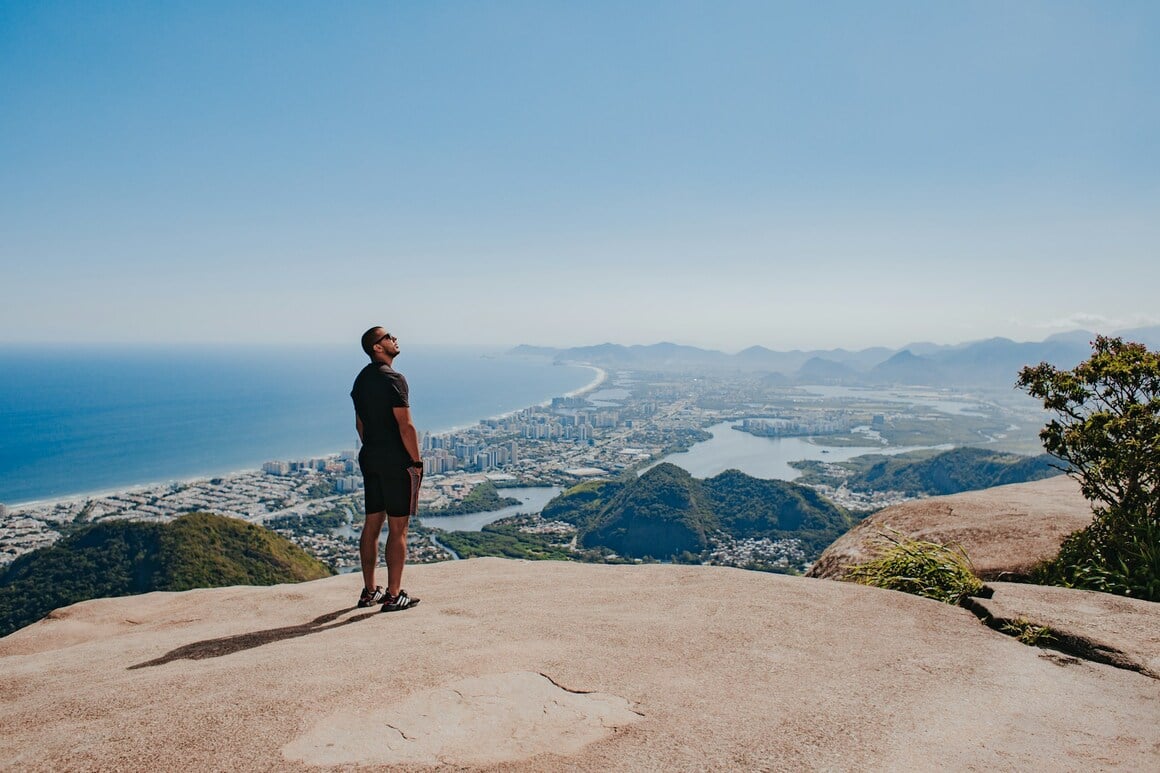
Generally speaking, between November and March , the southern half of Brazil is rainy season . This coincides with the southern hemisphere’s summer. You can pretty much count on getting wet during this time.
Though nearly every state in this region has a hot humid summer, not everyone experiences the same winter. The southern states can be markedly cold in the winter.
This is a relative chill though. People from Northern Europe or America will still feel very warm.
The Northeastern section of Brazil receives tropical rains between April and August . This means that it pisses it down, but you can probably guarantee sun in a few hours. The temperature is very steady throughout the year in the Northeast.
If you leave the northeastern coast and travel inland, you’ll end up in the sertão , or “Brazilian Outback.” This is a desert and receives very little of the Northeast’s tropical rain. Draught is a frequent occurrence in the sertão.
The North consists mostly of the Amazon Rainforest. It pretty much rains all year in the Amazon. Some parts of the Amazon do see a more observable “dry season” between the months of July and December, but it still rains a lot. It’s hotter during dryer months too.
Depending on your preference, the north of Brazil can be visited year-round. But both seasons offer pros and cons.
The Amazonian dry season has better access to trails and fewer mosquitoes. The wet season has easier river navigation and cooler temperatures.
What to Pack for Brazil
Your South America packing list is likely to look very different than when you’re travelling to other continents. For starters, a mosquito net is invaluable. Actually, just bring everything to prepare for those little bastards.
As well as this, there are 6 things I wouldn’t travel to Brazil without:

Snoring dorm-mates can ruin your nights rest and seriously damage the hostel experience. This is why I always travel with a pack of decent ear plugs.

Hanging Laundry Bag
Trust us, this is an absolute game changer. Super compact, a hanging mesh laundry bag stops your dirty clothes from stinking, you don’t know how much you need one of these… so just get it, thank us later.

Sea To Summit Micro Towel
Hostel towels are scummy and take forever to dry. Microfibre towels dry quickly, are compact, lightweight, and can be used as a blanket or yoga mat if need be.

Monopoly Deal
Forget about Poker! Monopoly Deal is the single best travel card game that we have ever played. Works with 2-5 players and guarantees happy days.

Grayl Geopress Water Bottle
Always travel with a water bottle! They save you money and reduce your plastic footprint on our planet. The Grayl Geopress acts as a purifier AND temperature regulator. Boom!
You’ve probably heard some horror stories about how dangerous Brazil is. But let me get it straight: Brazil is safe to travel to.
That’s not to say it’s without its problems. For sure, I never saw someone being chased by some loco wielding a knife until I went to São Paulo. Yet, I left São Paulo completely unscathed.
If you’re following standard safety practices , like you should everywhere in the world , crime is very unlikely to affect you. If you do find yourself in an unfortunate situation though, don’t resist; it’s really not worth the risk.
For me, the most dangerous part of Brazil was some stairs. Yes… the stairs.
I slipped in the rain and broke my back. So if you’re a clumsy arse, like me, be aware that health and safety regulations don’t have your back here. (See what I did there?)
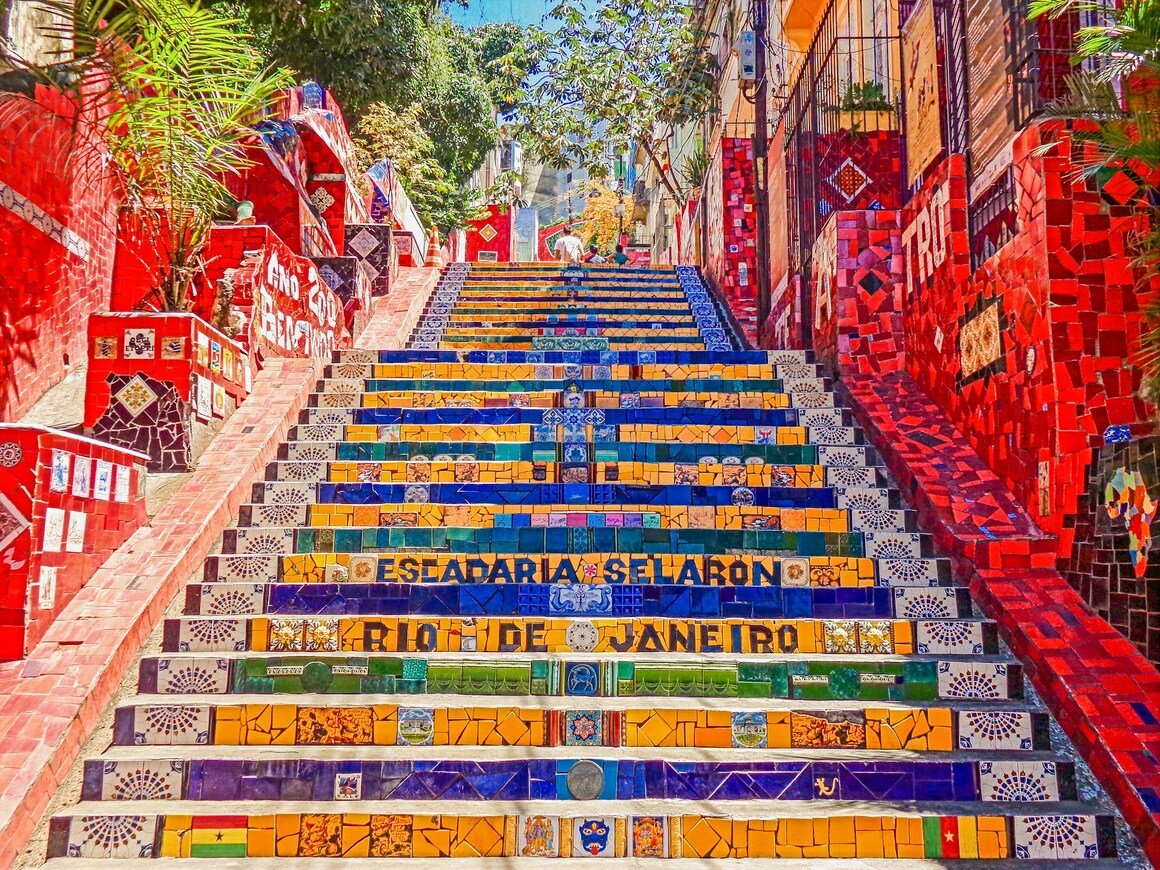
Criminals target drunks because they are easy prey. Tourists have that invisible dollar sign floating above your head. So just be cautious, don’t wander into parts of town you know nothing about, and you needn’t be worried.
Be aware that drinking is not as ingrained in Brazilian culture as in the rest of the Western World. Most of those backpacking Brazil can go a little harder than usual. In this kinda state, again, you’re an easy target.
Keep an eye out for the Brazilian police as well. These guys are underpaid, stressed out, potentially corrupt, and a lot of times just don’t give a shit.
Now, I’m not saying that all policia are bad; there are always exceptions. I’m saying don’t risk breaking the law and dealing with the guy who’s had a bad day.
Lastly, many mosquito-borne illnesses like yellow fever and Zika are extremely uncommon nowadays. Though there’s no shortage of those little bastards so prepare yourself for mosquitos .
Sex, Drugs, and Rock n’ Roll
If you’ve been paying attention to this guide, then it’s pretty clear that Brazil loves to party. Carnaval is the world’s most renowned party . For Carnaval, all usual rules go out the window: dress code, dignity, and even monogamy – in some cases.
So how to party SAFELY while backpacking in Brazil? Instead of talking about the irresponsible amount of coke and sex that you can have, I’m going to share some words of caution.
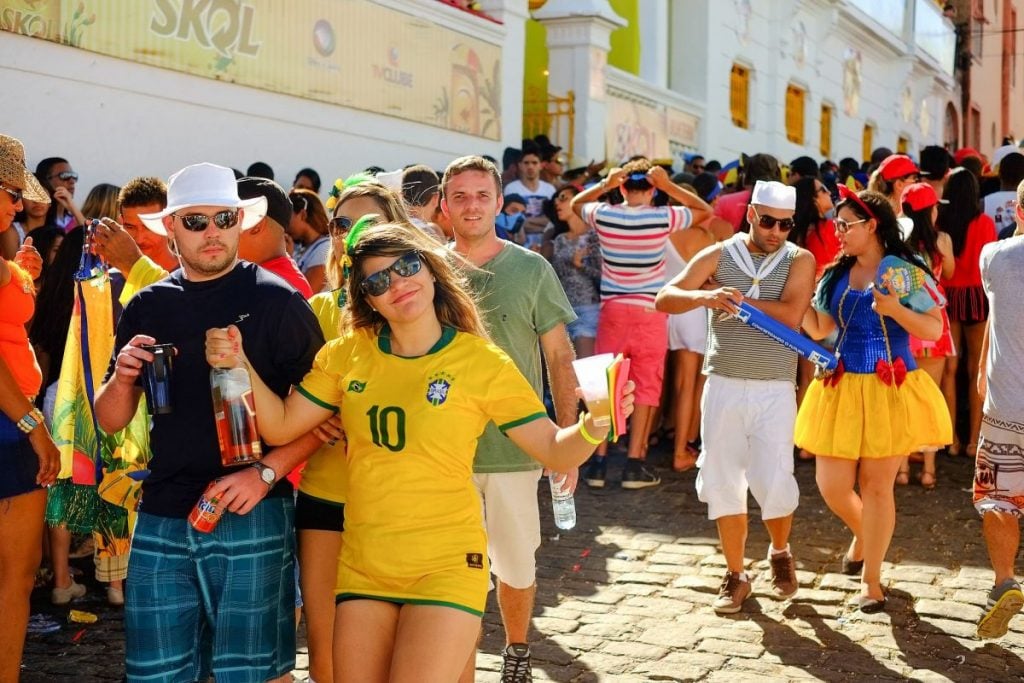
Of course, we are in South America now. So drugs on the road are almost unavoidable. Drug dealers are notorious for trying to scam naive tourists.
Generally, tourists are just easy to mug off. You arrive at a beautiful beach and all you want is a fat joint. Many of those mugs are ready to pay whatever extortionate price they are quoted.
They’re probably going to cut coke with a lot of shit – that’s just the truth. Unsuspecting tourists who don’t know any better can end up getting really fucked up.
Just be aware of who you are buying from. Don’t ever go searching for a score on your own! Tourists in the wrong part of town with large wads of cash, ready to score drugs make easy targets.
Try and enlist the help of a local. Hostel staff, though apprehensive, will usually have your best interest in mind.
Prostitution in Brazil
Look, I’m not going to beat around the bush when it comes to sex tourism in Brazil . (No pun intended.) Sex is one of Brazil’s biggest exports.
Prostitution is – and always has been – a legitimate profession. And there will always be a market for this service too. So it’s important that it’s addressed with respect and safety in mind.
The HIV/AIDS epidemic has stymied in the last few years, but the disease isn’t completely eradicated. If you do lay with a hooker, please wrap your tool.
A common scam is prostitutes robbing you blind while you’re knocked out from that wild ride too. It doesn’t happen all the time, but be aware of it. Secure your belongings in a safe place, which you should be doing while backpacking around Brazil anyways.
And most importantly, just be considerate. They are humans, regardless of their profession, and they deserve respect, like everyone else.
Getting Insured BEFORE Visiting Brazil
Look, I know that having to pay for something you hopefully won’t use sounds very unexciting. But believe me, if (and when) things don’t go to plan, being prepared is a huge weight lifted. That’s why good travel insurance is essential BEFORE you start your adventure.
ALWAYS sort out your backpacker insurance before your trip. There’s plenty to choose from in that department, but a good place to start is Safety Wing .
They offer month-to-month payments, no lock-in contracts, and require absolutely no itineraries: that’s the exact kind of insurance long-term travellers and digital nomads need.

SafetyWing is cheap, easy, and admin-free: just sign up lickety-split so you can get back to it!
Click the button below to learn more about SafetyWing’s setup or read our insider review for the full tasty scoop.
There are many entries to Brazil by land and air. Almost every major Brazilian city has an international airport. São Paulo and Rio de Janeiro are the largest airports in the country. Chances are you’ll probably fly into one of these.
You can fly directly to Brazil from pretty much every continent with the exception of Australia. You can generally find cheap flights to Brazil after April – once the holidays are over.
In case you’re not geographically aware: Brazil shares a border with every South American country besides Ecuador and Chile. With the exception of Suriname and French Guiana – where there are no roads – you can cross the land border from any of these.
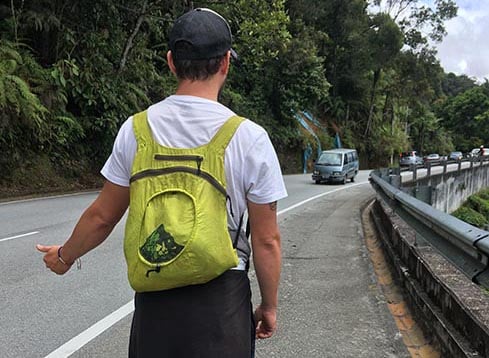
Note that travelling by road, especially by bus, can take a long time in South America. Journeying between capitals can take days.
Most of Brazil’s border crossings are safe. The ones in the south are especially secure. Border crossings do become limited and tedious when you’re in the Amazonas region, but the outposts shouldn’t hassle you any more than usual.
The Venezuelan border has become strict in the last few years following the nation’s economic collapse. Tourists travelling in Venezuela are not targeted too heavily: the increased security is mostly to control the influx of fleeing Venezuelans. But it is surely not the most friendly experience in the world.
Entry Requirements for Brazil
Depending on your nationality, visitors applying for a Brazilian tourist visa fall into one of three categories:
- visa-free nations that require an ID card
- visa-free nations that require a passport
- nations that require a visa
Nearly every South American nation can enter Brazil visa-free with only an ID card. The exceptions are Suriname , French Guiana , and Guyana . These nations require a passport, but not a visa.
Aside from Venezuela, all South American nationals can stay in Brazil for up to 90 days. Venezuelans can only stay 60 days.
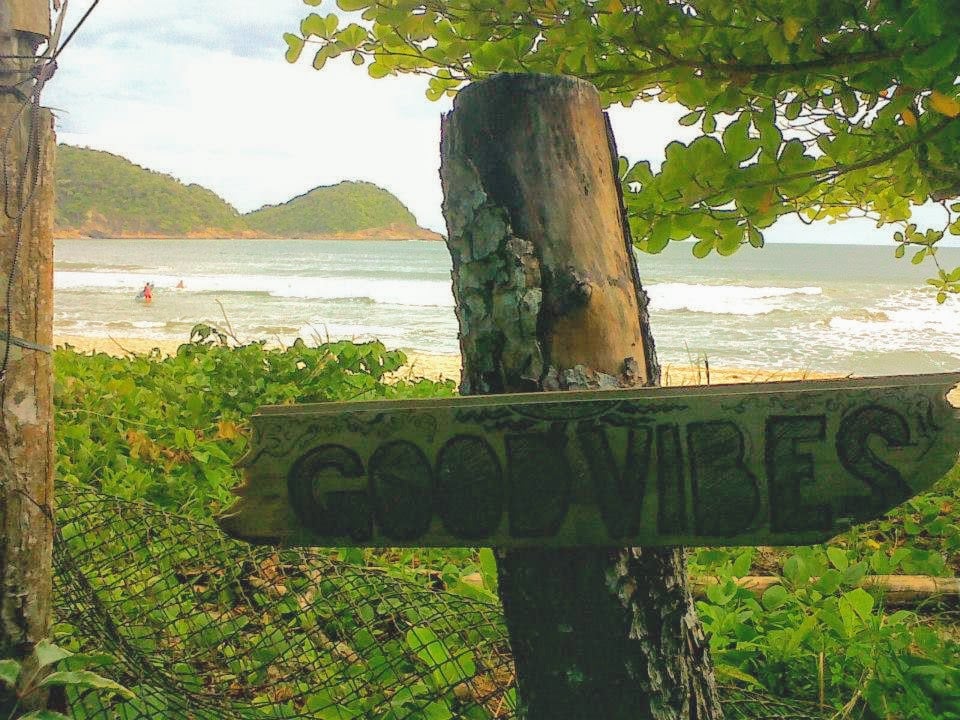
Many countries can enter Brazil visa-free with only a passport. Most Western nationalities, including the US, UK, and EU, are included in this category.
Some Asian and African nationalities are also included. Be sure to check your country’s status.
Some nationalities unfortunately need to pay for a visa to enter Brazil. These fees are based upon reciprocity i.e. whatever your nation charges for Brazilians to enter, Brazil charges you. Depending on your nationality, the fees can also be quite high.
Thankfully, Brazil has implemented an e-visa program in the last few years that has greatly streamlined the process. These e-Visas are convenient and sometimes cheaper.
E-Visas are not available to every country though. Be sure to check the Brazilian immigration website for specific details.
Buses are South America’s bread and butter. Understanding the system is easy and, once you’re familiar, it’s one of the most useful travel tips for the continent . You can get just about anywhere with them.
It’s just a case of preparing yourself: Brazil is massive and journeys can be long. Luckily, long-distance buses are very comfortable and the roads are smooth.
The sleeper buses in particular are very nice. I slept through many a multi-day journey on these sleepers like a baby. Long-distance buses will, of course, have a bathroom and stop for food every 4 hours or so.
Buying bus tickets in advance is recommended. It’s pretty disappointing to plan your journey to find out the bus you wanted to be on is sold out. Plus, companies will sometimes charge you less if you book in advance at the bus station.
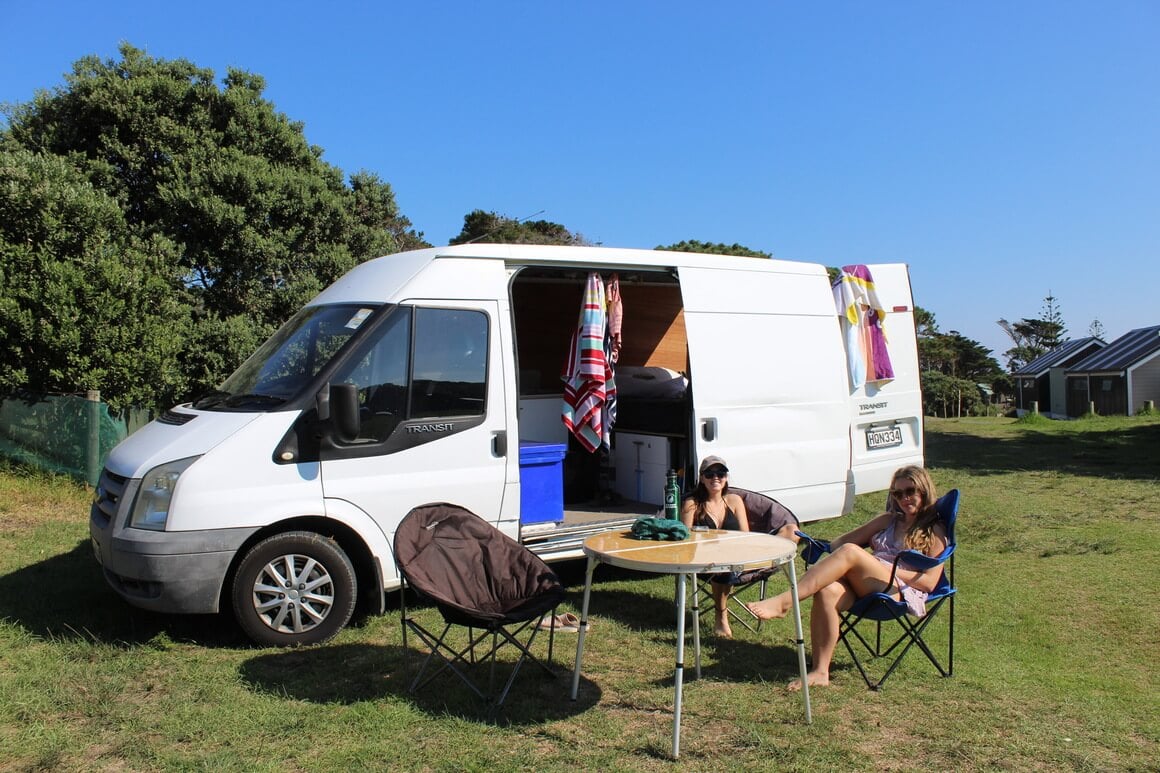
Depending on your personal requirements, you can use domestic flights to get around Brazil. These days, air travel is becoming more affordable so planes are becoming more realistic for broke backpackers.
Brazil’s airports are generally well connected. There are “corridor” lines from big destinations such as São Paolo, Rio de Janeiro, Salvador, etc. that offer cheaper flights to and from smaller destinations.
It is cheaper to purchase domestic tickets from inside Brazil too. This way, you avoid extra taxes.
Hitchhiking in Brazil
Travelling by hitchhiking in Brazil is comparable to many other large, industrialized countries, risks and rewards included. In touristy areas, you should find a ride easy enough. Locals are super friendly.
In less touristy areas, there’s every chance you may not find a ride at all and it can be pretty dodgy. I have personal reports to avoid the Northeast and the state of Espírito Santo.
Take the usual precautions, and use the same strategies. Note that Brazilian drivers do have a reputation for being reckless. You could also be mingling with dangerous types while waiting for a ride in the cities.
Onwards Travel From Brazil
Brazil shares a border with nearly every other South American country, apart from Chile and Ecuador . Travel by bus is pretty straightforward.
They are very accustomed to moving people across borders in South America. It can be a bit cheaper but make sure you have all your documents prepared to avoid being stopped.
All borders can vary slightly, I’m not writing gospel here: it will pay to do your own research. But you may need to show the following documents:
- Passport or ID card
- Visa (if required)
- Your entry/exit card (given to you when you arrive in Brazil)
- Proof of onward travel
- Proof of vaccinations (Covid, Yellow Fever etc. if required)
Flying across borders is a little less strict. But still, do I have to remind you – a traveller – to prepare your documents well, again?
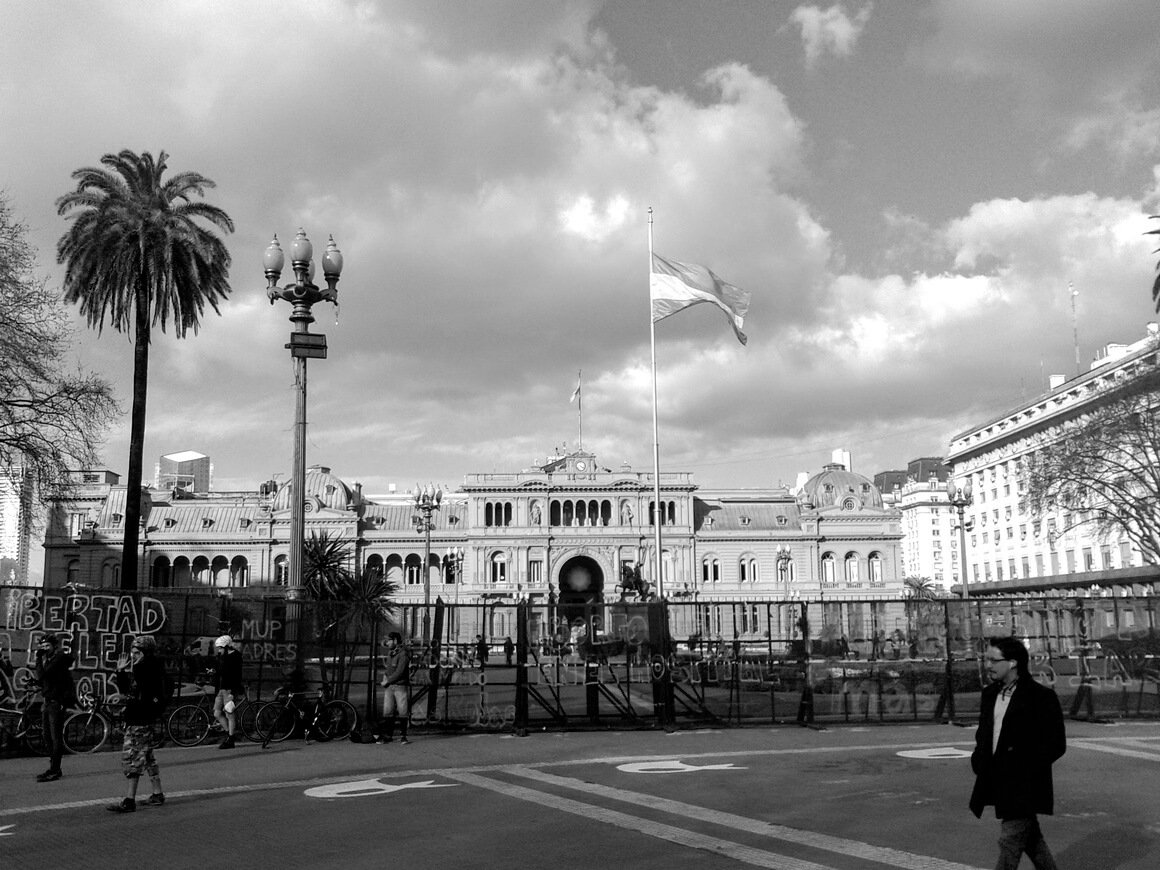
Visas are either issued at the border or are available as an e-Visa. Every passport has its own restrictions, so be sure to check with your government’s website.
Some South American countries want proof of Yellow Fever vaccination. If you’ve received one, make sure to have the document with you for proof.
Providing proof of onward travel is sometimes enforced, and sometimes not. If you find yourself without an onwards ticket, maybe you could talk your way out of it. Just be polite and you should be fine.
- Backpacking Peru
- Backpacking Colombia
- Backpacking Ecuador
- Backpacking Bolivia
Getting a traditional job in Brazil isn’t straightforward. Although unemployment isn’t as high as it is in other South American countries, work visas are pretty hard to come by – unless you’re from another South American country and part of the Mercosur .
But wait! Brazil is becoming an increasingly popular place for home working: beautiful nature, reasonable costs of living, and epic activities make one hell of a country for digital nomads .
Digital nomads might be drawn to typical Brazilian hotspots like Rio de Janeiro or São Paulo. They’re hectic to live in, expensive, fiercely competitive, and not overly safe. If that’s your jam, cool – you’re gonna love it.
But did you really come to Brazil to work in a massive metropolis when you’re surrounded by paradise? Co-working spaces are popping up everywhere. Internet is mostly trustworthy and life is certainly sweet.

I am slightly biased toward Florianopolis : it is probably the most ideal place to live in Brazil – nomads and locals alike. The beaches are incredible, there are tons of things to do, and the quality of life is fantastic.
I really had to drag myself away from my tropical, beachside garden paradise. I can easily see myself back there one day.
But go and find your own haven. Belo Horizonte, Bahia, and backpacker hideout Jericoacoara all have growing communities too.

A new country, a new contract, a new piece of plastic – booooring. Instead, buy an eSIM!
An eSIM works just like an app: you buy it, you download it, and BOOM! You’re connected the minute you land. It’s that easy.
Is your phone eSIM ready? Read about how e-Sims work or click below to see one of the top eSIM providers on the market and ditch the plastic .
Volunteering in Brazil
Volunteering abroad is an amazing way to experience a culture whilst helping out a host. There are plenty of different volunteer projects in Brazil including teaching, construction, agriculture, and pretty much anything.
High levels of poverty mean Brazil is in desperate need of volunteers to offer a helping hand. English teaching, animal care, and social work are all areas where backpackers can make a big difference. Digital skills are also increasingly sought after including, web development, content writing, and photography.
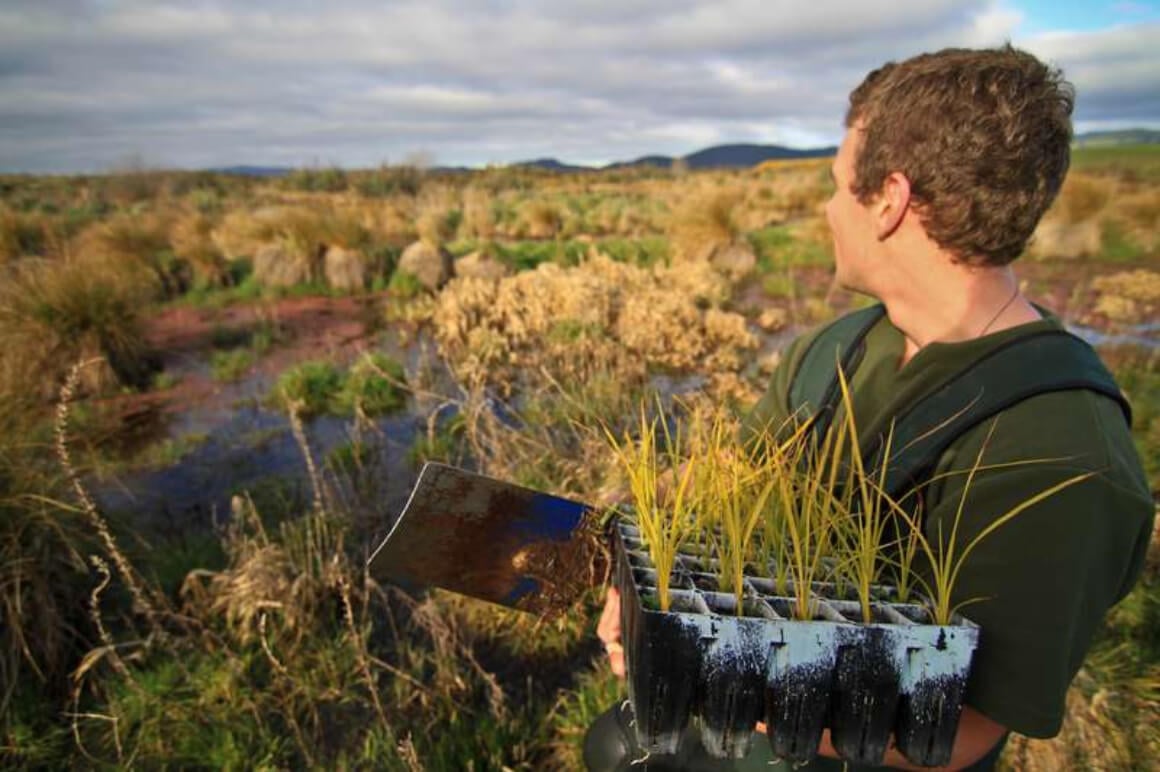
You may need a temporary work visa to volunteer in Brazil. If so, apply before you go.
Programs run through reputable work exchange programs , like Worldpackers or Workaway , are generally very well-managed and highly reputable. Just remember to be responsible, especially if you’re working with animals or children.
Signing up for Worldpackers is a great way to connect to local hosts with volunteer opportunities. As a Broke Backpacker reader, you’ll also get a special discount of $10. Just use the discount code BROKEBACKPACKER and your membership is discounted from $49 a year to only $39.
Brazil is one of the most ethnically diverse places in the world. Brazil’s breadth of colour comes from its colonial roots and forms its unique culture. Diversity is sung in Brazil and they are generally open about their race.
Fairer Europeans travelled across the ocean to the New World and settled in Brazil. They brought with them ebony slaves from Africa and subjugated the native Amerindian people. Eventually, all of these cultures commingled and gave birth to this dramatic, rhythmic, passionate nation.

There is something about the warmth of Brazil that goes beyond the weather. Brazilians are a famously lovely and smiley people. Expect them to be very up-front and touchy.
Also, expect very candid conversations. Brazilians love to share their deepest secrets with others and have no shame in telling you how they feel.
Having European influences, the Brazilian culture is actually quite western. There are some who argue its place in Western society. In my opinion, though, it’s Western enough to warrant some worthy comparisons.
In other areas, Afro-Brazilian culture is dominant and the strong African influence is unmissable. This beautifully brilliant blend leads to some of the best music, art, and language in the world. These cultures combined with the native culture and respect create something you won’t find anywhere else.
Brazil relies heavily upon an industrialized economy and workforce. In fact, more Brazilians live in an urban setting than North Americans – 87% vs 79%.
It’s safe to say that Brazilian society is relatively modern. Much of the Brazilian mindset is in line with most of the developed world.
Useful Travel Phrases for Brazil
People often make the mistake of thinking that Brazil speaks Spanish, much to the ire of the locals. Brazil was a part of the Portuguese Empire. Brazil speaks Portuguese .
Though if you are a Spanish speaker, particularly familiar with South American Spanish, this will stand you in very good stead. It’s Latin based and the written form does look a lot like Spanish. Once you understand some minor differences, you’ll find many similarities.
Brazilian Portuguese is a gorgeous language and very different sounding from European Portuguese. The pronunciations could be mistaken for different languages. Brazilian Portuguese can sound like they are almost singing.
Even if their dialect and slang throw you off, locals will really appreciate you speaking some Portuguese. Though in many places it will actually be crucial to backpacking Brazil because English is not commonly spoken. This means it’s a great place to learn another language .
Arming yourself with some key phrases gets you off to a good start. Here’s a list of some of the most useful.
- Bom dia/boa tarde/boa noite – Good morning/afternoon/night
- Tudo bem? – All good?
- Meu nome é… – My name is…
- Onde fica a banheiro? – Where is the toilet?
- (O)brigado/(O)brigada** – Thank you
- Que saudades! – It’s been so long (since I’ve seen you)!
- Até logo – see you later
- Nenhum saco de plástico – No plastic bag
- Posso comprar um bilhete – Can I buy a ticket?
- Que horas são? – What time is it?
- Você fala inglês? – Do you speak English?
- Quanto custo? – How much?
- Valeu – Cool/thanks/cya
** Obrigado changes depending on the gender of the speaker. Men say obrigado . Women say obrigada. Though their language towards gender is still developing and there isn’t actually a neutral option – so I say use whatever you feel like really.
What to Eat in Brazil
Brazil has a reputation for a lot of street food involving meat and a lot of frying. Let me just tell you now, it’s true and it’s delicious. You will not struggle to find this kind of food.
But I would be doing Brazil a dishonour if I stopped there: Brazilian cuisine is fantastic! With all this crazy climate, things just grow in Brazil. One of the best things to do in Brazil is eating your body weight in exotic edibles.
Fruit drops off trees faster than you can eat it. I had 2 months of mangos and avocados coming out of my ears.
Traditionally, Brazilian food is a mix of European, Amerindian, and African styles. That being said, Brazilian cuisine is extremely variable. The food on your plate could be completely different depending on what region you’re in.
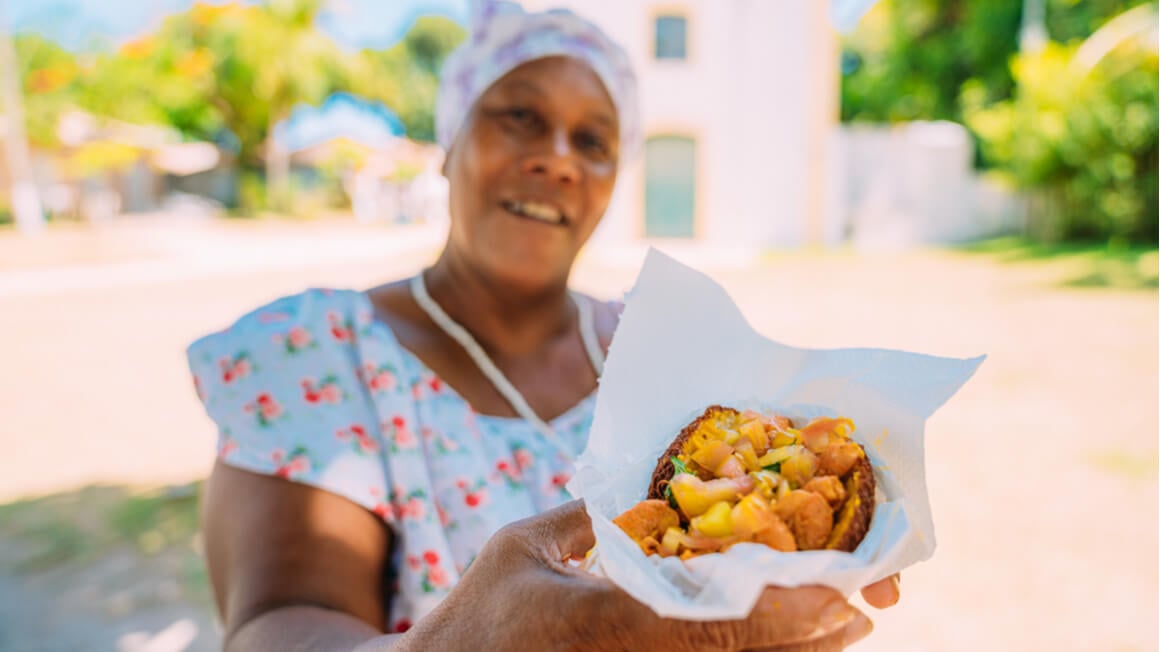
Broadly speaking, each region will use more or less a specific culinary style. The Northeast will be lots of African food. The Amazon will have more Amerindian food. The Southeast will have more European food.
Must-Try Dishes in Brazil
There are plenty of dishes that are essential to try when you’re visiting Brazil. Here is a list of some top ones.
- feijão – bean stew with meat and vegetables
- acai – dark berry often served sorbet style
- pão de queijo – cheesey bread bites
- Romeu e Julieta – guava paste – in cheese, obviously
- coxinhas – magic fried stuffed mashed potato
- vatapa – creamy dish w/ shrimp, nuts, coconut
- acarajé – hard to describe but damn delicious
- pastéis – fried pastries
- beijinho de coco – coconut truffles
- churrasco – barbecued meats
- cachaça – distilled spirit made from sugarcane
- caipirinha – mixed drink using cachaça, fruit, and sugar
A Brief History of Brazil
The history of Brazil dates long before the arrival of the Portuguese. For thousands of years, indigenous people – specifically, the tupi and guarani – inhabited this land.
Unlike the Peruvian Maya, they were a nomadic people who moved frequently in pursuit of food and treasures, like the brazilwood, cherished for the red dye it yields. Most of these people died from diseases brought by visiting Europeans. Many indigenous people never even met a European, though they still perished from their diseases.
Following the arrival of Europeans in the 17th Century, Brazil became a colony of ‘the new world’. The region was mostly controlled by the Portuguese Empire, though the Dutch held a few settlements in the north around Recife.
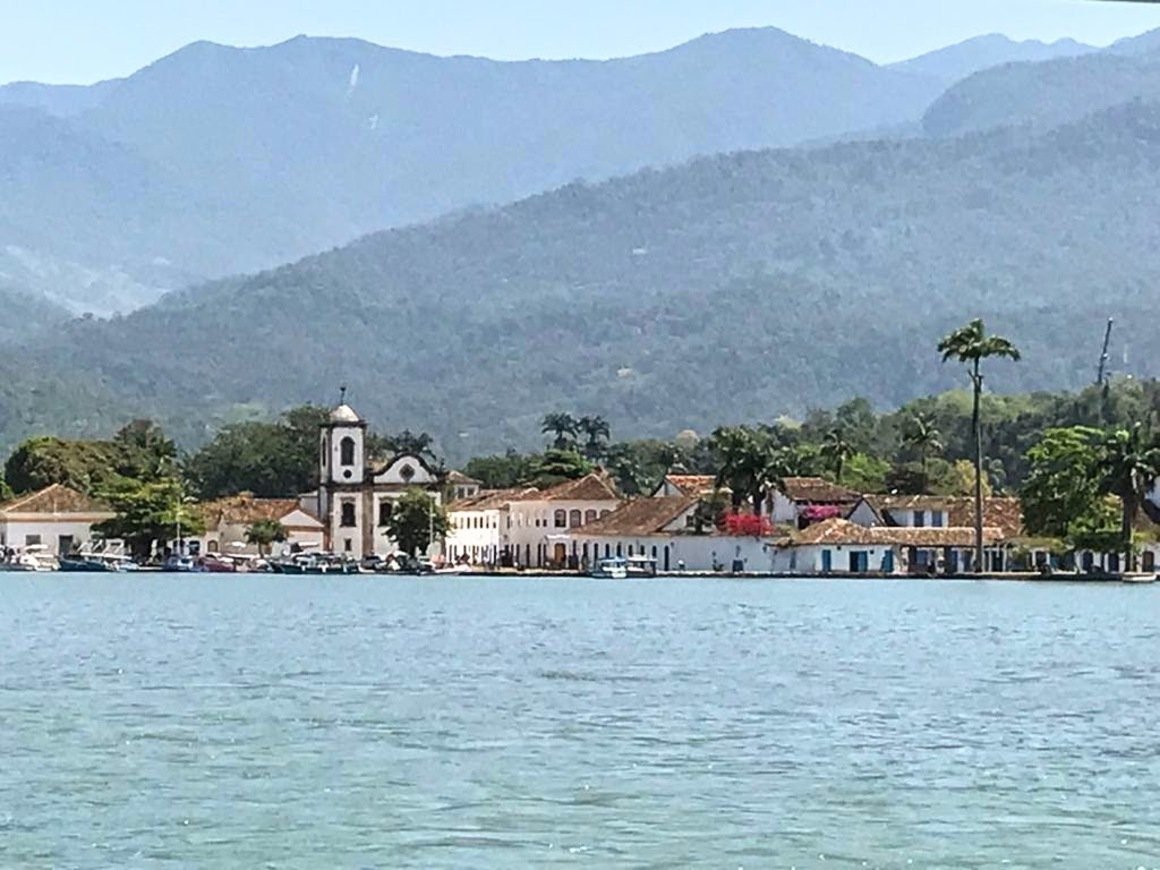
For centuries to come, the Portuguese would fight with the Dutch, Amerindians, and revolting slaves. The discovery of sugar, gold, rubber, and other precious resources made Brazil a valuable place.
In 1822, Brazil became independent from Portugal. This iteration was labelled the Brazilian Empire and included modern-day Brazil and Uruguay.
Slavery was widely practiced , even more so than in the United States. Over the next 150 years, Brazil would morph several times, from kingdom to republic to military dictatorship to what it is today.
Modern-day Brazil is a democratic country. Years of imperialism followed by despotism have left Brazil a nation with much to consider.
Though the nation is immensely rich, inequality is grossly apparent. Many have tried to reform Brazil for the betterment of the people, only to be setback by corruption and greed.
Like many new world countries, Brazil is a question waiting to be answered. Can wealth and social equality coexist? Only time will tell.
Your backpacking Brazil trip is not going to look like anyone else’s. You have the opportunity to make your experience in Brazil totally unique. However you think your trip to Brazil will go, you can very well find yourself falling in love with something (or someone?) and end up with a great story to tell.

Things go wrong on the road ALL THE TIME. Be prepared for what life throws at you.
Buy an AMK Travel Medical Kit before you head out on your next adventure – don’t be daft!
Trekking in Brazil
Trekking probably isn’t the first thing that pops into one’s mind when they plan on backpacking through Brazil. It’s a shame because Brazil has some of the best trails in the world .
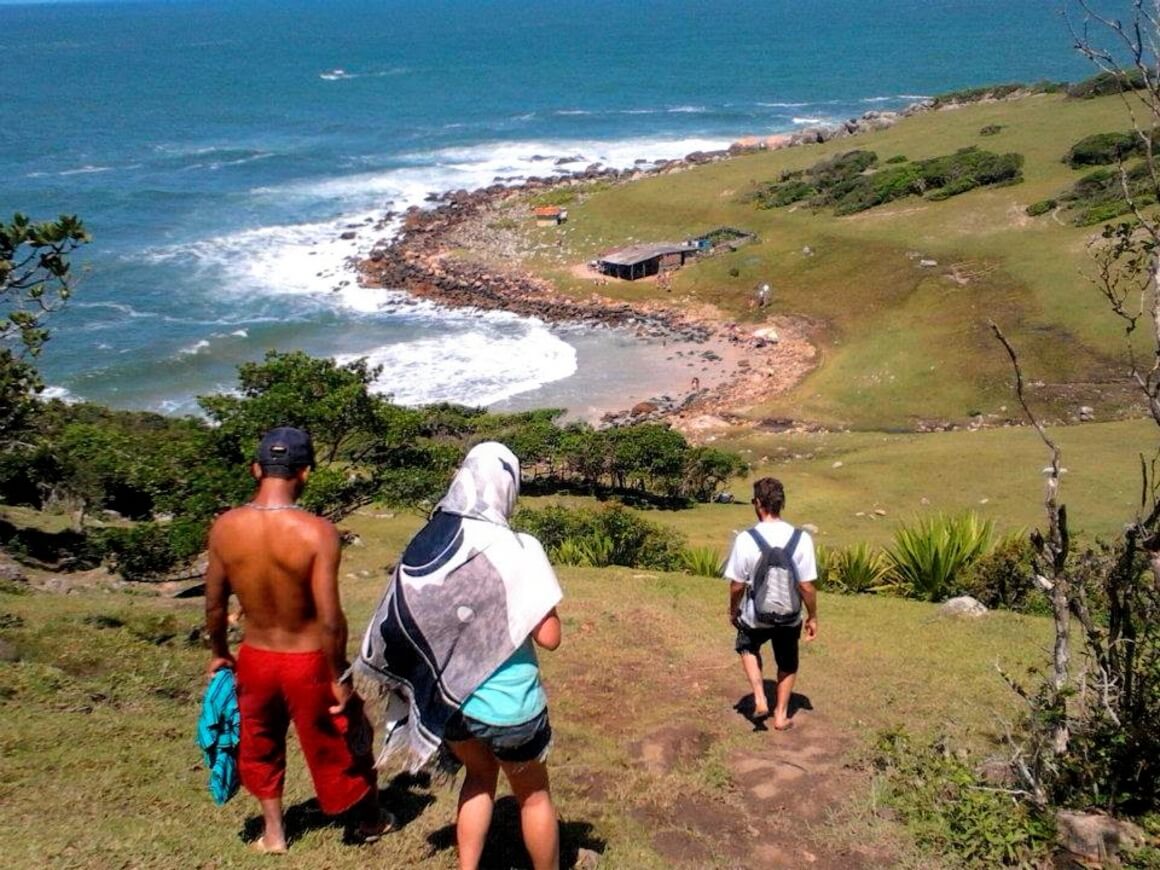
The best hiking opportunities are usually to be found in the parques nacionais (national parks). Brazil has over 70 national parks, so you have plenty of options.
If you organize treks through tour companies, they will provide you with equipment. Maybe you’ll just need a solid pair of hiking boots . Bringing your own gear is always the best way to save cash though.
Consider buying a tent and a sleeping mat, or ditch both and get a hammock. A wilderness stove is also a good idea for making a kitchen wherever you go.
The Best Hikes in Brazil
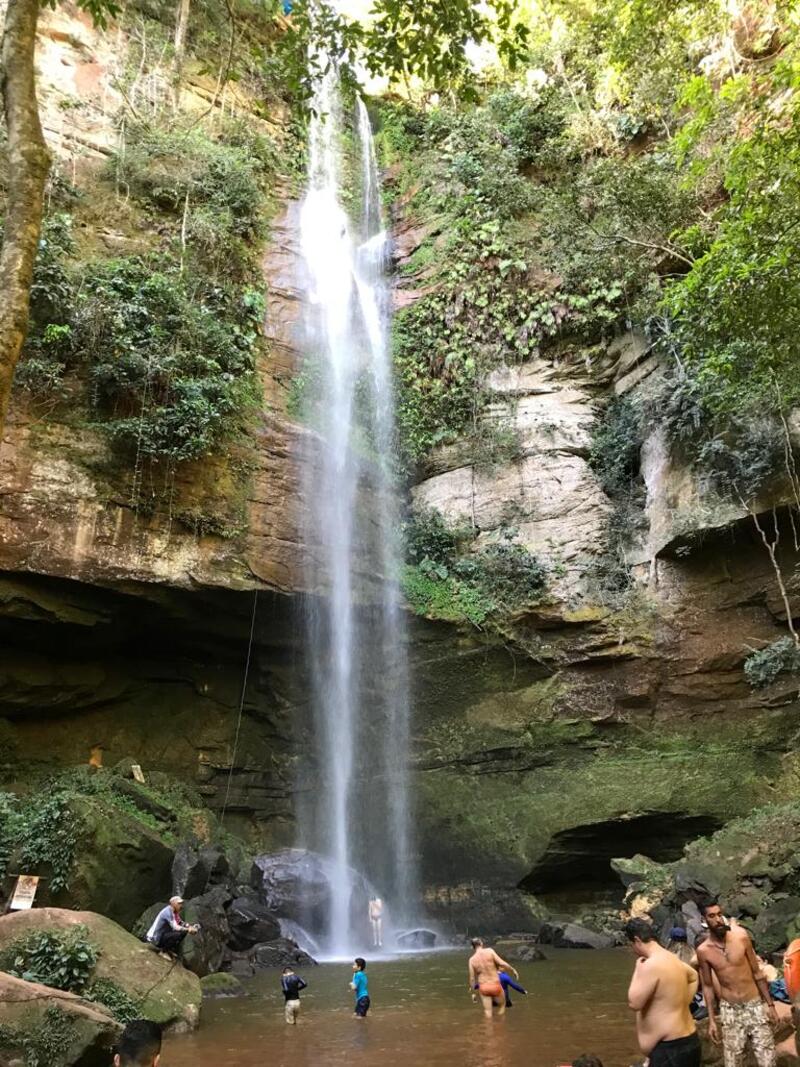
- Serra dos Órgãos, Rio de Janeiro – Large geological area located just north of Rio. Famous for picturesque, organ pipe spires. Passionate climbers may attempt these challenging mountains, including the iconic Dedo de Deus (Finger of God).
- Itatiaia, Rio de Janeiro – Oldest national park in Brazil. Good mix of rainforest (Mata Atlântica) and mountainous terrain. Hike up to the Prateleiras massif, or Pico das Agulhas Negras. Stumble across insane waterfalls.
- Aparados da Serra and Serra Geral – Twin parks created to protect the sensitive ecology of Brazil’s southern canyonlands. Located between Santa Catarina and Rio Grande da Sul. Most impressive is Itaimbezinho . Hike either above the rim, or into the reaches via multi-day wilderness backpacking trips.
- Chapada dos Veadeiros, Goiás – Huge waterfalls, and some of the oldest geology in the world. Latter is thought to have special properties. See the surreal Vale da Lua (Valley of the Moon) and picturesque Santa Barbara Falls. Hike via the park’s two longest trails: Canyons and Saltos.
- Chapada dos Guimarães, Mato Grosso – Dramatic highlands complete with waterfalls. Take a short trek to Guimarães’s most recognizable falls – Veú de Noiva. Or see several via the Circuito das Cachoeiras. Hike on the São Jerónimo trail for the panoramic view.
- Chapada Diamantina – One of Brazil’s premier outdoor areas. Consists of escarpments, waterfalls, and underground pools. Must see is one of Brazil’s highest waterfalls, Cachoeira da Fumaça, and the perfectly blue water of Poço Encantado cave. Spend a few hours hiking up to Morro do Pai Inácio for a great view, or several days trekking into the Vale do Patí.
Diving in Brazil
Fernando de Noronha is the best place to go diving in Brazil. Noronha is an archipelago located about 200 miles northeast of Recife in the middle of the Atlantic. Most arrive by plane, but there are ferries running during the high season.
There are lots of coral and sea caves to explore here. The coral isn’t too bright, but the colourful tropical fish more than make up for this. Discover dolphins, turtles, and the occasional whale shark.
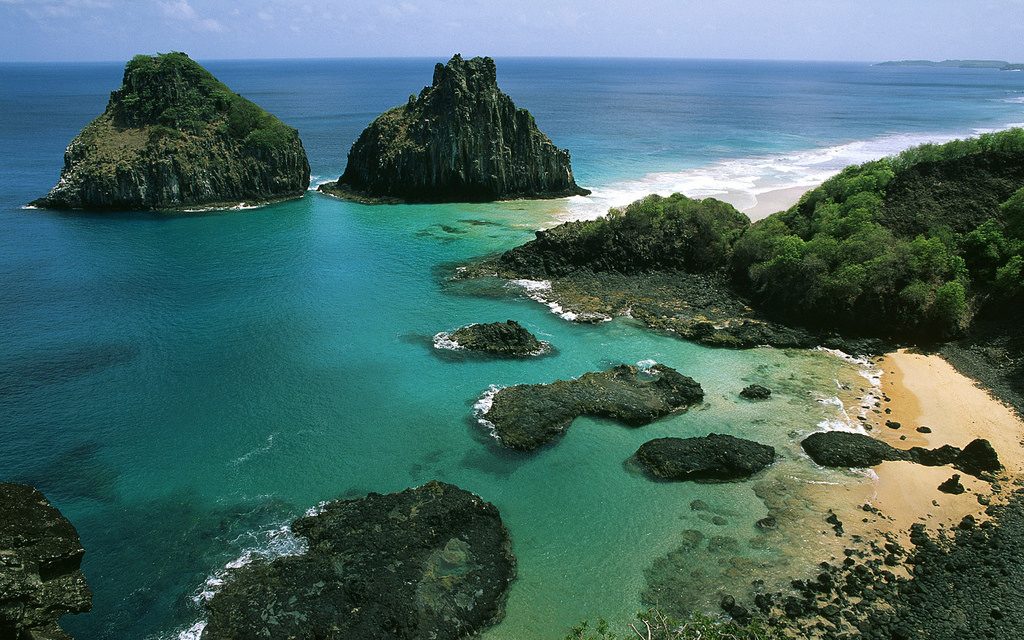
Diving aside, Fernando de Noronha is one of the most beautiful places in Brazil. Many locals call it “the Hawaii of Brazil”.
Because of its natural significance, Fernando de Noronha is a designated national park. For that reason, the islands are very regulated in order to preserve the ecosystem. There are very few roads and very few human settlements.
Visiting some islands in the archipelago require permits. No matter where you go, expect high prices; potentially the highest prices that you’ll find while backpacking Brazil.
Joining an Organized Tour in Brazil
For most countries, Brazil included, solo travel is the name of the game. That said, if you are short on time and energy while backpacking Brazil, or you just want to be part of an awesome group of travellers, you can opt to join an organized tour .
G Adventures is a solid down-to-earth tour company catering to backpackers just like you, and their prices and itineraries reflect the interests of the backpacker crowd. You can score some pretty sweet deals on epic trips in Brazil for a fraction of the price of what other tour operators charge.
Now, armed with your new backpacking Brazil travel guide, you are ready to take on the epic journey. This is one truly mighty country. Brazil will open your eyes and brand your soul.
While this is invigorating, keep your head screwed on. Brazil is one of those countries that doesn’t stop for anyone. No matter what’s going on over there, the hamster wheel is still running.
You’ll need to bring your best sense of adventure. Using that Portuguese will help you out too.
Brazil tests you, changes you, and you leave feeling like you’ve achieved something massive. Those stories of travelling here are good to tell for the rest of your life. Get ready to be humbled by a nation with a very large heart.
Party hard and party smart. It’s going to be something you won’t see anywhere else in the world.
There’s no doubt: Brazil is a special place. But you’re going to find that out for yourself. Come back and tell me your stories when you do.
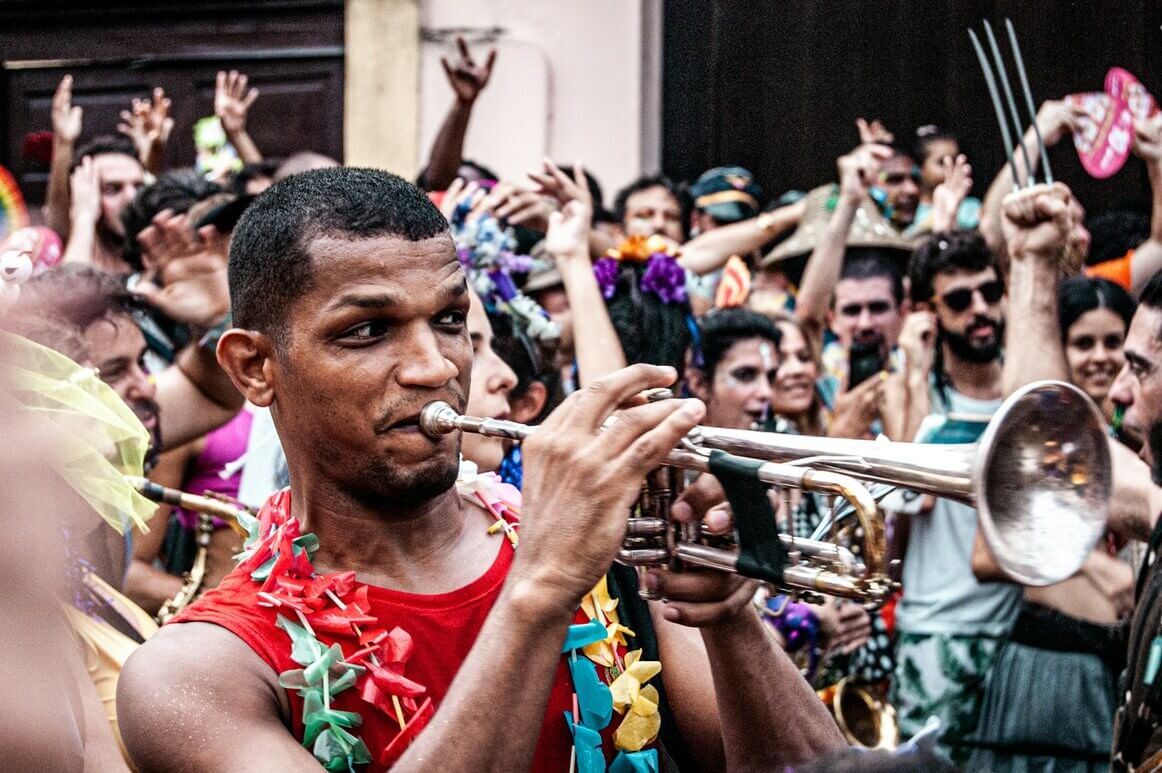
- 11 Must-See National Parks in Brazil
- Best Portable Travel Safe
- Backpacking Chile Travel Guide (2023)
- Things to do in São Paulo on ANY Budget

Sebastian Garcia Vivas
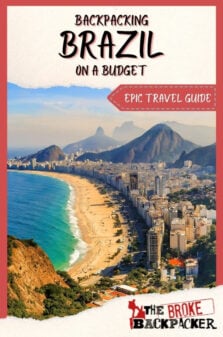
Share or save this post

Thank you so much for this easy and detailed guide. A complete resume!
Hey, Great post really informative! If I am planning a 6 month trip what would you say the best time of year to come is? I was thinking of arriving in November? Thanks Lia
November would be a great time to start your trip, its coming into the warmer months of the year then.
Have a great time.
I was enjoying reading the article, buuuut. When you say “Good lord, the people of Porto Alegre make the visit worth it. They are absolutely gorgeous.” it got me.
You just minimize the bautiful people of Brazil. People from Porto Alegre are white european blond, so yeah. It’s just a bad point, make me feel bad.
Hey there Sad Brazilian (if that is what you’d like to be called),
Wasn’t my intention at all to minimize the beauty of the Brazilian people! Sorry if you got that impression. If you had read a bit further down the article you might have noticed that I mention several times that Brazilians people as a whole are probably the most beautiful people in the world.
In regards to Porto Alegre, I just found that people were there were exceptionally beautiful. Also, whilst Porto Alegre does have more European immigrants, I think it is inappropriate to say that there are just blond people there- I met lots of gente morena while I was there and they were equally as beautiful.
Incredibly beautiful pictures! It’s really an absolute delight to watch clicks. I appreciated clearly written and thought-provoking article.
Seriously your post is perfect and complete! I thank you a lot for the effort made and all the details 🙂
Your post couldn’t be more complete! I loved the different itineraries that you made, including routes and places that are off the beaten track. I also agree with your tip to get around Brazil… buses are so easier to get and cheaper too, specially if you leave for the last moment to buy the ticket. Another thing is that with buses you can get to places that the planes don’t… I’d like to include another tip for website to buy bus tickets online: https://brazilbustravel.com/ I usually use this one and I find it very simple and useful 🙂
Brazil is so amazing destination to enjoy natural things and you shared a great guide to that beautiful destination. The packing list is good to enjoy the things of brazil.
Leave a Reply Cancel reply
Your email address will not be published. Required fields are marked *
Save my name, email, and website in this browser for the next time I comment.
Notify me of followup comments via e-mail.

Traveling inside Brazil: a guide to transportation in the country
If you’re one of those travelers who like to visit as many different places and locations as possible in your destination, it’s important to know the best ways to get around to get to your points of interest safely . Not only that but choosing the ideal way of moving around could also save you a lot of money and time .
If you’re planning on visiting different spots in Brazil, the best and most popular ways of getting around the country are by plane or travel bus. But depending on the location and convenience, renting a car or even using apps like Bla Bla Car could really come in handy.
In this post, we’re going to explore the main ways of transportation around Brazil, which of them are fit for which type of travel, and the advantages and disadvantages of each one of them.
Important Topics to Consider While Choosing Your Way of Transportation in Brazil
If you’re planning on coming to Brazil, getting to know all the places you’ve only seen pictures on the internet sound like the perfect idea, especially since it’s easy to get all hyped up about getting to a destination you’ve never been to before.
But in order to tour around different places under the best circumstance, it’s necessary to take the time to make a clear schedule on your points of interest and think about how you’ll be getting from one point to another .
Choosing the best way to move around in Brazil depends on a series of factors, as each way of transportation has its pros and cons. The ideal thing is getting to know the features in each of them before you make your choice, which will provide you with a much better experience.
Here are some topics you should consider before choosing your way of transportation in Brazil:
Average Travel Time
One of the main advantages of traveling by plane is getting to your point of interest much faster than with any other transportation. It allows for a distant location to be accessed with a lot more ease, differently from a car trip, that depending on the distance, could take days .
For example, Brasília and Porto Alegre are a little over 1k miles apart, demanding approximately 26 hours of non-stop driving (not considering resting stops) to get to one another. The same trip by plane would only take a little over 2 hours, sparing you from the fatigue of driving and giving you more time to enjoy yourself once you arrive.
So, if the distance is overbearing and you have the financial means available to afford a plane ticket, don’t hesitate to treat yourself.
Knowing Your Destinations
A critical element to you help you decide whether it’s best to take a plane, a car, or a bus is knowing your destination at least a little bit. Some places in Brazil don’t have international airports, or any near airport whatsoever, which would automatically narrow down your options .
On the downside, it’s not easy driving around in a city you don’t know very well, especially in big cities with heavy traffic. So, if you’re not any good with directions, taking a travel bus or charter an Uber (or a yellow cab) to take you to your destination would be much more preferable .
There are a few destinations in Brazil that can neither be accessed by plane nor by travel buses, making you depend solely on renting a car or hiring the services of a driver.
Gather as much information as you can about your destination, as it will make some decisions a whole lot easier. For example, while you may be able to get to a certain location by bus, moving around without a car could become a bother , so maybe renting a vehicle in the first place could be the best choice.
High and Low Seasons
The time of the year you’re planning on traveling can greatly influence your decision to make the trip by land or sky. During the low season periods, you’ll be able to find much affordable and reasonable plane ticket prices, which could almost match the costs of travel bus passes or renting a car .
Those last two options are little influenced by the low season in regards to your finances, but since the high season of most places in Brazil is during the Summer (December to February – coinciding with year-end school vacations), it makes the traffic much more intense, as well as there’s a considerable increase in road car accidents.
The Distance Between Locations
The distance between the places you plan on going is also something to be considered before hitting the hammer on how you’ll be moving around. Although obviously faster, sometimes getting on a plane may not be the most practical option depending on your schedule .
You have to check-in, dispatch your luggage, go through airport security, and that’s just while in the process of boarding the plane. Not to mention the time you will waste if the flight makes stopovers, which will definitely make you waste a lot of time.
So, if you’re making a short trip, it’s best to travel by bus or car , avoiding all these bureaucracies and bothers. Giving you a more practical example, if you consider the time all the pre-flight procedures take, going from Goiania to Brasília by car could take just as much time as if you’d make that trip by plane.
Number of People Traveling With You
If one person’s plane ticket can already be too pricey, imagine that same value multiplied by all the people who will be joining you on your trip. Although the price is justifiable, traveling by plane with a large number of people could represent a huge expense on your budget.
If you consider the same trip by car, everyone in your party could share the car rental and gas expenses, which could make your trip much more inexpensive and a lot more fun . I mean, who doesn’t love a good ol’ road trip.
So, if you’re on a budget (which will bring us to our next topic) as has the possibility of sharing the car-related expenses with your friends/family, don’t hesitate to do so.
Travel Budget
If you’re looking to make your trip schedule more inexpensive, it’s time to put the calculator to work and consider all possible costs in order to make the best decision on your way of transportation.
If we first go over the expenses involved in traveling by plane, we’re talking about boarding fees, luggage rates, and the costs of requesting an Uber or a yellow cab to take you to and from the airport, which depending on where’s located, could represent a relatively large sum of money.
On the other hand, the expenses involved on a car trip go well beyond the gas money. You have to worry about the daily rental fees, toll fees, be prepared for any kind of unexpected events (flat tire, changing oil, etc.), and of course, consider if the car is strong enough to handle the destination you’re going to.
Which Way of Transportation Is The Best in Brazil?
As you may have noticed, choosing between taking a ´plane, a car, or a bus while you’re traveling inside Brazil is entirely up to you. It’s important to consider all the aforementioned topics, drawing an accurate comparison of each of their pros and cons, and making your decision based on what fits your trip best.
To further help you in making that decision, we’re going over all the advantages and disadvantages of each main way of transport in Brazil:
Traveling Around Brazil By Travel Bus
Taking a travel bus to get to a far location is probably the most popular transportation method in Brazil, given the high prices of domestic flights in the country. While that can indeed be a drawback, it can work out for the best in some situations.
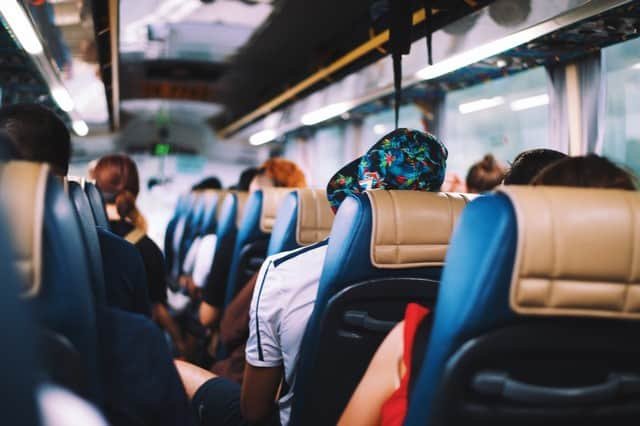
Pros of Traveling By Bus In Brazil
Bus terminals are much more accessible.
As we briefly mentioned earlier, most Brazilian airports are somewhat distant from the city’s downtown, which could be a real bother. But on the flipside, Travel Bus terminals are way easier to get to, given their locations being more central .
Depending on your destination, you may even be able to find an integration system between the travel bus and the location’s public transportation, facilitating your transfer . Some bus terminals even count on mini-buses and vans, ideal if you’re traveling with a group of people.
Regarding the bus terminal infrastructure, products and general items are sold at much less expensive rates than at airports. However, the prices are still largely criticized and labeled as abusive by the general Brazilian population.
Less Expensive Travel Tickets
Fishing for plane tickets at a good price is often an arduous process, and if you don’t plan ahead, there’s a good chance you won’t be able to purchase them for the date you want.
Taking a travel bus to move around in Brazil could be way more inexpensive since travel bus tickets have little price variations and don’t suffer from the same annual readjustments as plane tickets do .
The differences between the plane ticket fares are often related to the type of seat you want. Most Brazilian Bus companies have the following options:
- Conventional The conventional bus the most simple in the category, having the cheapest tickets. The seats are cushioned, and semi-reclining in general guidelines, and the bus may or may not have an air-conditioner. This type of bus is ideal for short trips or if you really want to save up on transportation.
- Executive The main difference between the Executive and Conventional bus categories is regarding their comfort levels. Buying an Executive seat could give you a little more space to travel (as the bus seats are a little more separate in comparison to the Conventional), and the seats recline more than the other. Executive buses are very convenient if you’re facing a 5+ hour trip, as the inclusion of minifridge and television/radio makes for a much more comfortable trip.
- Semi Bed Even more comfortable than the Executive Bus, the Semi Bedmodality has more spacious seats that can be reclined almost all the way. The companies also provide clients with blankets and pillows, which can come in very handy if you’re making a long trip and wants to take a quick rest.
- Luxury Obviously the most comfortable (and expensive) modality, this is like the first-class option for travel buses. Seats will recline 180º, and given its size and comfort; it’s almost like laying on the bed. It also has the same features as the Semi-Leito modality with a few upgrades like DVDs, snacks, and individual TV/Radio sets. These conveniences obviously don’t come in cheap, but it’s worth it if you’re spending a lot of time on the road.
Easier Ticket Purchase and Boarding
Most (if not all) bus line companies in Brazil enable you to purchase your travel tickers online in order to guarantee your spot on the travel bus. You’ll still need to print them or retrieve your physical ticket once you arrive at the bus station, but you’ll be able to do it with much more ease, as there are no bureaucracies such as luggage dispatch or check-in.
Cons of Traveling Around Brazil by Bus
The time you may spend on the road is definitely the major disadvantage of traveling by bus . If the trip is considerably long, it can take even more time, as bus companies predict pitstops in this situation. If there’s no way around it, don’t forget to bring your charger, or a book to pass the time while you’re stuck on the road .
Traveling Around Brazil By Plane
Plane tickets in Brazil are generally pricey, and if you don’t plan ahead and buy your airfare in advance, you’ll either end up paying a fortune or end up having your travel plans ruined. Here’s a brief list of the pros and cons while traveling around Brazil by Plane:
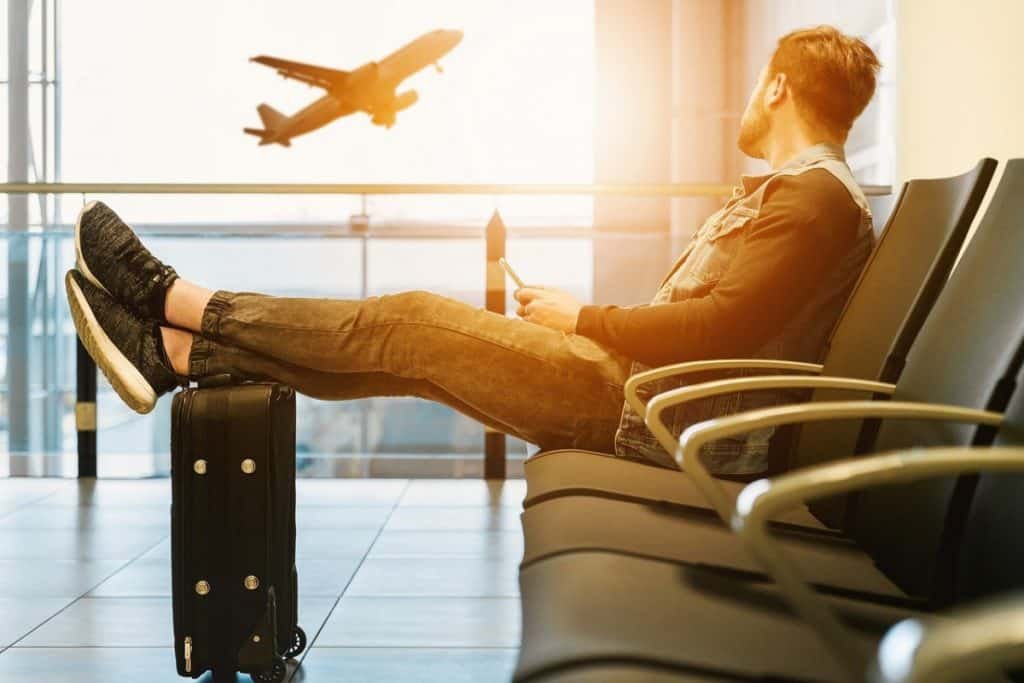
Pros of Traveling Around Brazil By Plane
Even having to show up at the airport 1 hour in advance before boarding, traveling by plane is still the fastest way to travel. Usually, I think that any distance under 300 miles is bearable to withstand on a bus, but if you don’t have that much time to spare, getting on a plane is always the best choice.
More Variety in Destinations
Let’s face it, traveling by plane allows you to visit a number of places that wouldn’t be possible by land , especially if we’re maybe talking about traveling to other countries in South America. While buses can only get you so far, boarding a plane can get you almost anywhere, or at least, to the majority of tourist cities and places across the Brazilian territory.
Airport Structure
Even though located mostly afar from the urban centers, most Brazilan airports have a pretty neat infrastructure, with lots of choices on restaurants, leisure, and fresh facilities, like restrooms and nurseries.
These are certainly superior to those found in bus stations across the country, especially since the daily number of people that visit the latter is much higher than in airports. Oh, as we said before, prices are considerably higher too!
Cons of Traveling Around Brazil By Plane
High ticket prices.
Obviously, the biggest con of traveling by plane is that the airfare is one of the biggest expenses of the trip , alongside accommodations. Even local flights in Brazil are expensive, which is why local citizens do their best to plan their trips ahead, as you can get way better prices by buying your tickets earlier.
Luggage Limitations
While traveling by bus or car allows you to bring a much larger amount of luggage, boarding a plane could make you want to pack lighter.
The dispatching rules in Brazil have changed in the last few years, limiting the passenger to board only with a handbag, which must weigh 22lbs (10kg) or less . If it exceeds the weight limit, it will be dispatched and charged separately.
Traveling Around Brazil By Car
Although flying is indeed necessary to come to Brazil, a lot of people aren’t keen on the idea of boarding in and out of planes every time they visit a new location. Aside from that, there are a few locations that are only accessible by car, so depending on the kind of trip you’re planning, renting one can be the best way to transport.
Before we move on to our topics, don’t forget to take a look at our Ultimate Guide for Driving in Brazil , as we highlight all laws, documentation requirements, and the major details you must know in regards to driving in the country.

Pros of Traveling By Car in Brazil
Passenger control.
Having only familiar people or acquaintances in the car is a major advantage for me, as it makes the trip much more personal and fun. It’s also a far cry from the ordinary bureaucracies at the airport or even at the bus stations, like standing in line to board or dispatching your luggage.
Still touching on the Covid-19 subject, traveling by car is also the safest way to travel nowadays, as you’re able to keep control of the people who’ll be joining your trip, as you can all agree to quarantine before hitting the road.
Not depending on a company with predetermined schedules to take you to places can really have its perks. You can make as many pitstops as you like, you can bring as much luggage as you like, and you won’t depend on Ubers or cabs to get you around once you arrive at your destination .
Driving can make your trip much more flexible, allowing you to explore your points of interest anytime your want.
Cons of Traveling By Car in Brazil
Higher risk of accidents.
Car accidents are amongst the top 3 causes of death in Brazil, and while on the road, things can sometimes get uglier than in the big city. That is because some drivers disregard the traffic safety rules, exceeding way over the speed limit or try to surpass slower drivers .
Aside from that, the pitstops are not always very welcoming, depending on where you are, so make sure to check for safe stops on your route before you hit the road.
Road Condition and Traffic
Another thing that could bother you driving is the condition of the road you’ll be taking to get to your destination. Some of the roads are in pretty bad shape, which could slow down your pace, and consequently, ruin some of the trips .
We went through the best roads to drive in Brazil in this post , so make sure you check more on that if you’re interested in learning more about where the best and safest roads are located in the country.
The traffic is another annoyance that you may face, Sometimes the most simple accident could lead to miles and miles of traffic , so be prepared for everything and have those emergency playlists ready just in case!
Driving Can Be Very Tiresome
Getting behind the wheel and driving for 3+ hours maybe a piece of cake for some, but many people find spending too much time in a car very discomforting. Generally speaking, people are mostly OK with traveling distances like 300 miles or less, but anything over that is considered too much.
If you have more people with valid driver’s licenses joining you, this becomes way less of a burden, as the driver not only gets physically tired from steering the wheel for too long but also mentally and visually exhausted from paying attention to the road for that many hours .
That was it for our guide on the main ways of transportation in Brazil! While planning your trip, take all the topics we just went by under consideration and choose whatever works best for you!
While you’re here, I think we might interest you with these: 5 Vacation Ideas In Brazil For All Kinds Of Travelers – Interested in the tips of a local on how you can enjoy your vacay in Brazil? Look no more! 9 Off-The-Beaten-Path Places To Visit In Brazil – Tired of the same suggestions? We’ve got just the right list for you! 10 Historical Places In Brazil You Need To Visit – Everything you need to know about the most prominent historical places to visit in Brazil!
Cover Photo Credit: Flickr | Trey Ratcliff
Related Questions
Is it possible to travel in brazil by train.
No, traveling throughout the Brazilian territory is not possible. The country’s train lines only meet the purposes of carrying the local population to destinations within that region, so it’s not possible to reach different cities or states by train as it is in Europe for example.
Bruno Reguffe
What's up, everyone! I'm Bruno, and I'm a nutritionist living in Rio de Janeiro. I've been a longtime friend of Ana's, and I'm excited to help her expand on all things Brazilian with y'all, as well as sharing some of our culture and a few personal experiences while living in the country!
Recent Posts
11 Best Neighborhoods to Stay/Live in Salvador (Bahia)
Salvador is the fourth most populated city in Brazil, as has been attracting more and more tourists interested in the local culture and paradisiac beaches. The city also houses many great...
X Best Neighborhoods To Visit/Live in Florianópolis
If you know about Florianópolis (in Santa Catarina), then you probably think that the city is all about beaches and tanning. Well, although that is indeed one of the city's main highlights,...

- Getting around Brazil: Transportation Tips
Book your individual trip , stress-free with local travel experts
Select Month
- roughguides.com
- South America
- getting-around
- Travel guide
- Itineraries
- Local Experts
- Travel Advice
- Accommodation
Plan your tailor-made trip with a local expert
Book securely with money-back guarantee
Travel stress-free with local assistance and 24/7 support
Just wanted to say that it was incredible. Trip Provider was also incredibly good, and really made their best effort to solve any problems. We were very im...
Local travel in Brazil is always easy. Public transport outside of the Amazon is generally by bus or plane, though there are a few passenger trains, too. However you travel, services will be crowded, plentiful and, apart from planes, fairly cheap. Car rental is possible, but driving in Brazil is not for the faint-hearted. Hitchhiking, over any distance, is not recommended.
By ferry and boat
Amazon riverboats, travel ideas for brazil, created by local experts.

9 days / from 2042 USD
Brazilian Beaches: Copacabana, Botafogo and more
Begin at Foz do Iguaçu, where you will stand in awe of the huge Iguaçu Falls. Next up, we'll head to the lively city of Rio de Janeiro, home of the legendary Copacabana, Botafogo and Flamengo beaches, and of course, Sugar Loaf Mountain and the iconic Christ the Redeemer statue.

10 days / from 1700 USD
Blissful Brazil
Welcome to a lavish journey that marries adventure with style, featuring stays in carefully chosen four-star hotels. This reinvigorating trip will have you sightseeing in São Paulo, gazing at the spectacular Foz do Iguaçu falls and relaxing on Rio's finest beaches before you know it.

10 days / from 2683 USD
Breathtaking Brazil: Rio, Beaches and Waterfalls
Explore the lively city of Rio de Janeiro, home to Ipanema and Copacabana beaches; experience the stunning Foz do Iguaçu National Park and see the world’s largest waterfalls system; immerse yourself in cultural Salvador, the magnificent former capital of Portugal’s New World colony.
It’s hardly surprising that a country the size of Brazil relies on air travel a good deal; in some parts of Amazônia, air links are more important than roads and rivers. Any town has at least an airstrip, and all cities have airports, usually some distance from the city but not always: Santos Dumont in Rio, Congonhas in São Paulo and Guararapes in Recife are all pretty central. The airports of Brasília, Congonhas and, above all, Guarulhos in São Paulo are chronically crowded, with long check-in lines. If flying internationally from Guarulhos, add at least an extra hour to account for the phenomenal queues to get through passport control, and don’t be surprised, on arrival, for it to take an hour or more to clear customs and immigration. If travelling with children, go straight to the front of the lines: families, pregnant women and seniors have priority.
When buying your international ticket, you should consider the possibility of adding an air pass , though note that the emergence of budget airlines in the country means that they now only make sense if you’re planning a series of long-haul trips – from the South to the Amazon and back via the Northeast, for example.
If Brazil is only one stop on a longer trip, consider the Mercosur Airpass , which covers eight airlines of Argentina, Brazil, Chile, Paraguay and Uruguay. The regulations are fairly complicated but the passes basically allow two stopovers per country (plus point of origin) up to a maximum of eight, although an extra stopover is allowed to give you use of both the Argentine and Brazilian airports at Iguaçu Falls. The route must include at least two countries, and the price of a pass is based on the number of miles flown, which always works out costing far less than purchasing regular tickets. Prices may be affected by the time of year that you travel.
If Brazil is your only destination, the TAM Air Pass can be a huge moneysaver. It is valid for thirty days from the first flight and costs US$530 for four flights if bought together with a TAM international flight, US$700 if you fly with another carrier. Additional flights are around US$150 each, much cheaper than you are likely to pay if you book a flight yourself within Brazil.
Lastly, if you have an air pass and change the time or date of your flight, always remember to cancel the original flight . If you don’t, the computer flags you as a no-show, and all your other air-pass reservations will also be cancelled.
Budget airlines
A recent phenomenon in Brazil is the appearance of budget airlines, of which the biggest is GOL ; others include Webjet and Azul , which started operating in 2009. GOL has an extensive network, cheap seats, is efficient and usually much better value than TAM – though, irritatingly, American Express is the only foreign credit-card that’s accepted on its website. In Brazilian holiday periods (July, around Xmas, and Carnaval) flights are often booked up and you need to book as far in advance as you can. Outside these times, if you can be a little flexible on dates and if the TAM airpass does not meet your needs, your cheapest strategy would be to book tickets with Gol after arriving in Brazil at a Gol desk in an airport.
Flying to the Northeast or Amazônia from the South can be tiresome, as many of these long-distance routes are no more than glorified bus runs, stopping everywhere before heading north. In planning your itinerary, it’s a good idea to check carefully how many times a plane stops – for example, between São Paulo and Fortaleza, a flight may stop as many as four times or as few as once.
There are safety issues to consider when flying in the Amazon, where investigations following a recent series of crashes revealed serious problems in a number of regional airlines, notably Rico . Where possible, stick to Gol and TAM when flying around the Amazon. In many parts of Amazônia, air travel in small planes, or aerotaxis , is very common – the regional word for these flights is teco-teco . Before taking one, you should be aware that the airstrips are often dangerous, the planes routinely fly overloaded and are not reliably maintained, and no checks are made on the qualifications of pilots – some don’t have any.
Prices are reasonable in the South and Northeast but climb steeply as soon as the Amazon is involved, where a return flight from Rio or São Paulo can often be scarily similar to the cost of a flight to Miami. It’s always much cheaper to buy internal tickets linked to your international flights if you plan on heading to the Amazon from Rio or São Paulo. If you are flying outside holiday periods in Brazil (July & Dec–March) and you’re not heading to the Amazon, you will probably get a cheaper deal buying a ticket in Brazil after you arrive.
You probably won’t be taking many trains in Brazil. Although there’s an extensive rail network, most of it is for cargo only, and even where there are passenger trains they’re almost invariably slower and less convenient than the buses. Exceptions are the metrô rail systems in Porto Alegre, Rio, São Paulo and Brasília and a few tourist journeys worth making for themselves, especially in the South and Minas Gerais.
The bus system in Brazil is excellent and makes travelling around the country easy, comfortable and economical, despite the distances involved. Inter-city buses leave from a station called a rodoviária , usually built on city outskirts.
Buses are operated by hundreds of private companies, but prices are standardized, even when more than one firm plies the same route, and are reasonable: Rio to São Paulo is around R$80, to Belo Horizonte R$75, to Foz do Iguaçu R$200 and to Salvador R$240, while São Paulo to Brasília is around R$150. Long-distance buses are comfortable enough to sleep in, and have on-board toilets (which can get smelly on long journeys): the lower your seat number, the further away from them you’ll be. Buses stop every two or three hours at well-supplied postos , but as prices at these are relatively high it’s not a bad idea to bring along water and some food. Some bus companies will supply meal vouchers for use at the postos on long journeys.
There are luxury buses, too, called leitos , which do overnight runs between the major cities – worth taking once for the experience, with fully reclining seats in curtained partitions, freshly ironed sheets and an attendant plying insomniacs with coffee and conversation. They cost about a third of the price of an air ticket, and twice as much as a normal long-distance bus; they’re also less frequent and need to be booked a few days in advance. No matter what kind of bus, it’s a good idea to have a light sweater or blanket during night journeys, as the air conditioning is often uncomfortably cold.
Going any distance, it’s best to buy your ticket at least a day in advance, from the rodoviária or, in some cities, from travel agents. An exception is the Rio–São Paulo route, where a shuttle service means you can always turn up without a ticket and never have to wait more than fifteen minutes. Numbered seats are provided on all routes: if you want a window, ask for janela . If you cross a state line, you will get a small form with the ticket, which asks for the number of your seat ( poltrona ), the number of your ticket ( passagem ), the number of your passport ( identidade ) and your destination ( destino ). You have to fill it in and give it to the driver before you’ll be let on board. Buses have luggage compartments, which are safe: you check pieces at the side of the bus and get a ticket for them. Keep an eye on your hand luggage, and take anything valuable with you when you get off for a halt.
Driving standards in Brazil hover between abysmal and appalling. The country has one of the highest death tolls from driving-related accidents in the world, and on any journey you can see why, with thundering trucks and drivers treating the road as if it were a Grand Prix racetrack. Fortunately, inter-city bus drivers are the exception to the rule: they are usually very good, and their buses usually have devices fitted that make it impossible for them to exceed the speed limit. Electronic speed traps are widely used everywhere, and if you get caught by one in a rental car, the fine will simply be added to your credit card. Since 2008, a zero-tolerance law has made it strictly illegal to drive after consuming any amount of alcohol, a response to the enormous death toll caused by drunk drivers. Offenders risk severe punishments if tests detect any alcohol in their blood – expect at least a hefty fine and the threat of imprisonment.
Road quality varies according to region: the South and Southeast have a good paved network; the Northeast has a good network on the coast but is poor in the interior; and roads in Amazônia are by far the worst, with even major highways closed for weeks or months at a time as they are washed away by the rains. Most cities are fairly well signposted, so getting out of town shouldn’t be too difficult; if city traffic is daunting, try to arrange to collect your car on a Sunday when traffic is light. If at all possible, avoid driving at night because potholes (even on main roads) and lombadas (speed bumps) may not be obvious, and breaking down after dark could be dangerous. Outside the big cities, Brazilian roads are deathtraps at night; poorly lit, in bad condition and lightly policed. Especially worth avoiding at night are the Via Dutra , linking Rio and São Paulo, because of the huge numbers of trucks and the treacherous ascent and descent of the Serra do Mar, and the Belém–Brasília highway , whose potholes and uneven asphalt make it difficult enough to drive even in daylight. Where possible, avoid driving after dark in the Mato Grosso and Amazon regions as well; though rare, armed roadside robberies have been known to happen there.
An international driving licence is useful: although foreign licences are accepted for visits of up to six months, you may have a hard time convincing a police officer of this. Outside of the towns and cities, service stations can be few and far between, so keep a careful eye on the fuel gauge. Service stations sell both petrol ( gasolina ) and ethanol ( álcool ), with new cars (including rentals) usually capable of running on either fuel. Álcool is considerably cheaper than gasolina , and there’s no longer a noticeable difference in terms of performance. Service stations in rural areas do not always accept international credit cards, so make sure you have sufficient cash on a long trip. In urban areas, plastic is universally accepted at petrol stations, although a common scam is to charge around twenty percent more per litre when payment is made by credit card rather than cash: always check in advance whether there is a price difference if you intend to pay by credit card.
Parking , especially in the cities, can be tricky due to security and finding a space, and it’s worth paying extra for a hotel with some kind of lock-up garage. A universal feature of city driving in Brazil is the flanelinha , named for the flannel that informal parking attendants wave at approaching cars; these attendants will help you into and out of parking spaces and guard your car, in return for a real or two. Brazilians will go to almost any lengths to avoid paying them, but they’re making a living and providing a service, so do the decent thing. In any event, never leave anything valuable inside the car.
Driving in Brazil is very different from northern Europe and the US. Do not expect Brazilians to pay much attention to lane markings, use indicators or worry about cutting you off or overtaking you on the inside. Use your rear and wing mirrors constantly when city driving. At night, you should cautiously roll through red lights in city centres or deserted-looking streets, to avoid assaltantes . And a crucial thing to know is that flashing lights from an oncoming car mean “I’m coming through – get out of the way” and NOT “please go ahead”, as in the UK and US. It sounds intimidating, and it is for the first couple of days, but it is surprising how quickly you get used to it.
Renting a car
Renting a car in Brazil is straightforward. Of the big-name international companies, Hertz and Avis are the most widely represented, with Budget and Dollar increasing their representation. There are also plenty of reliable Brazilian alternatives, such as Unidas, Interlocadora and Localiza. Car-rental offices ( locadoras ) can be found at every airport and in most towns regardless of size, although you will pay slightly more for airport pick-up and drop-off. Almost all cars in Brazil have manual gears; automatics are rare.
Rates start from around R$120 a day for a compact car (Fiat Punto or similar) including unlimited mileage; a basic air-conditioned model will start at around R$140, also including unlimited mileage. Four-wheel-drive vehicles are rare and extremely expensive. Prices don’t always include insurance – a comprehensive policy will cost an additional R$25 per day or so with a deductible of R$500. If you have a US credit card, you may find that it can be used to cover the additional liability – check before leaving home. In any case, a credit card is essential for making a deposit when renting a car. It’s not a bad idea to reserve a car before you arrive in Brazil, as you can be sure to get the best available rate.
As you would anywhere, carefully check the condition of the car before accepting it and pay special attention to the state of the tyres (including the spare), and make sure there’s a jack, warning triangle and fire extinguisher: the police will check for these if you get pulled over. All cars have front and back seatbelts; their use is compulsory, and stiff on-the-spot fines are imposed on drivers and front-seat passengers found not to be wearing them.
There are enormous numbers of taxis in Brazilian cities, and they’re very cheap, especially if there are two or more passengers. City cabs are metered, and have two rates: 1 is cheaper, 2 more expensive. The rate the taxi is using is indicated on the taximeter, after the fare. Rate 2 is automatic on trips to and from airports and bus stations in big cities, after 8pm, and all day Sunday and public holidays. Many cities give taxi drivers a Christmas bonus by allowing them to charge Rate 2 for the whole of December. Occasionally, drivers will refer to a sheet and revise the fare slightly upwards – they are not ripping you off, but referring to price updating tables that fill the gap until taximeters can be readjusted to reflect the official annual increases.
Taxis in small towns and rural areas do not often have meters, so it’s best to agree on the fare in advance – they’ll be more expensive than in the cities. Most airports and some bus stations are covered by taxi cooperatives, which operate under a slightly different system: attendants give you a coupon with fares to various destinations printed on it – you pay either at a kiosk in advance, or the driver. These are more expensive than regular taxis, but they’re reliable and often more comfortable. Tipping is not obligatory, but appreciated.
Water travel and ferries are also important forms of transport in parts of Brazil. Specific details are included in the relevant sections of the Guide, but look out for the ferry to Niterói, without which no journey to Rio would be complete; Salvador , where there are regular services to islands and towns in the huge bay on which the city is built; in the South between the islands of the Bay of Paranaguá; and most of all in Amazônia .
In Amazônia, rivers have been the main highways for centuries, and the Amazon itself is navigable to ocean-going ships as far west as Iquitos in Peru, nearly 3000km upstream from Belém.
In all the large riverside cities of the Amazon – notably Belém, Manaus and Santarém – there are hidroviárias, ferry terminals for waterborne bus services. Amazon river travel is slow and can be tough going, but it’s a fascinating experience. On bigger boats, there are a number of classes; in general, it’s better to avoid cabine, where you swelter in a cabin, and choose primeiro (first class) instead, sleeping in a hammock on deck. Segundo (second class) is usually hammock space in the lower deck or engine room. Wooden boats are much more comfortable than metal, but usually slower. Take plenty of provisions, and expect to practise your Portuguese.
The range of boat transport in the Amazon runs from luxury tourist boats and large three-level riverboats to smaller one- or two-level boats (the latter normally confining their routes to main tributaries and local runs) and covered launches operated by tour companies. The most popular route is the Belém–Manaus trip, which takes four to six days.
The Rough Guides to Brazil and related travel guides
In-depth, easy-to-use travel guides filled with expert advice.

Travel advice for Brazil
From travel safety to visa requirements, discover the best tips for traveling to Brazil
- Eating and drinking in Brazil
- How to get to Brazil
- Travel Tips Brazil for planning and on the go
Find even more inspiration here

- Travel Tips
written by Rough Guides Editors
updated 26.04.2021
Ready to travel and discover Brazil?
Get support from our local experts for stress-free planning & worry-free travels.
- Where to stay
- Travel advice

Our plans are also international plans.
Your phone just works when you arrive. no setup required..
With qualifying plans. Capable device required. Not for extended international use. Coverage not available in some areas. See plan for details. See full terms

NOW ON Go5G PLANS
Get high-speed data abroad.
With no international data-roaming charges.
With qualifying plans. In select countries. Not for extended international use. Coverage not available in some areas. See plan for details. See full terms
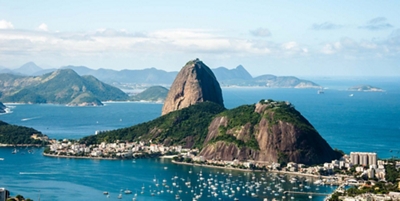
Go5G Next and Go5G Plus
5gb of high-speed data in 215+ countries & destinations..
Unlimited basic data, unlimited texting, and $0.25/min calling.
Up to 5GB high-speed data, then unlimited at up to 256 Kbps. See full terms
5GB of high-speed data in 11 European countries.
Unlimited basic data that’s 2x faster than before in 215+ countries & destinations, unlimited texting, and $0.25/min calling.
Up to 5GB high-speed data in select Central European countries; otherwise, basic speeds approximately 256 Kbps. See full terms

Which country or destination are you traveling to?
Speeds and device compatibility vary based on location and roaming partners’ network frequencies. Coverage not available in some areas; we are not responsible for our partners’ networks. Voice call destinations may be limited in some areas. Rates vary by plan and location.
Speeds vary based on roaming partners’ network; high-speeds not available in all locations. Maps do not depict exact coverage and display the general availability of roaming partner networks. Coverage not available in some areas. We are not responsible for the performance of our roaming partners’ networks. Voice call destinations may be limited in some areas. Simple Global Destinations: High-speed data, where available, may be included with qualifying plans or require purchase of international pass. Check your plan at www.T‑Mobile.com/customers/data-pass for details. Mobile Without Borders Destinations (Canada/Mexico): Up to 5GB of LTE speeds included with qualifying plans. Non-qualifying plans require purchase of high-speed data pass. Check www.T‑Mobile.com/customers/data-pass for details.

NEED INTERNATIONAL CALLING?
Boost your international plan with a data pass.
Get unlimited calling and even more high-speed data with daily, weekly, or monthly plan add-ons.
Qualifying plan required. See full terms
More benefits from departure to arrival.
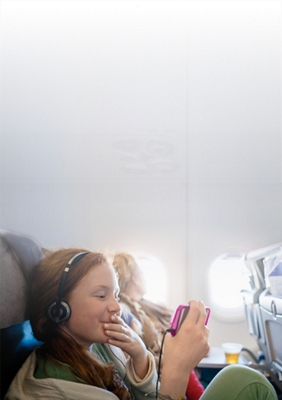
Stream, surf & text from 30,000 ft.
With qualifying plans. See full terms

Unlimited international calls for just $15/mo.
Call landlines in 70+ destinations and mobile lines in 30+ destinations. Qualifying service required. Get full terms

Explore all travel benefits.

Save up to 40% on travel.
Visit T‑Mobile TRAVEL site for details. See full terms

Got questions about international roaming?
- Up to 5GB of high-speed data in 215+ countries and destinations: Go5G Next, Go5G Next Military, Go5G Next 55, Go5G Next First Responders, Go5G Next Puerto Rico, Go5G Next DHH, Go5G Business Next, Go5G Military Business Next, Go5G First Responder Business Next, Go5G Puerto Rico Business Next, Go5G DHH Business Next, Go5G Plus™, Go5G Plus Military, Go5G Plus 55+, Go5G Plus First Responder, Go5G Plus DHH, Go5G Business Plus, Go5G Military Business Plus, Go5G First Responder Business Plus, Business Unlimited Ultimate+, Go5G Puerto Rico Business Plus, Go5G DHH Business Plus, Magenta ® MAX (including 55+, Military, and First Responder), Magenta ® Plus, Magenta ® MAX for Business, ONE Plus, Business Unlimited Ultimate, and Magenta ® Amplified.
- Up to 5GB of high-speed data in 11 European countries: Go5G™, Go5G Military, Go5G 55+, Go5G First Responder, Go5G DHH, Go5G Business, Go5G Military Business, Go5G First Responder Business, Go5G Puerto Rico Business, Go5G DHH Business, Magenta ® (including 55+, Military, and First Responder), Magenta ® Deaf or Hard of Hearing, Business Unlimited Select, Business Unlimited Advanced, and Magenta ® for Business. Simple Choice, Select Choice, and ONE plans are also included.
- Unlimited data speeds up to 256kbps: Go5G™, Go5G Military, Go5G 55+, Go5G First Responder, Go5G DHH, Go5G Business, Go5G Military Business, Go5G First Responder Business, Go5G Puerto Rico Business, Go5G DHH Business, Go5G Plus™, Go5G Plus Military, Go5G Plus 55+, Go5G Plus First Responder, Go5G Plus DHH, Go5G Business Plus, Go5G Military Business Plus, Go5G First Responder Business Plus, Business Unlimited Ultimate+, Go5G Puerto Rico Business Plus, Go5G DHH Business Plus, Magenta ® , Magenta ® MAX, Magenta 55+, Magenta ® MAX 55+, Magenta ® First Responder, Magenta ® MAX First Responder, Magenta ® Military, Magenta ® MAX Military, Magenta ® Deaf or Hard of Hearing, Magenta ® MAX Deaf or Hard of Hearing, Magenta ® Amplified, Business Unlimited Select, Business Unlimited Advanced, Business Unlimited Ultimate, Magenta ® for Business, and Magenta ® MAX for Business rate plans. Simple Choice, Select Choice, and ONE plans are also included.
Everyone on a T-Mobile Essentials™ plan gets unlimited texting and calling at $0.25 per minute in 215+ countries and destinations.
Essentials™ plans get free texting in 215+ countries and destinations. If you need data, purchase International Passes to get high-speed data and unlimited calling for 1, 10, or 30 days.
If you’re a T-Mobile customer on qualifying plan, you can add an International Pass to get more high-speed data and unlimited voice calling in 215+ countries and destinations.
- 1-Day (512MB) International Pass: 512MB of high-speed data and unlimited calling, to be used up to 24 hours, for $5.
- 10 day (5GB) International Pass: 5GB of high-speed data and unlimited calling, to be used up to 10 days, for $35.
- 30 Day (15GB) International Pass: 15GB of high-speed data and unlimited calling, to be used up to 30 days, for $50.
Use your International Pass high-speed data however you’d like throughout the designated time. You’re not restricted to a certain amount of data per day.
If you’re a primary account holder or authorized user, get an International Pass by using your T-Mobile app, logging on to My.T-Mobile.com, or following the link in the welcome text message you get when you enter an eligible country. Also, you can call our Team of Experts ® before your trip by dialing 611 on your mobile device.
Click here to see if you’re traveling to one of the 215+ countries that gets free data and texting as part of your eligible plan.
You can check your cruise coverage here . We recommend that you turn off roaming while the ship is docked in a US port. Otherwise, your phone may pick up the ship's network, and you'll be charged cruise ship roaming charges for any usage. Once you're out to sea, you can turn roaming back on and pay for the data, text, and voice you use.
International roaming is a service allowing you to continue using your mobile phone or other mobile device to browse the internet, as well as send and receive: emails, voice calls, and text messages while visiting another country.
The price you pay for Wi-Fi calls to international numbers when you're outside the US, depends on your international roaming option. The good news is, with most of our international roaming add-ons, you'll pay less for these calls than you did before. All Wi-Fi calls to US numbers are free of charge.
Our most popular plans include international texting from home and while traveling. Click here to see if you’re traveling to one of the 215+ countries and destinations that gets data and texting as part of your eligible plan.
Great news, while roaming internationally, you won't be charged for voicemails left in your inbox if your phone remains powered off or in airplane mode. However, you will be charged for the following:
- If you answer an incoming call, you will be charged for the duration of the call.
- If your phone is on when you get an incoming call, even if you don't answer it and it goes to voicemail, the call is charged one minute for the call coming into the phone, based on the international roaming rate of the country you’re in. (There are no charges at all if your phone is turned off.)
- If you call your voicemail from your mobile phone to listen to messages while traveling internationally, that call will be charged at the international roaming rate of the country you're in.
Check out our international roaming checklist for everything you need to know before traveling abroad.
If you are a T-Mobile customer on qualifying plan, we have you covered with free data and texting in 215+ countries. There are some countries in which international roaming benefits do not apply, and international data passes cannot be used, you can check the list of those countries here .
A Virtual Private Network (VPN), is a way to help keep your connection secure, even while traveling. Be aware, that while on Wi-fi and connected to a VPN, your Internet usage goes through the VPN network you are connected to, wherever it's located. This means that while connected to a U.S. based VPN network, Wi-Fi calls made to non-US numbers, while outside the U.S., will be charged at international long-distance rates. See more details here .
Heads up! Many VPN services may connect automatically, or even be included in other services such as AdBlockers.
Qualifying plan and capable device required. Not for extended international use; you must reside in the US and primary usage must occur on our network before international use. Device must register on our network before international use. Service may be terminated or restricted for excessive roaming. Coverage not available in some areas; we are not responsible for our partners’ networks.
Calls, including over Wi-Fi, are $.25/min. (no charge for Wi-Fi calls to US, Mexico, and Canada). Go5G plans: Up to 10GB high-speed data in select Central European countries; otherwise, standard speeds approximately 256 Kbps. Go5G Next and Go5G Plus: Up to 15GB high-speed data in 215+ countries and destinations, then unlimited at up to 256 Kbps. Additional charges apply in excluded destinations; see www.T‑Mobile.com for included destinations (subject to change at T‑Mobile's discretion). Qualifying postpaid plan and capable device required. Taxes additional; usage taxed in some countries. Voice and text features for direct communications between two people. Communications with premium-rate (e.g., 900, entertainment, high-rate helpline) numbers not included. Not for extended international use; you must reside in the US and primary usage must occur on our network . Device must register on our network before international use. Service may be terminated or restricted for excessive roaming. Coverage not available in some areas; we are not responsible for our partners’ networks.
Calls in 215+ countries and destinations, including over Wi-Fi, are $.25/min. (no charge for Wi-Fi calls to US, Mexico, and Canada). Up to 5GB high-speed data, then unlimited at up to 256 Kbps. Additional charges apply in excluded destinations; see www.T‑Mobile.com for included destinations (subject to change at T‑Mobile's discretion). Qualifying postpaid plan and capable device required. Taxes additional; usage taxed in some countries. Voice and text features for direct communications between two people. Communications with premium-rate (e.g., 900, entertainment, high-rate helpline) numbers not included. Not for extended international use; you must reside in the US and primary usage must occur on our network. Device must register on our network before international use. Service may be terminated or restricted for excessive roaming. Coverage not available in some areas; we are not responsible for our partners’ networks.
Calls, including over Wi-Fi, are $.25/min. (no charge for Wi-Fi calls to US, Mexico, and Canada). Up to 5GB high-speed data in select Central European countries; otherwise, standard speeds approximately 256 Kbps. Additional charges apply in excluded destinations; see www.T‑Mobile.com for included destinations (subject to change at T‑Mobile's discretion). Qualifying postpaid plan and capable device required. Taxes additional; usage taxed in some countries. Voice and text features for direct communications between two people. Communications with premium-rate (e.g., 900, entertainment, high-rate helpline) numbers not included. Not for extended international use; you must reside in the US and primary usage must occur on our network. Device must register on our network before international use. Service may be terminated or restricted for excessive roaming. Coverage not available in some areas; we are not responsible for our partners’ networks.
Qualifying plan required. Speeds and coverage vary based on device and location. Check www.T‑Mobile.com for details. After allotment, data slows to plan speed (up to 128Kbps for plans without international data service). Activating a new pass ends remaining benefits of prior pass. Usage rounded up to the nearest MB each session.
Qualifying plan. On US-based airlines; Wi-Fi Calling functionality, valid e911 address, and one prior Wi-Fi call with current SIM card required for messaging. Where available on select US airlines.
International calling from U.S./Canada/Mexico to landlines in over 70 countries and destinations, plus unlimited calling to mobiles in over 30 countries. Qualifying service required. Calls must originate on our U.S. network or in Canada/Mexico; otherwise international roaming rates apply. Must be direct communication between 2 people; certain numbers not included. See T‑Mobile.com for countries and rates; subject to change at our discretion.
Receive up to 40% off available accommodation bookings in the US including AK, HI, Puerto Rico, and US Virgin Islands and bookings for international travel. Discount is applied to price of room before taxes and any fees, including additional fees collected by the property at check-in. Reservations can only be made up to eleven months in advance of stay and are based on availability. All reservations are subject to the terms of the property and may not be able to be refunded, see individual location for details. Not valid for existing reservations, or with any other promotion, offer, discount, or coupon.
Receive up to 40% off pre-paid ("Pay Now") rental cars. Pay Now savings up to 30% discount is automatically applied to the Pay Now price if you select a Pay Now rental option. Up to 10% T‑Mobile Exclusive discount automatically applied to select Pay Now vehicle rentals. Discounted pricing is displayed at the time of booking compared to equivalent Pay Local/Later prices. Reservations can only be made up to twelve months in advance. Pay Now rates and vehicles based on availability. All reservations are subject to the terms of the supplier and may not be able to be refunded; see individual supplier for details. Not valid on existing car rental reservations, or with any other promotion, offer, discount, or coupon.
We've detected unusual activity from your computer network
To continue, please click the box below to let us know you're not a robot.
Why did this happen?
Please make sure your browser supports JavaScript and cookies and that you are not blocking them from loading. For more information you can review our Terms of Service and Cookie Policy .
For inquiries related to this message please contact our support team and provide the reference ID below.

NFL News: Why Brazil NFL Game Tickets Are Breaking The Bank, Breaking Down Every Cost
I f you’re a die-hard fan of the Philadelphia Eagles or the Green Bay Packers, you might want to start saving now. The NFL has announced jaw-dropping ticket prices for their first international game of 2024, set to take place in São Paulo, Brazil. This game marks a significant moment for the NFL, but the price tag may leave many fans feeling more pain than excitement.
Soaring Ticket Prices: A New Normal for NFL Fans?
According to USA Today, the average cost of an NFL ticket last year was $377, a sharp increase from $235 in 2022. This year, many NFL teams, including the Detroit Lions, have announced significant hikes in ticket prices, with some tickets seeing an 85% increase. However, the cost to see the Eagles and Packers face off in Brazil sets a new standard for high prices.
Breaking Down the Costs: What Fans Can Expect to Pay
In an email from NFL.com, fans of the Eagles and Packers were given the chance to purchase tickets for the historic game. But the prices might give even the most dedicated fans pause. Here’s a breakdown of the staggering costs:
Game Ticket Only: $1,545
Fans can expect to spend a hefty amount just for entry. This price includes “pregame hospitality,” but the seating arrangement is far from equal. Packers fans will have lower-level end-zone tickets, while Eagles fans are relegated to the upper regions of Corinthians Arena. How do you say, “Lambeau Leap” in Portuguese?
Three-Night Hotel Stay and Single Game Ticket: $3,500-$3,540
Eagles fans staying at Hotel Melia Paulista will enjoy game day transportation and three nights at the hotel. Packers fans will pay slightly more to stay at Hotel Jardim . The additional $40 might be seen as a minor penalty for getting those coveted end-zone seats.
Airfare, Four-Night Hotel Stay and Single Game Ticket: $5,450-$5,730
For those traveling from the U.S., airfare is included. Eagles fans flying from Newark Liberty International Airport in New Jersey catch a slight break on costs compared to Packers fans traveling through Chicago’s O’Hare International Airport.
Extras: $3,040
Fans looking to extend their stay can spend an additional $3,040 for a three-day, two-night trip to Rio De Janeiro. This includes visits to iconic landmarks like Christ the Redeemer and the Dona Marta Observatory.
A Pricey Commitment for NFL’s Loyal Fan Bases
For two of the NFL’s most passionate fan bases, this game in Brazil represents a significant investment. The unique experience of watching their teams play in an international setting might justify the expense for some, but the prices are undoubtedly steep.
Will the Game Live Up to the Hype?
The historic nature of the Eagles-Packers game in Brazil will undoubtedly generate excitement. However, with such high costs, fans will be hoping for a memorable match that justifies the financial outlay. Only time will tell if the experience is worth the price, but for now, fans are left to weigh the cost against their love for the game.
For those planning to make the journey, it’s a chance to be part of NFL history. For others, it might be a sobering reminder of the growing expense associated with being a sports fan today.

- Best overall
- Best for exotic trips
- Best for trip interruption
- Best for medical-only coverage
- Best for family coverage
- Best for long trips
- Why You Should Trust Us
Best International Travel Insurance for June 2024
Affiliate links for the products on this page are from partners that compensate us (see our advertiser disclosure with our list of partners for more details). However, our opinions are our own. See how we rate insurance products to write unbiased product reviews.
If you're planning your next vacation or trip out of the country, be sure to factor in travel insurance. Unexpected medical emergencies when traveling can drain your bank account, especially when you're traveling internationally. The best travel insurance companies for international travel can step in to provide you with peace of mind and financial protection while you're abroad.
Best International Travel Insurance
- Best overall: Allianz Travel Insurance
- Best for exotic travel: World Nomads Travel Insurance
- Best for trip interruption coverage: C&F Travel Insured
Best for medical-only coverage: GeoBlue Travel Insurance
- Best for families: Travelex Travel Insurance
- Best for long-term travel: Seven Corners Travel Insurance
How we rate the best international travel insurance »
Compare the Best International Travel Insurance Companies
As a general rule, the most important coverage to have in a foreign country is travel medical insurance , as most US health insurance policies don't cover you while you're abroad. Without travel medical coverage, a medical emergency in a foreign country can cost you. You'll want trip cancellation and interruption coverage if your trip is particularly expensive. And if you're traveling for an extended period of time, you'll want to ensure that your policy is extendable.
Here are our picks for the best travel insurance companies for international travel.
Best overall: Allianz
- Check mark icon A check mark. It indicates a confirmation of your intended interaction. Good option for frequent travelers thanks to its annual multi-trip policies
- Check mark icon A check mark. It indicates a confirmation of your intended interaction. Doesn't increase premium for trips longer than 30 days, meaning it could be one of the more affordable options for a long trip
- Check mark icon A check mark. It indicates a confirmation of your intended interaction. Some plans include free coverage for children 17 and under
- Check mark icon A check mark. It indicates a confirmation of your intended interaction. Concierge included with some plans
- con icon Two crossed lines that form an 'X'. Coverage for medical emergency is lower than some competitors' policies
- con icon Two crossed lines that form an 'X'. Plans don't include coverage contact sports and high-altitude activities
- Single and multi-trip plans available
- Trip cancellation and interruption coverage starting at up to $10,000 (higher limits with more expensive plans)
- Preexisting medical condition coverage available with some plans
Allianz Travel Insurance offers the ultimate customizable coverage for international trips, whether you're a frequent jetsetter or an occasional traveler. You can choose from an a la carte of single or multi-trip plans, as well as add-ons, including rental car damage, cancel for any reason (CFAR) , adventure sport, and business travel coverage. And with affordable pricing compared to competitors, Allianz is a budget-friendly choice for your international travel insurance needs.
The icing on the cake is Allyz TravelSmart, Allianz's highly-rated mobile app, which has an average rating of 4.4 out of five stars on the Google Play store across over 2,600 reviews and 4.8 out of five stars from over 22,000 reviews on the Apple app store. So, you can rest easy knowing that you can access your policy and file claims anywhere in the world without a hassle.
Read our Allianz Travel Insurance review here.
Best for exotic trips: World Nomads
- Check mark icon A check mark. It indicates a confirmation of your intended interaction. Coverage for 200+ activities like skiing, surfing, and rock climbing
- Check mark icon A check mark. It indicates a confirmation of your intended interaction. Only two plans to choose from, making it simple to find the right option
- Check mark icon A check mark. It indicates a confirmation of your intended interaction. You can purchase coverage even after your trip has started
- con icon Two crossed lines that form an 'X'. If your trip costs more than $10,000, you may want to choose other insurance because trip protection is capped at up to $10,000 (for the Explorer plan)
- con icon Two crossed lines that form an 'X'. Doesn't offer coverage for travelers older than 70
- con icon Two crossed lines that form an 'X'. No Cancel for Any Reason (CFAR) option
- Coverage for 150+ activities and sports
- 2 plans: Standard and Explorer
- Trip protection for up to $10,000
- Emergency medical insurance of up to $100,000
- Emergency evacuation coverage for up to $500,000
- Coverage to protect your items (up to $3,000)
World Nomads Travel Insurance offers coverage for over 150 specific activities, so you can focus on the adventure without worrying about gaps in your coverage.
You can select its budget-friendly standard plan, starting at $79. Or if you're an adrenaline junkie seeking more thrills, you can opt for the World Nomads' Explorer plan for $120, which includes extra sports like skydiving, scuba diving, and heli-skiing. And World Nomads offers 24/7 assistance, so you can confidently travel abroad, knowing that help is just a phone call away.
Read our World Nomads Travel Insurance review here.
Best for trip interruption: C&F Travel Insured
- Check mark icon A check mark. It indicates a confirmation of your intended interaction. Offers 2 major plans including CFAR coverage on the more expensive option
- Check mark icon A check mark. It indicates a confirmation of your intended interaction. Cancellation for job loss included as a covered reason for trip cancellation/interruption (does not require CFAR coverage to qualify)
- Check mark icon A check mark. It indicates a confirmation of your intended interaction. Frequent traveler reward included in both policies
- Check mark icon A check mark. It indicates a confirmation of your intended interaction. Up to $1 million in medical evacuation coverage available
- con icon Two crossed lines that form an 'X'. Medical coverage is only $100,000
- con icon Two crossed lines that form an 'X'. Reviews on claims processing indicate ongoing issues
- C&F's Travel Insured policies allow travelers customize travel insurance to fit their specific needs. Frequent travelers may benefit from purchasing an annual travel insurance plan, then adding on CFAR coverage for any portions of travel that may incur greater risk.
C&F Travel Insured offers 100% coverage for trip cancellation, up to 150% for trip interruption, and reimbursement for up to 75% of your non-refundable travel costs with select plans. This means you don't have to worry about losing your hard-earned money on non-refundable travel costs if your trip ends prematurely.
Travel Insured also stands out for its extensive "reasons for cancellation" coverage. Unlike many insurers, the company covers hurricane warnings from the National Oceanic and Atmospheric Administration (NOAA).
Read our C&F Travel Insured review here.
- Check mark icon A check mark. It indicates a confirmation of your intended interaction. A subsidary of Blue Cross Blue Shield
- Check mark icon A check mark. It indicates a confirmation of your intended interaction. Offers strong medical plans as long as you have a regular health insurance plan, but it doesn't have to be through Blue Cross
- Check mark icon A check mark. It indicates a confirmation of your intended interaction. Offers long-term and multi-trip travel protection
- con icon Two crossed lines that form an 'X'. Multiple complaints about claims not being paid or being denied
- con icon Two crossed lines that form an 'X'. Does not provide some of the more comprehensive coverage like CFAR insurance
- con icon Two crossed lines that form an 'X'. Buyers who do get claims paid may need to file multiple claim forms
GeoBlue Travel Insurance offers policies that covers emergency medical treatments when you're abroad. While GeoBlue lacks trip cancellation coverage, that allows it to charge lower premiums than the other companies on this list.
GeoBlue plans can cover medical expenses up to $1 million with several multi-trip annual plans available. It offers coinsurance plans for trips within the U.S. and 100% coverage for international trips. It also has a network of clinics in 180 countries, streamlining the claims process. It's worth noting that coverage for pre-existing conditions comes with additional costs.
Read our GeoBlue Travel Insurance review here.
Best for family coverage: Travelex Travel Insurance
Trip cancellation coverage for up to 100% of the trip cost and trip interruption coverage for up to 150% of the trip cost
- Check mark icon A check mark. It indicates a confirmation of your intended interaction. Options to cover sports equipment
- Check mark icon A check mark. It indicates a confirmation of your intended interaction. Option to increase medical coverage
- Check mark icon A check mark. It indicates a confirmation of your intended interaction. Can cancel up to 48 hours before travel when CFAR option is purchased
- Check mark icon A check mark. It indicates a confirmation of your intended interaction. Affordable coverage for budget-conscious travelers
- Check mark icon A check mark. It indicates a confirmation of your intended interaction. Includes generous baggage delay, loss and trip delay coverage
- Check mark icon A check mark. It indicates a confirmation of your intended interaction. Optional "adventure sports" bundle available for riskier activities
- con icon Two crossed lines that form an 'X'. Only two insurance plans to choose from
- con icon Two crossed lines that form an 'X'. Medical coverage maximum is low at up to $50,000 per person
- con icon Two crossed lines that form an 'X'. Pricier than some competitors with lower coverage ceilings
- con icon Two crossed lines that form an 'X'. Some competitors offer higher medical emergency coverage
Travelex travel insurance is one of the largest travel insurance providers in the US providing domestic and international coverage options. It offers a basic, select, and America option. Read on to learn more.
- Optional CFAR insurance available with the Travel Select plan
- Trip delay insurance starting at $500 with the Travel Basic plan
- Emergency medical and dental coverage starting at $15,000
Travelex Travel Insurance offers coverage for your whole crew, perfect for when you're planning a family trip. Its family plan insures all your children 17 and under at no additional cost. The travel insurance provider also offers add-ons like adventure sports and car rental collision coverage to protect your family under any circumstance. Got pets? With Travelex's Travel Select plan, you can also get coverage for your furry friend's emergency medical and transportation expenses.
Read our Travelex Travel Insurance review here.
Best for long trips: Seven Corners
- Check mark icon A check mark. It indicates a confirmation of your intended interaction. Diverse coverage options such as CFAR, optional sports equipment coverage, etc.
- Check mark icon A check mark. It indicates a confirmation of your intended interaction. Available in all 50 states
- con icon Two crossed lines that form an 'X'. Prices are higher than many competitors
- con icon Two crossed lines that form an 'X'. Reviews around claims processing are mixed
- Trip cancellation insurance of up to 100% of the trip cost
- Trip interruption insurance of up to 150% of the trip cost
- Cancel for any reason (CFAR) insurance available
Seven Corners Travel Insurance offers specialized coverage that the standard short-term travel insurance policy won't provide, which is helpful if you're embarking on a long-term trip. You can choose from several plans, including the Annual Multi-Trip plan, which provides medical coverage for multiple international trips for up to 364 days. This policy also offers COVID-19 medical and evacuation coverage up to $1 million.
You also get the added benefit of incidental expense coverage. This policy will cover remote health-related services and information, treatment of injury or illness, and live consultations via telecommunication.
Read our Seven Corners Travel Insurance review here.
How to Find the Right International Travel Insurance Company
Different travelers and trips require different types of insurance coverage. So, consider these tips if you're in the market to insure your trip.
Determine your needs
Your needs for travel insurance will depend on the type of trip you're taking. You'll need to consider your destination and what you'll be doing there, either business, leisure, or adventure traveling. Policies covering adventure sports and activities will cost more. Longer, more expensive trips will also cost more.
Research the reputation of the company
When researching a company, you'll want to closely review the description of services. You'll want to see how claims are handled, any exceptions, and limitations.
You'll also want to look at the company's customer reviews on sites like Trustpilot, BBB, and Squaremouth, as this will provide insight on the quality of customer service and the claims process. You should also take note of whether companies respond to customer reviews.
Compare prices
You can get quotes through a company's website or travel insurance aggregators like InsureMyTrip and VisitorsCoverage. You'll need to be prepared to provide the following information about your trip:
- Trip destination(s)
- Travel dates
- Number of travelers
- Traveler(s) age/birthday
- State of residence
- Total trip cost
For companies that offer travel medical insurance, you'll also want to play around with the deductible options, as they can affect your policy premium.
Understanding International Travel Insurance Coverage Options
Travel insurance can be confusing, but we're here to simplify it for you. We'll break down the industry's jargon to help you understand what travel insurance covers to help you decide what your policy needs. Bear in mind that exclusions and limitations for your age and destination may apply.
Finding the Best Price for International Travel Insurance
Your policy cost will depend on several factors, such as the length of your trip, destination, coverage limits, and age. Typically, a comprehensive policy includes travel cancellation coverage costs between 5% and 10% of your total trip cost.
If you're planning an international trip that costs $4,500, you can expect to pay anywhere from $225 to $450 for your policy. Comparing quotes from multiple providers can help you find a budget-friendly travel insurance policy that meets your needs.
Why You Should Trust Us: How We Reviewed International Travel Insurance Companies
We ranked and assigned superlatives to the best travel insurance companies based on our insurance rating methodology . It focuses on several key factors, including:
- Policy types: We analyzed company offerings such as coverage levels, exclusions, and policy upgrades, taking note of providers that offer a range of travel-related issues beyond the standard coverages.
- Affordability: We recognize that cheap premiums don't necessarily equate to sufficient coverage. So, we seek providers that offer competitive rates with comprehensive policies and quality customer service. We also call out any discounts or special offers available.
- Flexibility: Travel insurance isn't one-size-fits-all. We highlight providers that offer a wide array of coverage options, including single-trip, multi-trip, and long-term policies.
- Claims handling: The claims process should be pain-free for policyholders. We seek providers that offer a streamlined process via online claims filing and a track record of handling claims fairly and efficiently.
- Quality customer service: Good customer service is as important as affordability and flexibility. We highlight companies that offer 24/7 assistance and have a strong record of customer service responsiveness.
We consult user feedback and reviews to determine how each company fares in each category. We also check the provider's financial rating and volume of complaints via third-party rating agencies.
Read more about how Business Insider rates insurance products here.
International Travel Insurance FAQs
The best insurance policy depends on your individual situation, including your destination and budget. However, popular options include Allianz Travel Insurance, World Nomads, and Travel Guard.
You should pay attention to any limitations regarding covered cancellations, pre-existing conditions, and adventure activities. For example, if you're worried you may have to cancel a trip for work reasons, ensure that you've worked at your company long enough to qualify for cancellation coverage, as that is a condition with some insurers. You should also see if your destination has any travel advisories, as that can affect your policy.
Typically, your regular health insurance won't cover you out of the country, so you'll want to make sure your travel insurance has adequate medical emergency coverage. Depending on your travel plans, you may want to purchase add-ons, such as adventure sports coverage, if you're planning on doing anything adventurous like bungee jumping.
Travel insurance is worth the price for international travel because they're generally more expensive, so you have more to lose. Additionally, your regular health insurance won't cover you in other countries, so without travel insurance, you'll end up paying out of pocket for any emergency medical care you receive out of the US.
You should purchase travel insurance as soon as possible after making payment on your trip. This makes you eligible for add-ons like coverage for pre-existing conditions and CFAR. It also mitigates the chance of any losses in the days leading up to your trip.
- Main content
- My View My View
- Following Following
- Saved Saved
Brazil's Congress advances bill to tax low-cost online orders
- Medium Text
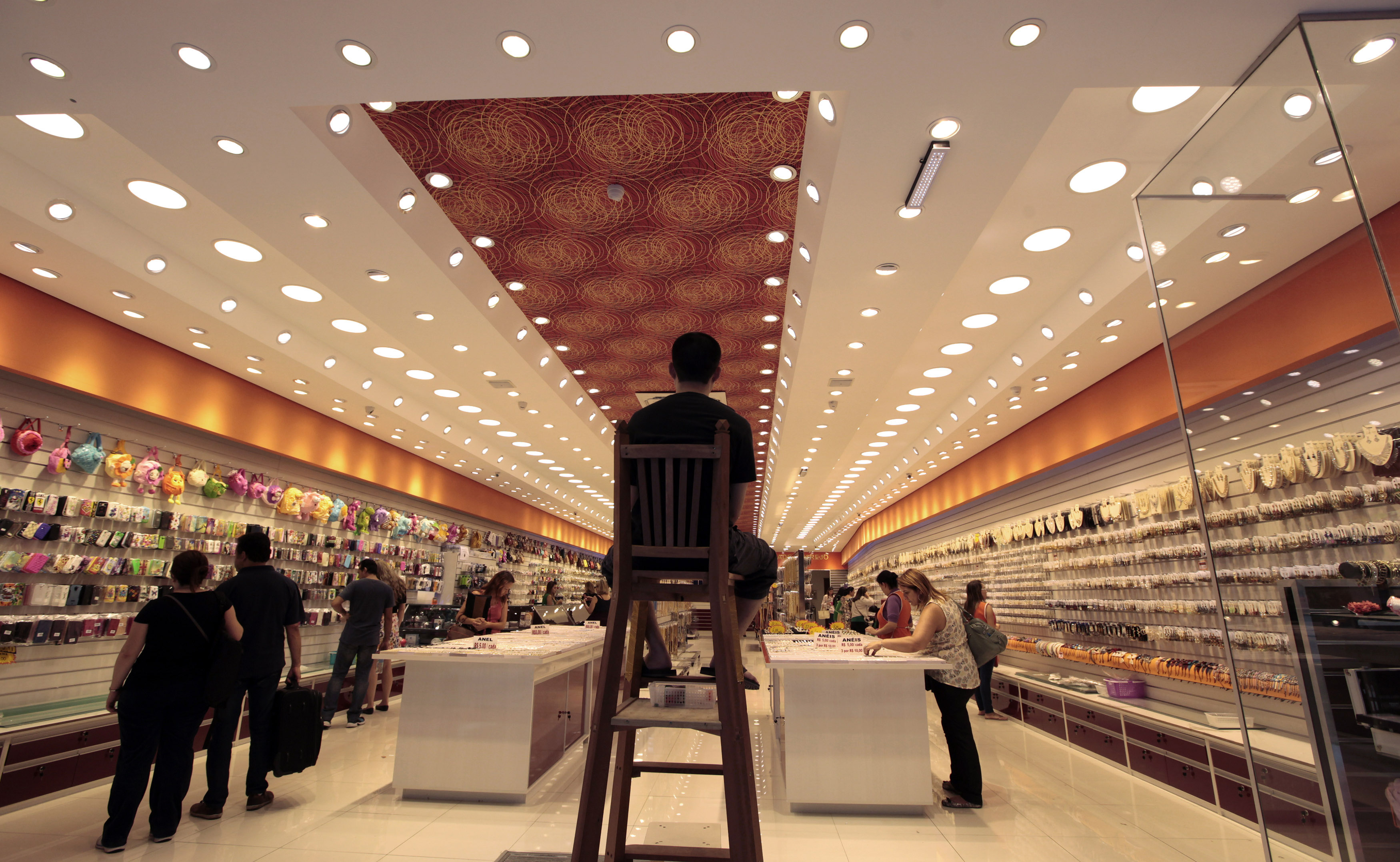
Sign up here.
Reporting by Maria Carolina Marcello in Brasilia; Writing by Andre Romani; Editing by Tom Hogue and David Alire Garcia
Our Standards: The Thomson Reuters Trust Principles. New Tab , opens new tab

Business Chevron

PREVIEW Global airline bosses to address geopolitical, climate challenges
Geopolitical tensions, aircraft shortages and ambitious environmental targets will deliver a host of challenges to global airline bosses at an annual summit next week, with softening fares completing a delicate outlook for carriers.


COMMENTS
While meal prices in Brazil can vary, the average cost of food in Brazil is $19 (R$100) per day. Based on the spending habits of previous travelers, when dining out an average meal in Brazil should cost around $7.74 (R$40) per person. Breakfast prices are usually a little cheaper than lunch or dinner.
Brazil Travel Costs. Accommodation - Brazil is a huge country (it's the 7th-largest in the world) and accommodation prices fluctuate from city to city and from season to season (with huge increases during Carnival). Prices in places like Rio de Janeiro and Salvador are pretty consistent, but for beachy destinations like Florianópolis ...
Average Trip to Brazil Cost in 2024. A week in Brazil costs around $2,100 for two people: Average Accommodation Cost: $50 per night. Average Flight Cost: $550 per person. Food, Drink & Activities: $30 per person, per day. Transportation: $10 per day. Total Cost: $2,100. Of course, how much you are going to spend depends a lot on the time of ...
Budget trip to Brazil cost: $55-70/day. While the average cost of living in Brazil is relatively high when considering local salaries-that is especially true in São Paulo and Rio de Janeiro -the average cost of a trip to Brazil can be very low. Thanks to the 4-to-1 exchange rate, you can easily travel to Brazil on a shoestring budget.
South America / Brazil /. Visitors to Brazil usually spend between $32 and $242 per day on average for one person and $64 to $483 for two people. While this is a wide range, the average daily cost averages $86 (R$435) per person. This average includes sightseeing, hotel, food, and local transportation expenses from other travelers.
The average cost for one person to visit Brazil for a week is $1,018-$2,243 ($145-$320 per day) Food, Travel, and Sightseeing: $29 to $59 per day for one person's daily expenses. Flights: $545 to $1,416 for economy. Lodging: $45 to $61 per night for one 2 or 3-star hotel room. or $57 to $69 per night for a 1-bed vacation rental.
The cost of round-trip tickets from major cities to Brazil can range from $1000 to $3000 for economy class, $1500 to $4000 for premium economy, and $3000 to $8000 or more for business class. Remember, these prices are just a general range and can vary depending on the factors mentioned earlier.
Brazil Travel Costs. Let's take a look at the typical costs that you'll be spending on a day to day basis in Brazil. Remember these can and will vary depending on where you are! For example areas along the north of Brazil tend to be much cheaper than popular districts in the south such as Copacabana and Vila Madalena. Average Dorm Bed = £7-13
With an average cost of about $165 USD per day, two weeks in Brazil at a luxury budget will cost you around $2315USD. Costs. Boutique hotels cost about $120-200 USD per night, but, if you're interested in a luxury jungle lodge for a more unique experience, it will cost about $120-250 USD. Dinner for two at an upscale restaurant: $50-100 USD
Brazil travel costs. Unfortunately, Brazil is the 2nd most expensive country in South America, only losing to Chile. Prices here are considerably high in tourist capitals, such as Rio de Janeiro and São Paulo. Also, some guided tours to remote areas tend to be pricey too, such as the Amazon River Cruises. But overall, the four-to-one exchange ...
Explore Brazil holidays and discover the best time and places to visit. Lonely Planet ... Brazil offers different visas depending on the purpose of travel and country of origin. Here's everything you need to know about getting a visa for Brazil. Read article. Money and Costs. Everything you need to know to make your money go further in Brazil
Average cost of 20 days in Brazil. Budget travellers can expect to spend around $1,200 - $1,800 for three weeks. This involves staying in hostels or budget accommodations, eating at local eateries, using public transportation, and focusing on free or low-cost attractions.
COVID-19 Testing: Brazil is a very large, diverse country with varying medical resources, both private and public, throughout the country. Many private labs perform COVID-19 testing at various prices, typically between $20 and $100. PCR, serology-based antibody tests, and antigen tests are available.
Step 1: Check if you need a visa. First things first. Before planning your trip to Brazil, check if you need a visa. Visa applications might take some time because you need to gather the paperwork and everything, so plan ahead. I'll list below countries whose citizens don't need a visa to visit Brazil.
from 34.97 USD to 42.00 USD. Daily budget for one person, assuming that two people travel in a standard close to 1 star (hostels, public transport). When traveling alone, the cost may be slightly higher (hotel room) or the same (dormitory accommodation). Average daily expenses were calculated on the basis of the prices of accommodation, food ...
Calculate your travel budget to visit Brazil in 2024 with this free tool and discover the local cost of living with all prices. Where to travel? Best time to go; ... On average, shopping budget in Brazil costs 25% less than in the United States (USA). Cigarettes. $ 2.4/pack ($ 1.9 to $ 2.9)
A ride around town generally costs 10-50 BRL. Use the 99 app (formerly 99Taxis) to get a safe, metered taxi. Ridesharing - Uber is available in Rio de Janeiro and usually costs around the same a taxi. Car rental - Renting a car generally costs 80-120 BRL per day, though I don't recommend renting a car here.
Backpacking Brazil 1 Month Itinerary #2: The Southeast. 1.Rio de Janeiro, 2.Sao Paulo, 3.Curitiba, 4.Florianópolis, 5.Iguacu Falls, 6.Pantanal. The southeast is home to some of Brazil's most famous attractions! This 3-4 week itinerary will give you a taste of the big ones to backpack in Brazil.
Brazil is a tropical country, so we recommend that you keep hydrated at all times. Wear comfortable clothes. Protect your skin from the sun by wearing a hat, a cap, sunglasses, and sunscreen. Avoid staying in the sun between 10 am and 4 pm. Brazil continues to follow all security protocols to combat COVID-19.
Traveling Around Brazil By Travel Bus. Taking a travel bus to get to a far location is probably the most popular transportation method in Brazil, given the high prices of domestic flights in the country. While that can indeed be a drawback, it can work out for the best in some situations. Credit: Brazil Bus Travel. Pros of Traveling By Bus In ...
Prices may be affected by the time of year that you travel. If Brazil is your only destination, ... Buses are operated by hundreds of private companies, but prices are standardized, even when more than one firm plies the same route, and are reasonable: Rio to São Paulo is around R$80, to Belo Horizonte R$75, to Foz do Iguaçu R$200 and to ...
If you're a T-Mobile customer on qualifying plan, you can add an International Pass to get more high-speed data and unlimited voice calling in 215+ countries and destinations. 1-Day (512MB) International Pass: 512MB of high-speed data and unlimited calling, to be used up to 24 hours, for $5. 10 day (5GB) International Pass: 5GB of high-speed ...
Official data released Tuesday showed prices increased 3.7% in the first two weeks of the month from a year earlier, just below the 3.74% median estimate from analysts in a Bloomberg survey ...
According to USA Today, the average cost of an NFL ticket last year was $377, a sharp increase from $235 in 2022. This year, many NFL teams, including the Detroit Lions, have announced significant ...
Typically, a comprehensive policy includes travel cancellation coverage costs between 5% and 10% of your total trip cost. If you're planning an international trip that costs $4,500, you can expect ...
Brazil's lower house of Congress approved on Tuesday the main text of a bill that would enact a new 20% import tax on international online purchases under $50, significantly down from a higher tax ...